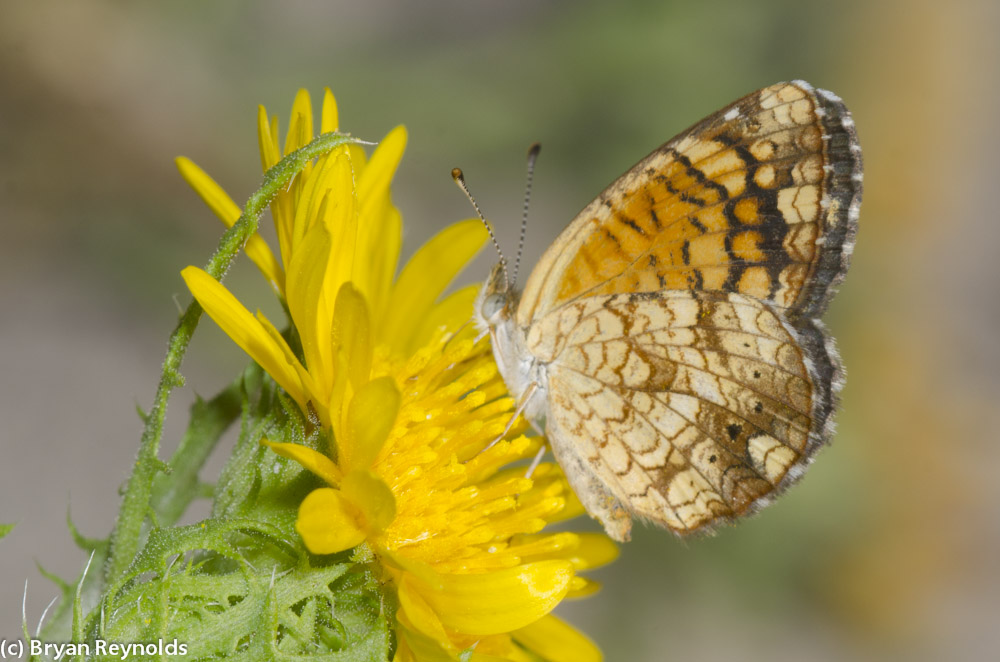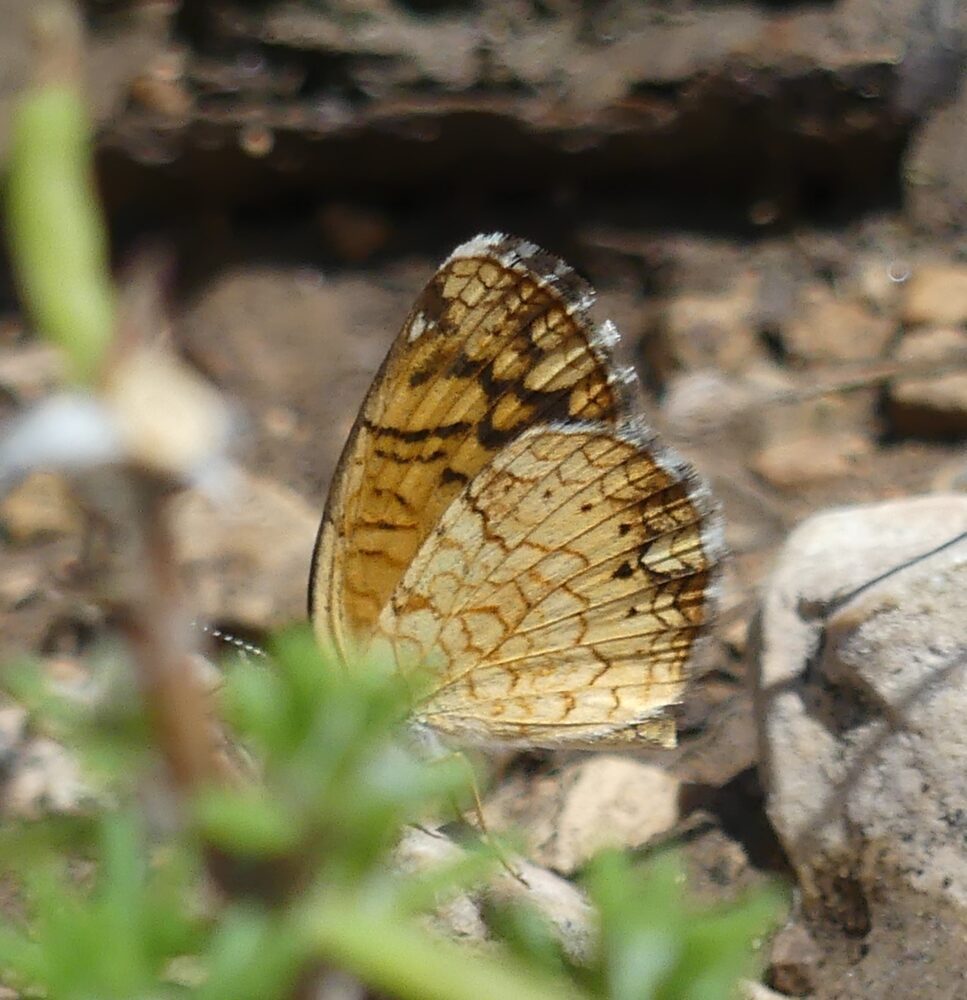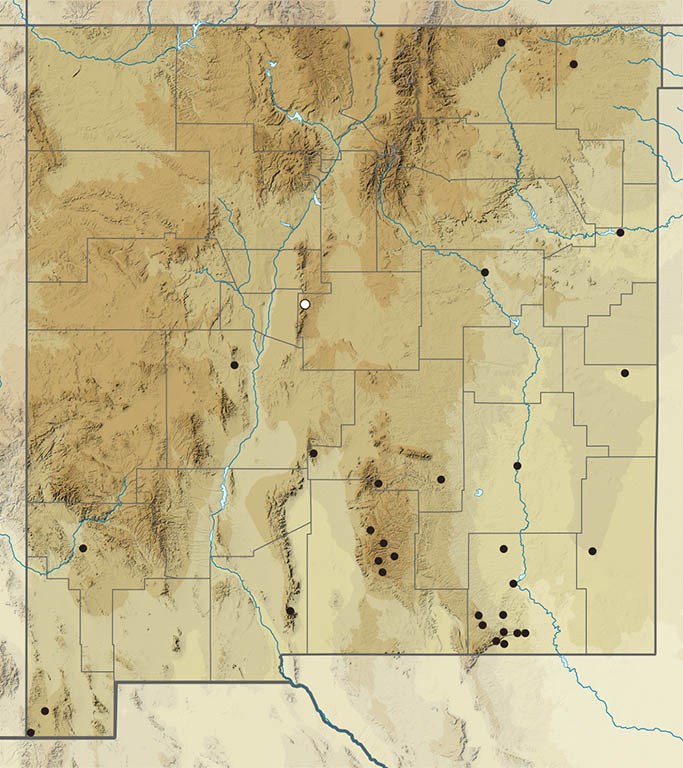by Steven J. Cary and Michael E. Toliver
The Brushfoots (Nymphalidae). This family is our second richest in terms of number of species and perhaps the most variable in terms of sizes, colors, patterns and behaviors. Despite the obvious differences in wing morphology, almost all members share a unifying structural character: on adults, the forelegs are reduced to tiny, brush-like structures, leaving only four functional legs. The exception that proves the rule is female Libytheinae, which have functional forelegs, emphasizing their ancestral status. Many of our most familiar butterflies are members of this family. Pursuant to Pelham’s (2023) catalog, we have ~100 species in ten subfamilies distributed as shown below. Other works may arrange, lump, or divide families in other ways. Updated June 26, 2023
True Brushfoots (Nymphalidae: Nymphalinae). This is a large and diverse group of 41 species which have been recorded in New Mexico, so far. Most are residents, but a few are subtropical strays. True brushfoots include species that range from small to medium-sized species, even some large ones. Color combinations range from blue to orange, white and black. Suburban gardens are frequently haunted by a variety of true brushfoots including Patches, Checkerspots, Crescents, Ladies, Tortoiseshells, Buckeyes and Commas.
- Tailed Cecropian (Historis acheronta)
- Milbert’s Tortoiseshell (Aglais milberti) Nymphalis milberti subpallida, pullum
- California Tortoiseshell (Nymphalis californica timidar)
- Mourning Cloak (Nymphalis antiopa) Camberwell Beauty
- Question mark (Polygonia interrogationis) Nymphalis interrogationis
- Satyr Comma (Polygonia satyrus) Nymphalis
- Hoary Comma (Polygonia gracilis) Nymphalis, zephyrus, Zephyr
- Green Comma (Polygonia faunus hylas) Nymphalis
- Oreas Comma (Polygonia oreas) Nymphalis, nigrozephyrus, satellow, progne
- West Coast Lady (Vanessa annabella) Cynthia carye
- American Lady (Vanessa virginiensis)
- Painted Lady (Vanessa cardui)
- Red Admiral (Vanessa atalanta rubria)
- White Peacock (Anartia jatrophae luteipicta)
- Malachite (Siproeta stelenes)
- Rusty-Tipped Page (Siproeta epaphus)
- Gray Buckeye (Junonia grisea)
- Dark Buckeye (Junonia nigrosuffusa) Junonia evarete, Tropical Buckeye
- Common Buckeye (Junonia coenia)
- Anicia Checkerspot (Euphydryas anicia) Occidryas anicia, chalcedona, eurytion, alena, wecout, carmentis, capella, brucei, eurytion, chuskae, hermosa, magdalena, cloudcrofti
- Euphydryas anicia cloudcrofti
- Euphydryas anicia brucei
- Euphydryas anicia magdalena
- Euphydryas anicia hermosa
- Euphydryas anicia chuskae
- Euphydryas anicia carmentis
- Euphydryas anicia alena
- Euphydryas anicia wecoeut
- Euphydryas anicia capella
- Dotted Checkerspot (Poladryas minuta)
- Arachne Checkerspot (Poladryas arachne) nympha, gilensis
- Crimson Patch (Chlosyne janais)
- Definite Patch (Chlosyne definita) anastasia
- Rosita Patch (Chlosyne rosita) montana
- Theona Checkerspot (Chlosyne theona) thekla, bollii
- Boll’s Checkerspot (Chlosyne bollii)
- Trans-Pecos Checkerspot (Chlosyne chinatiensis)
- Fulvia Checkerspot (Chlosyne fulvia)
- Coronado Checkerspot (Chlosyne coronado)
- Leanira Checkerspot (Chlosyne leanira flavodorsalis)
- Bordered Patch (Chlosyne lacinia) crocale, adjutrix, rufescens, nigrescens
- California Patch (Chlosyne californica)
- Gorgone Checkerspot (Chlosyne gorgone)
- Silvery Checkerspot (Chlosyne nycteis drusius)
- Sagebrush Checkerspot (Chlosyne acastus) Chlosyne acastus sabina, Chlosyne neumoegeni, arkanyon Northern Checkerspot, Chlosyne palla
- Rockslide Checkerspot (Chlosyne damoetas)
- Yellow Checkerspot (Chlosyne flavula)
- Elfoid Checkerspot (Microtia elvira) Microtia elva,
- Tiny Checkerspot (Microtia dymas) chara, Dymasia
- Elada Checkerspot (Microtia elada) Texola elada
- Perse Checkerspot (Microtia perse) Texola elada perse
- Texas Crescent (Anthanassa texana)
- Pale-Banded Crescent (Anthanassa tulcis) Anthanassa ptolyca, Eresia punctata, Black Crescent
- Pearl Crescent (Phyciodes tharos) riocolorado, orantain, cocyta selenis, cocyta apache, anasazi
- Northern Crescent (Phyciodes cocyta) orantain, selenis, apache
- Tawny Crescent (Phyciodes anasazi) Phyciodes batesi
- Great Plains Crescent (Phyciodes orantain)
- Field Crescent (Phyciodes pulchella camillus) Phyciodes campestris, Phyciodes pratensis, sacramento
- Mylitta Crescent (Phyciodes mylitta arizonensis) Phyciodes pallida barnesi
- Jalapeno Crescent (Phyciodes jalapeno) Phyciodes phaon, Phaon Cresent
- Painted Crescent (Phyciodes picta canace) jemezensis
- Graphic Crescent (Phyciodes graphica) Phyciodes vesta, Vesta Crescent
Historis acheronta (Fabricius 1775) Tailed Cecropian (added April 20, 2024)
Description. No other butterfly currently known from New Mexico resembles this butterfly. It is large, with a wing span of over 4 inches. The dorsal surface of the front wing is marked by a black apex with a series of white spots, and a reddish-orange base. The black of the apex extends along the outer margin. The hind wing is reddish brown, darker at the margins. There is a prominent tail. Beneath, the Tailed Cecropian is marked by a series of wavy lines on a greyish brown ground color, darker towards the margins. There is a series of spots distributed over the surface of both wings. The pattern is much duller than the upper surface, and likely helps obscure the butterfly when it lands on the substrate (often trees in its native habitat). Range and Habitat. Tailed Cecropian is a tropical species that occasionally strays north. Strays have been found in Arizona, Kansas, Texas, Florida and now New Mexico. Life History. Larvae feed on various members of the genus Cecropia, a group of tree species limited to the Neotropics. Thus, no host plants exist in New Mexico in nature. Adults are fond of rotting fruit. A fruit bait placed in one’s yard could attract lots of interesting butterflies, including this one though one should certainly not expect to see it! Flight. Records of strays in the US range from June to October; ours was found in August. In its natural range, it occurs year-around. Comments. Sapkota, et al, (2024) reported this butterfly based on a specimen residing in the Eastern New Mexico University collection, collected 15 August 1986 in Portales, Roosevelt County. It is a rare stray this far north.

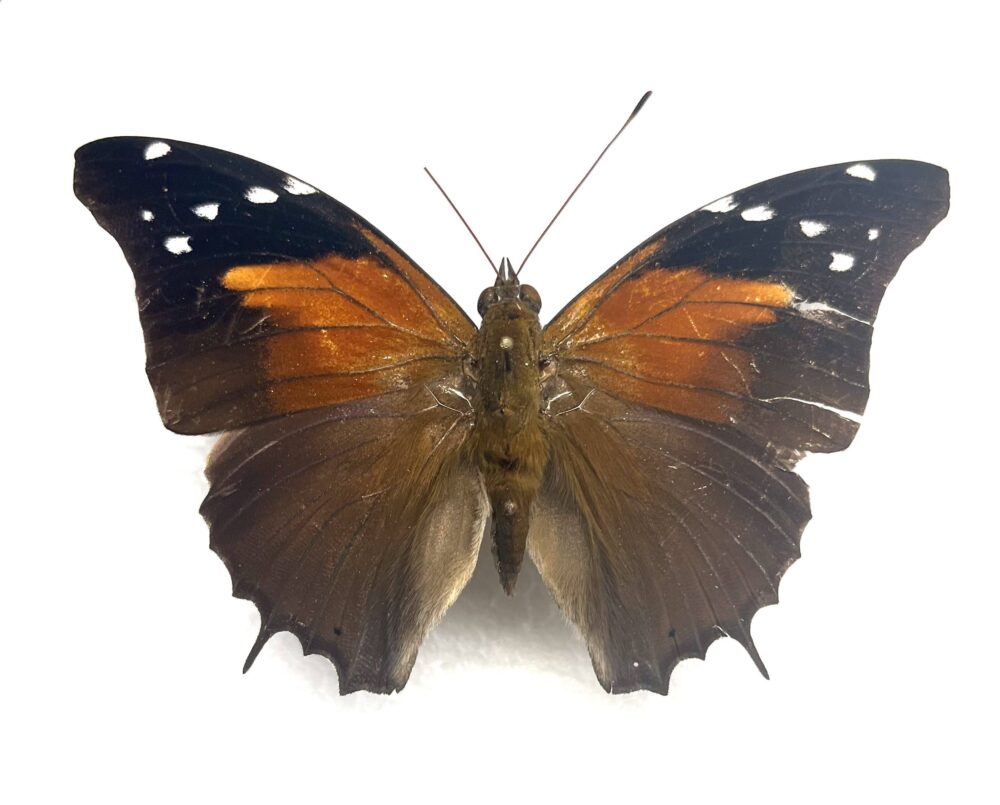

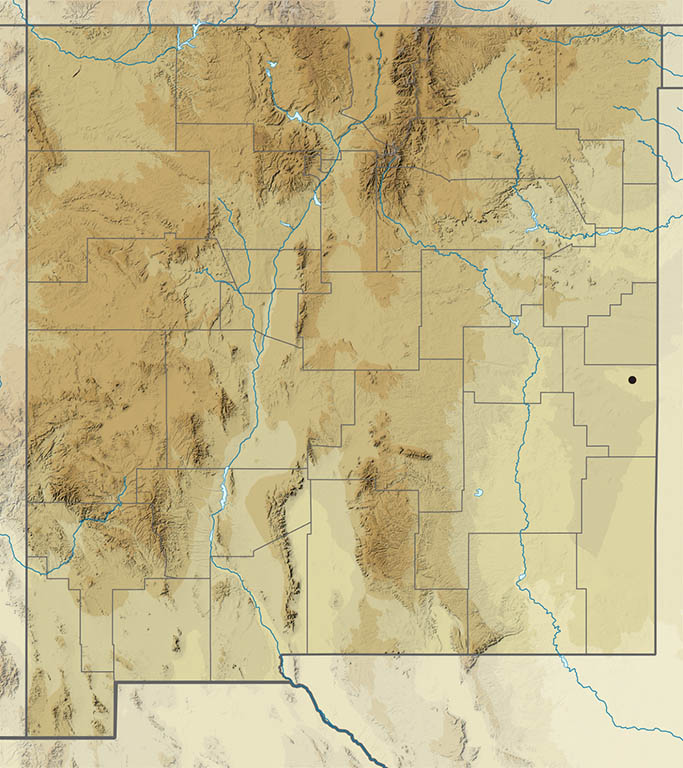
Nymphalis (Aglais) milberti (Godart 1819) Milbert’s Tortoiseshell (updated August 26, 2023)
Description. Milbert’s uppersides are black-brown with fiery post-median bands. Each band is basally yellow and distally red-orange. Blue dots decorate the margin. The ventrum is camouflaged black and brown. Range and Habitat. Milbert’s lives in subarctic areas from Alaska to Newfoundland and south in the western cordillera to California, Arizona and New Mexico. In our state it accepts a broad spectrum of habitats in Transition, Canadian and Hudsonian Zones (counties: Be,Ca,Ci,Co,DA,Gr,Li,LA,Mo,Ot,RA,Sv,SJ,SM,SF,So,Ta,To,Un), 6500 to 12,500′ elevation. Life History. Nymphalis milberti has gregarious larvae that eat stinging nettle (i.e., Urtica dioica; Urticaceae). Pupae and adults can overwinter. Flight. Two overlapping mid-summer broods fly from June to August. The last one hibernates and flies again from March to May. New Mexico records fall between March 6 and October 22, but adults may fly on warm winter days, too. Adults seek nectar; males may hilltop. Comments. Rocky Mountain states have subspecies Nymphalis milberti subpallida (Cockerell 1889). Subspecies N. milberti pullum (Austin 1998) was described from specimens collected in the White Mountains of Arizona. In New Mexico, however, no consistent geographic pattern to variation in wing characters has yet been recognized. Individuals from Gr and Ca counties probably would fall under pullum, should that name be verified. Zhang, et al (2022) presented genetic evidence for treating Aglais (and Polygonia) as subgenera within Nymphalis and we follow that approach. Others, notably Pelham (2023), have yet to follow suit and place Milbert’s Tortoiseshell in genus Aglais. The southernmost colony in North America appears to be in the high Organ Mountains of Dona Ana County, NM.
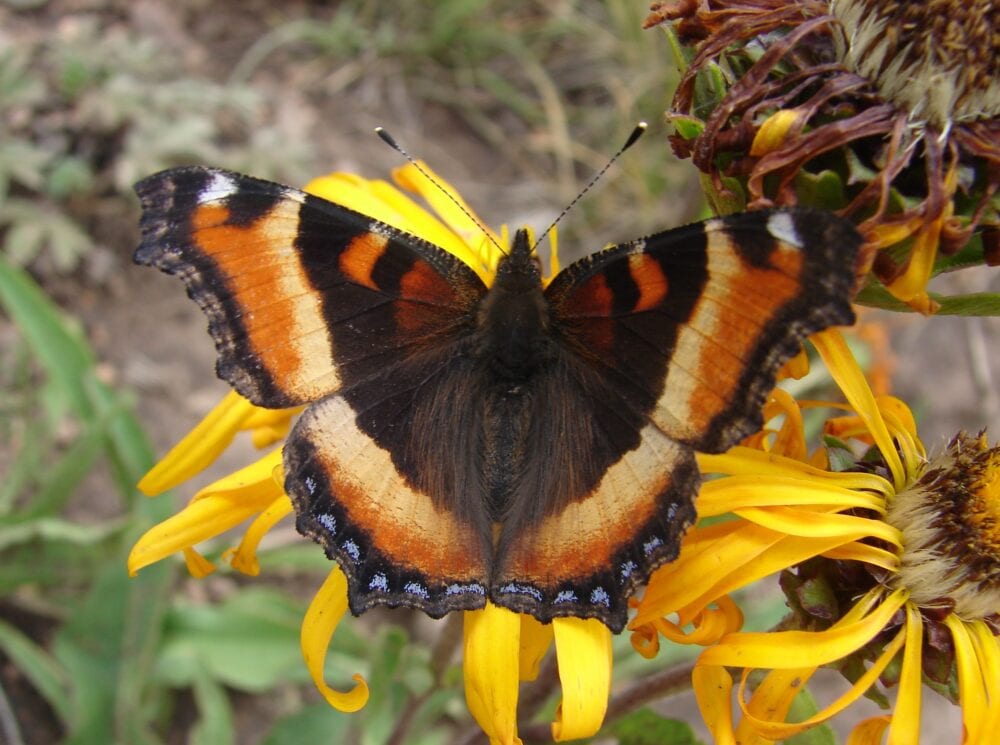
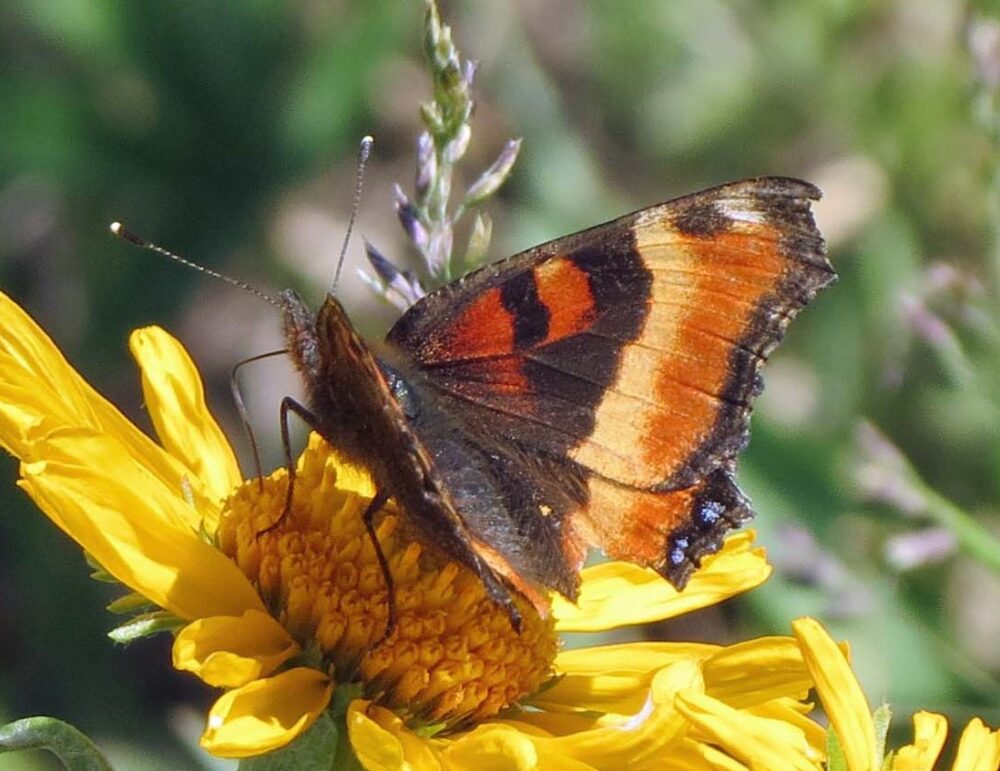
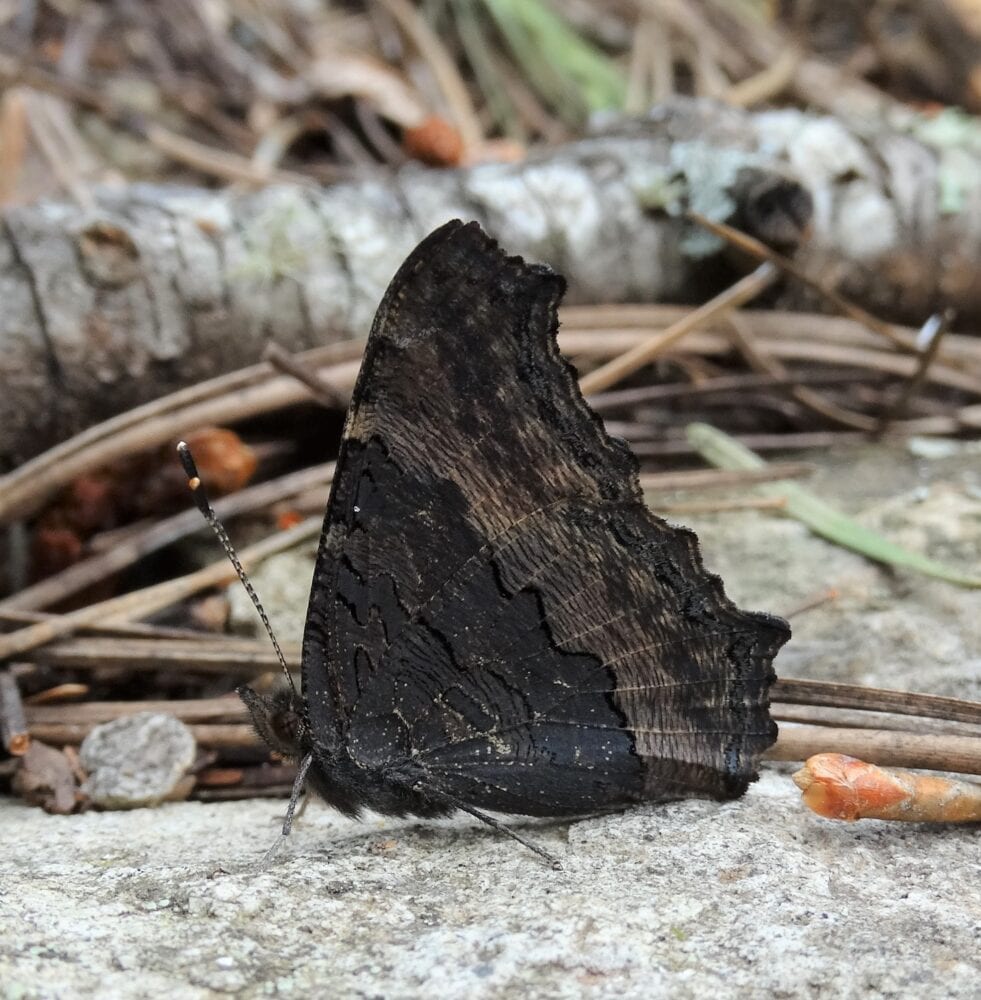
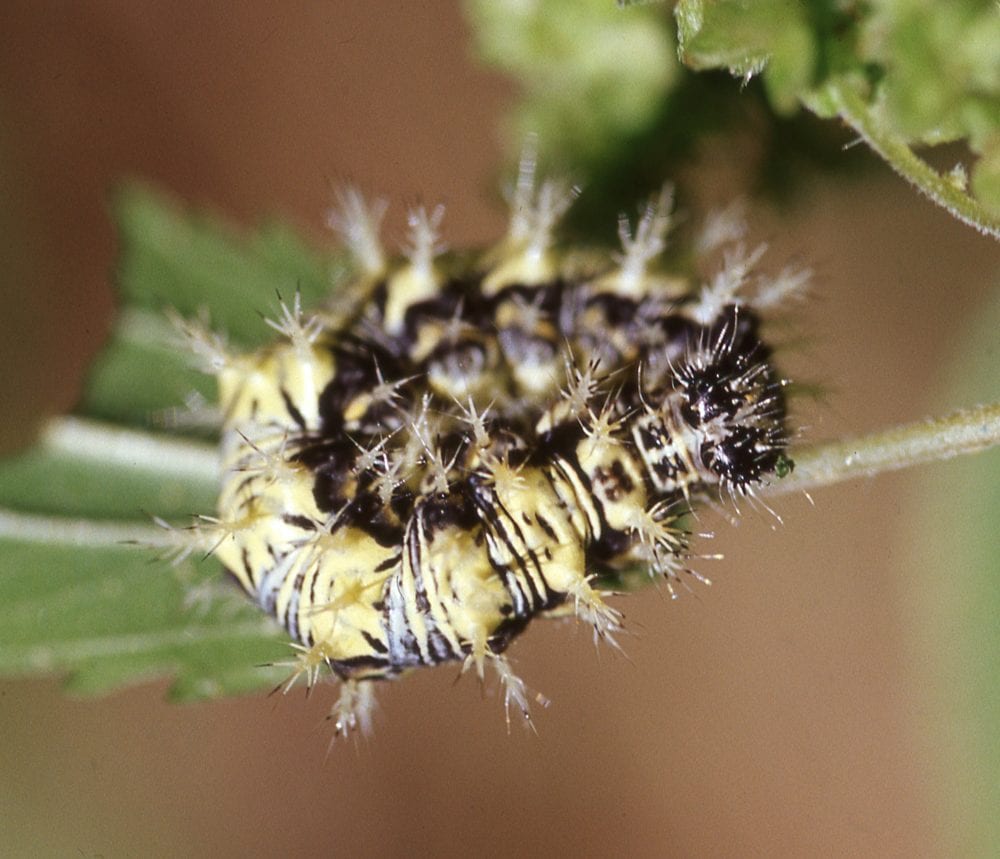

Nymphalis (Nymphalis) californica (Boisduval 1852) California Tortoiseshell (updated August 28, 2023)
Description. California Tortoiseshell is mottled brown and gray beneath and the wing margin appears ragged. It is bright orange above with a dark margin; iridescent blue spots highlight the hindwing margin. Range and Habitat. Essentially a butterfly of western North America, Nymphalis californica lives from British Columbia and Montana south to California and New Mexico. Here it inhabits open woodlands, typically 7,000 to 11,000′ elevation (counties: Be,Ca,DA,Ed,Ci,Co,Gr,LA,Mo,Ot,RA,Sv,SJ,SM,SF,Si,So,To). We have relatively few records for this widespread species. Life History. Larvae eat Ceanothus species (Rhamnaceae). On 25 May 2000 at Coyote Creek State Park (Mo), gregarious larvae ate Ceanothus fendleri, the principal host in New Mexico. Pupae and adults overwinter. Flight. Hibernators fly from February 26 to May 21, peaking in April. A summer generation flies June 16 to July 22. Their offspring fly from mid-August 16 to late September, then hibernate. Adults bask and nectar. Comments. Our populations may belong to subspecies Nymphalis californica timidar (J. Scott & Kondla 2014). California Tortoiseshell can have amazing population explosions and the resulting strays are known as far east as New York.
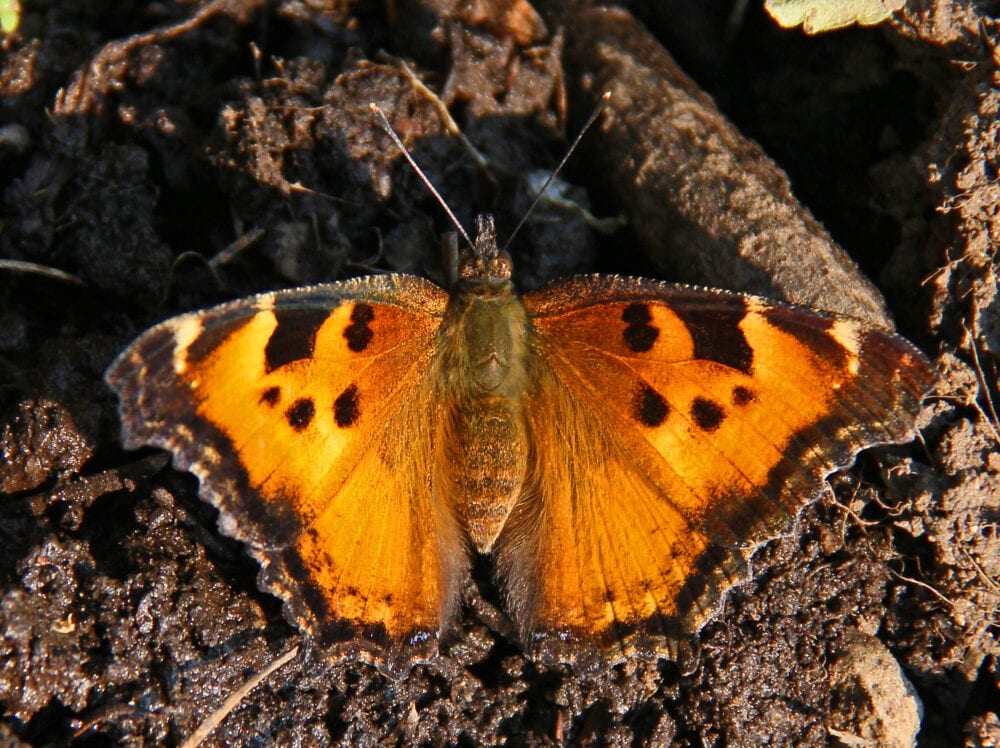
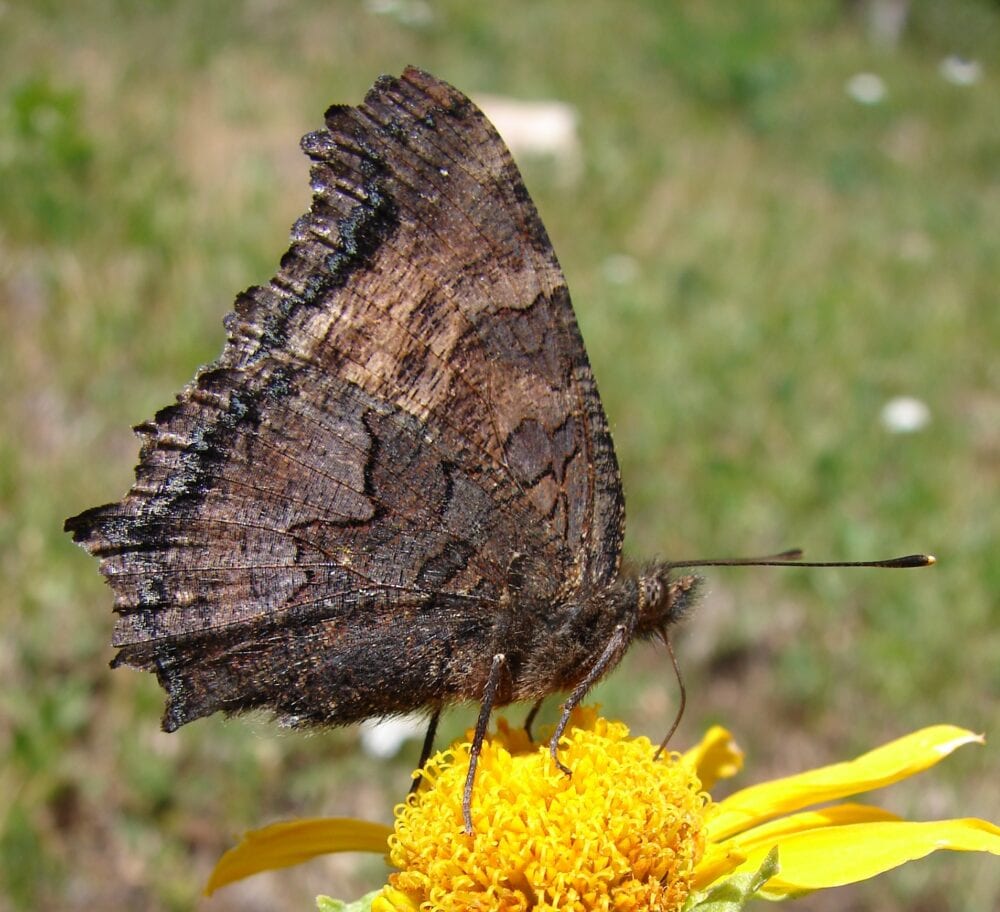

Nymphalis (Nymphalis) antiopa (Linnaeus 1758) Mourning Cloak (updated August 28, 2023)
Description. This large, familiar butterfly is dark maroon-brown above with irregular yellow margins and blue submarginal spots. With age, the maroon tint disappears and the wing margin becomes more ragged. Mourning Cloak undersides are mottled brown and black – excellent camouflage when hibernating underneath loose tree bark. Range and Habitat. Mourning Cloaks are widespread in North America, Central America, Asia and much of Europe. In New Mexico it can be seen in all counties at almost all elevations. Life History. Larvae eat foliage of a variety of deciduous trees. Willow (Salix; Salicaceae) seems to be the favorite here. Other Salicaceae hosts include cottonwood (Populus). Ulmaceae hosts include elm (Ulmus), including Siberian elm (hooray!) and hackberry (Celtis reticulata). In the Betulaceae, larvae eat alder (Alnus species). In the Moraceae, they like hops (Humulus lupulus) and mulberry (Morus species). They also eat ash (Fraxinus; Oleaceae), as well as Spiraea and Rubus (both Rosaceae). Eggs are laid in clusters and larvae are gregarious. Flight. Southern New Mexico adults may be seen any time of year in three or four broods; records span January 5 to December 19. Our Eastern Plains have two broods: one in September to October overwinters and flies again in March and April; their offspring fly in June. Our north-central mountains have flight peaks in April and again from June to August. Males patrol riparian or linear road corridors, perching on low-hanging branches or fallen logs. Adults rarely nectar, but instead seek nourishment from tree sap, rotting fruit, and water. Comments. In northern mountains, Mourning Cloaks will break diapause and fly on warm days in February, usually making it the first butterfly to be seen in spring. Nymphalis antiopa occasionally strays across the Atlantic Ocean to Europe where our English-speaking colleagues call it the Camberwell Beauty – a much nicer name.
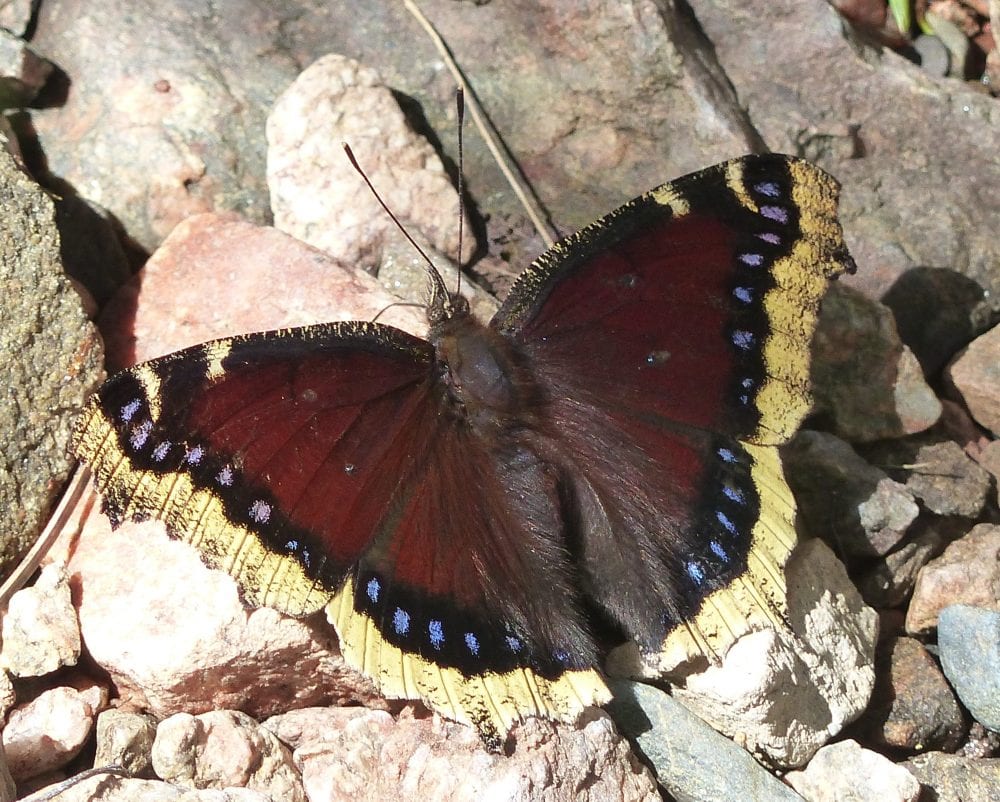
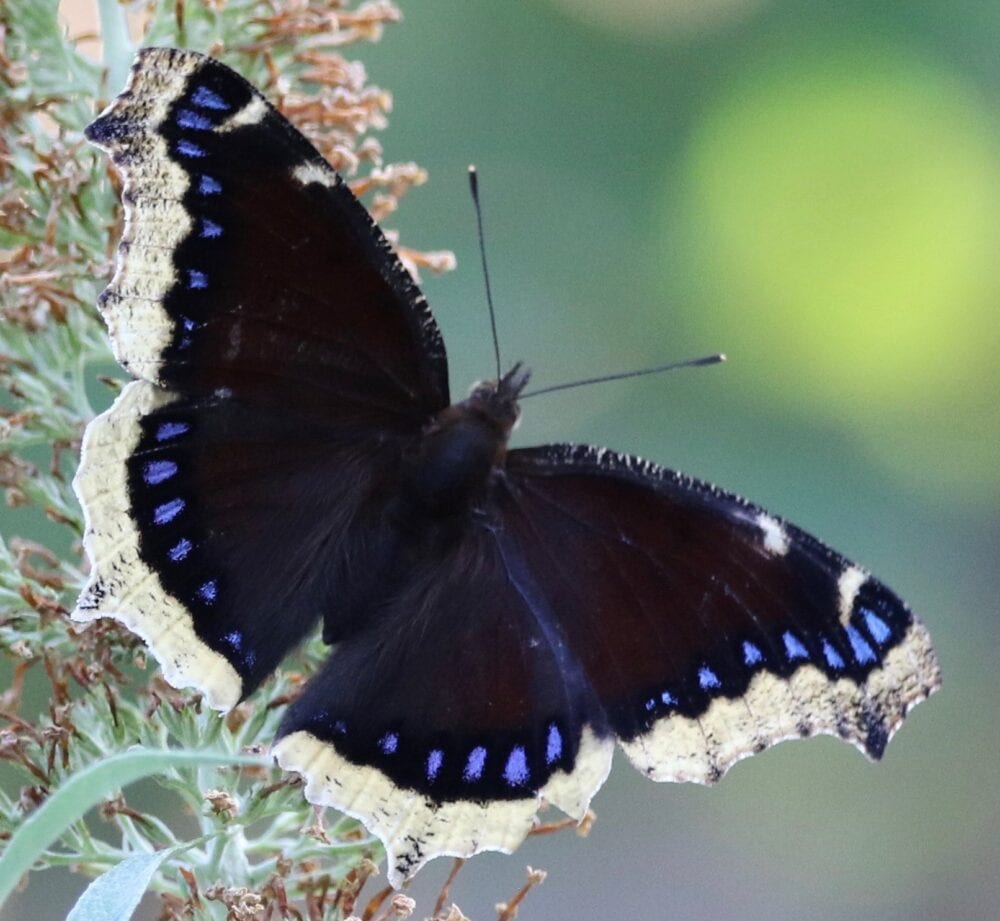

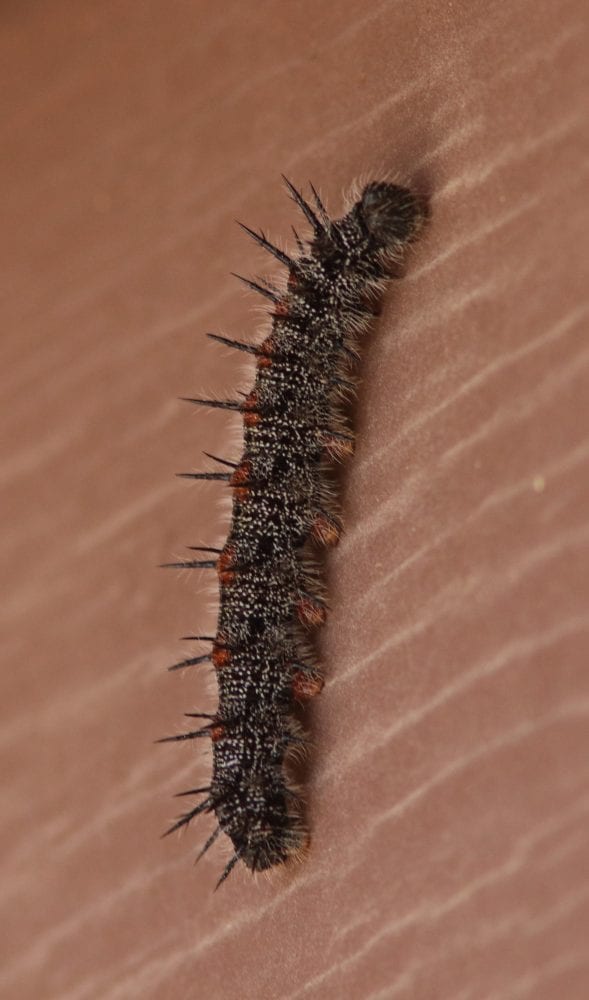
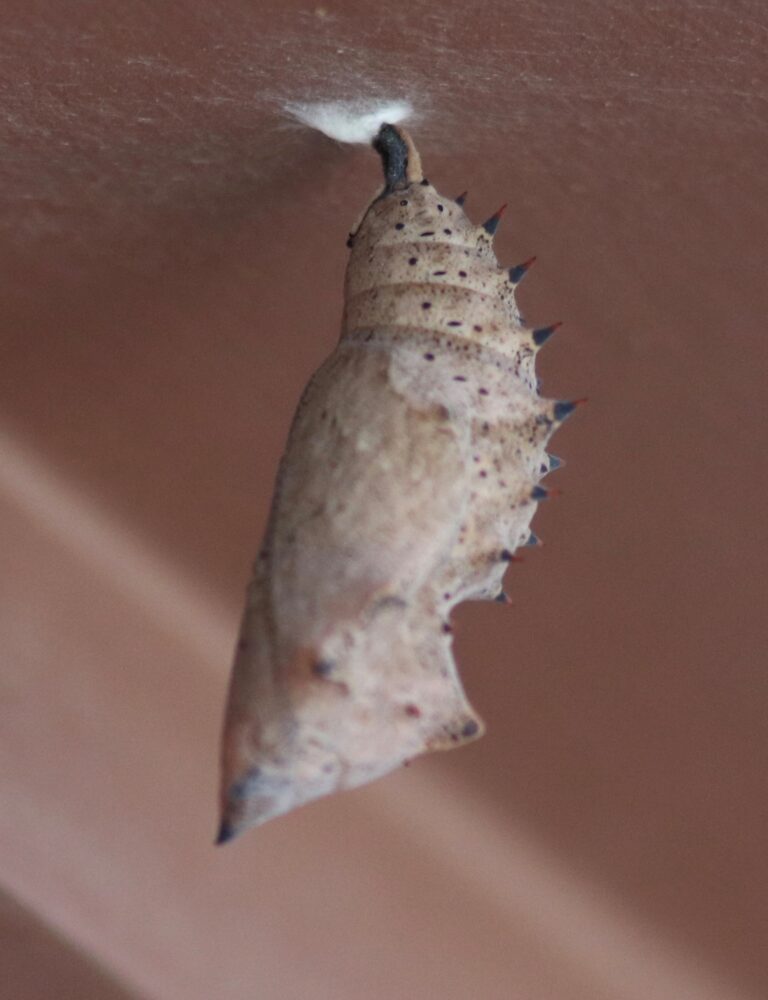
Nymphalis (Polygonia) interrogationis (Fabricius 1798) Question Mark (updated September 3, 2023)
Description. Question Mark has a translucent silver “?” mark on the hindwing underside. Its irregular-by-design wing margin and its dorsal orange and black markings are typical for the genus. The winter form is suffused with black and purple below and is lighter above. The DFW has a black dash near the end of the cell which other anglewings lack. The “tails” on the HW are longer than on most other anglewings. Range and Habitat. Question Marks live from the Atlantic coast to the Colorado Front Range and south into Mexico. In New Mexico it is mostly a species of the east and south elevations below 7500′ (counties: Be,Ch,Co,Cu,DB,DA,Ed,Gr,Gu,Hi,Le,LA,Li,Lu,Mo,Ot,Qu,RA,Ro,Sv,SM,SF,Si,So,Ta,To,Un,Va). Life History. Larvae prefer to eat plants in the Ulmaceae. Netleaf hackberry (Celtis reticulata) is the main native host in New Mexico. Siberian elm (Ulmus pumila) also has become a favorite. Hops (Humulus lupulus; Cannabinaceae) and nettle (Urtica dioica; Urticaceae) are reported elsewhere. Flight. Overwintering adults fly January 28 to May 2. Subsequent overlapping broods fly May 28 to December 23, peaking in September. Adults siphon nutrition from tree sap, rotting fruit and moist earth, rarely from flowers. Comments. New Mexico’s first record was caught in Raton by J. R. Merritt in 1935. This butterfly may have been scarce in New Mexico until the 1930s, when Governor Clyde Tingley planted 25,000 Siberian elms in communities throughout New Mexico’s treeless, Dust Bowl-afflicted Eastern Plains. Recent DNA work has demonstrated that the commas or anglewings are best treated as within the genus Nymphalis, with Polygonia as a subgenus.
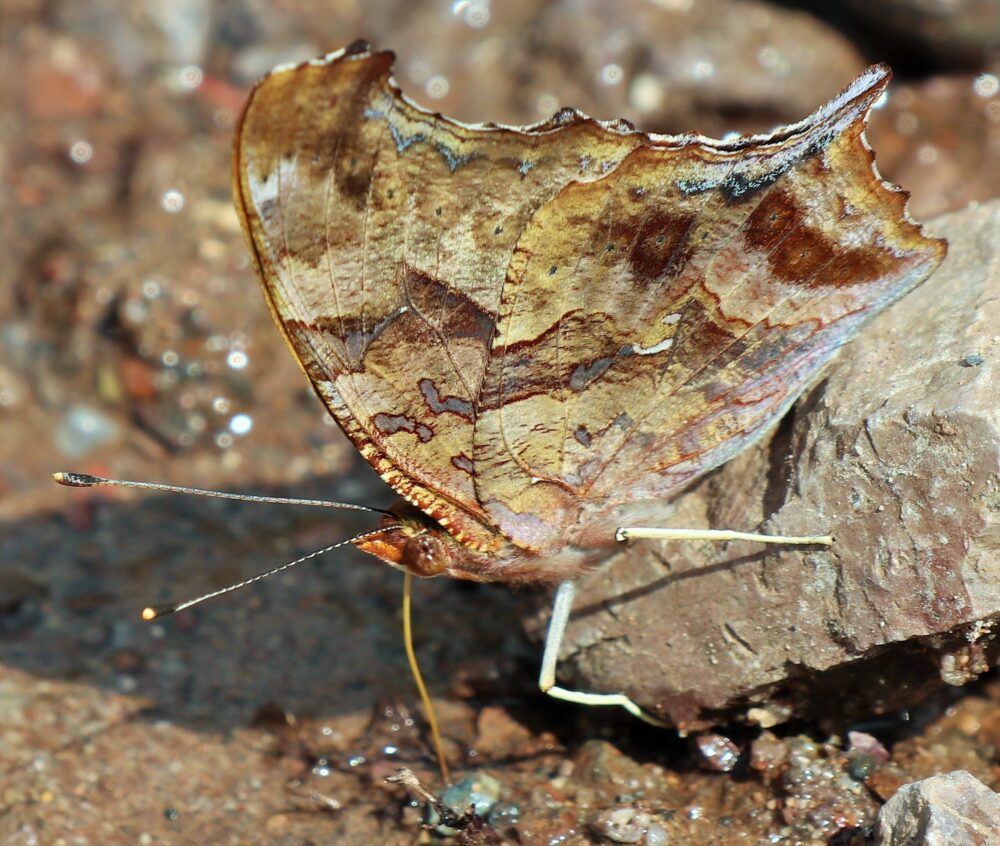
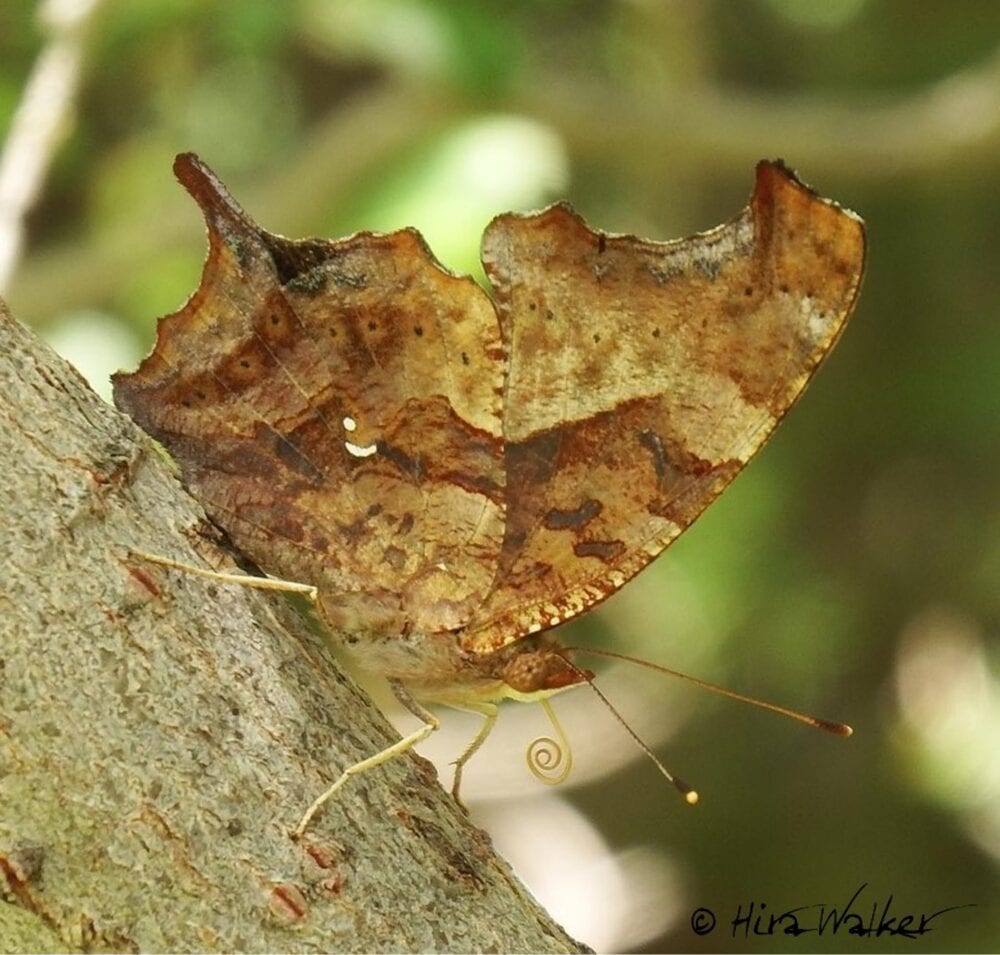
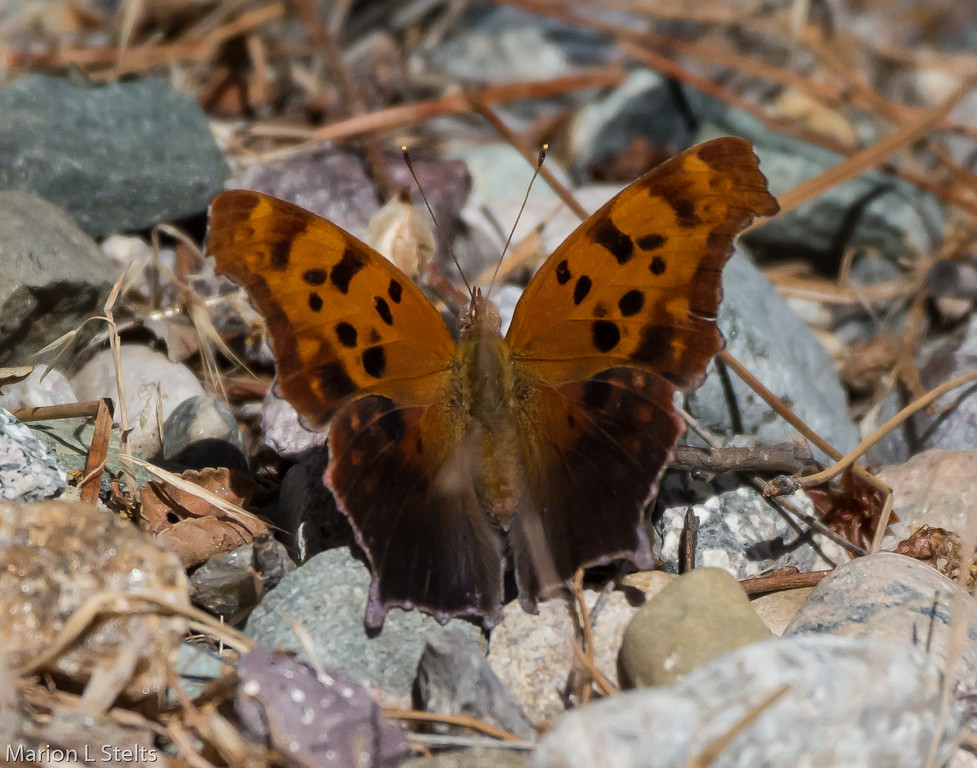
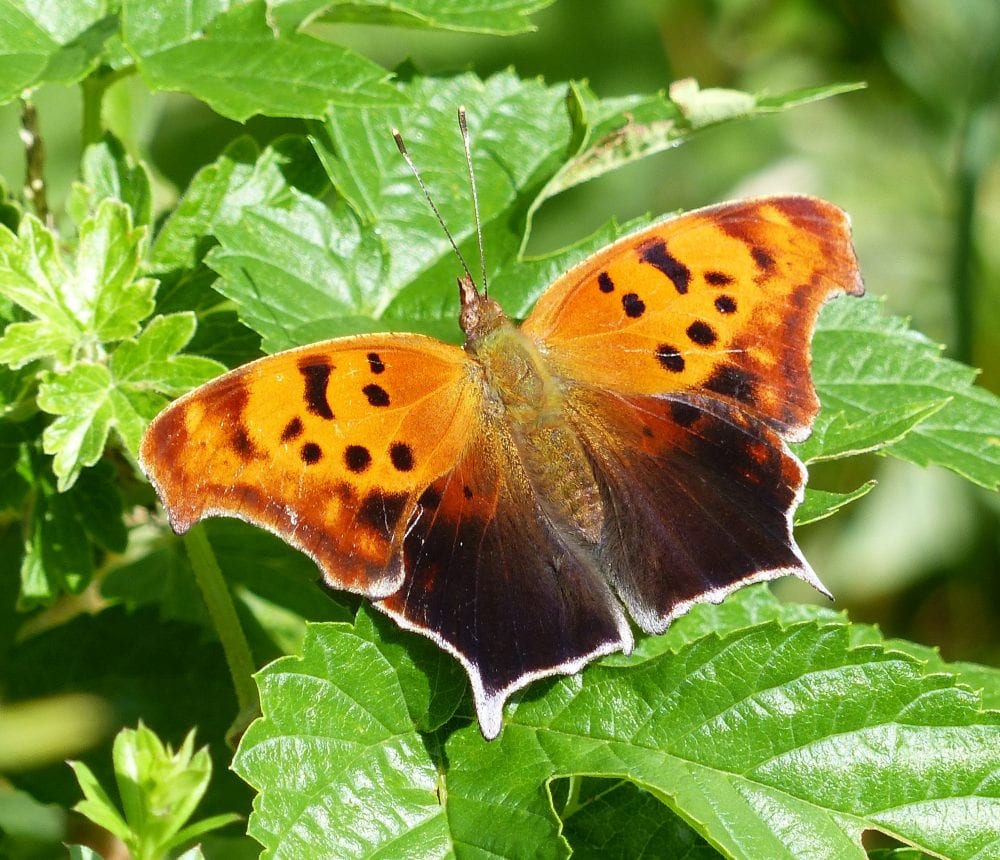
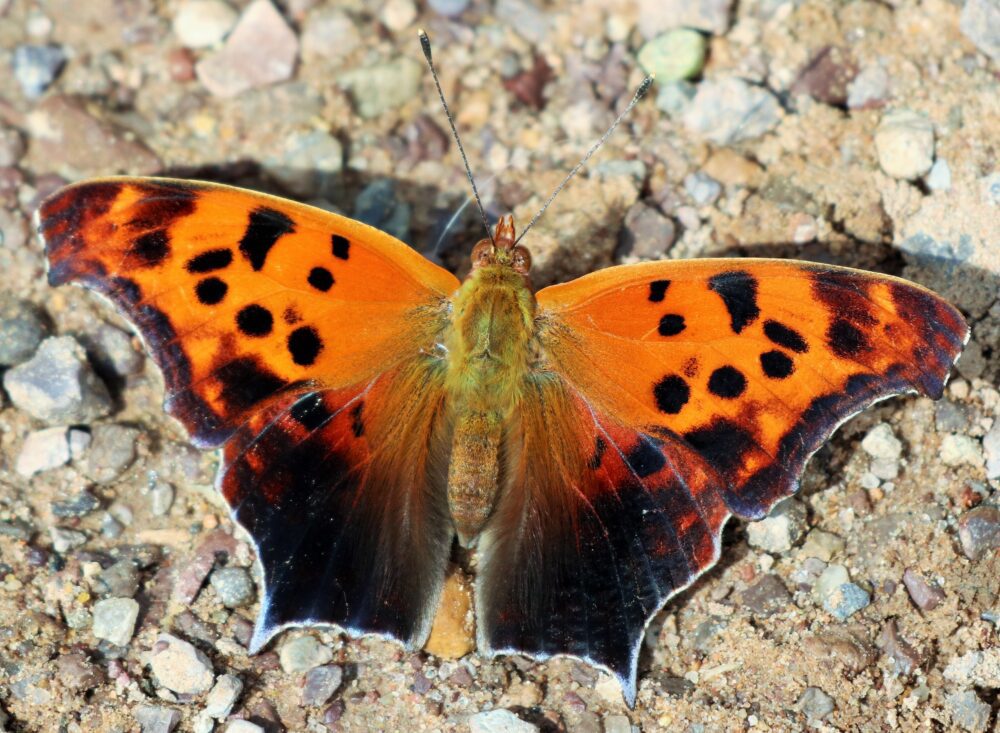
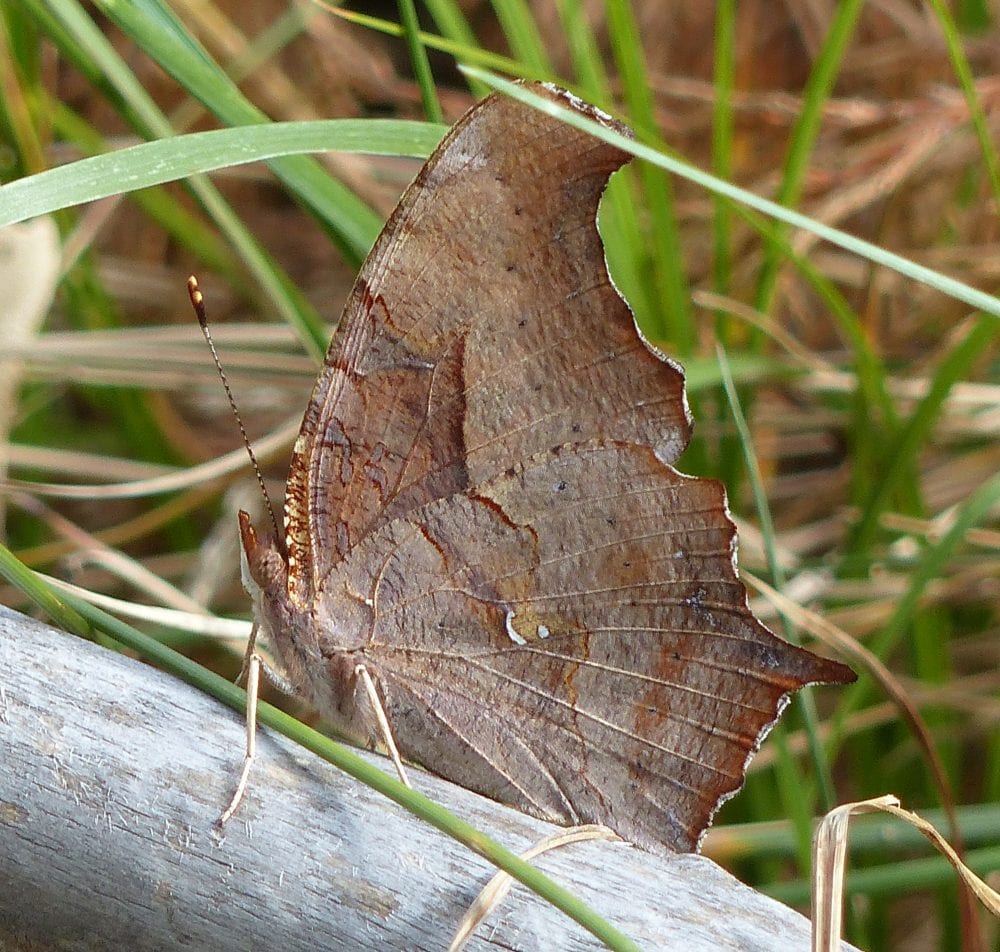
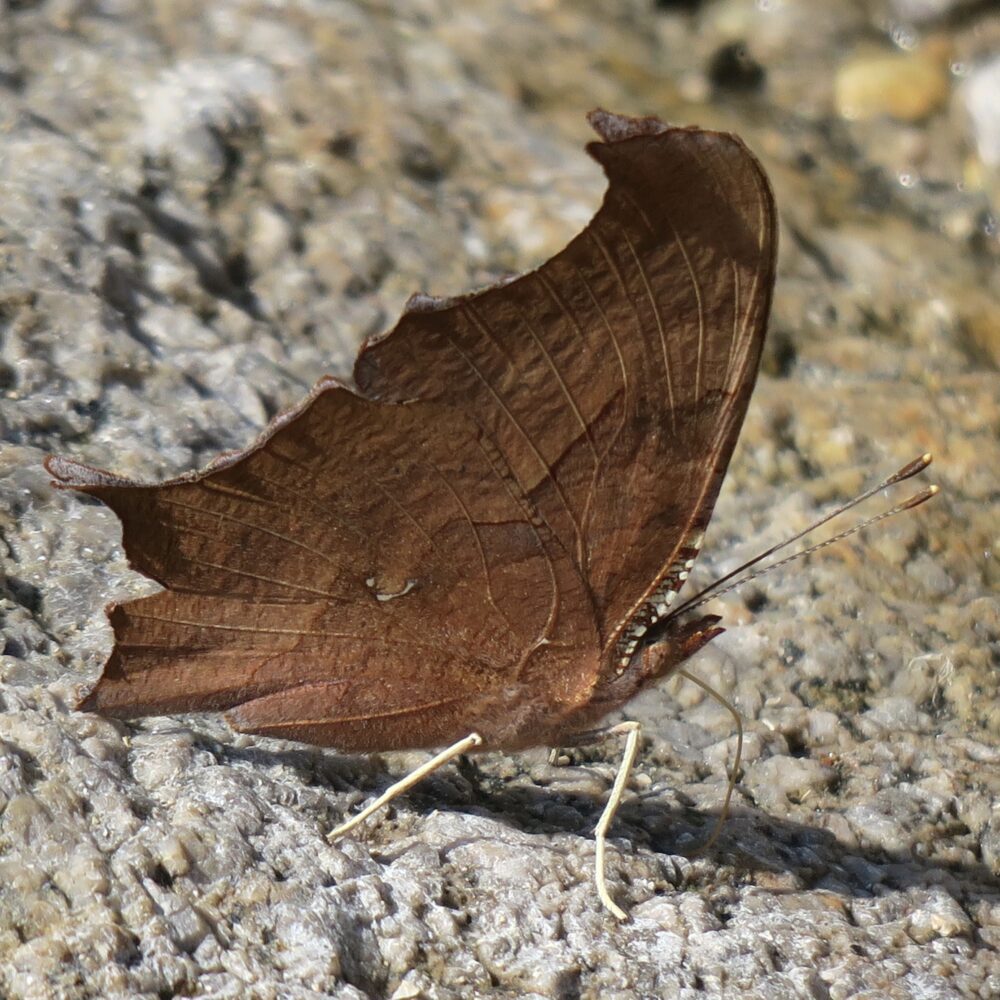
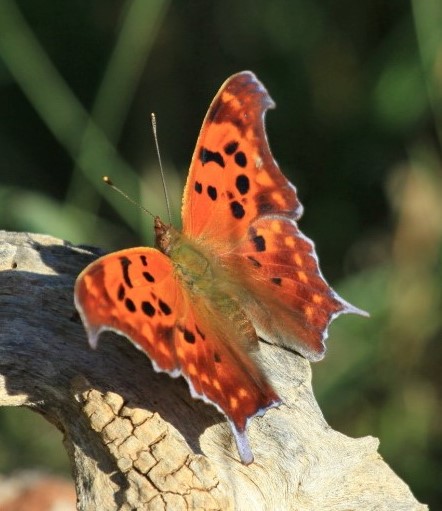
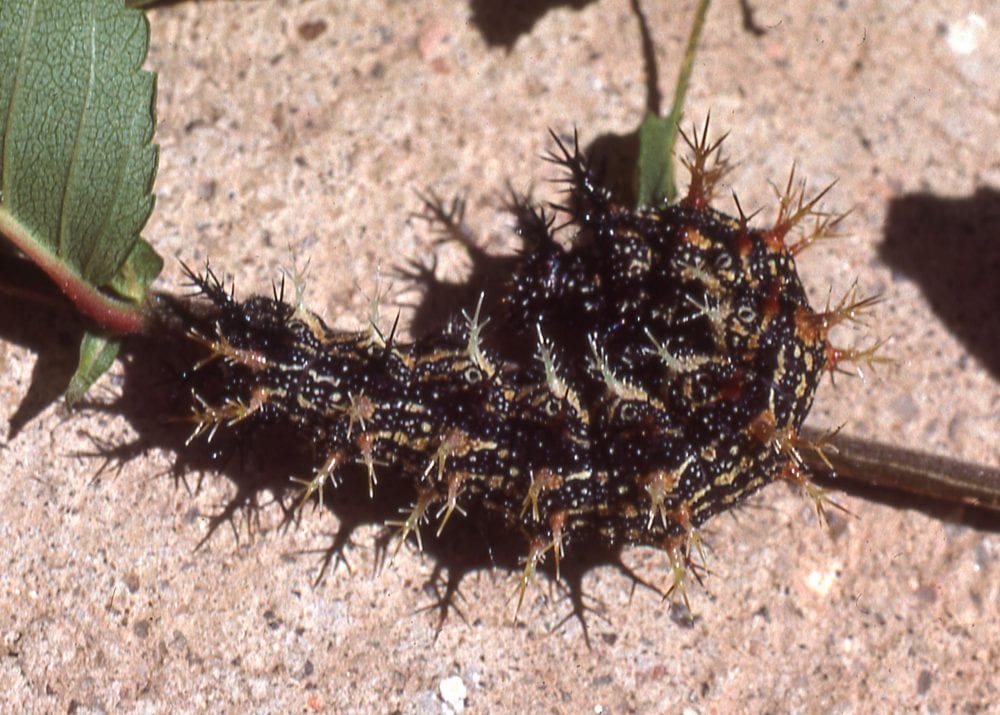


Nymphalis (Polygonia) satyrus (W. H. Edwards 1869) Satyr Comma (updated August 12, 2024)
Description. Satyr Comma is a good copy of a dead leaf, like all Polygonia. Undersides vary from tawny to darker brown with a small, translucent ‘comma.’ Hindwing uppersides have three black spots and the submarginal row of gold spots are smeared together. Range and Habitat. Satyr Commas reside across boreal North America from Newfoundland to British Columbia, south to California, Arizona and New Mexico. Here, look for them in woodlands below 9000′ elevation, but not along our eastern edge (counties: Be,Ca,Co,Ci,DA,Ed,Gr,Gu,Ha,Hi,Li,LA,Lu,MK,Mo,Ot,RA,Ro,Sv,SJ,SM,SF,Si,So,Ta,To,Un). Life History. Larval hosts include plants in the Ulmaceae, Salicaceae and Moraceae. The chief New Mexico host may be stinging nettle (Urtica dioica gracilis; Urticaceae). Adults hibernate under eaves of buildings, in clusters of dead leaves, and under loose tree bark. Flight. The summer brood flies from June to August. New adults fly in September to October, hibernate, then fly again in March to May. Extreme flight dates are January 23 and November 23. Comments. Our populations belong to the nominate subspecies, Polygonia satyrus satyrus. Sapkota et al. 2024 documented a renegade out in Portales (Ro) on May 6, 2023, perhaps a vagrant or a disjunct population out on the Caprock?
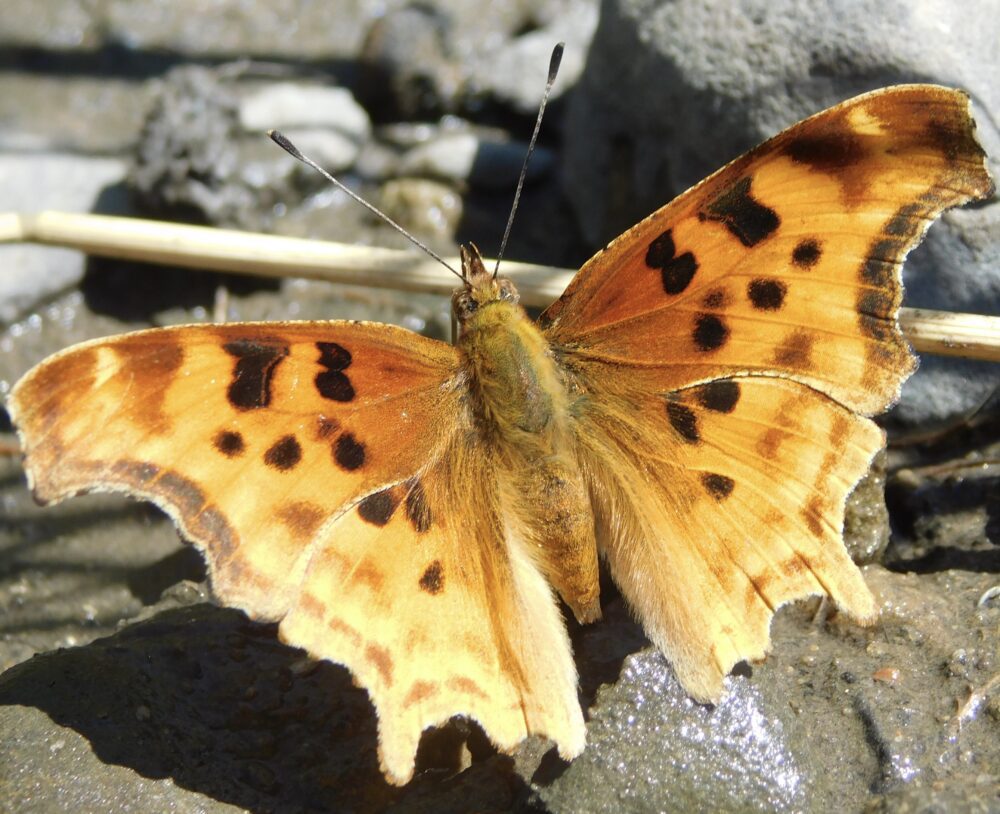


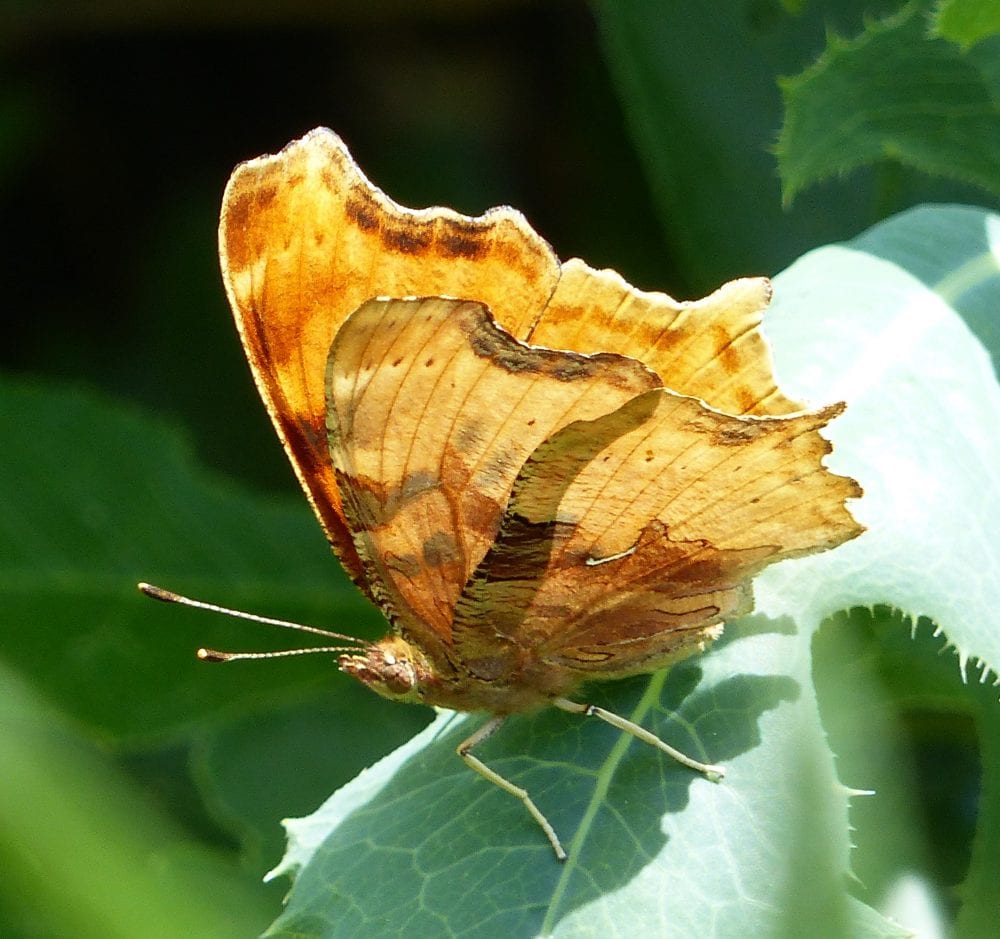



Nymphalis (Polygonia) gracilis (Grote & Robinson 1867) Hoary Comma (updated October 15, 2023)
Description. Hoary Commas resemble Satyr Commas but are dark, two-toned gray-brown on the underside and have only two black spots on the dorsal hindwing. The dorsal hindwing submargin has fairly distinct gold spots with gold halos, while Satyrs have those spots blurred. Range and Habitat. Polygonia gracilis flies in Canada, Alaska and the western cordillera south to California, Arizona and New Mexico. In New Mexico it prefers open conifer woodlands (counties: Be,Ca,Ci,Co,DA,Gr,Li,LA,MK,Mo,Ot,RA,Sv,SJ,SM,SF,Si,So,Ta,To,Un), usually 7000 to 10,000′ elevation. Life History. Currants and gooseberries (Grossulariaceae) are hosts. Larvae eat Ribes pinetorum in the Sacramentos (Ot). Ribes cereum, Ribes inerme, Ribes montigenum, Ribes lacustre and Ribes sanguineum are also used. Flight. Hibernating adults fly in late winter and spring, from February 24 to May 21. The next generation appears from June 12 to July 7. Their offspring fly in August and September and then overwinter. A partial third flight may occur in southern New Mexico. Our records fall between February 24 and November 6. Adults patrol creeks while feeding at flowers, tree sap and moist earth. Comments. We have the Rocky Mountain subspecies Polygonia gracilis zephyrus (W. H. Edwards 1870). It is possible that Oreas Comma (Polygonia oreas), a more northern species, is lurking within our widespread population of Hoary Comma in the northern tier of NM counties.
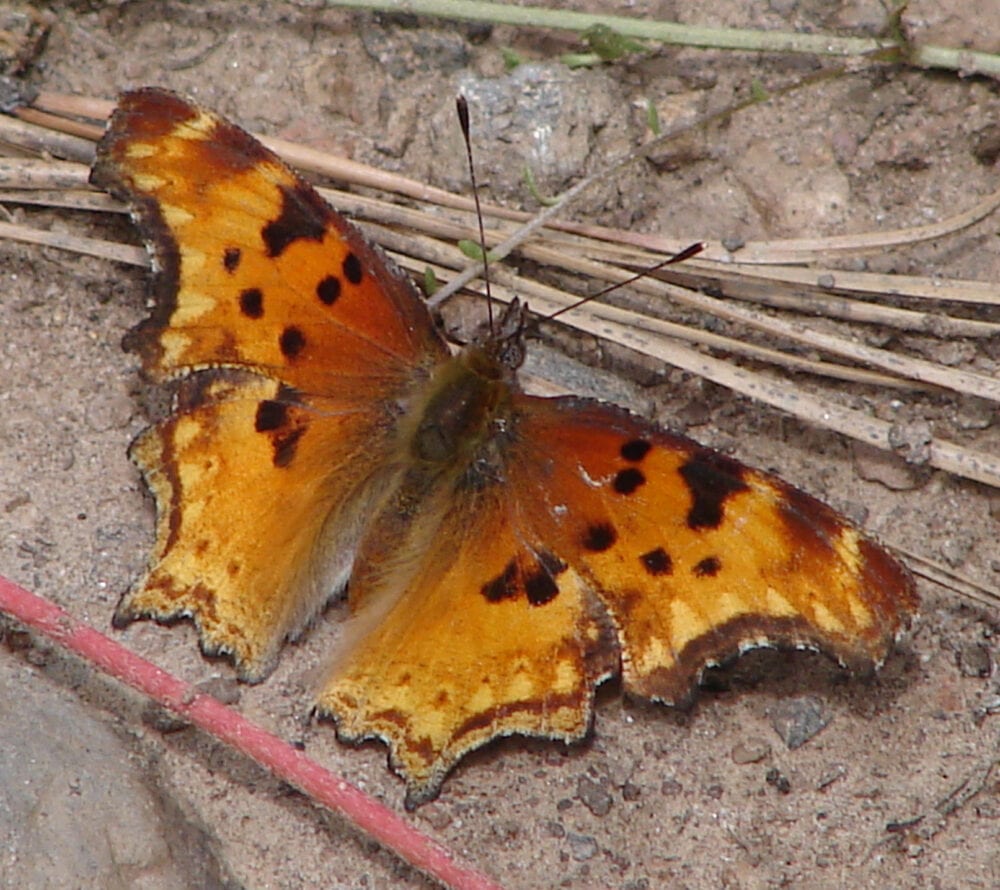

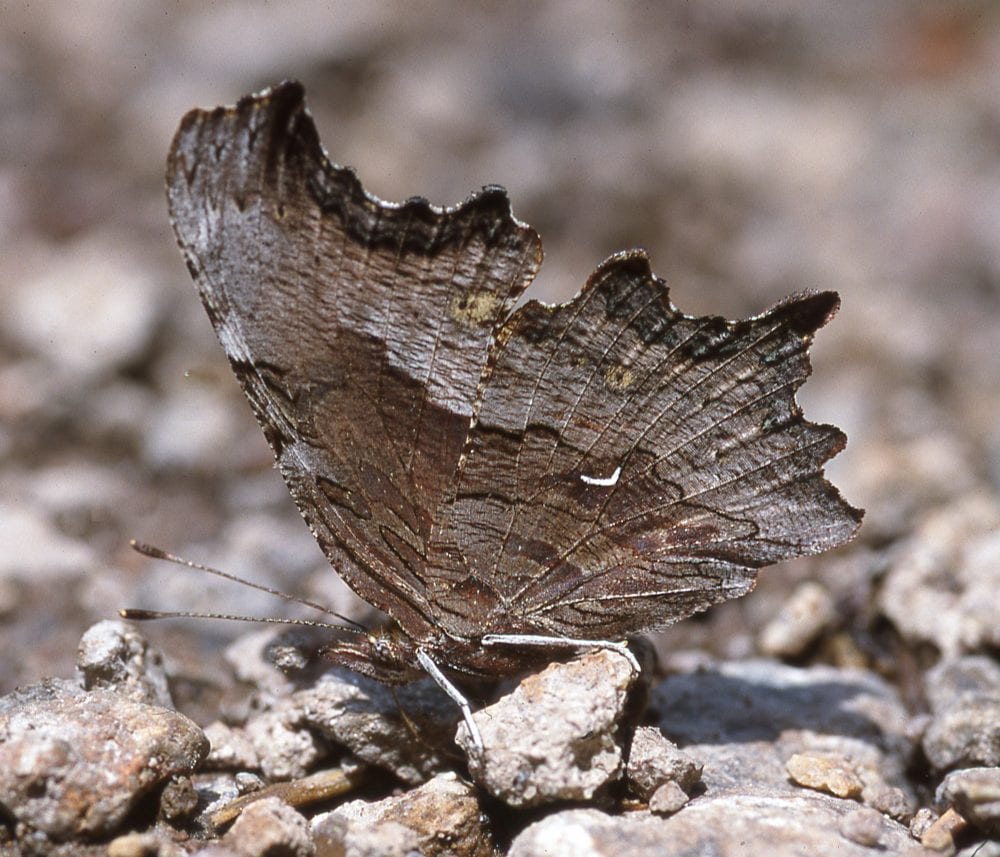

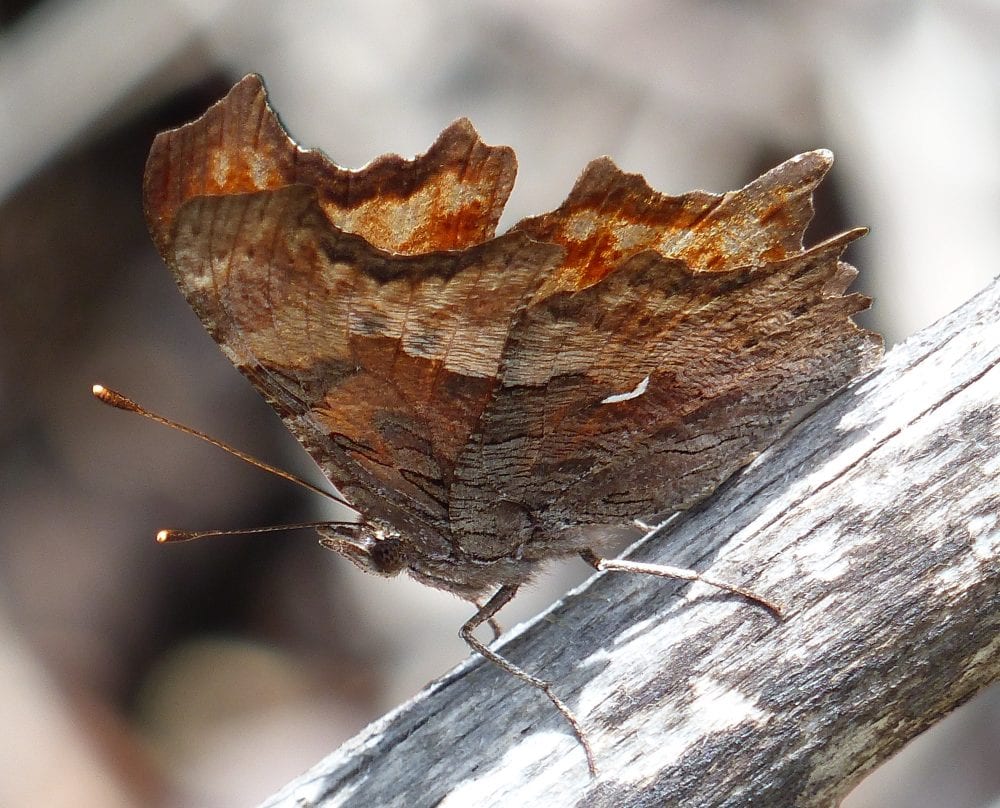
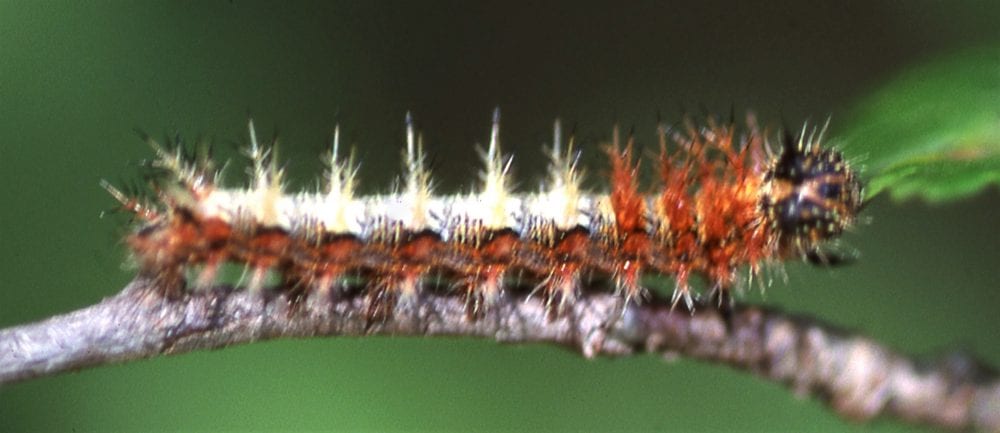

Nymphalis (Polygonia) oreas (W. H. Edwards 1869) Oreas Comma (added October 15, 2023)
Description. Very similar to Hoary Comma; many populations of Oreas were discovered only after lepidopterists carefully examined “Hoary” Commas. Best distinguished by differences on the ventral surface: Oreas tends to be darker basally with less contrast between the base and the distal part of the wings and lack any yellowish overscaling at the lower outside angle of the forewing. The “comma” on Oreas tends to be more sharply angled and narrower than Hoary’s “comma.” Above, there is often a “shadow” spot above the prominent dark spot on the lower edge of the forewing in Oreas, which is lacking or vague on Hoary. Range and habitat. Prior to the discovery of subspecies nigrozephyrus, Oreas was believed to be an uncommon species of the West Coast and the Northwest into northern Wyoming. The two central Rockies subspecies (nigrozephyrus and satellow) are found from southern WY to southern CO and probably northern NM. Life history. Larvae eat gooseberries (Ribes). Flight. Some adults overwinter, laying eggs that produce the next generation which flies from June – October. Comments. There is a record of Oreas from near Durango, CO, about 20 miles due north of the NM border. Additionally, a specimen from SF county looks suspiciously like Oreas with the prominent “shadow” spot (plotted as an open circle on the map – https://www.inaturalist.org/observations/124298443). NM may harbor the two CO subspecies; satellow in the NW corner of the state (possibly the Carracas Mesa portion of the Carson National Forest) and nigrozephyrus in the Sangre de Cristos of central NM. A number of lepidopterists regard N. oreas and Nymphalis progne (Cramer 1775) as members of the same species.



Nymphalis (Polygonia) faunus (W. H. Edwards 1862) Green Comma (updated October 16, 2023)
Description. Green Comma is small, with more irregular wing margins than those exhibited by the other Commas currently known from NM. Undersides usually are dark, like conifer bark. Subtle chevrons of dark green scales decorate the ventral hindwing submargins. A washed-out, almost immaculate ventral pattern also occurs. Above, the hindwing has two or (usually) three black spots and the dark submargin has orange spots that are small, bright, distinct and unconnected. Range and Habitat. Nymphalis faunus live in boreal North America, including the western Cordillera south to California, Arizona and New Mexico, and the Appalachian Mountains south to Georgia. In New Mexico, look for it in mixed coniferous woodlands (counties: Co,LA,Mo,RA,Sv,SM,SF,Ta), generally 8000 to 11,000′ elevation. Life History. Larvae eat aspen and willows (all Salicaceae), birches and alders (Betulaceae), Vaccinium species (Ericaceae) and sometimes gooseberries (Ribes species; Grossulariaceae). Adults overwinter. Flight. Because of the short growing season in its habitat, Green Commas are univoltine, but in two flights. Adults emerge in summer, peak in August and September, then hibernate. Survivors fly again and mate in spring (May and June). Extreme dates are April 5 and November 10. Adults bask on rocks and logs, and seek nectar in alpine meadows. Comments. Our populations are subspecies Nymphalis faunus hylas (W. H. Edwards 1872). Based on their host plants, our ‘Punctuation Mark’ butterflies generally arrange themselves in the landscape with Green Comma in the highest sites, Hoary Comma in the middle, then Satyr Comma and Question Mark at the lowest elevation sites. The name, Green Comma, is rather misleading because the green on Green Comma is very difficult to see and other ‘commas’ have small green patches, too.

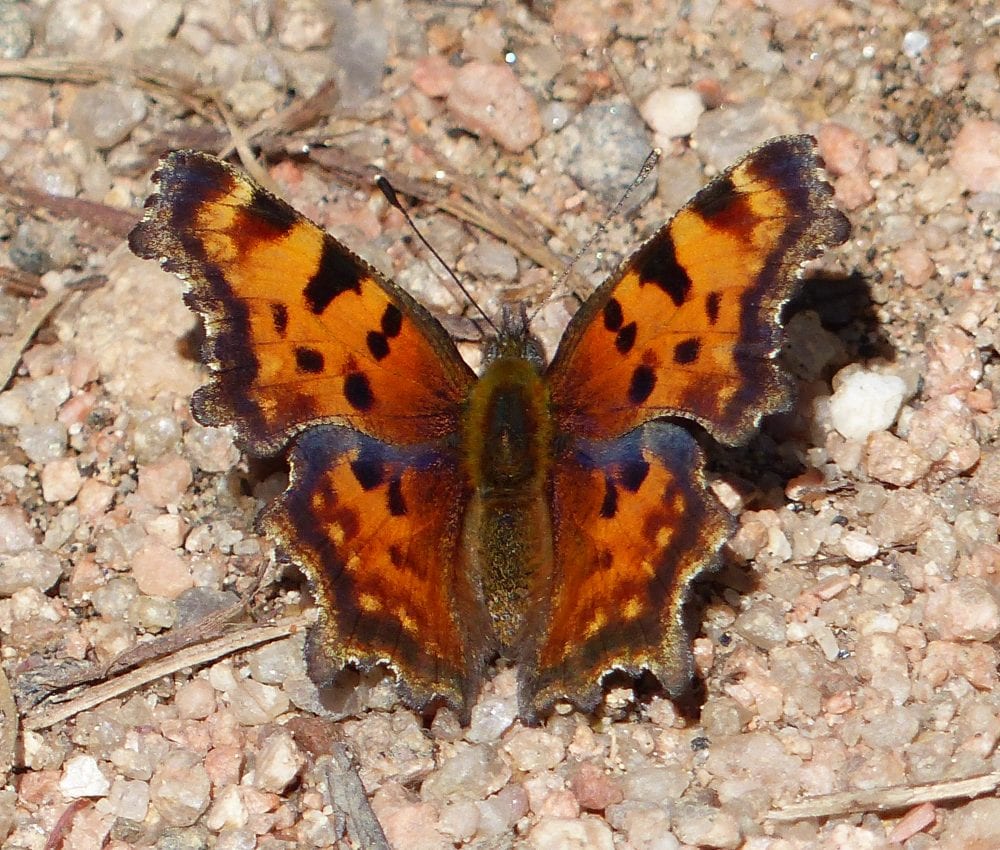

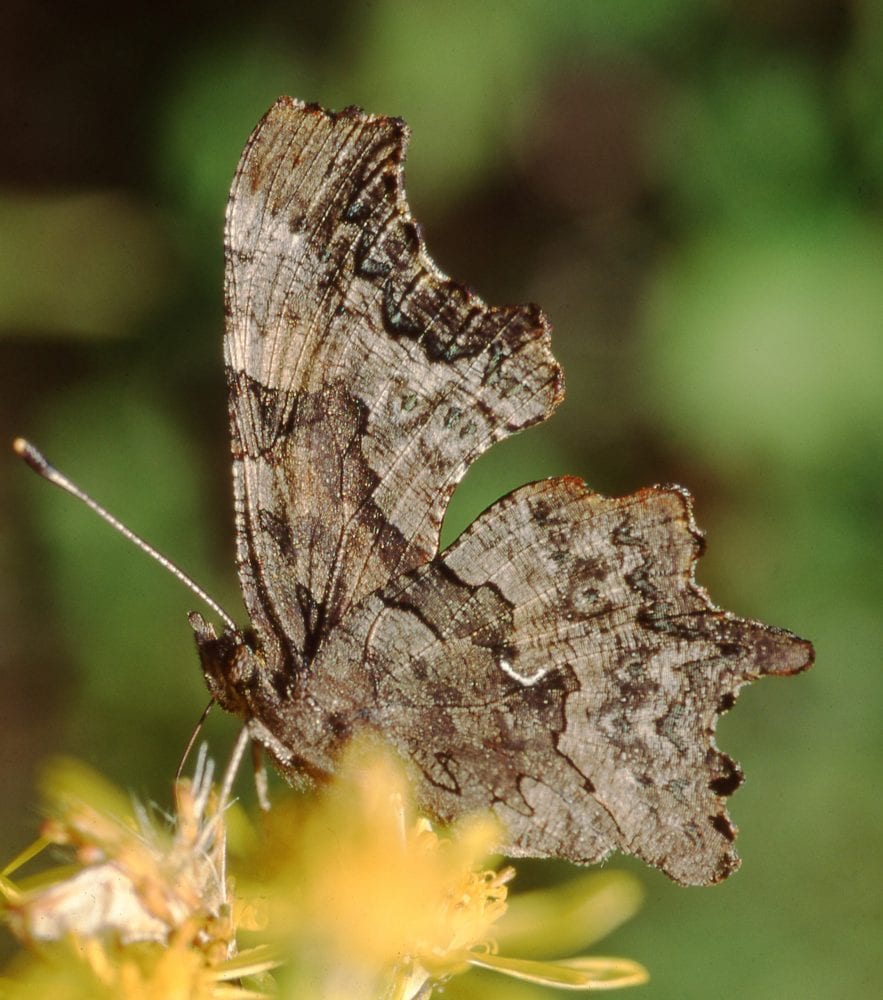
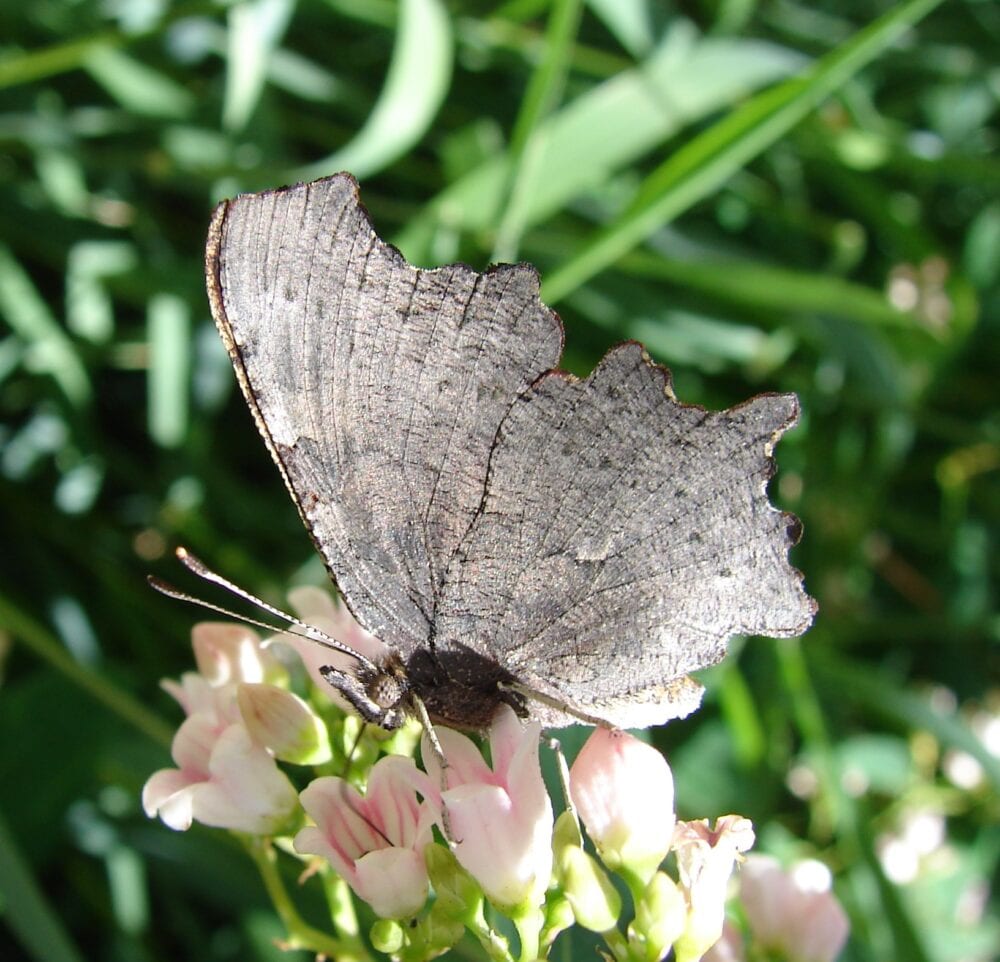

Vanessa annabella (W. D. Field 1971) West Coast Lady (updated October 17, 2023)
Description. Our three ‘Ladies’ look alike and close inspection can be required for identification. All are orange-red above with black marks. On West Coast Lady, the four ventral hindwing submarginal spots are of equal size and well hidden. The dorsal hindwing has four blue-pupiled ocelli (the two in the middle are larger) capped inwardly by dark eyebrows. The dorsal forewing subapical area has a pale orange bar that is white in Painted Lady. Range and Habitat. This is our least common Lady. It occurs throughout western North America from British Columbia to New Mexico. Strays are reported from the Great Plains. In New Mexico it is widespread, but never common, preferring Transition and Canadian Zone habitats (all counties but Ha,Le,Qu). Life History. Hosts are Malvaceae (e.g., Lavatera, Malvastrum, Malva, Sida, Sidalcea) and Urticaceae (Urtica species). Paul Opler saw larvae on hollyhock (Althaea species) in Taos (Ta). Adults, larvae and pupae overwinter. Flight. New Mexico experiences West Coast Lady peak flights in May, July and October. The autumn brood overwinters and flies again in spring along with adults eclosing from hibernating pupae. Extreme dates are February 26 and December 29. Adults nectar and males are moderate hilltoppers. Comments. Vanessa annabella also has gone by the name Cynthia carye (Hübner 1812) a separate species found in South America (Cynthia is currently considered a synonym of Vanessa).
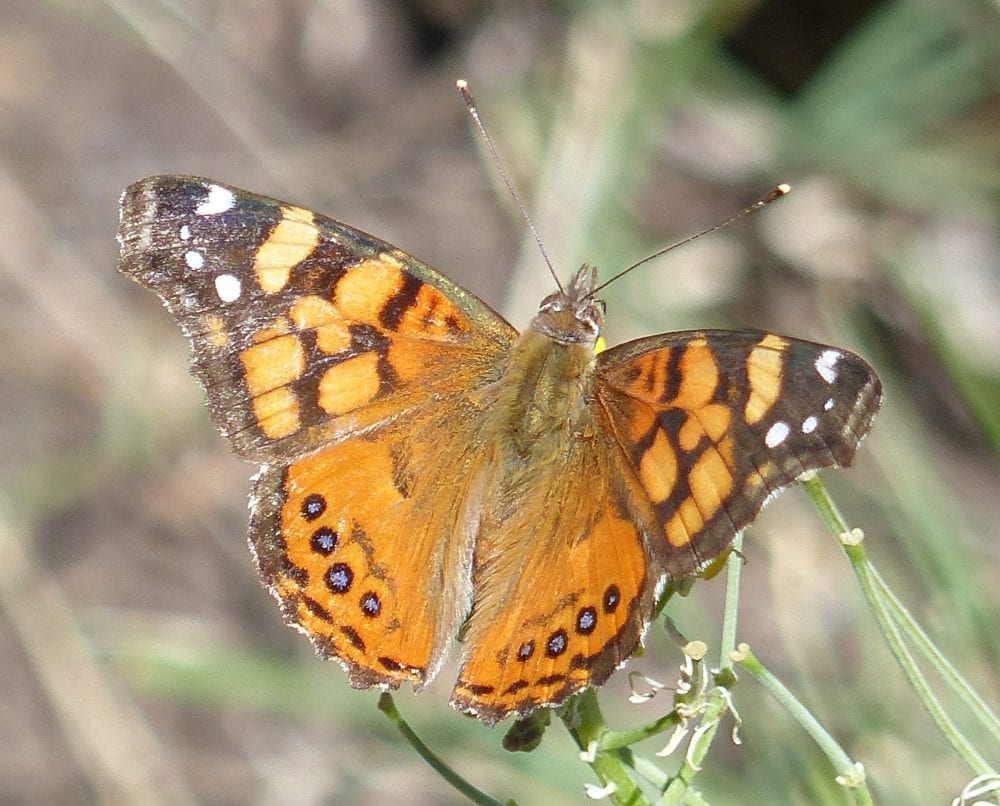
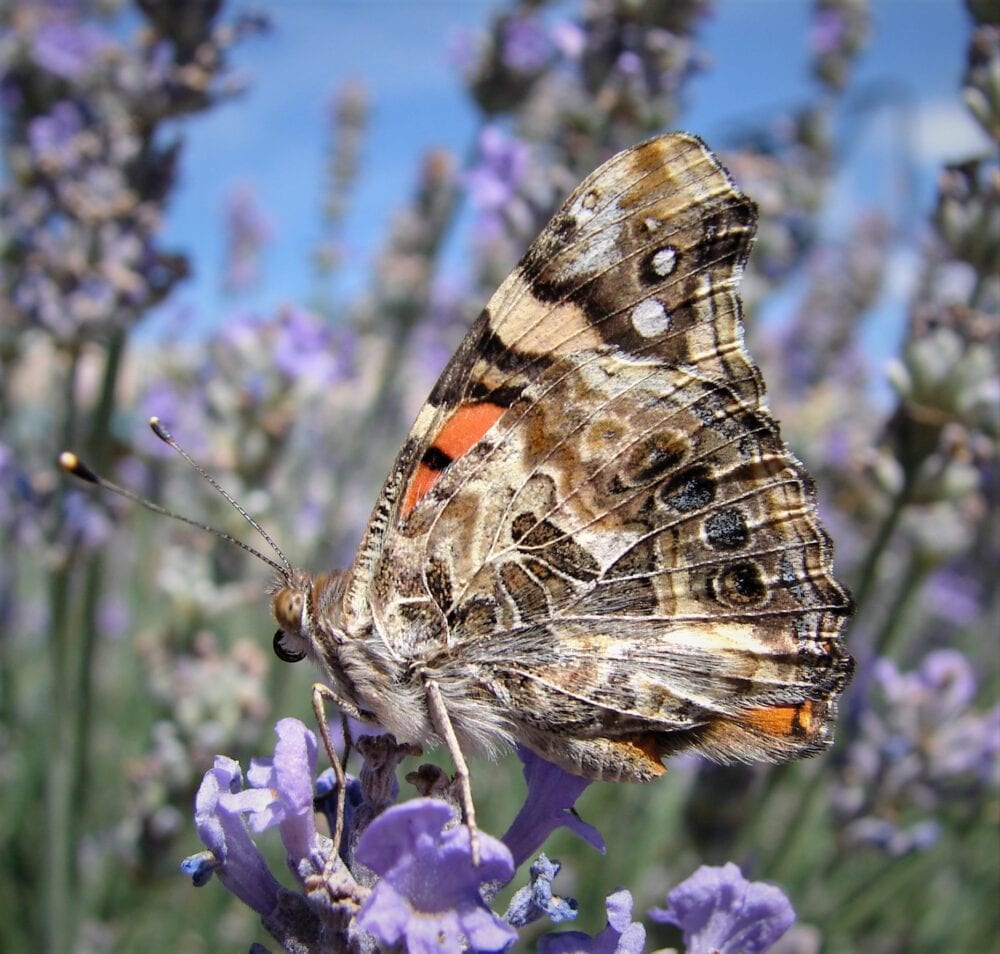

Vanessa virginiensis (Drury 1773) American Lady (updated October 17, 2023)
Description. American Ladies look like Painted Ladies, but the hindwing below has two large eyespots. Above, the outer two HW ocelli are large and blue-centered. Orange on the dorsum tends toward coral; dark marks are reduced. There is a distinctive white dot in the cell below the dark tip of the FW, lacking in the other “Ladies”. Range and Habitat. Vanessa virginiensis lives in the Neotropics and in temperate North America. It can very mobile and is even reported from Europe. In New Mexico it occurs statewide (all counties) in fields and meadows, at any altitude. Life History. Larvae eat plants in several families, but they prefer composites (Asteraceae) from the genera Gnaphalium, Antennaria and Anaphalis. Adults and chrysalids overwinter. Flight. Vanessa virginiensis is uni- to bivoltine depending on altitude. Low elevations have a September flight that hibernates and flies again in April. Offspring fly from May to July, peaking in June. At higher sites, adults fly from June to August. Extreme dates are March 8 and December 17. Males are hilltoppers. Both sexes go to nectar. Comments. Despite a close resemblance to Vanessa cardui, the two are seen so often that one quickly learns to tell them apart.
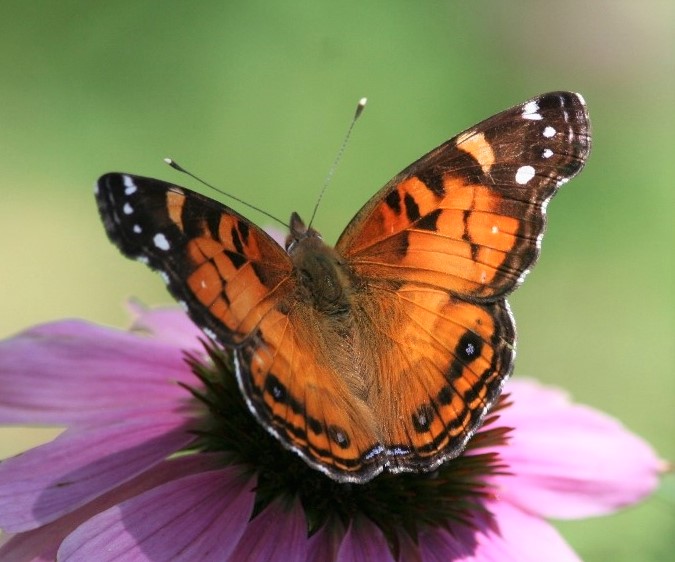
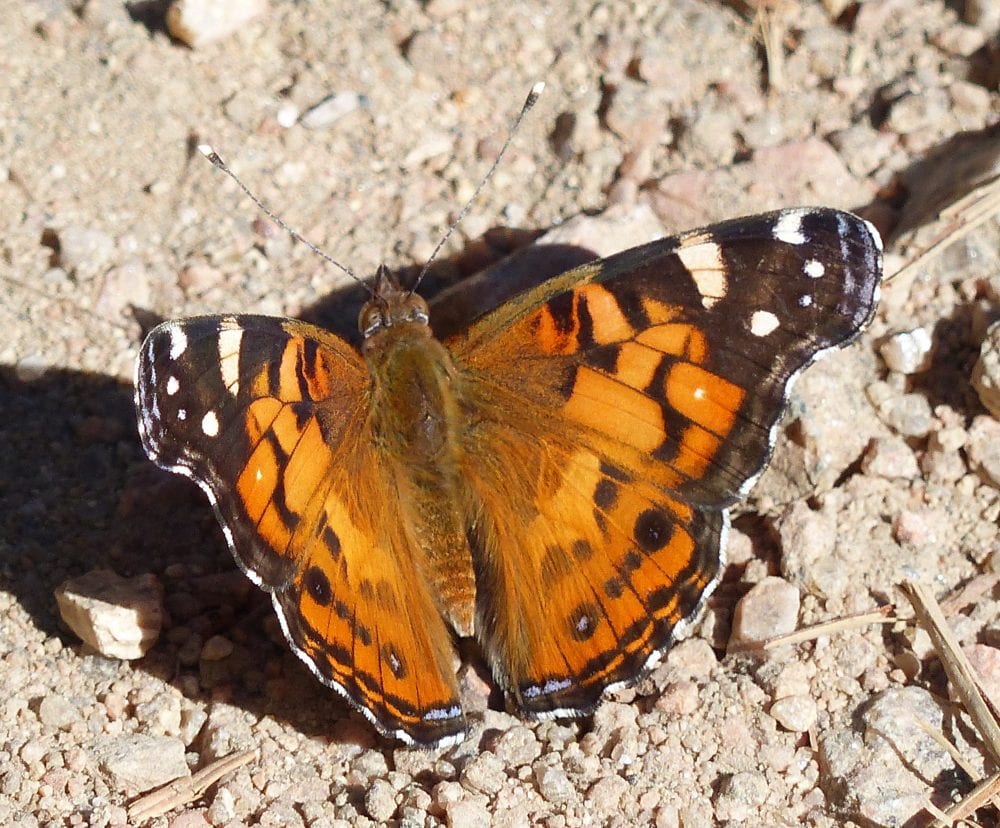
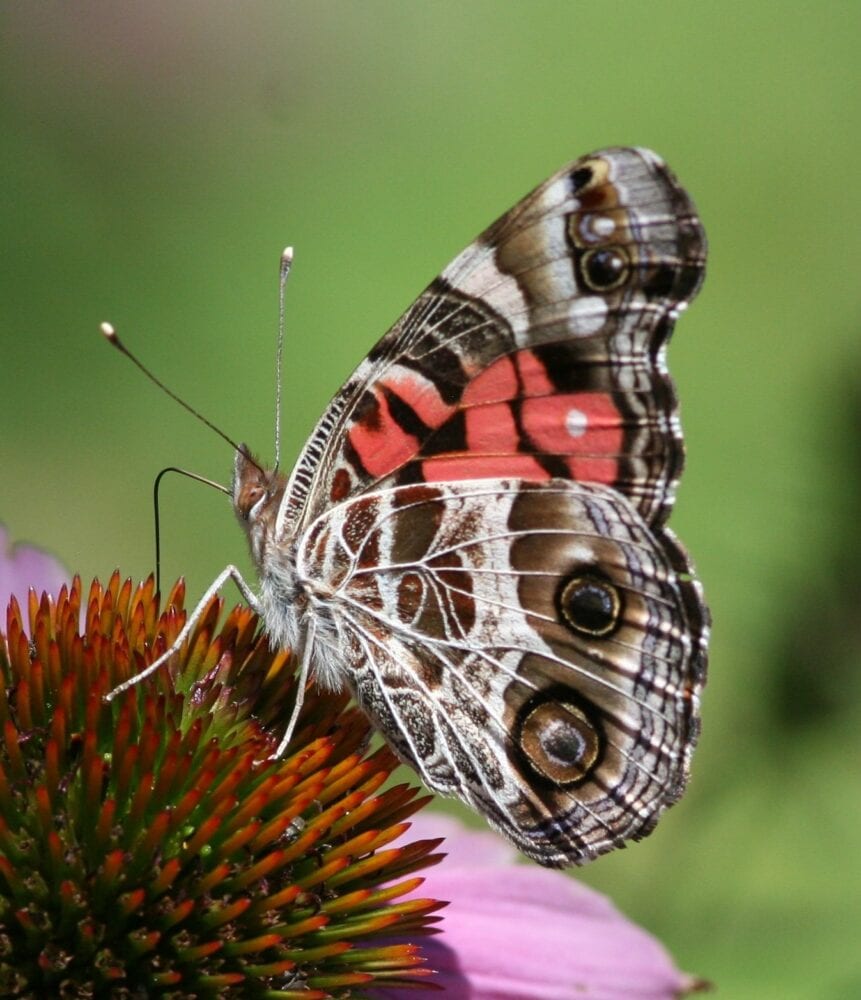
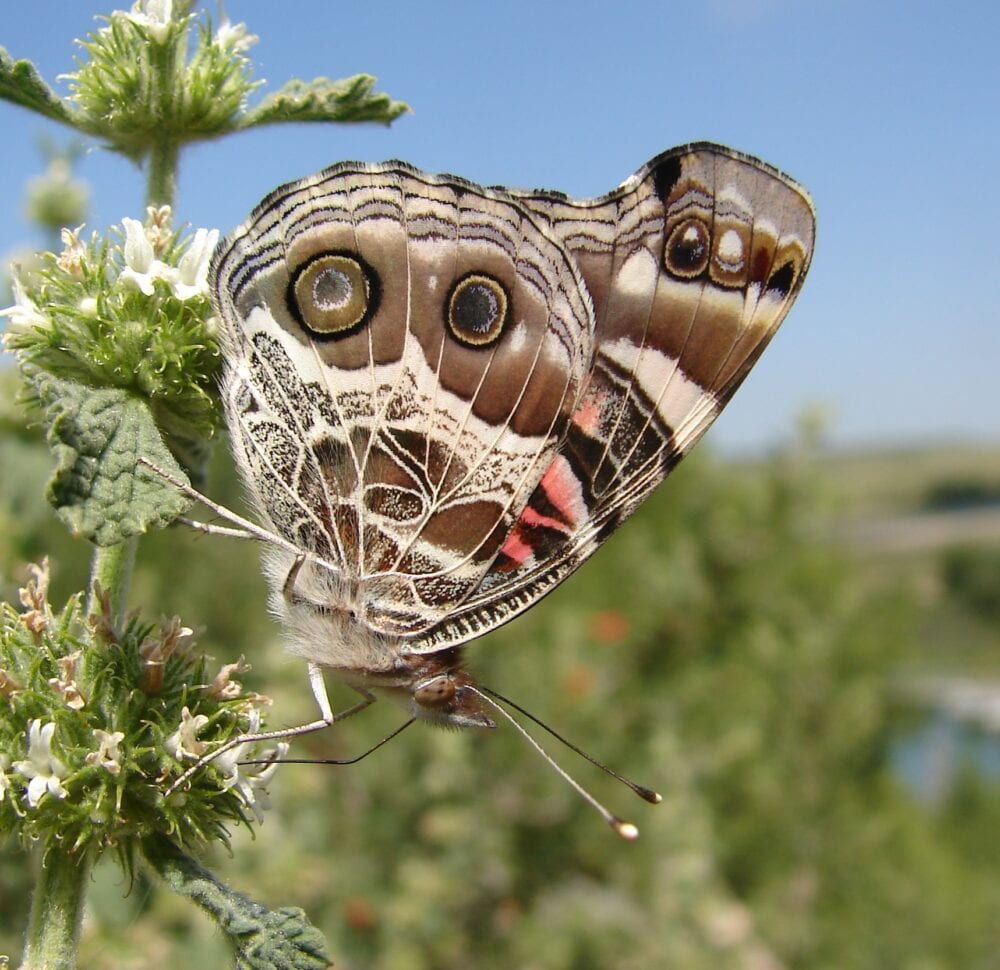
Vanessa cardui (Linnaeus 1758) Painted Lady (updated October 17, 2023)
Description. Like its less common sisters, Painted Lady is orange-red marked with black above. The four or five ventral hindwing submarginal ocelli are variable in size. The dorsal hindwing has four ordinary small dark spots. Range and Habitat. Vanessa cardui is known from almost every continent. Absent only from Antarctica, it is the most widely distributed butterfly on Earth. It breeds year-round in the American tropics and invades northward each spring. Expect it anywhere in New Mexico (all counties), almost any time. Life History. Larvae prefer to eat thistles (Cirsium species; Asteraceae), but they also use other composites and plants from other families. Flight. Adults invade in spring (March and April) and initiate multiple, overlapping generations from March to October. It is becoming more evident that autumn adults fly south to escape winter, which kills all life stages. Extreme observation dates are January 11 and December 30. In 1950, O. D. Standard found it scarce near Belen (Va) until November, when good numbers were observed. Males are strong hilltoppers, even defending rooftops in flat terrain and chasing intruders until dusk. Both sexes nectar greedily and are familiar garden guests. Comments. The spring influx of north-bound Painted Ladies is predictable, but their numbers vary widely from year to year. In some years, they so numerous that automobile traffic is a serious hazard to them. We are only beginning to learn about their southward flight in autumn.

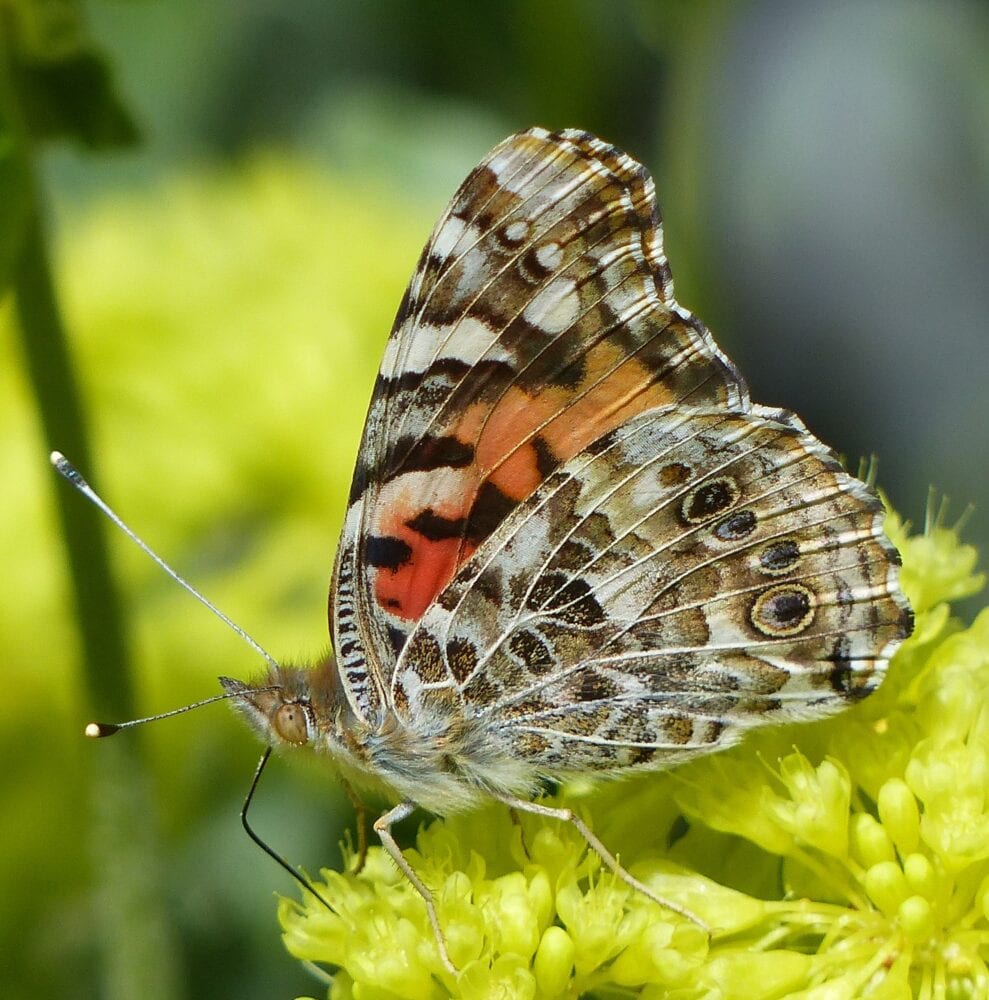
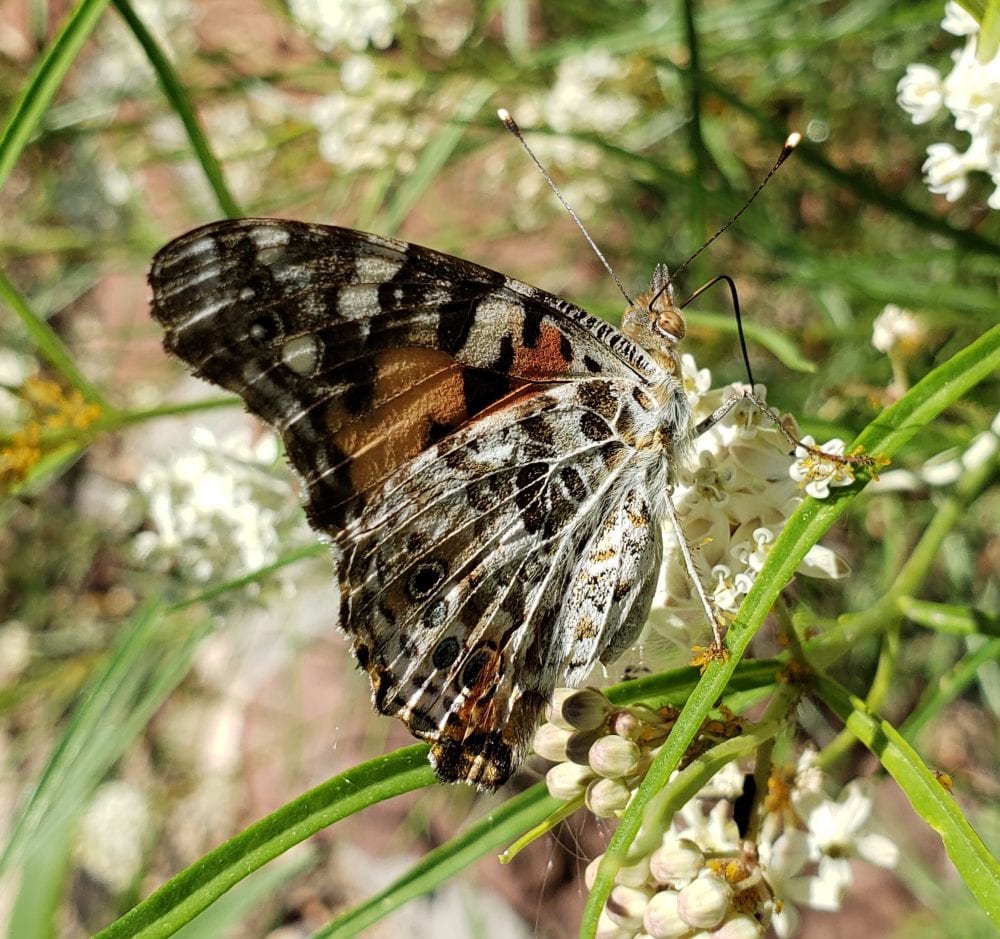
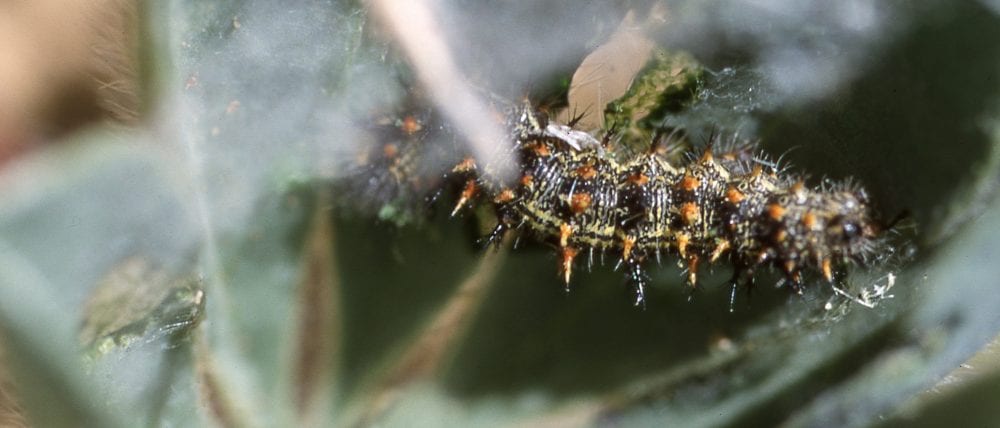
Vanessa atalanta (Linnaeus 1758) Red Admiral (updated October 17, 2023)
Description. Red Admiral is distinctively marked with red stripes across a black forewing and a red border on the hindwing. Range and Habitat. Red Admiral is native to North America, Eurasia and North Africa. It is known from central Canada to Central America and it breeds throughout New Mexico (all counties), from 3300 to 10,000′ elevation. Life History. Larvae eat stinging nettle (Urticaceae). Paul Opler found larvae eating Urtica dioica gracilis in Taos (Ta) on 30 July 1986. Scott (1992) found larvae on that host in Sapello Canyon (SM) on 23 August 1978. Urtica gracilenta is also reported. Winter is passed as adult or pupa. Flight. Two broods are completed annually in New Mexico. A late summer or fall generation hibernates and flies again in spring. Young of that brood mature and fly in summer: May to June in most places, but August in southwest New Mexico. Extreme dates are February 6 and December 14. Adults are rapid, erratic flyers; they seek nectar and water. Comments. “Butterfly, butterfly! Black with scarlet bands. . . . A scrap of velvet . . . swoops above the asphalt, soars over a speeding car and a tall building, into the humid azure of the April sky” (from Gods, a short story by Vladimir Nabokov, 1924). North American Red Admirals are Vanessa atalanta rubria (Fruhstorfer 1909).
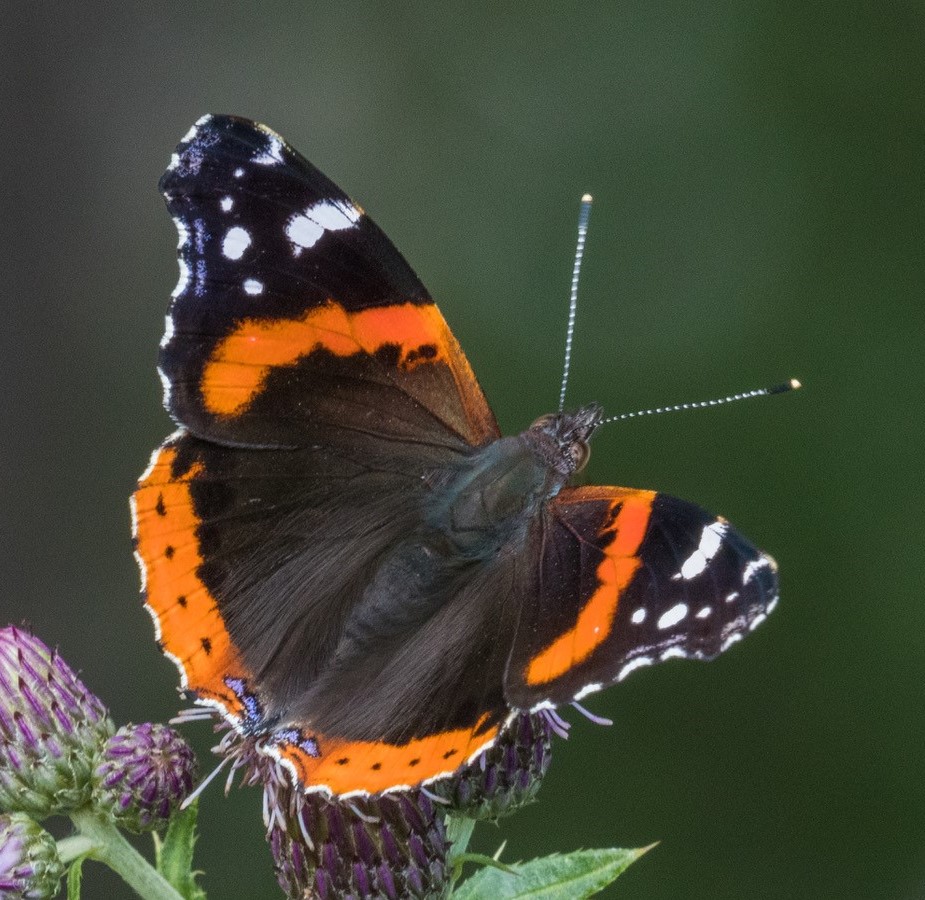
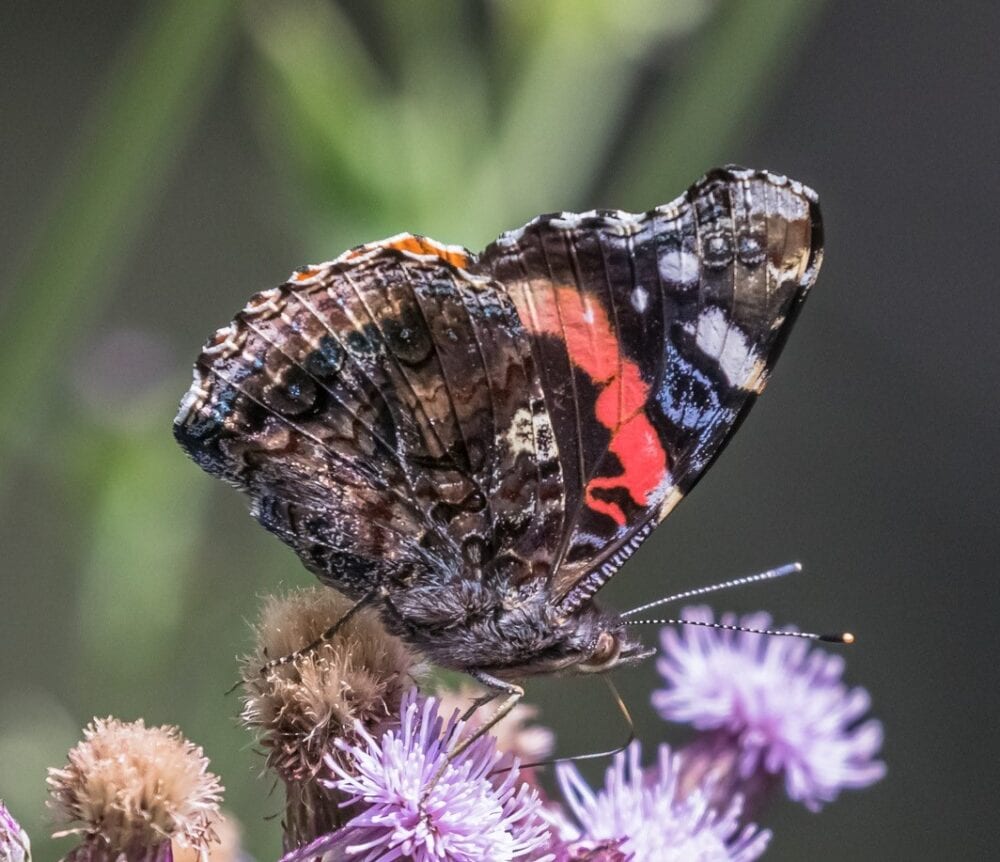
Anartia jatrophae (Linnaeus 1763) White Peacock (updated October 18, 2023)
Description. White Peacock is a moderate-sized butterfly. It has a very un-Nymphalid appearance: a ghostly whitish cast with pale yellow and gray markings and an irregular wing margin. Dorsally, it has two bars in the FW cell and two eyespots reminiscent of the Hackberry Emperor. The dorsal HW has two submarginal eyespots and a small tail. The ventral surface is a reflection of the dorsal surface with some of the median lines more emphasized. Range and habitat. Anartia jatrophae is a tropical butterfly that breeds as far north as south Texas and south Florida. Any individuals that turn up here in our inland, upland, temperate climate state are purely accidental, but it does happen. Other strays have been recorded as far north as Utah, Missouri, Chicago and Boston. Life history. Hostplants for larvae have been confirmed among the Verbenaceae, Acanthaceae, Lamiaceae and Scrophulariaceae, but no life stage can survive New Mexico winters. Flight. White Peacocks breed and fly throughout the year in tropical and subtropical areas. Adults are not strong flyers, but stay near the ground seeking nectar. Strays to New Mexico are most likely during and after the summer thunderstorm season. Comments. Our single record is from Rattlesnake Springs (Ed), 13 September 1986 (S. Cary). Presuming that this individual strayed here from Texas, it belonged to the western subspecies Anartia jatrophae luteipicta Fruhstorfer 1907.
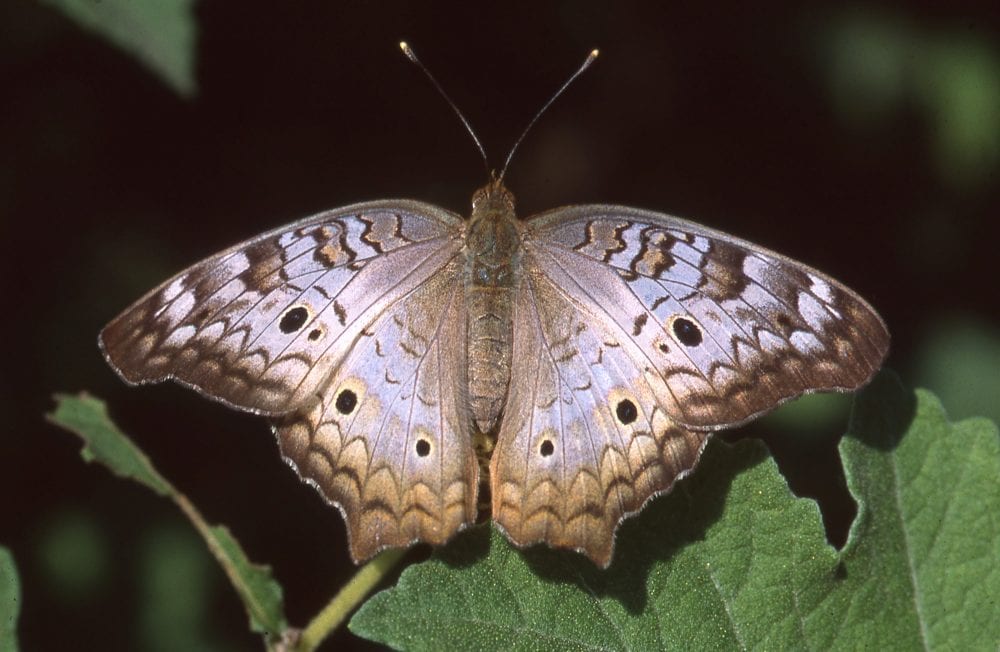
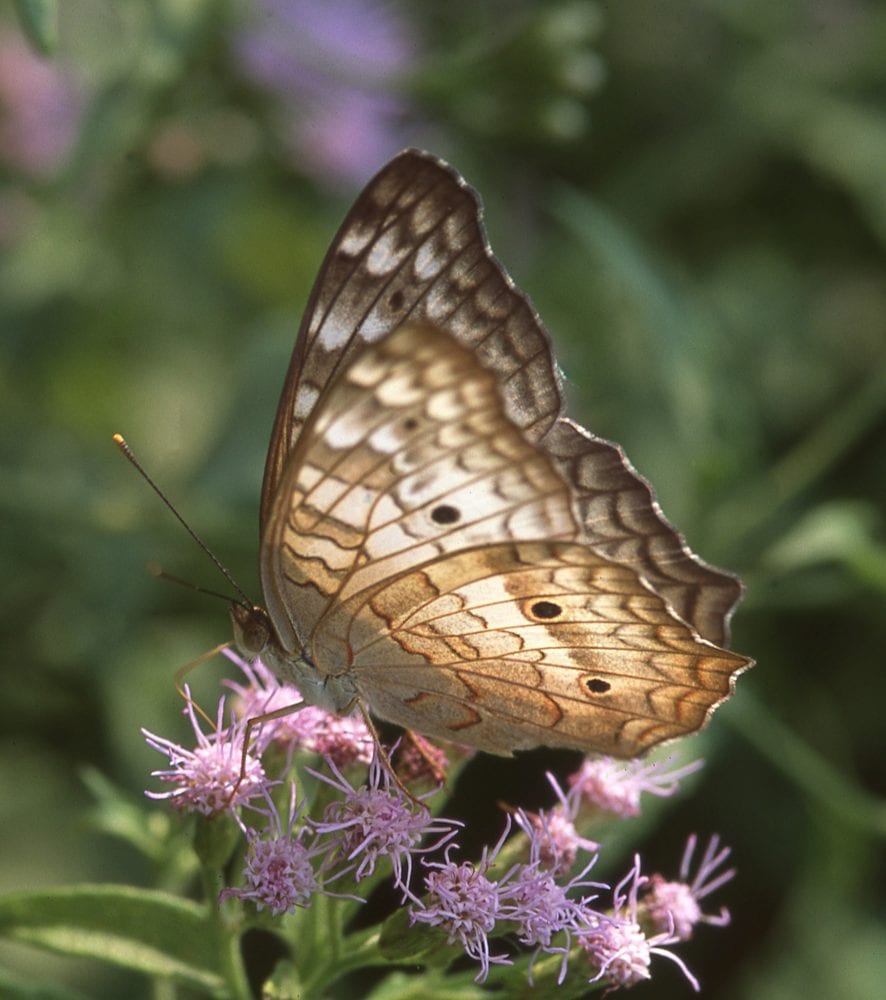

Siproeta stelenes (Linnaeus 1758) Malachite (updated October 19, 2023)
Description. Malachite, probably named after a greenish copper mineral, is a large, showy, Neotropical butterfly. No other butterfly in North America looks like this gorgeous species. Range and habitat. This is a tropical butterfly, with a typical range from Brazil north to southern Florida and southern Texas. Strays have been found as far north as Kansas. Life history. Larvae eat Acanthaceae, but don’t expect reproduction in New Mexico. Flight. In the southernmost US, there are two to three broods. The last brood of the season hibernates. Comments. It strays rarely to southern Arizona and southern New Mexico in the southwest. One was caught just south of the NM/TX border at Choza Spring, Guadalupe Mountains National Park, Culberson Co., TX, on 22 August 1987, by Richard Holland. The first substantiated New Mexico report was from Rattlesnake Springs, Carlsbad Caverns National Park (Ed) in summer of 2002 (G. Emmons, per CCNP biologist Renee West). A second individual was spotted in Victorio Canyon in the Florida Mountains (Lu) on 14 May 2009 by Larry Malone and Gene Jercinovic.
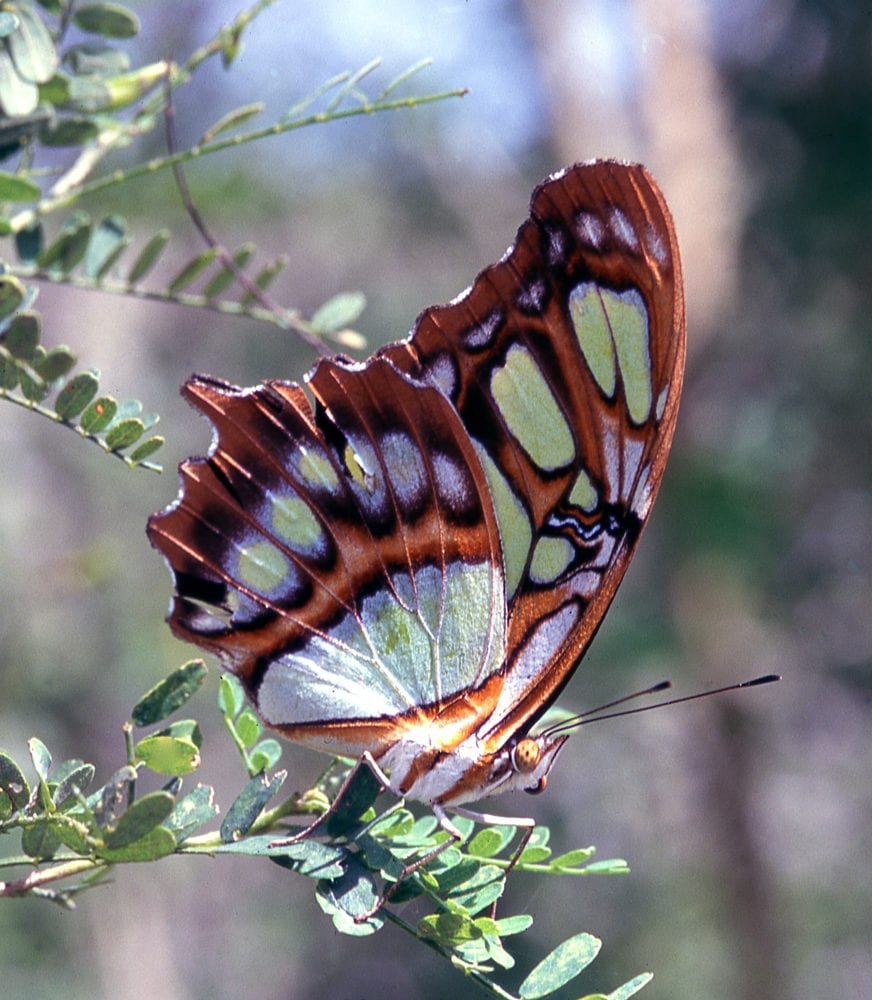
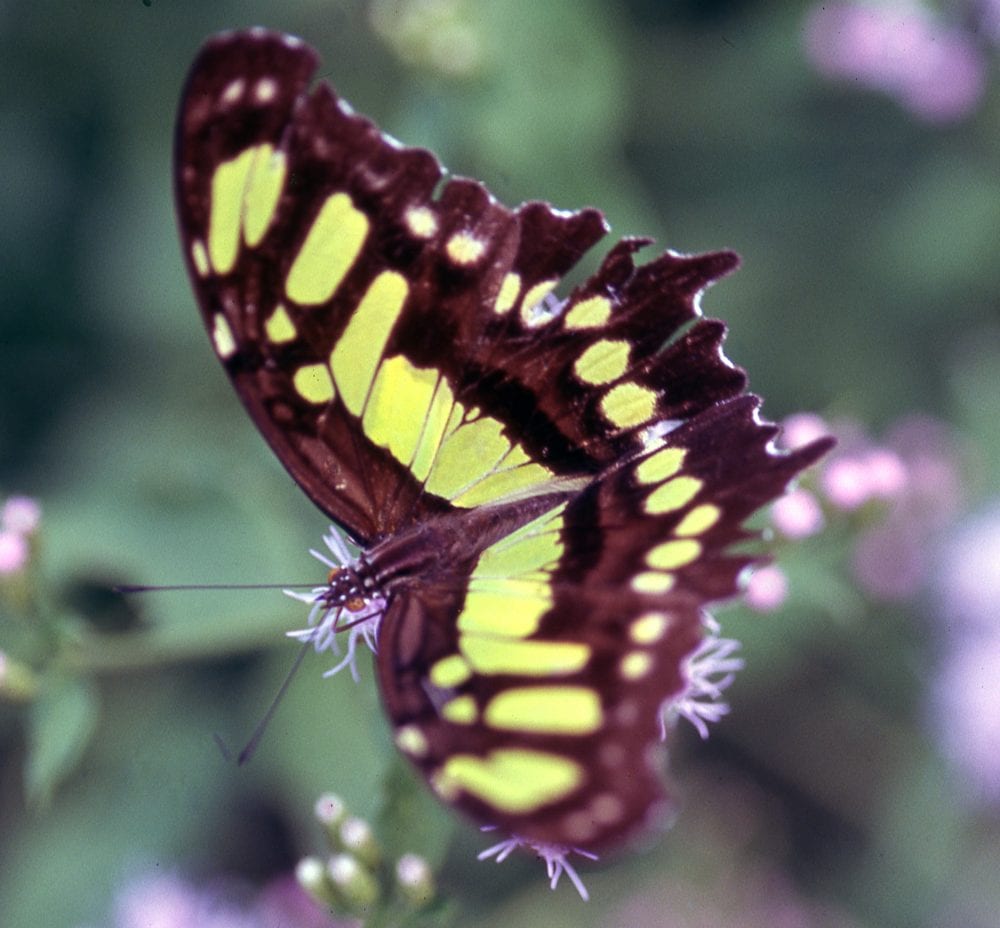

Siproeta epaphus (Latreille 1813) Rusty-Tipped Page (updated October 19, 2023)
Description. Like its cousin the Malachite, the Rusty-Tipped Page is uniquely marked. The dorsal surface of the forewing is divided roughly in half by a white median band. The outer part of the forewing gives the butterfly its name, being rust colored. On the inside of that median band, the color is velvety black. The hindwing is also velvety black with a white submarginal band and white marginal chevrons. The underside is a pale reflection of the upperside. Range and habitat. This is also a tropical butterfly, with a typical range from Peru through Mexico. It has rarely been found north of the border. Life history. Rusty-Tipped Page larvae feed on plants in the Acanthaceae family. Flight. Found year-around in its tropical habitat, our single record is from December! Comments. New Mexico has one of only three US reports of this large, tropical butterfly. Our record of this distant and extremely unusual stray resides in the collection at Oregon State University in Corvallis. It was collected by C. Bruhn on 13 December 1960 in Mesilla (Doña Ana County). The only other known US reports of this species are from south Texas and one of those may have escaped from a zoo (Glassberg 2017).
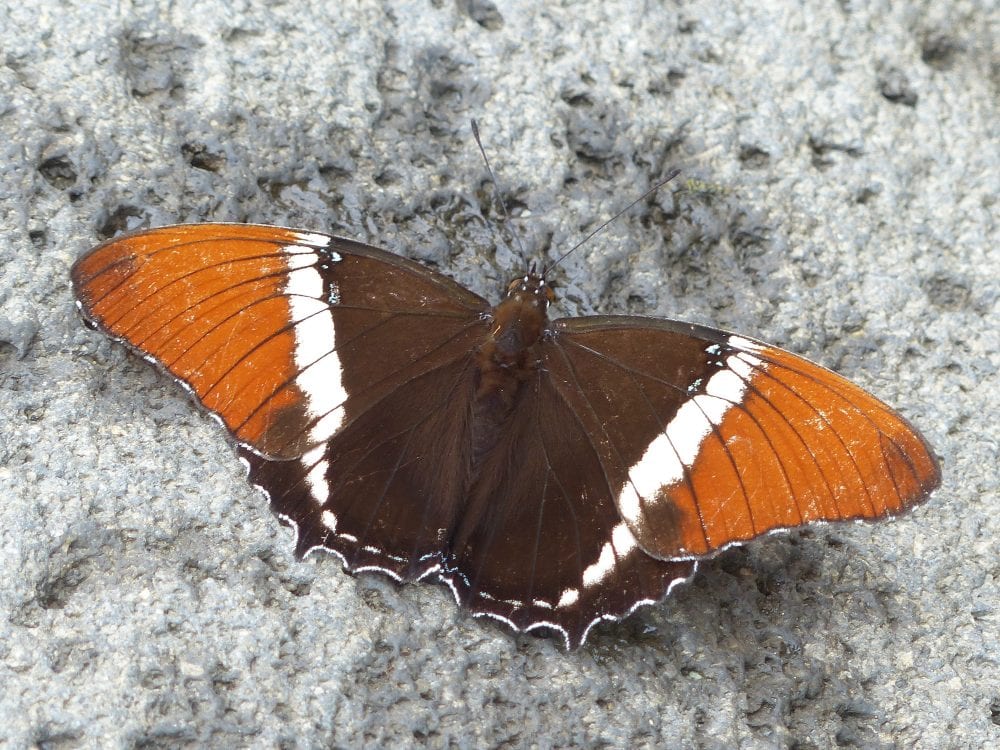

The Buckeyes – Junonia.
Recent genomic work on Buckeyes has revealed some hidden species and raised difficulties in discerning which species occur in NM. At this point, it seems that we have three species. Because of extensive hybridization and individual variation, distinguishing which species one has in hand (or in one’s camera) can be difficult to impossible. The following figure, from Cong, et al, 2020, may help users determine what they’ve seen.

Lalonde and Marcus (2018: Figure 8, p. 69) found specimens in NM that were deemed hybrids of all three combinations (based on mitochondrial DNA): grisea x coenia, nigrosuffusa x coenia, and nigrosuffusa x grisea. Cong et al., 2020, found that grisea and nigrosuffusa were sympatric in AZ while coenia and nigrosuffusa were sympatric in west TX. “Due to their recent speciation and incomplete reproductive isolation between species exacerbated by phenotypic plasticity within species (Vane-Wright & Tennent 2011), it is challenging to assign Junonia phenotypic forms to taxa and to define species boundaries” (Cong et al, 2020). Because of these difficulties of identification, the maps we present with each species must be regarded as tentative and incomplete. That said, most NM reports are likely J. grisea.
Junonia coenia Hubner [1822] Common Buckeye (updated October 20, 2023)
Description. Since the recent discovery and description of J. grisea (Gray Buckeye), distinguishing NM buckeyes has become much more complicated. The image preceding this page should help. Common Buckeyes may be distinguished from Gray Buckeyes by a suite of characters. Dorsally, Common Buckeyes have a more rounded forewing apex, more orange in the cream band distad of the large spot on the forewing, a yellower ring around that large spot, and a lack of beige overscaling on the wing margin below the large forewing eyespot. The dorsal hindwing has brown coloration at the anterior wing margin, with no gray overscaling. The area between the two large eyespots lacks any beige overscaling. The orange submarginal band is wider. Ventrally, the forewing has a darker aspect than Grays. The pale band on the forewing has some pinkish color to it. On the ventral hindwing, the submarginal band contains larger eyespots and tends to contrast with the background more in the Common vs the Gray. Range and Habitat. Common Buckeye is a prominent member of the eastern US butterfly fauna, ranging throughout the eastern US from Florida and Texas to southern Canada. It is resident in the southern US but may die back from winter weather northern parts of its range, reseeding that area as summer progresses. The western edge of its range remains to be accurately determined because of confusion with the Gray Buckeye. In NM, we have tentative records from Cu,Ed,Gu,Le,Ro,Un. Any Buckeye from NM’s Eastern Plains should be closely examined to see if it is Common or Gray. Life History. Larvae feed on various plants from the snapdragon and plantain family (Plantaginaceae) and some plants from the Acanthus family (Acanthaceae). Flight. Adults may be found throughout the year in the southern US; two to three broods are typical for more northern areas. NM records range from July to October. Comments. We need more information on all the Buckeyes found in NM. Photographic evidence, while helpful, may not always be enough to determine what we have and where it’s found.
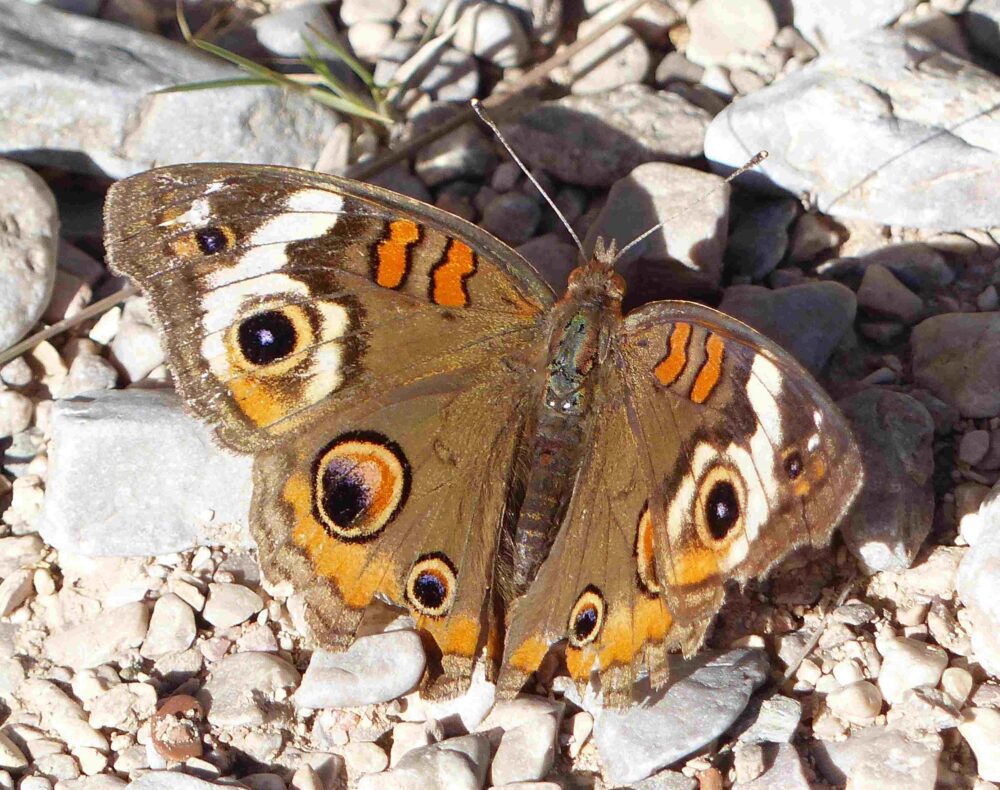
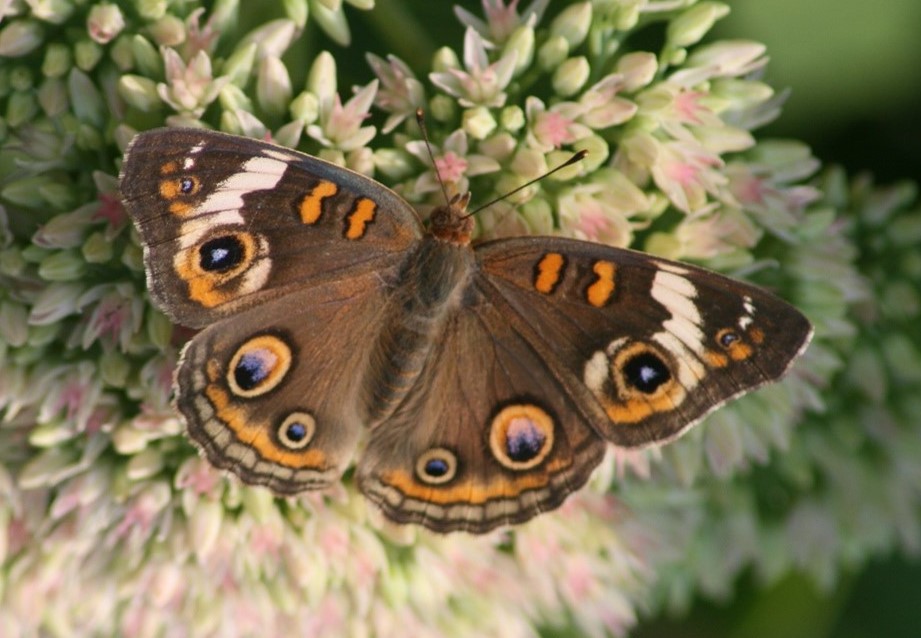
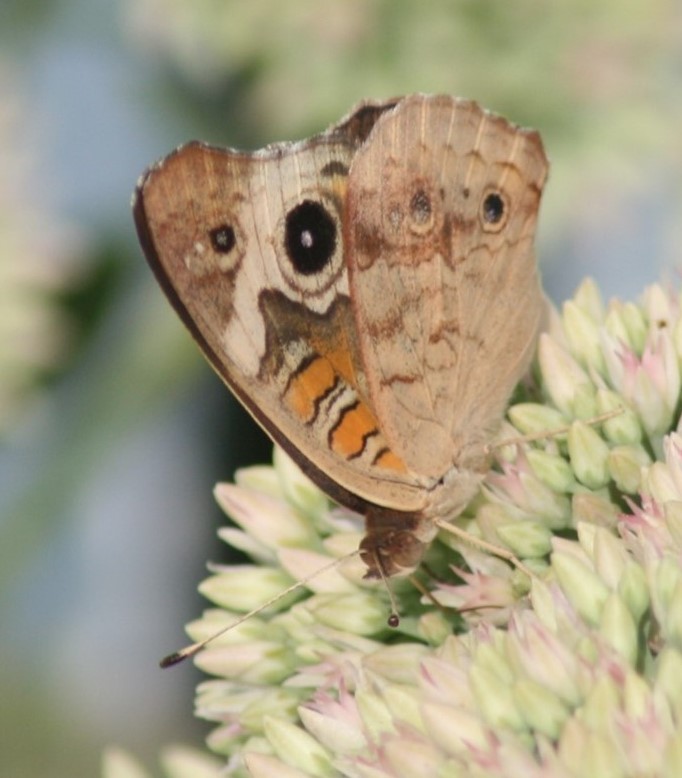


Junonia grisea Austin & J. Emmel 1998 Gray Buckeye (updated December 21, 2023)
Description. Gray Buckeyes are of medium size. A brown dorsal background is highlighted by four colorful ocelli, two orange bars in the forewing cell, orange suffusion in the dorsal hindwing postmedian area, and a prominent white band angling across the top side of the forewing. Undersides are usually a muted rose-brown, but cool season individuals can be quite rosy. Uppersides can get quite dark, approaching Dark Buckeye in general appearance, but with more colors. Look for the following characters to help separate Gray from Common: more pointed FW apex; cream colored band lacking pink; much orange, beige overscaling, smaller eyespots on the ventral HW; and reduced contrast between the eyespot-containing band on the VHW and the surrounding ground color. Range and Habitat. Junonia grisea is native to the Neotropics and subtropics from Mexico to southwestern US, sometimes straying farther north. In our state, it occurs regularly in Upper Sonoran Zone riparian areas, occasionally straying farther north and farther upstream (all counties but Ta). It is less routine above 7000′ elevation. Life History. Larvae eat Plantaginaceae, including plants in several genera (e.g., Plantago, Linaria, Gerardia, Orthocarpus, Veronica and others). Marc Bailey noted oviposition and larval feeding on Veronica peregrina in the Jemez. Flight. Males patrol creek bottoms, perch on stream bars and chase away other butterflies. Adults come to nectar and moist earth. Junonia grisea is multiple-brooded in southern New Mexico. Extreme dates for adults are January 2 and December 26, basically year-round, though rather scarce in mid-winter. Adult numbers increase through the warm season. Comments. Recent genomic research (e.g., Lalonde and Marcus 2019, Cong et al. 2020) definitively separated western Junonia grisea from eastern Junonia coenia (Hübner). In 2020, observation in New Mexico of many individuals having phenotypes intermediate between Gray and Dark buckeyes suggested hybridization. and it’s likely some of the Gray records include individual hybrids between Common and Gray. Because of difficulties in separating Gray and Common Buckeyes, our maps use open circles to indicate this uncertainty. Most are likely Grays, but without detailed observation, we can’t be sure.
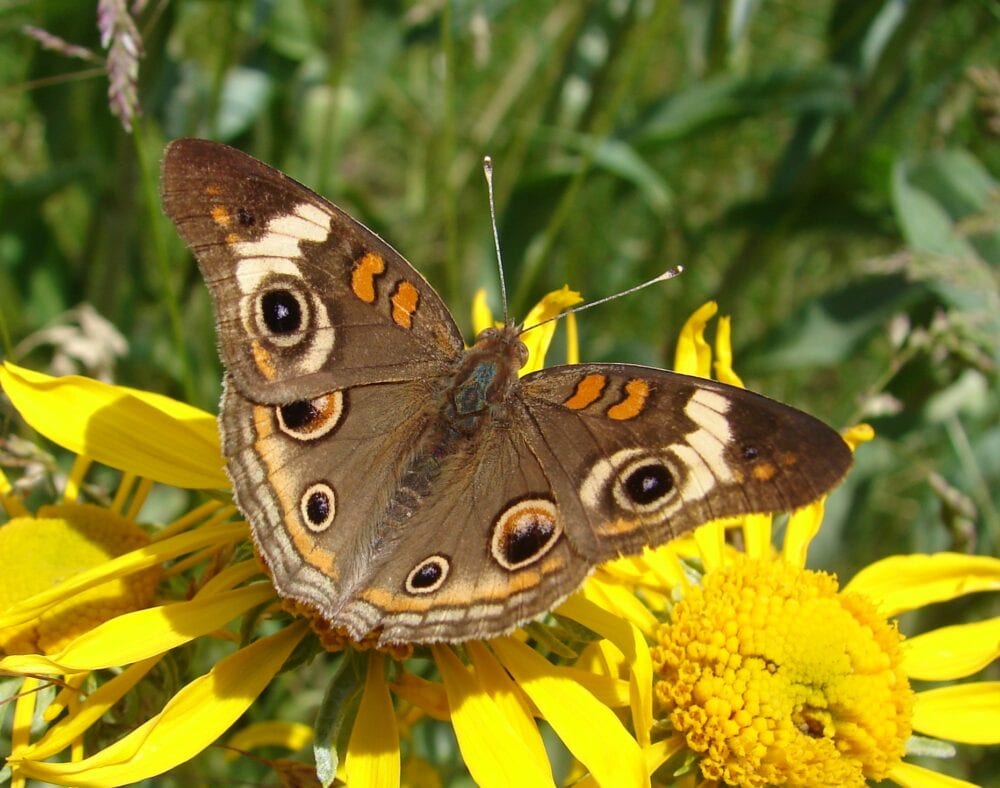
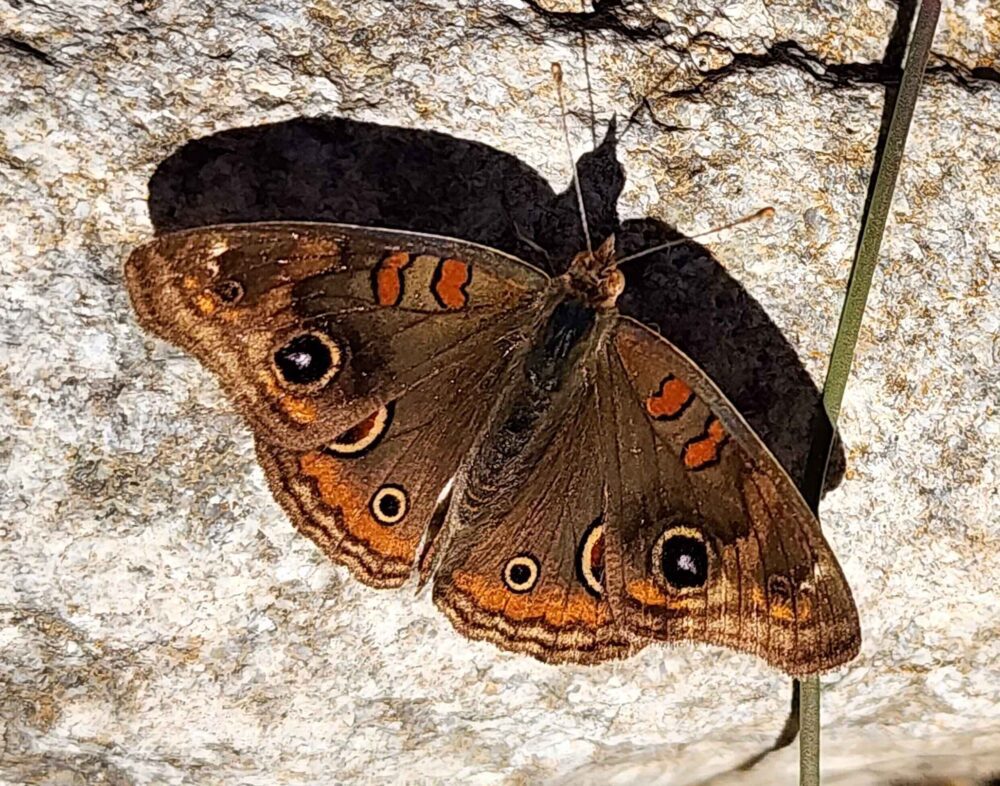
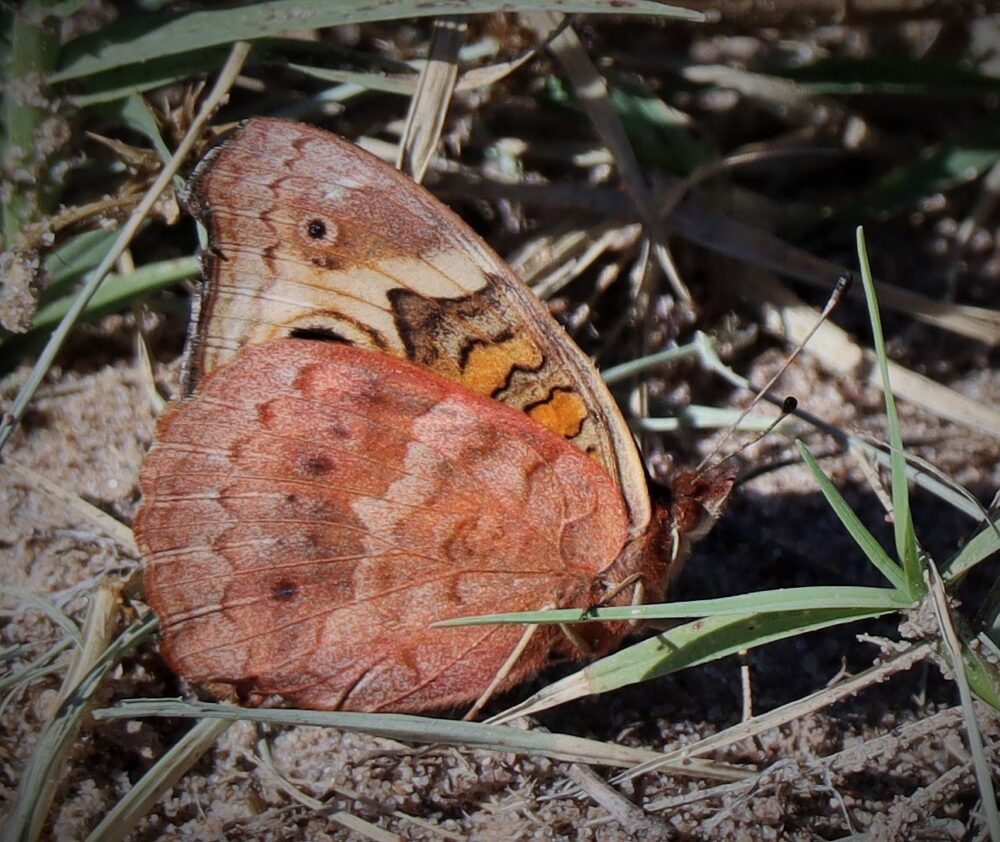

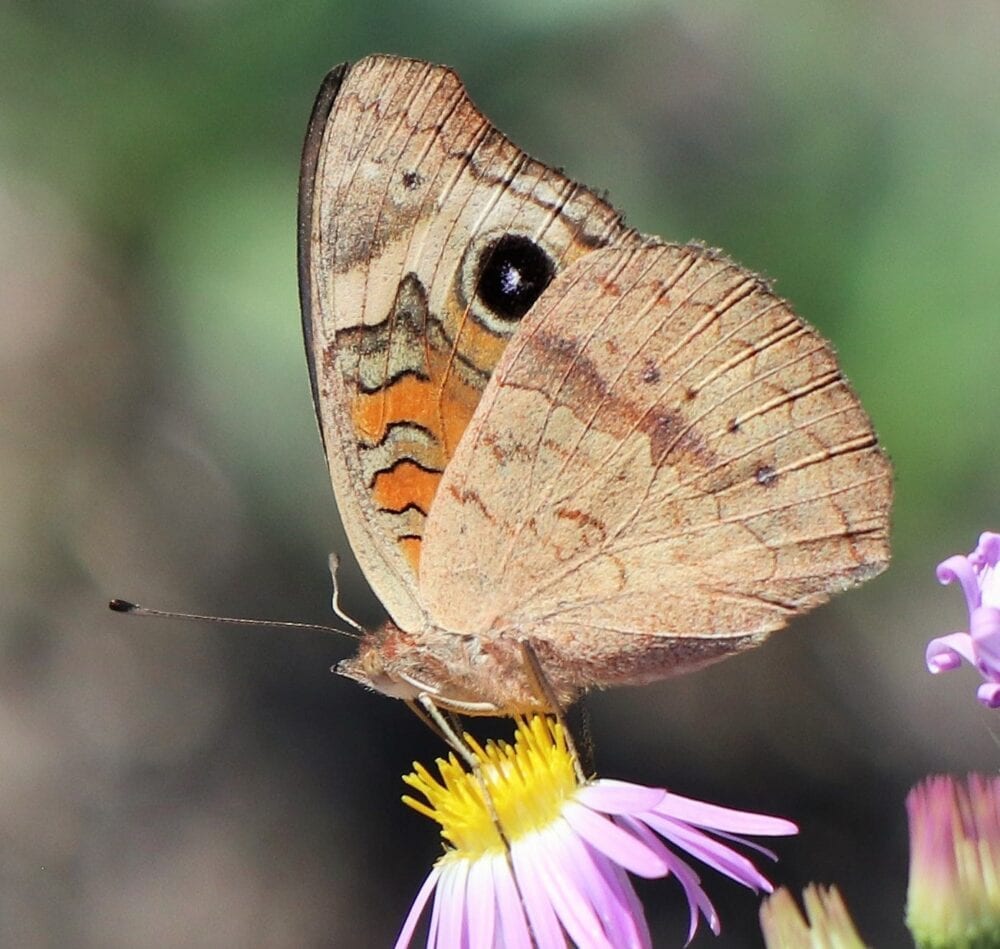
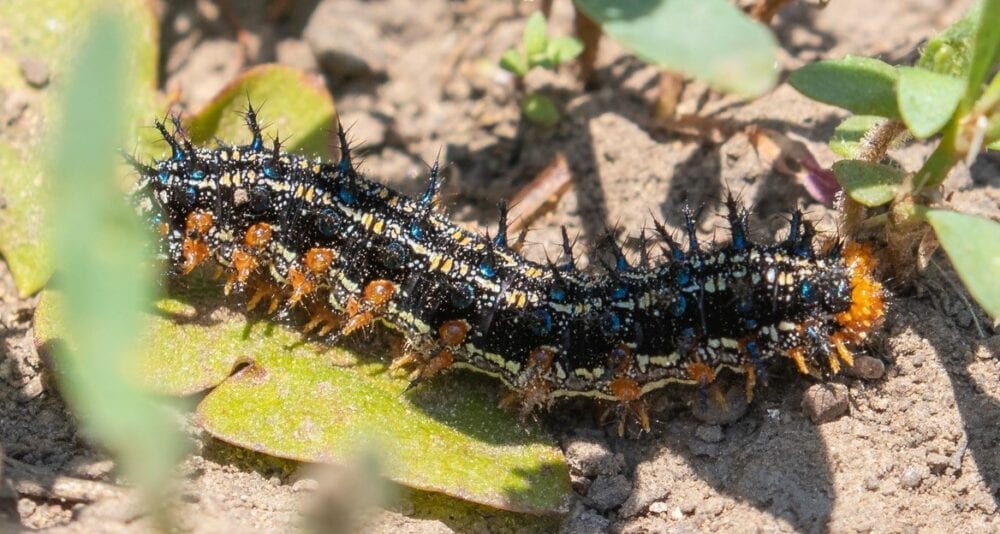

Junonia nigrosuffusa W. Barnes & McDunnough 1916 Dark Buckeye (updated October 21, 2023)
Description. Junonia nigrosuffusa is similar to Junonia grisea, but considerably darker above and with smaller eyespots. The white postmedian band which is so prominent on Gray Buckeye is smudged or muted tan-brown or orange-brown on Dark Buckeye. Confident identification is complicated by Individual variation and hybridization with Gray and Common buckeyes. Notably, the antennal nudum is pale on Dark Buckeye , but dark on the other two species. Range and Habitat. Junonia nigrosuffusa was formerly considered to reside from Central America north to the border region of the American Southwest; it was a year-round resident in south Texas and southern Arizona, but only a stray to southern New Mexico. Now it is routine along our southern border (counties: Ca,Ch,DA,Ed,Gr,Hi,Lu,Ot,Si) and an occasional wanderer north along riparian corridors (counties: Be,Ci,Li,LA,Sv,SM,SF,So,Ta,To,Va). At least in 2019-2020, it occupied much of the range traditionally occupied by Gray Buckeye. Observations of a fresh individual and oviposition in Los Alamos County in spring of 2020 imply at least occasional overwintering and seasonal breeding even in northern New Mexico. Life History. Larvae eat Plantaginaceae. Mimulus species and Veronica anagallis-aquatica are used in Arizona and suspected in southwest New Mexico. Flight. There appear to be two flights here: May to June and September to November, but perhaps three flights now in southern New Mexico. Records fall between March 16 and November 29. Adult behaviors are identical to those of Gray Buckeye. Comments. Formerly treated as a subspecies of Tropical Buckeye [Junonia evarete (Cramer)], recent genomic work (Cong et al. 2020) boosted Junonia nigrosuffusa to full species status. Expect that hybridization with Gray Buckeye will produce some intermediate forms.
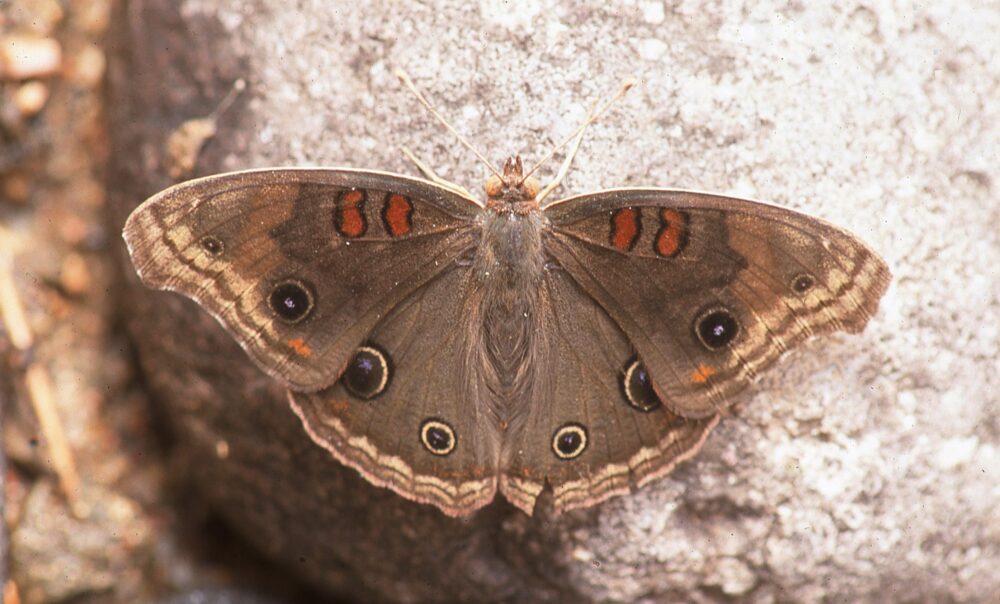
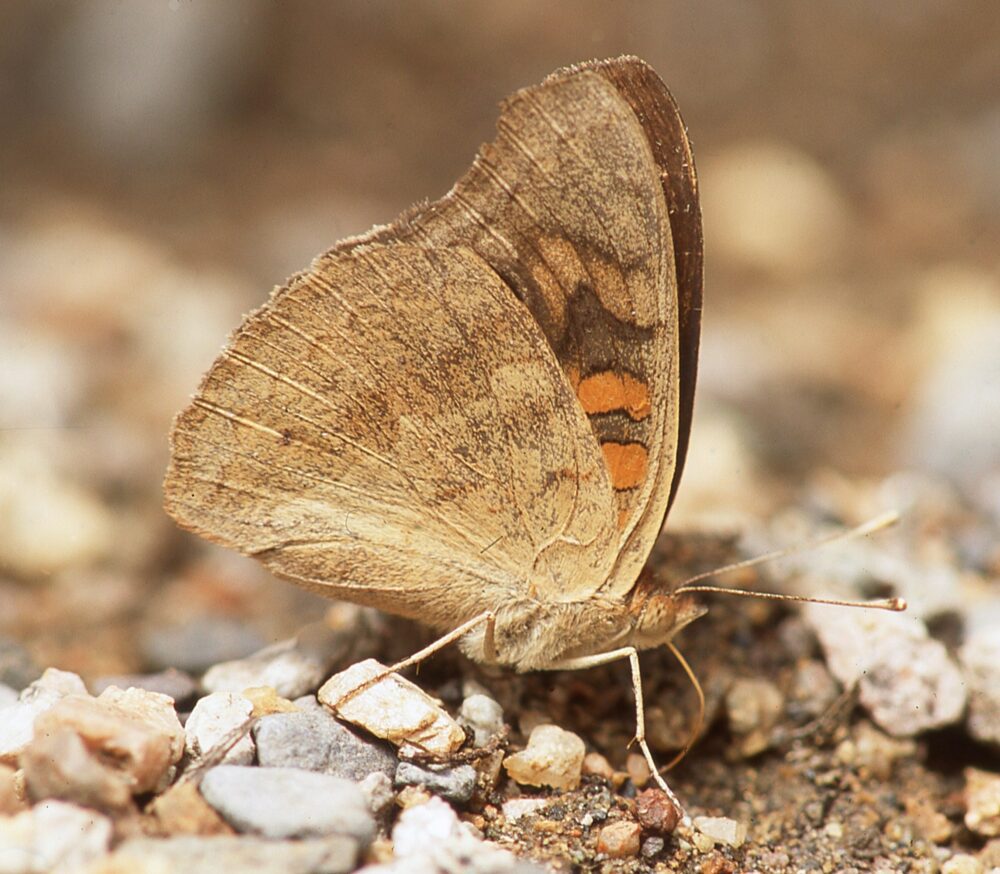
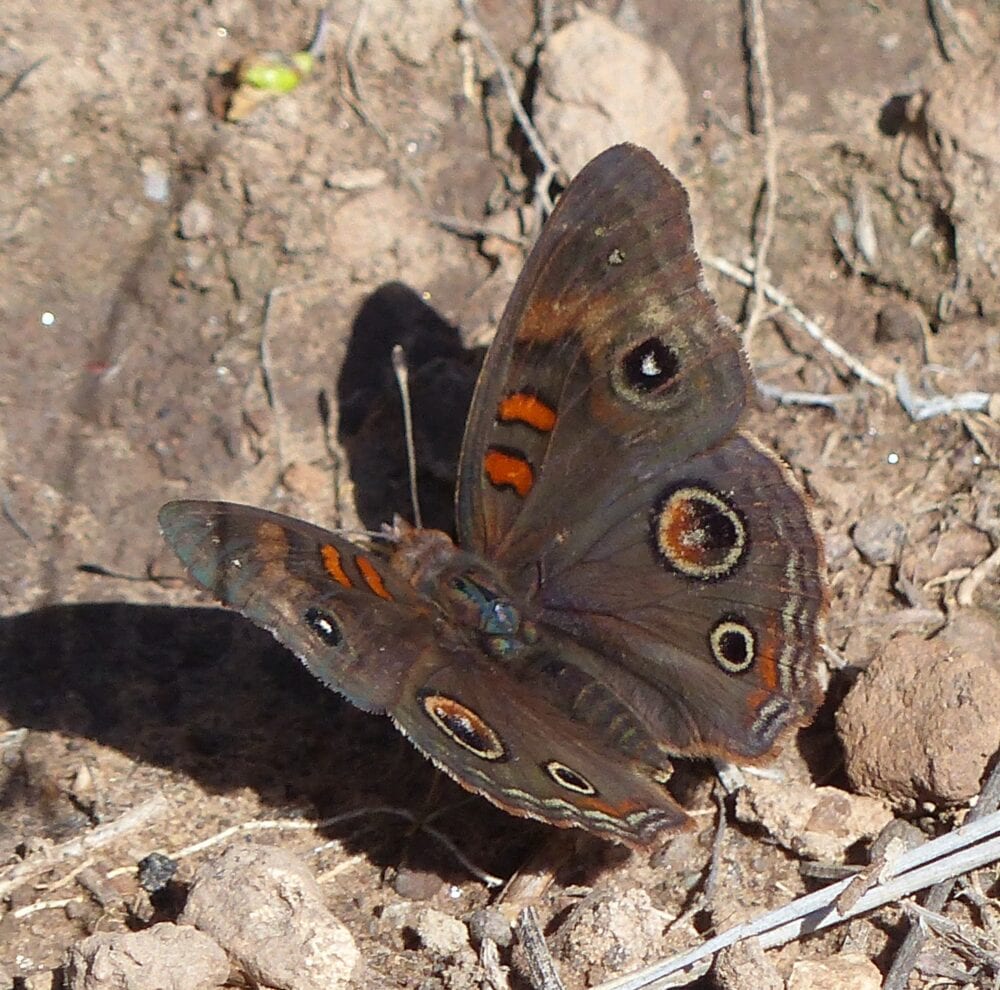
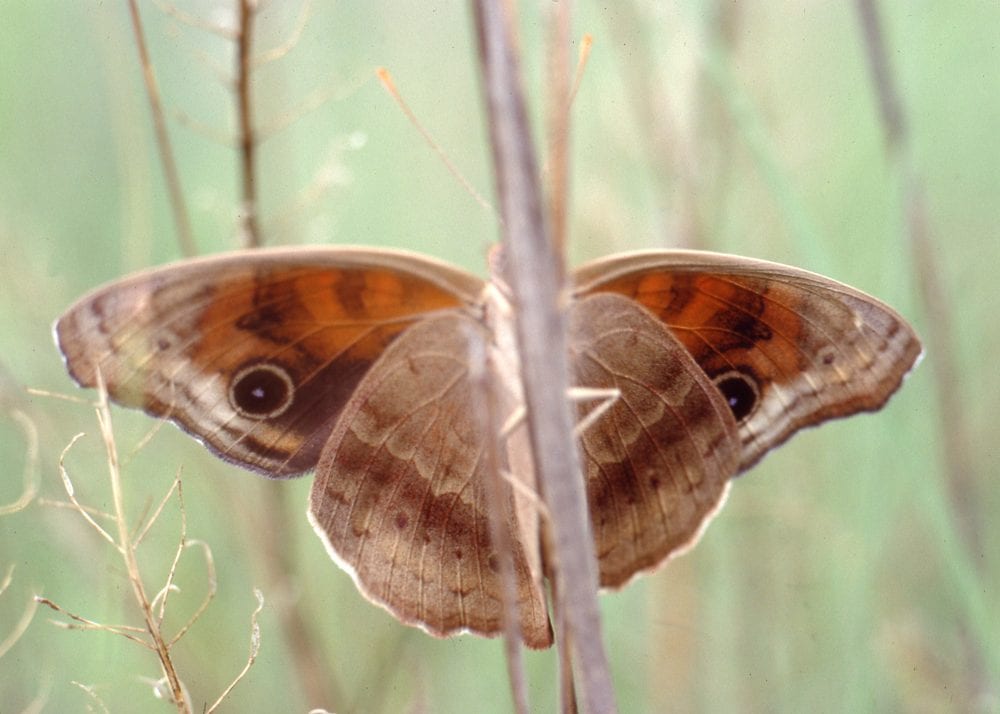

Euphydryas anicia (E. Doubleday 1847) Anicia Checkerspot (updated August 15, 2024)
Description. Anicia Checkerspot is checkered all over with bands of red, white and black spots. Many different geographic races have been described based on local variations (see below). Range and Habitat. Euphydryas anicia lives in western North America from Alaska south to Sonora and from Nevada east to North Dakota, inhabiting all life zones, in one place or another, from Lower Sonoran to Alpine. This same range of habitats is occupied in New Mexico, but in a selective way such that this butterfly is absent from many places where it might be expected. Life History. Larvae usually eat plats in the plantain family (Plantaginaceae), including paintbrushes (Castilleja species), penstemons (Penstemon species), Besseya alpina and likely others. Young larvae live in communal webs at plant bases, then diapause for winter. Flight. Flight periods of the various subspecies are discussed in detail below. Comment 1. We changed the English name of this bug from “Variable” to “Anicia” because there were two “Variable Checkerspots” and that is at least one too many. That shift for Anicia may haunt us for a while. Some older butterfly guides may have this species under Occidryas anicia. Comment 2. Two other species of Euphydryas approach NM, from the north: Edith’s Checkerspot (Euphydryas editha [Boisduval 1852]); and possibly from the west: Variable Checkerspot (Euphydryas chalcedona [E. Doubleday 1847]). Distinguishing these two from Anicia is not an easy matter. Edith’s lacks white abdominal spotting, usually appears earlier in the season and tends to be redder. Edith’s could eventually be found in the NW corner of NM. Variable Checkerspot seems to be largely a West Coast species that tends to be larger and darker and flies in drier habitats; until the boundaries separating it from Anicia are clear, records of Variable (E. chalcedona) near NM are suspect. Comment 3. To complicate matters further (as seems to be the rage in Nymphalinae), Butterflies of North America (https://www.butterfliesandmoths.org/species/Euphydryas-chalcedona) lists a large number of records of chalcedona from CO and NM, likely the result of considering anicia and chalcedona conspecific even though both species are treated separately on that site. Currently (Pelham 2023), Anicia is considered a separate species although the justification for that separation is unclear. For now, we consider all NM populations to be Anicia. Comment 4. Arrangement here of the various Anicia subspecies in New Mexico has largely been extrapolated from neighboring states and stated (Pelham 2023) type localities. We offer it as a loose collection of suggestions rather than a strict interpretation of reality on the ground. Within Anicia Checkerspot, the notion of subspecies manifests in interesting ways. There clearly are some distinct populations, and some have names. For other populations, a long series produces a puzzling variety of phenotypes. To our way of thinking, issues like location, elevation, flight period and host plants may prove to be more definitive than phenotype. It may take a lot of DNA work to truly sort out the various subunits of Anicia throughout its range, including New Mexico. Pinning a subspecies name on an individual Anicia Checkerspot is not always possible, but we give it our best shot below. Future adjustments are likely. Comment 5. Adaptation to local conditions, local hostplant options, and evolution of local variants makes this butterfly the subject of several conservation efforts. On January 2023, the US Fish and Wildlife Service officially listed Euphydryas anicia cloudcrofti as endangered under the federal Endangered Species Act (ESA). During the 2023 field season, monitoring teams observed zero adults. There is a captive breeding population of this butterfly, but prospects are dire.

‘Tundra’ Anicia Checkerspot (Euphydryas anicia brucei (W. H. Edwards 1888)) is a tundra creature that flies in mid-summer, June 30 to July 28, above 10,000 in the Sangre de Cristo Mountains (counties: Co,RA?,Ta). It is usually small and rather dark, though some individuals can be orangish like ssp. eurytion or even whitish, but all consistently and uniquely have dorsal wing bases that are black and furry. On the hindwing upperside, the submarginal row is almost always redded out, compared to adjacent subspecies eurytion, which flies at somewhat lower elevations. Males are strong hilltoppers that defend territories atop our highest summits, including Wheeler Peak. Larval hosts in southern Colorado, per Jim Scott, are principally Alpine Besseya (formerly Besseya alpina, now Veronica besseya] and secondarily Western Indian Paintbrush (Castilleja occidentalis). We expect those relationships to prevail in our northern mountains, too.



Moving down in the landscape from our highest peaks, we come to habitat for ssp. eurytion (Mead 1875). This colorful form occupies high mountain meadows from ~9000 to ~10,000 ft elevation on both sides of the Rio Grande, usually flying from late June through July. Larval hosts throughout their New Mexico range include White River Coraldrops (Besseya (Veronica) plantaginea) and Whipple’s Penstemon (Penstemon whippleanus).
‘White Mountains’ Anicia Checkerspot (Euphydryas anicia magdalena W. Barnes & McDunnough 1918), is the subspecies which is found on 9000-foot elevation grassy meadows in the White Mountains of AZ (the other is hermosa – see below) and flying latest in the warm season (July – September). It’s a fairly dark species, though that character varies individually and sexually. A late season individual from Silver City (Grant County) is shown below, but it may be an example of a rare second brood of E. anicia hermosa. True magdalena may well be found at high altitudes in the Gila Wilderness of Catron County, if sufficiently high grasslands can be found.
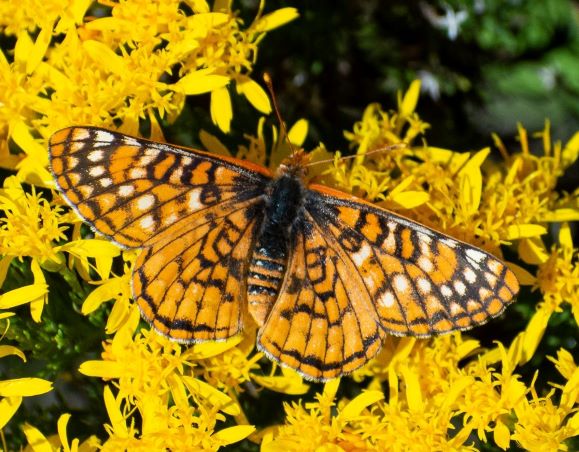
Subspecies Euphydryas anicia hermosa (W. G. Wright 1905) is large for this species, with a faded, translucent appearance that seems to result from graying of all the black marks. Caterpillars eat Woolly Paintbrush (Castilleja lanata). Adults fly in spring from the Mogollon Rim foothills of Arizona and New Mexico south into Mexico (counties: Ca,Gr,Hi), 4800 to 7000′ elevation, March 5 to May 10. This butterfly flies at lower elevations and earlier dates than any other race of Variable Checkerspot in New Mexico. Males establish hilltop territories. Specimens from Gr and Ca seen in the spring (March – May) would be this ssp. as opposed to E. a. magdalena.
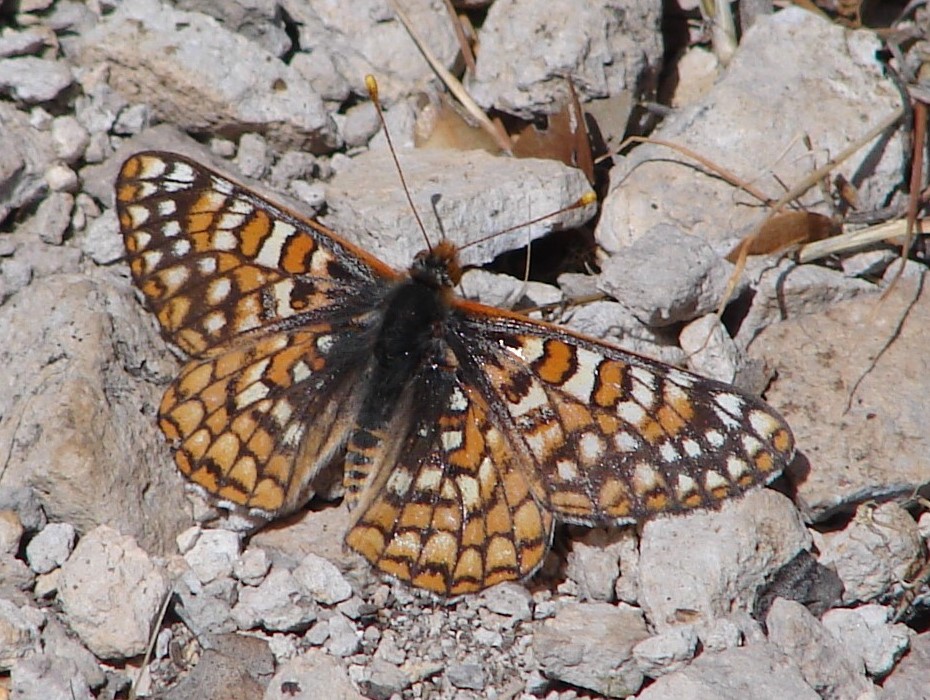
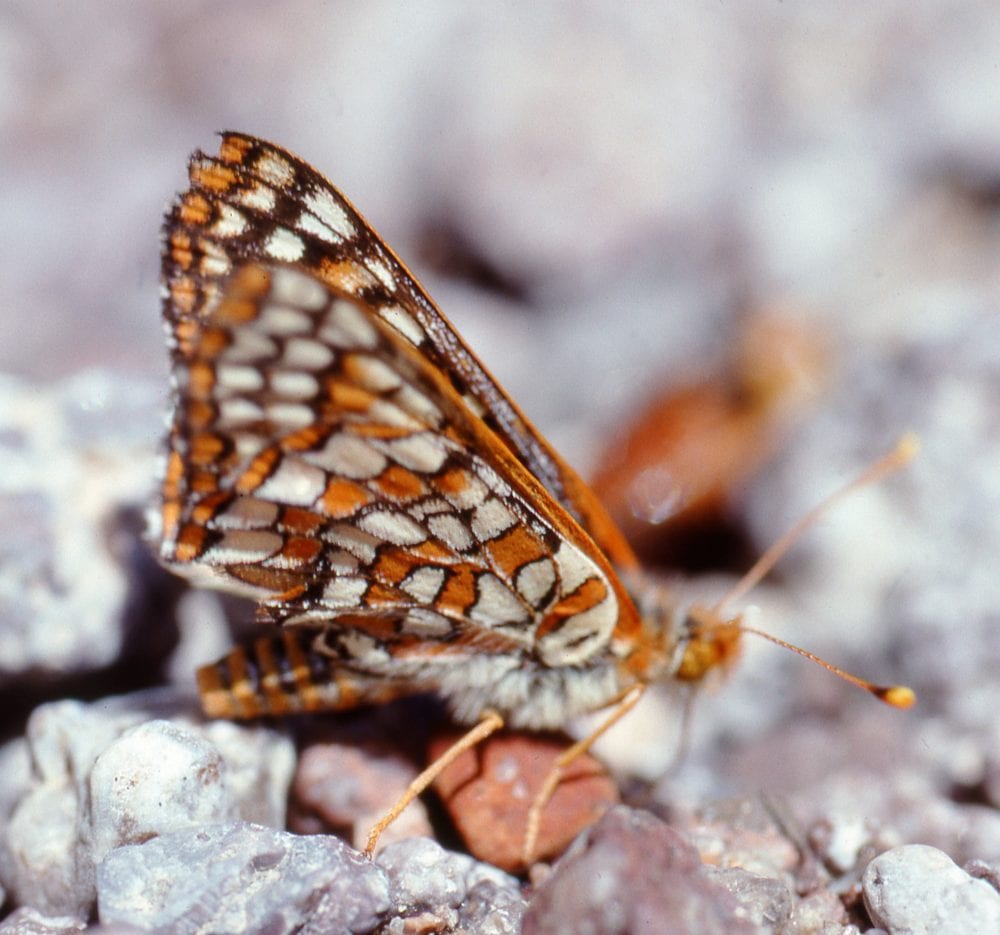
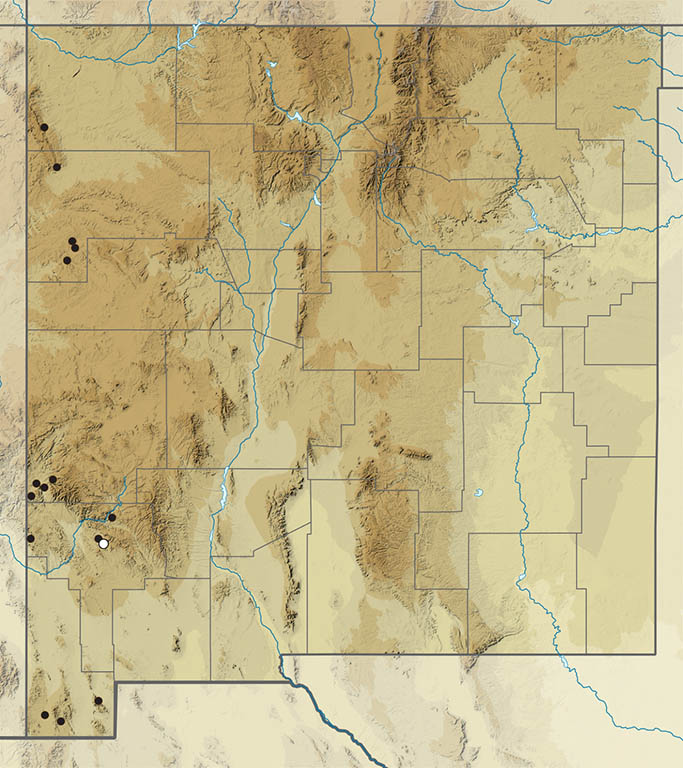
Subspecies Euphydryas anicia chuskae (Ferris and R. Holland 1980) has a yellowish cast underneath and flies in the Chuska Mountains (counties: SJ,MK) from June 22 to August 15. It flies at higher sites than Euphydryas anicia hermosa, with which it is generally sympatric in the Chuska Mountains. This doesn’t make sense. How these two taxa can remain separate in such close geographic and temporal proximity is a mystery that begs for a solution. We need a photo or two!
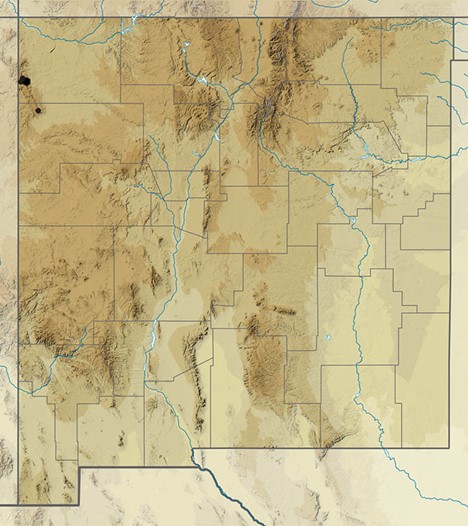
Reddish Euphydryas anicia cloudcrofti (Ferris and R. Holland 1980) flies in open meadows in the Sacramento Mountains (counties: Ot), usually June 1 to July 21 at 8000 to 9000′ altitude. Sacramento Mountains Checkerspot larvae eat primarily Penstemon neomexicanus, but also Valeriana edulis (Valerianaceae).
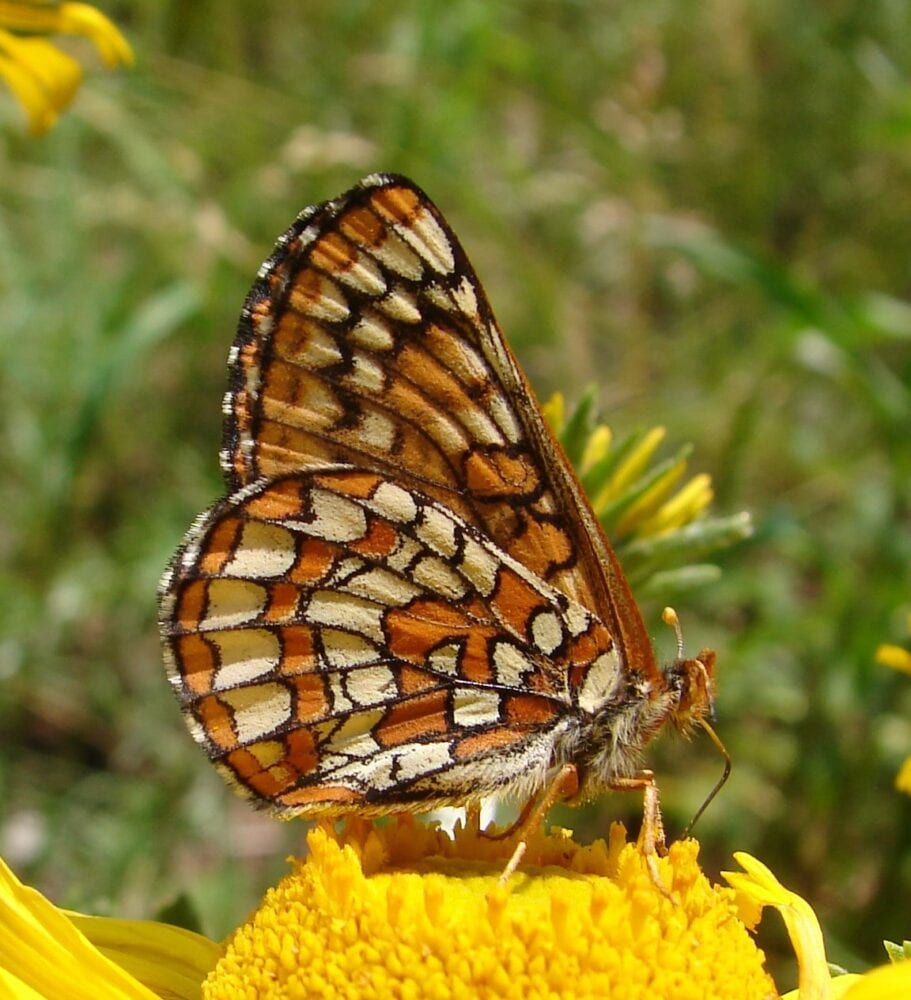
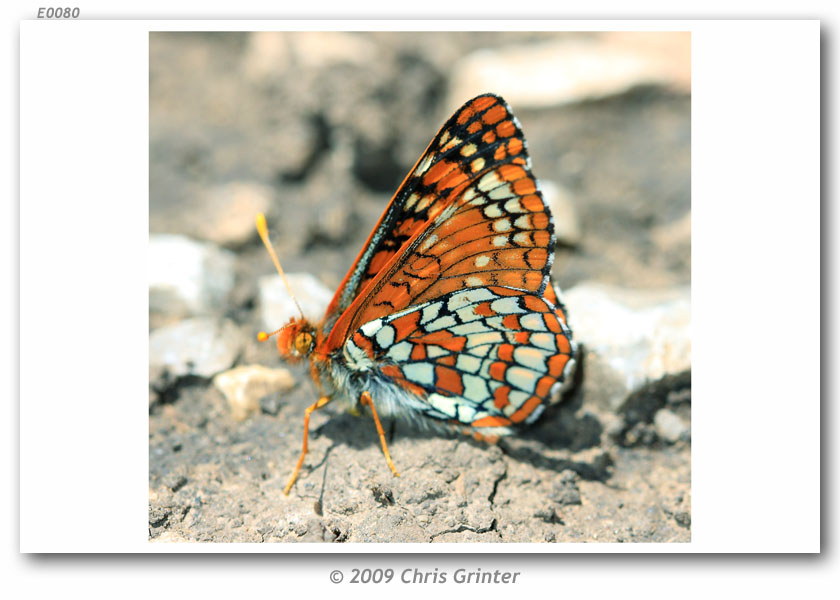
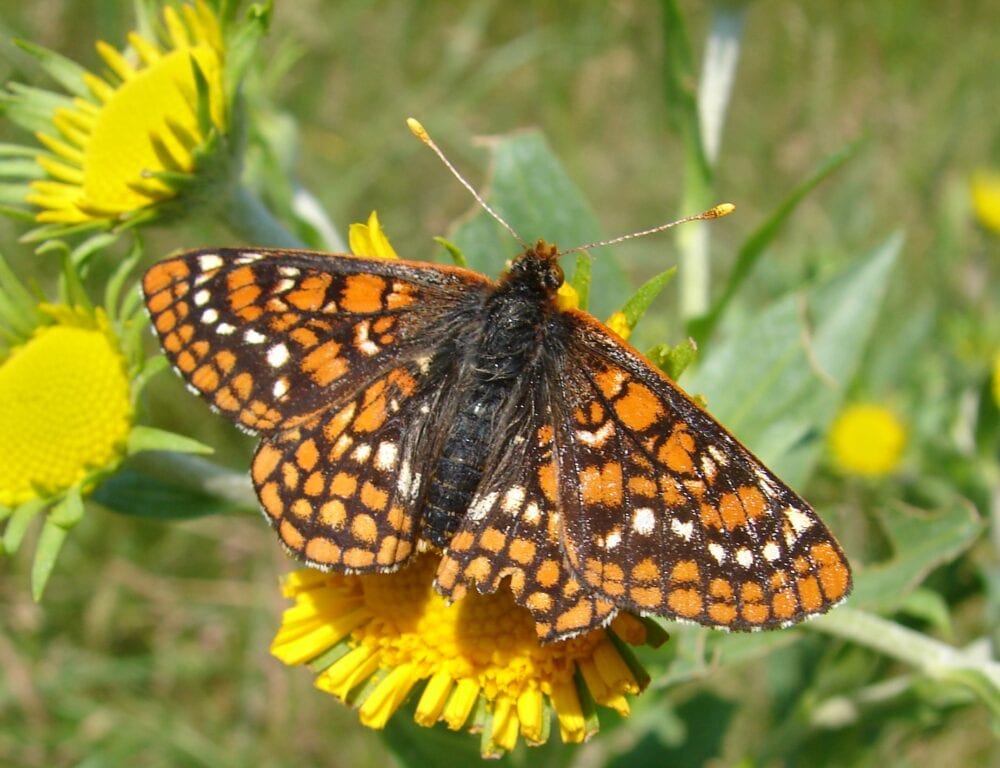
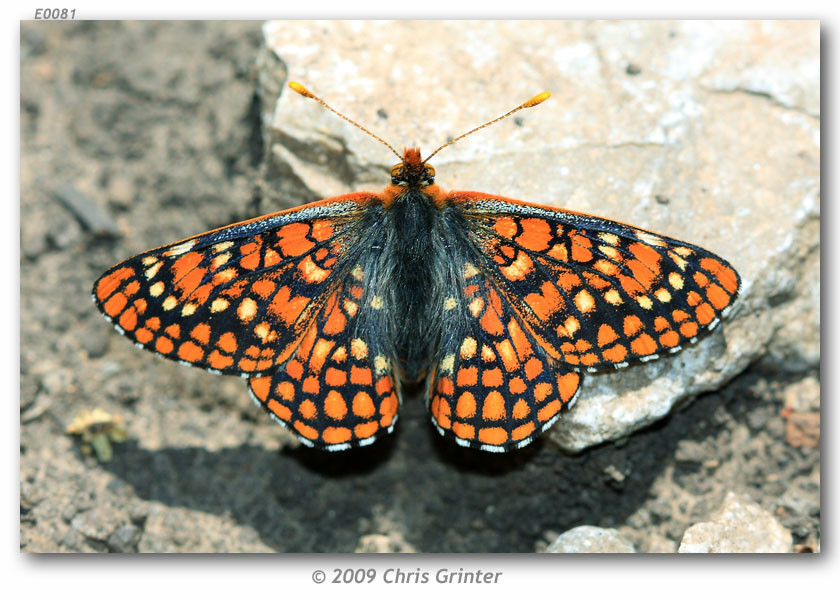
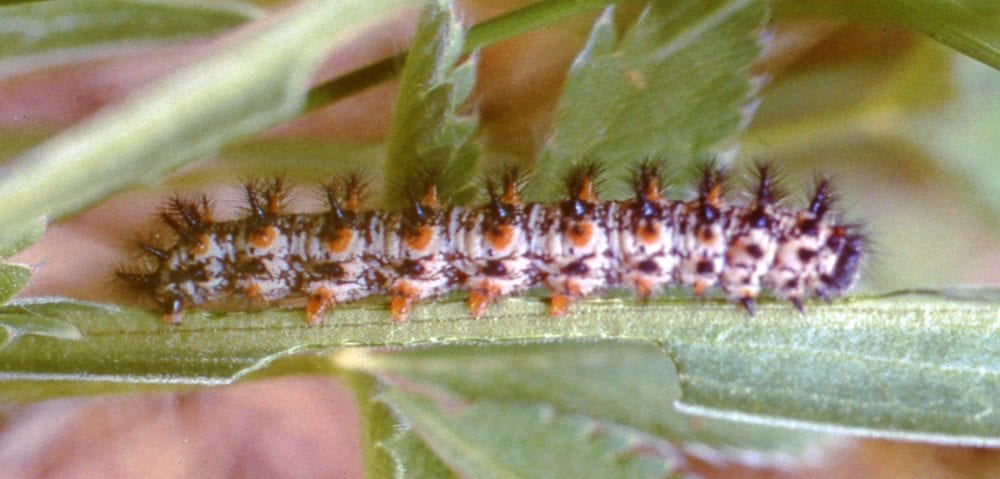

Southern Rocky Mountain subspecies Euphydryas anicia carmentis W. Barnes & Benjamin 1926 is bright red above. Middle elevation populations in the northern Sangre de Cristo Mountains (counties: Co,Mo,RA,SM,Ta) are tentatively assigned to this race. Members of those populations patrol meadows and fly rather late in summer (June 27 to August 26).
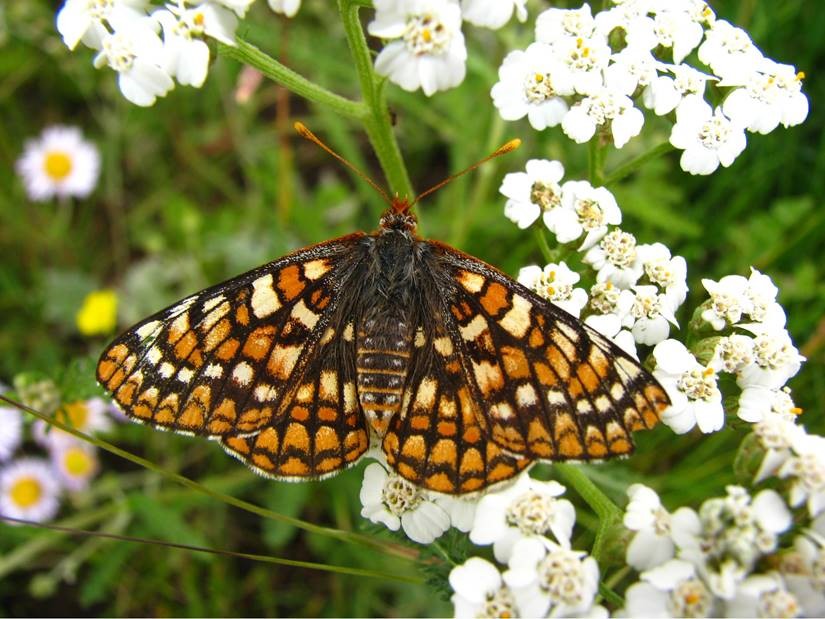
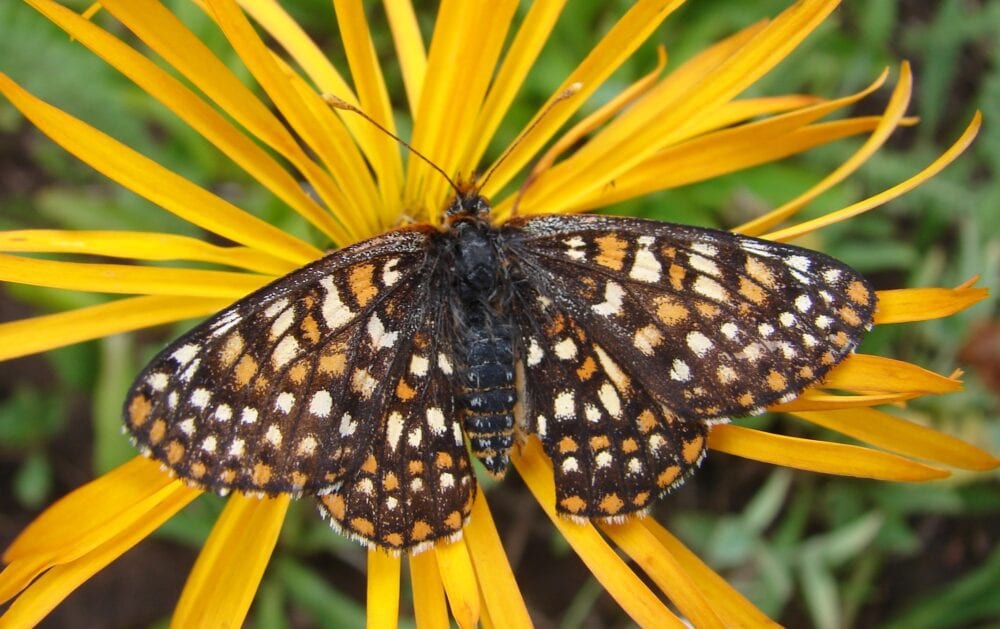
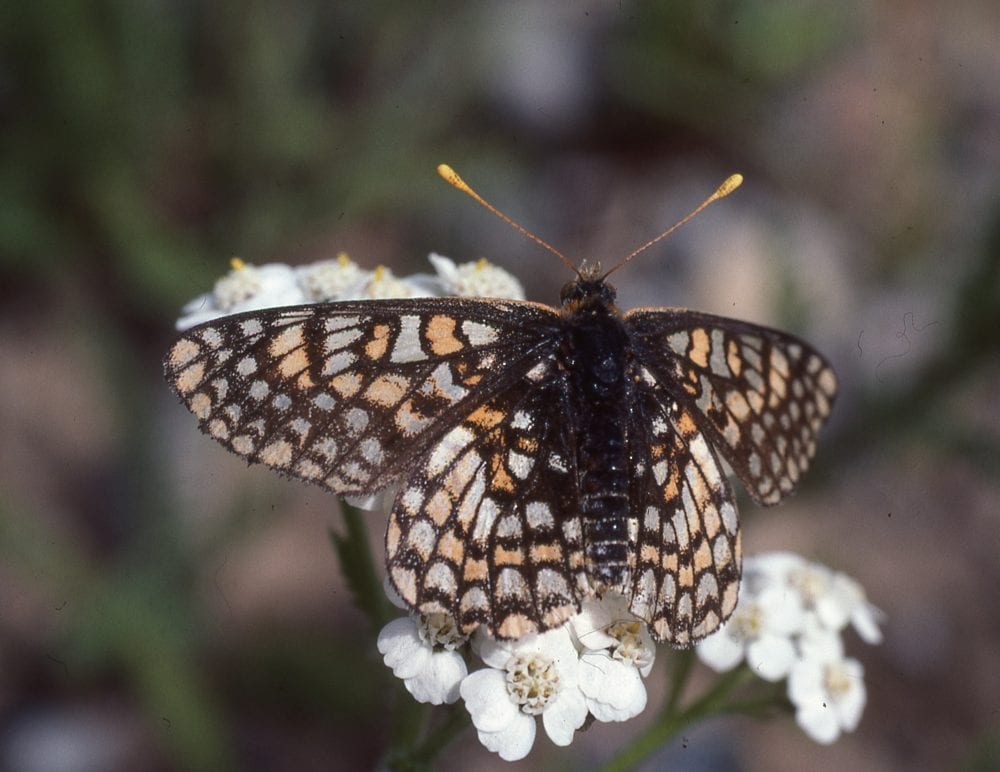
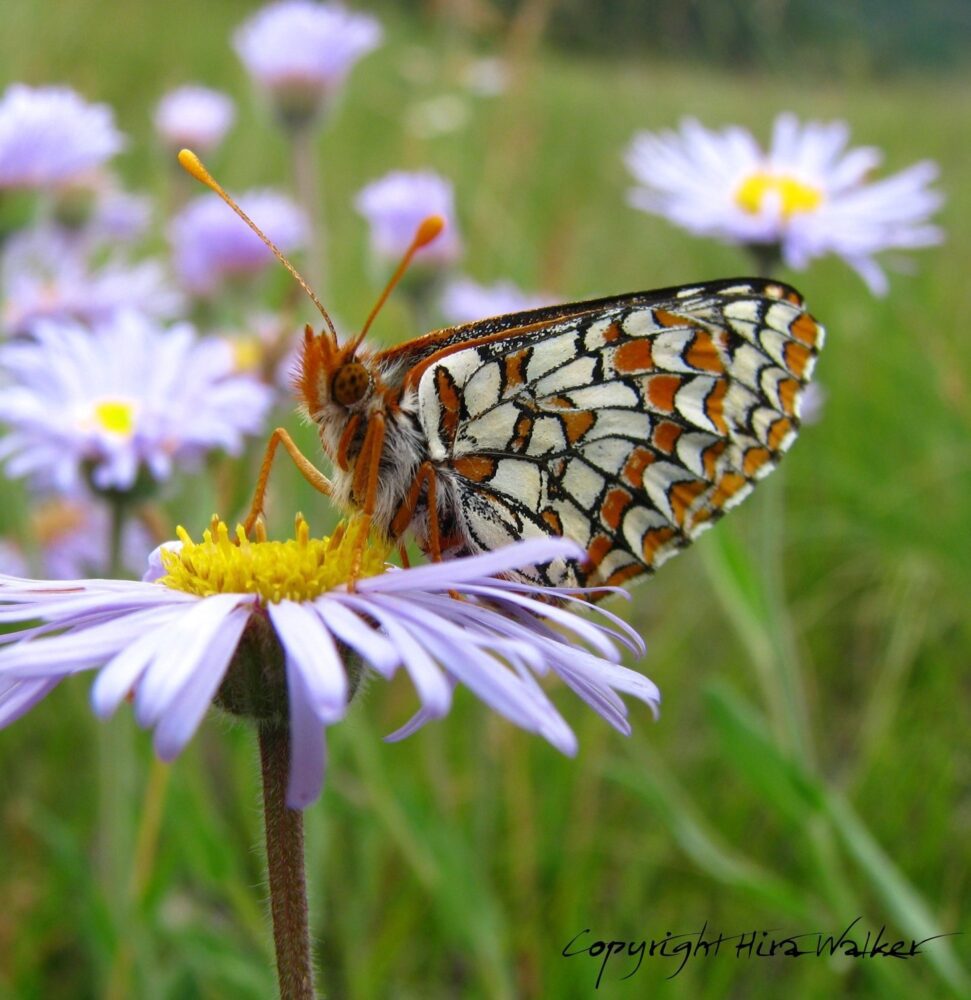
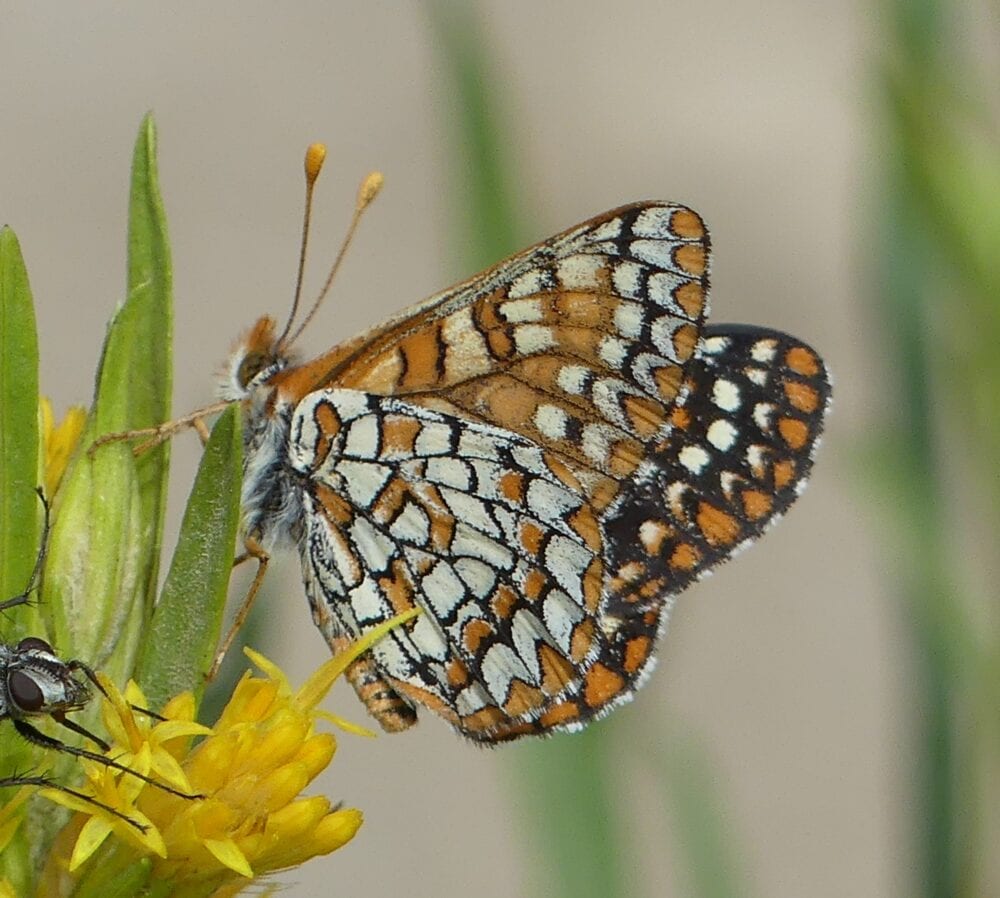
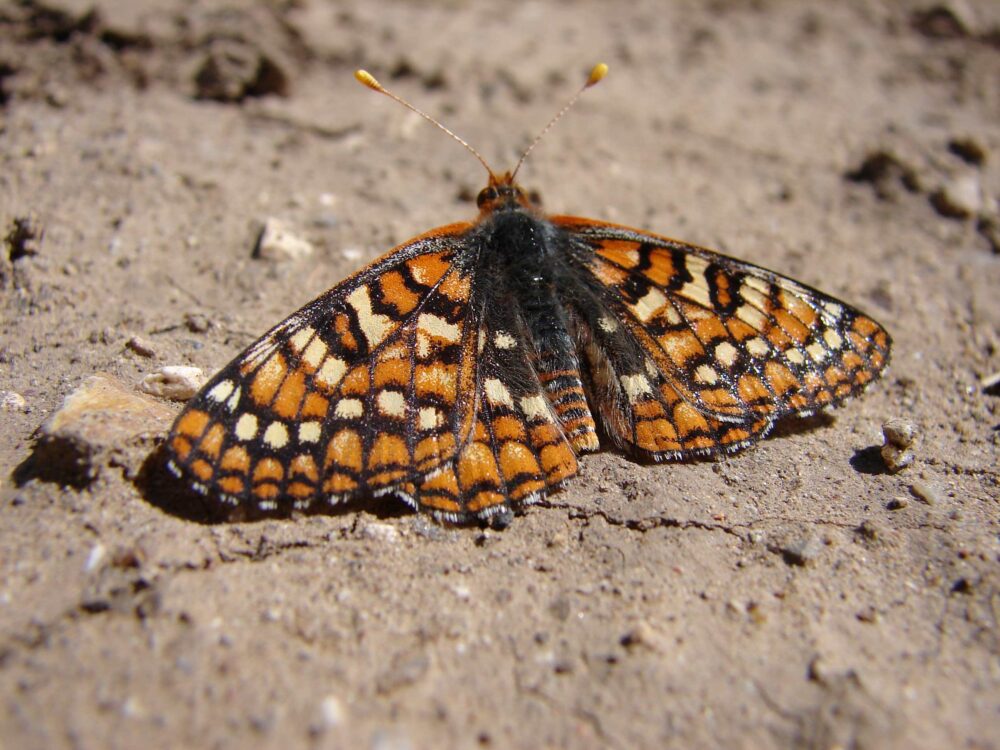

Colorado’s Front Range foothills host the reddish Euphydryas anicia capella (W. Barnes, 1897) whose range continues south into New Mexico on the east slope of the Sangre de Cristo Mountains (Co,Mo,SM). Larval hosts are uncertain but may include Penstemon secundiflorus. Flight period seems to be centered in July. We have very few records to document this taxon Intensive efforts in summer 2024 came up empty.
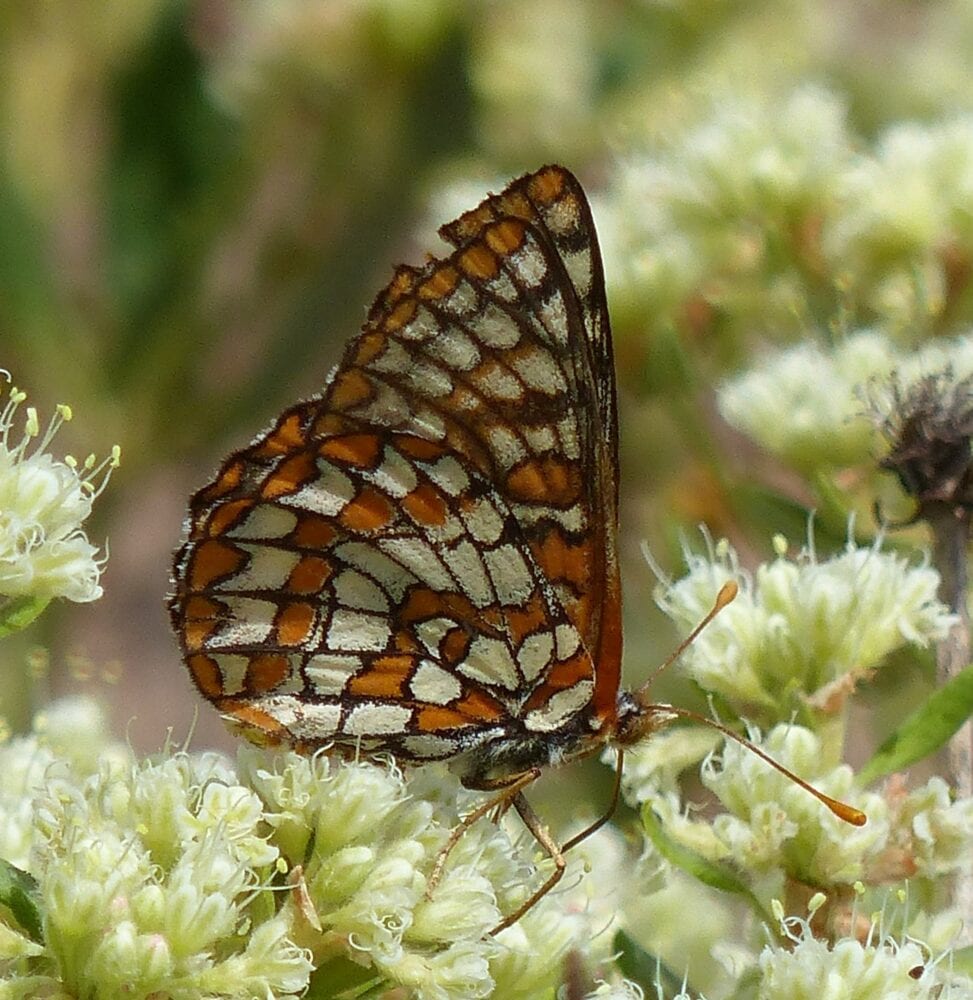
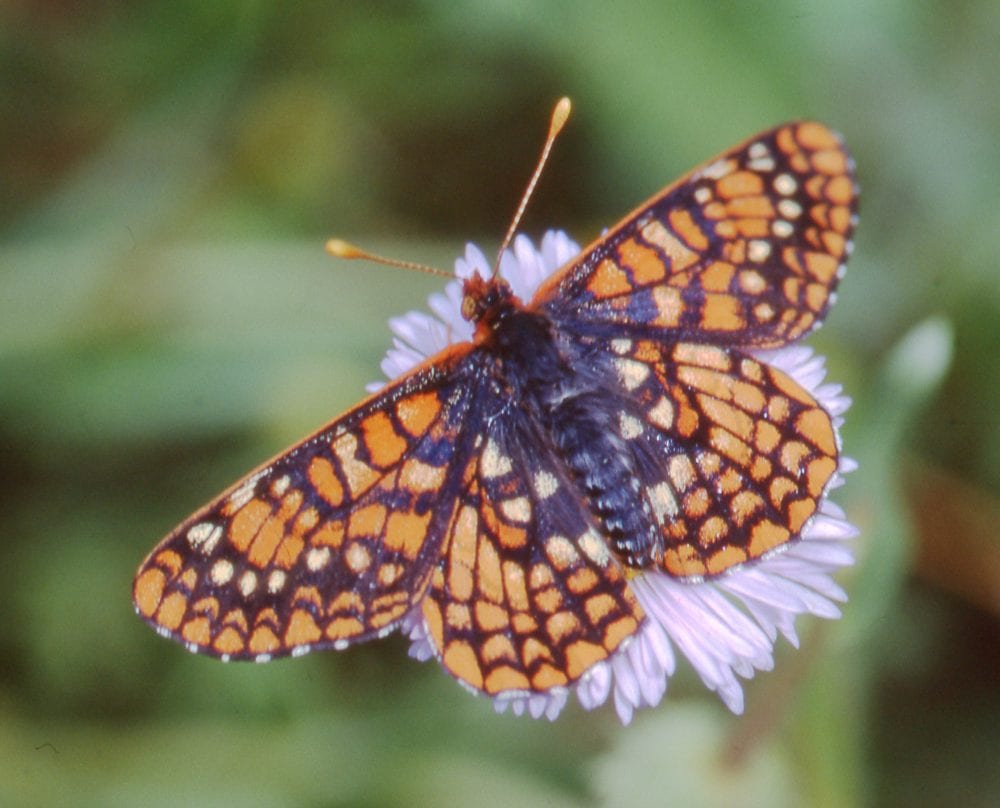
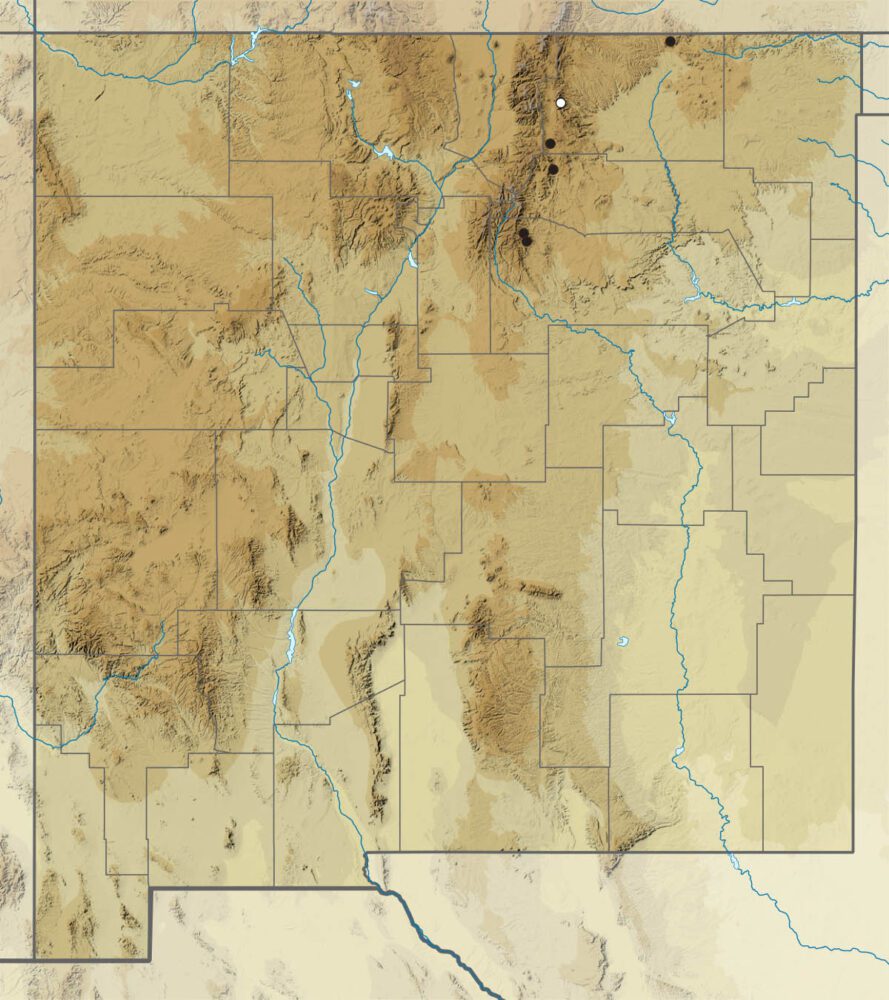
The northwest corner of NM may harbor either Euphydryas anicia alena W. Barnes & Benjamin 1926 or Euphydryas anicia wecoeut M. Fisher, Spomer & J. Scott, 2006 – both of which have been recorded from Utah (in the same mountain range!) about 130 mi. NW of the NM border. We tentatively place SJ records here, pending further investigation.
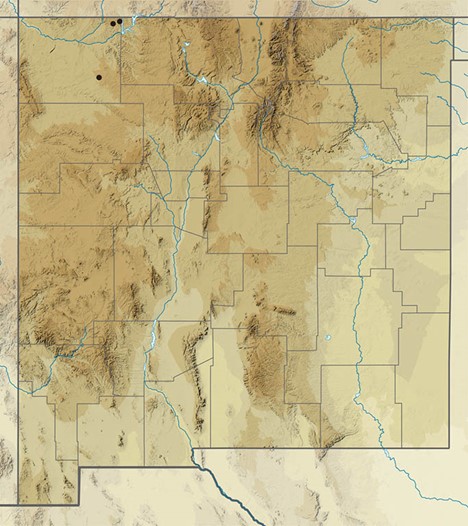

Poladryas minuta (W. H. Edwards 1861) Dotted Checkerspot (updated October 28, 2023)
Description. Of medium-size, Dotted Checkerspot is unicolorous orange above with a black web of veins and transverse marks. Underneath, the hindwing has alternating bands of orange and white, accented with bold black marks. The orange band is wider than that seen on arachne. Range and Habitat. Poladryas minuta inhabits grasslands and shortgrass prairies east of the southern Rockies south to Mexico. It is regular on our northeastern and east-central Plains (counties: Co,Cu,DB,Gu,Ha,Mo,Qu,Ro,SM,Un), 5000 to 6500′ elevation. Life History. Larvae eat Penstemon species (Plantaginaceae), including Penstemon jamesii and Penstemon albidus in northeast New Mexico. Orange larvae overwinter. Flight. Dotted Checkerspots complete two generations per year, flying May 10 to October 2, but with peak numbers in May and then again in August to September. Adults fly to nectar; males hilltop, and it does not have to be a prominent hill. That hilltopping behavior is key to finding this bug in the vastness of the Plains. Comments. Poladryas arachne and Poladryas minuta may appear to blend in the eastern foothills of Sangre de Cristo Mountains, fueling debate over whether they represent one or two species.
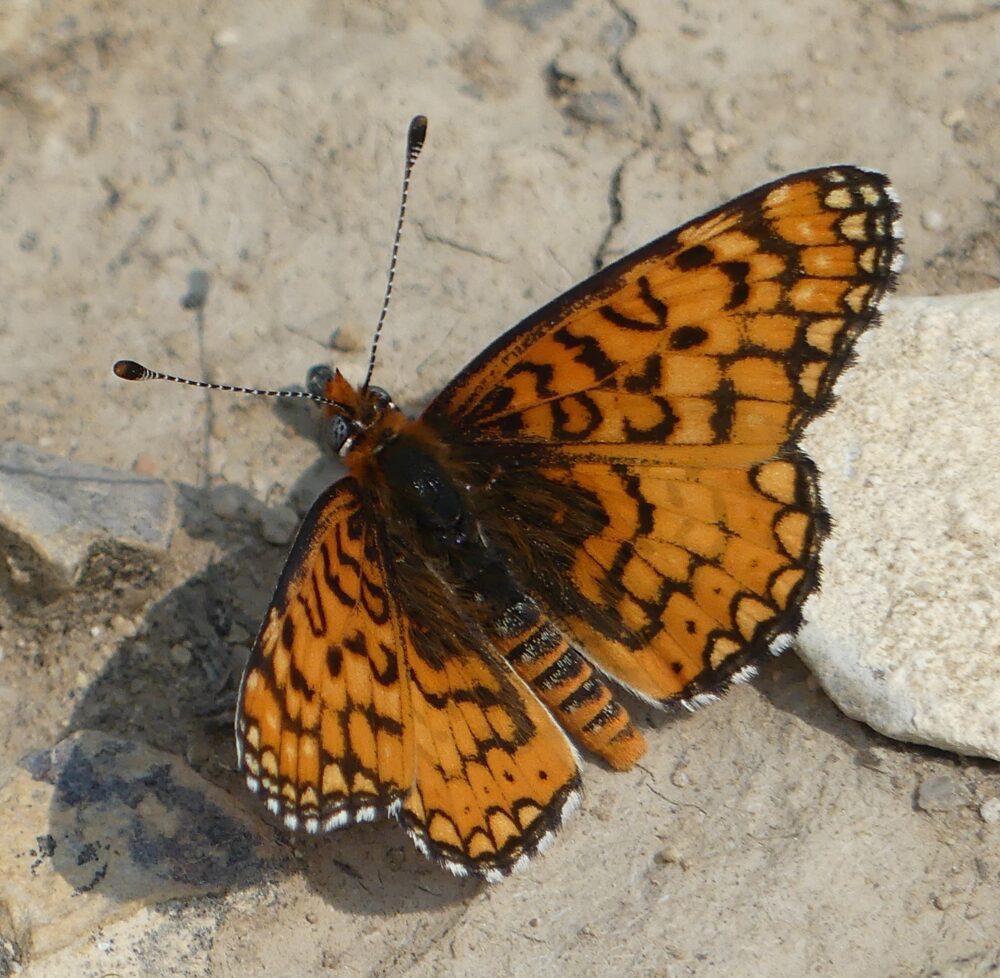


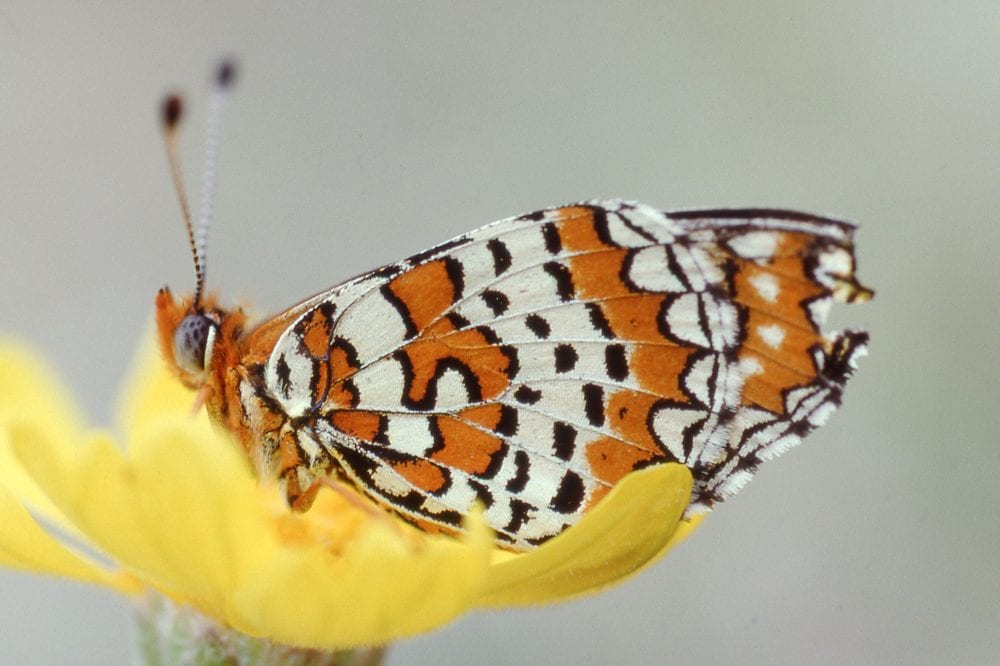

Poladryas arachne (W. H. Edwards 1869) Arachne Checkerspot (updated October 28, 2023)
Description. Arachne Checkerspot resembles Dotted Checkerspot, as you might expect, but the dorsal orange ground color is two-toned. Underneath, its orange and white bands are framed in black spider webbing and the orange band tends to be narrower. Range and Habitat. Poladryas arachne inhabits montane savannas from the central Rockies south to the Mexican Sierra Madre. It is regular here in New Mexico (counties: Ca,Ci,Co,Gr,Li,MK,Mo,RA,Sv,SJ,SM,SF,Si,So,Ta,Un), usually 6500 to 9200′ elevation, though it has been hilltopping higher in recent years. Life History. Larvae are white, eat Penstemon species (Plantaginaceae), and overwinter. Flight. Arachne has one extended main brood. Records span May 14 to October 2, peaking in June to July. Fresh September adults suggest a partial second brood. Adults go to nectar; males go to hilltops to seek out females. Comments. North-central New Mexico populations are the nominate variety. There is only one record from the Sacramento/Capitan/Sierra Blanca complex (Li). Mogollon Rim colonies (Ca,Gr,Si,So) are subspecies Poladryas arachne nympha (W. H. Edwards 1884). Pelham (2023) lists Poladryas arachne gilensis (W. Holland 1930) as a legitimate subspecies described from a type locality (“Fort Gila”) later designated by Ferris (1989) as “Along the west fork of the Gila River in Catron Co., New Mexico.” Pelham illustrates specimens from Mt. Graham, Graham Co., AZ. We were unable to find a “Fort Gila,” but there is a “Fort Thomas” along the Gila in Graham Co. AZ not far from Mt. Graham. The status of gilensis in New Mexico is thus in doubt. If specimens of arachne are found in the “bootheel” region of NM, they could well be true gilensis, but currently we regard all NM arachne from Ca and Gr as nympha. Much work is still to be done with this lovely organism!
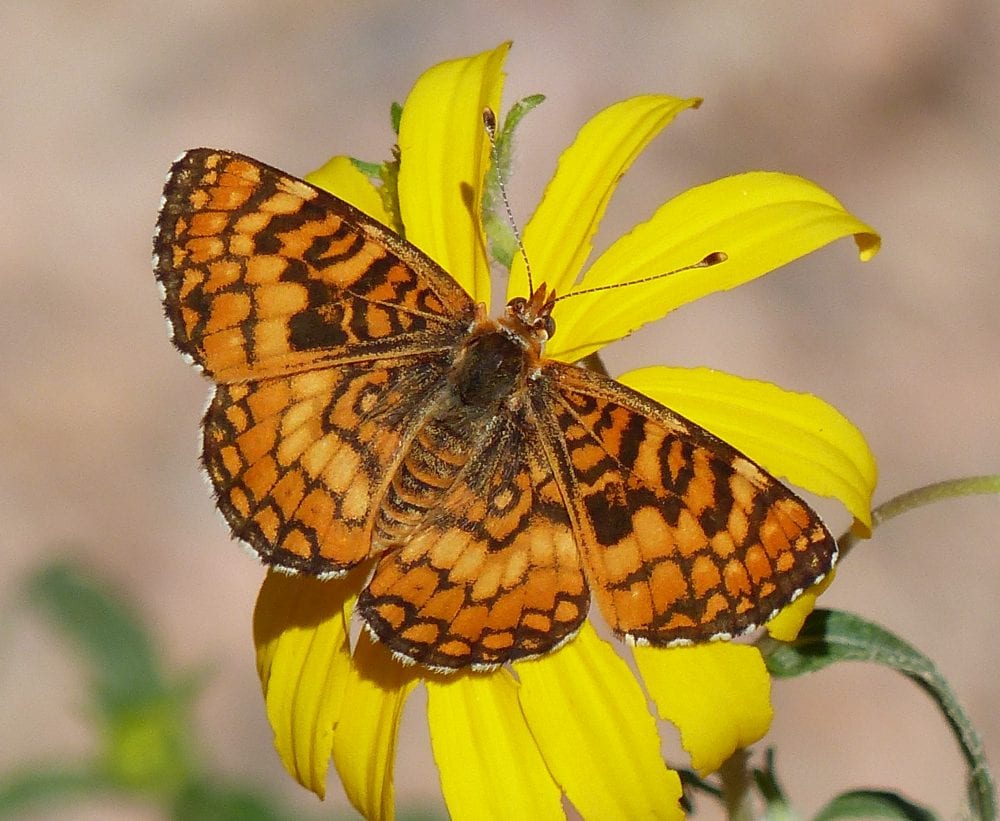
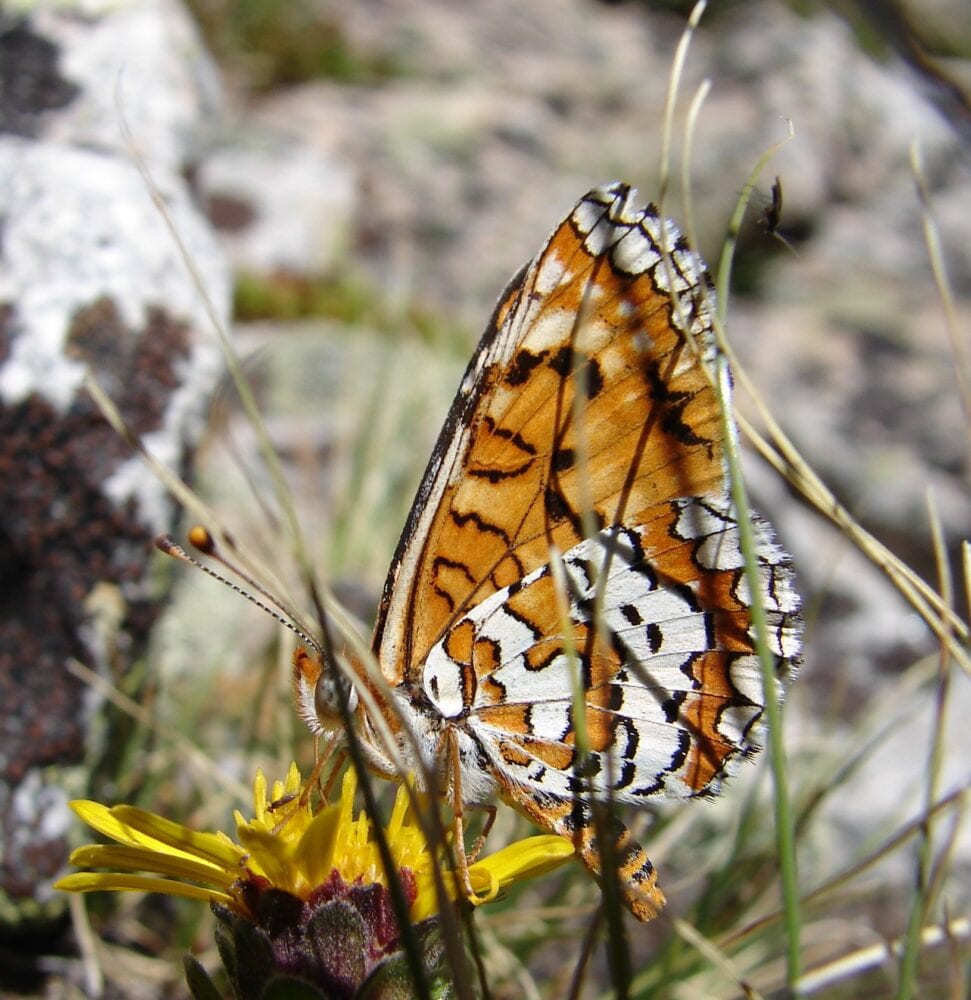
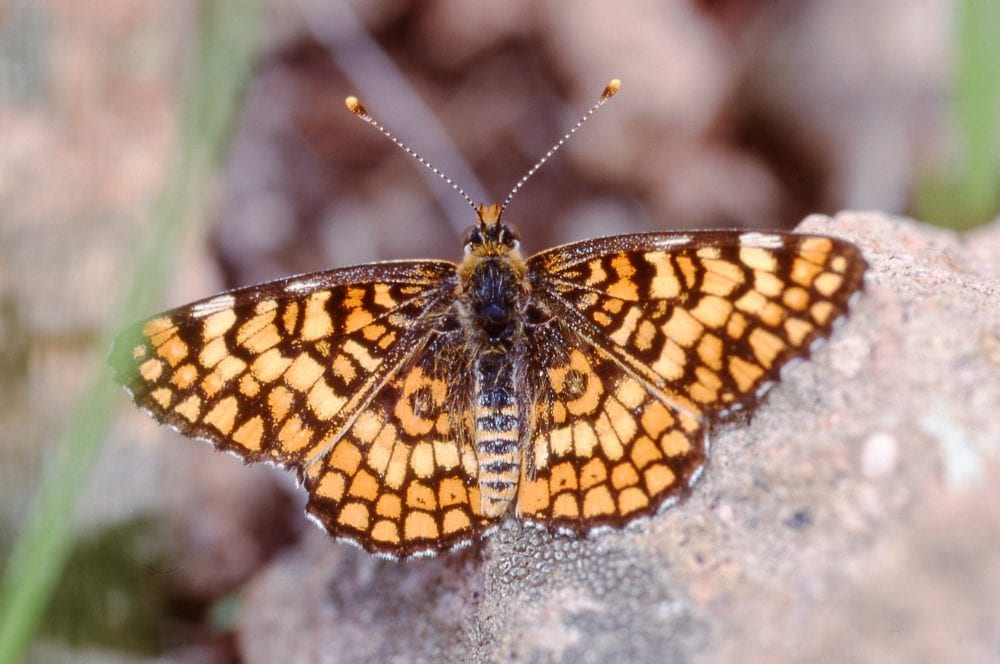
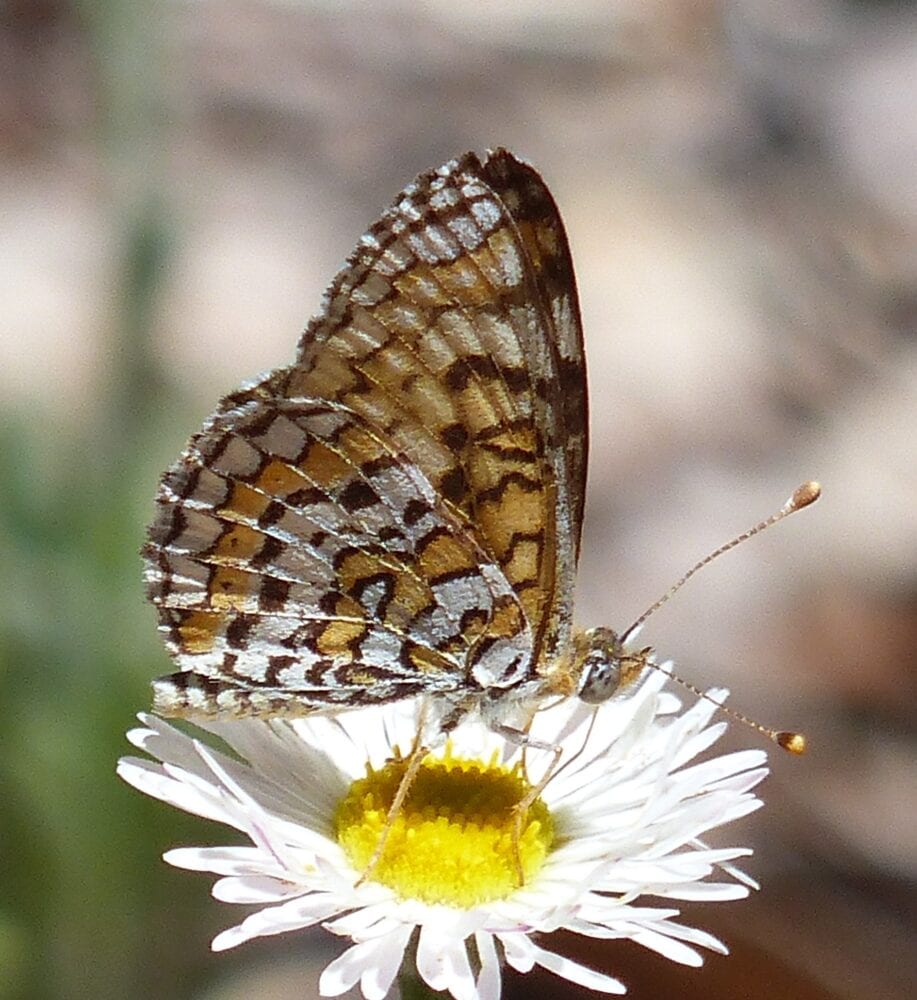

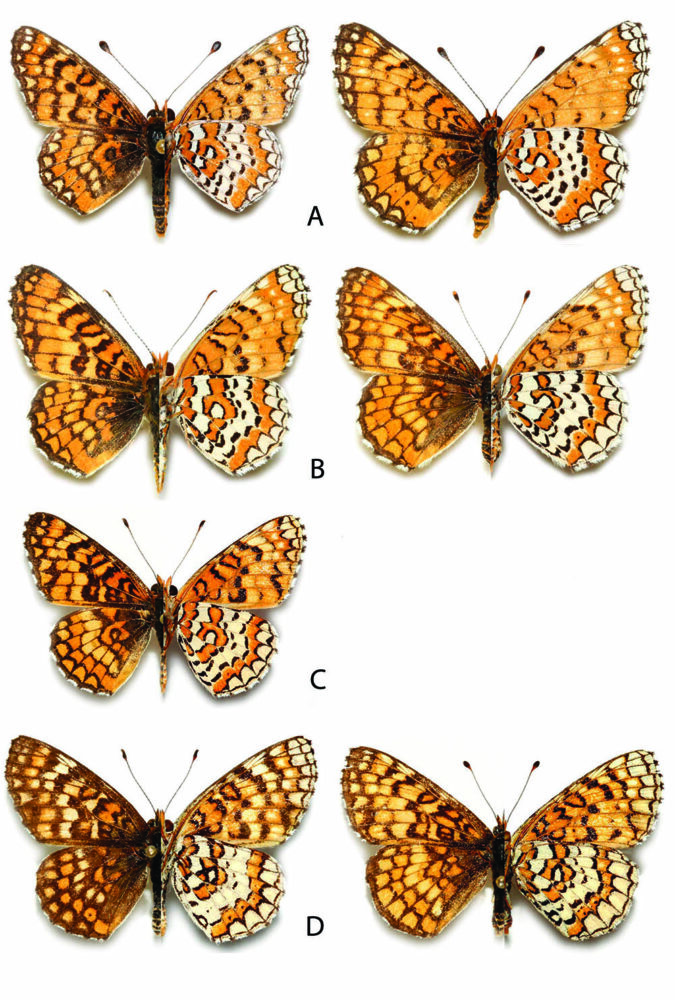
Chlosyne janais (Drury 1782) Crimson Patch (updated October 30, 2023)
Description. Distinctive Crimson Patch has black forewing with many white dots and on the hindwing a large red patch. Below, the hindwing has a creamy white basal area with black dots and a red postmedian band. Range and habitat. This subtropical butterfly is a breeding resident of Central America and Mexico that strays occasionally to the southern US. Life history. Larvae eat plants in the Acanthaceae family. Flight. Crimson Patch is multivoltine in its breeding range. Adults seek nectar and moist earth. Comments. Our single report is from Richard Holland, who caught it on 19 July 1986 at Rattlesnake Springs, part of Carlsbad Caverns National Park (Eddy County). Most members of the genus Chlosyne, including Chlosyne janais, are variable in phenotype.
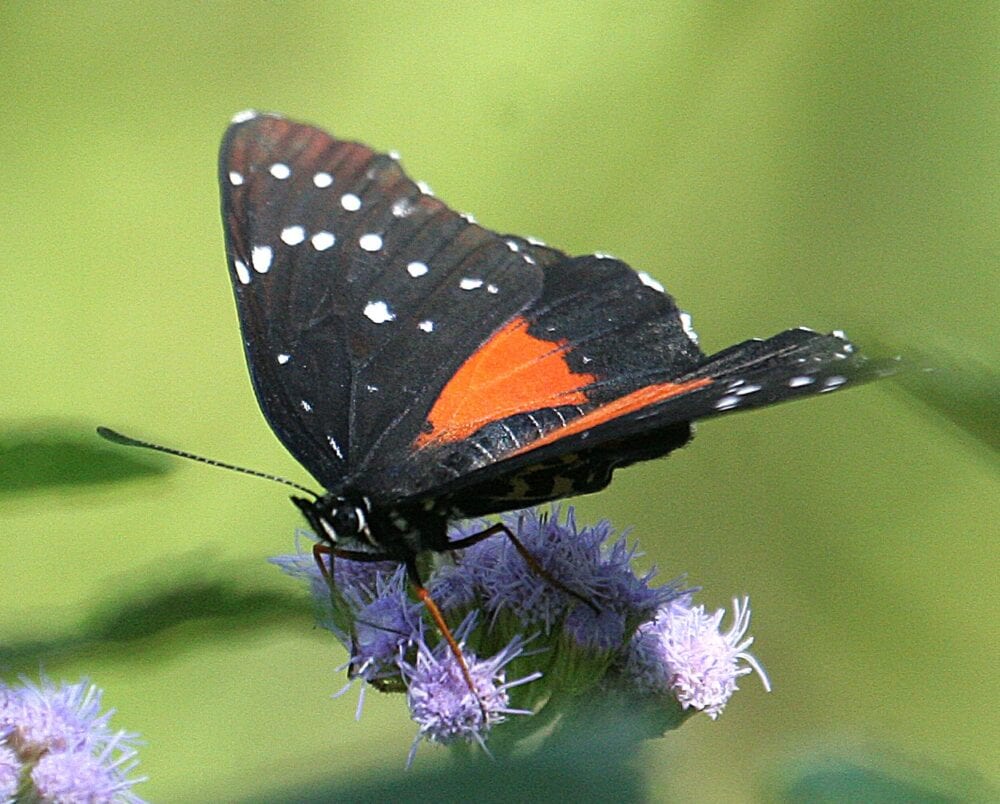
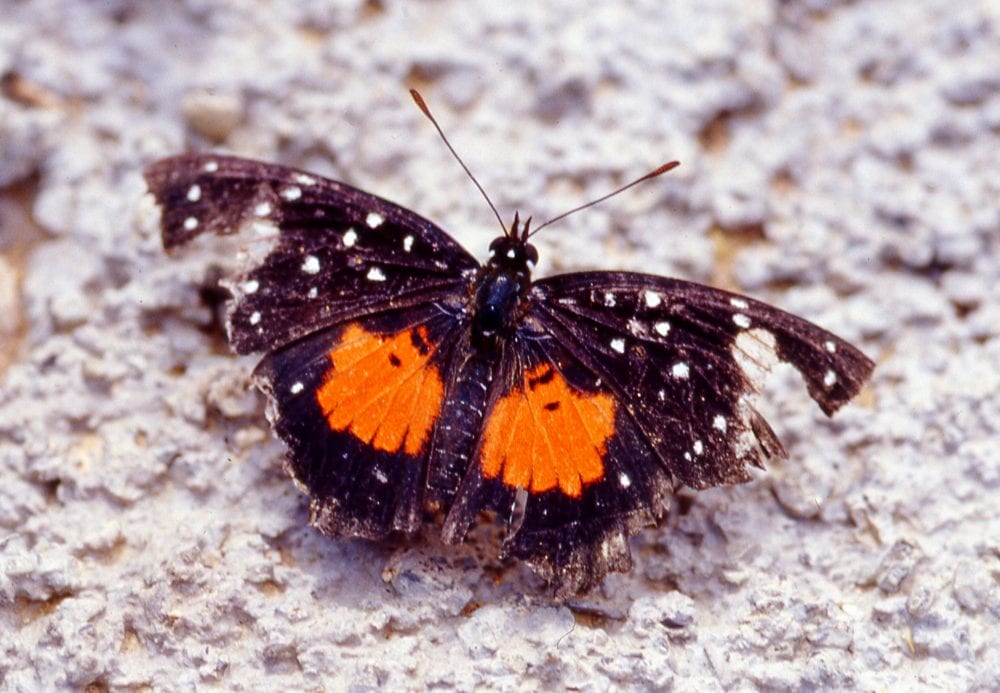

Chlosyne definita (E. Aaron 1885) Definite Patch (updated July 23, 2024)
Description. Definite Patch has typical checkerspot size and features, but most diagnostic marks can be found on the underside. The ventral hindwing orange submarginal band has one white cell and the postmedian white band has bold black borders. Range and Habitat. Chlosyne definita inhabits open scrubland and grassland in southeast New Mexico and adjacent Texas south into Mexico. Here it is a Lower and Upper Sonoran Zone insect (counties: Be,Ch,DA,Ed,Li,Lu,Ot,Si), usually below 5500′ elevation, but wandering to 8000’ in the Sacramentos. Life History. Scott (1986) reported bearded stenandrium (= early shaggytuft = Stenandrium barbatum; Acanthaceae) as a larval host. Marta Reece documented oviposition on that plant in New Mexico (see photo below). There may be other hosts, too. Flight. Definite Patch is bivoltine, flying in spring and late summer. Our records span March 23 to October 10. Adults usually fly in canyons, sometimes on hilltops, and nectar at yellow composites. Comments. The first New Mexico observation was by Stallings, Turner and Ehrlich, on 17 May 1959, at Carlsbad Caverns National Park (Ed). This butterfly is characteristic of the Chihuahuan Desert faunal influence in southeast New Mexico. We have the nominate subspecies, but if definita is ever found in the “Bootheel” (Hi) region of NM it might be subspecies Chlosyne definita anastasia (Hemming 1934). A 2024 find by Mike Shoop on the east slope of the Sandia Mountains (Be) suggests northward expansion of this species.
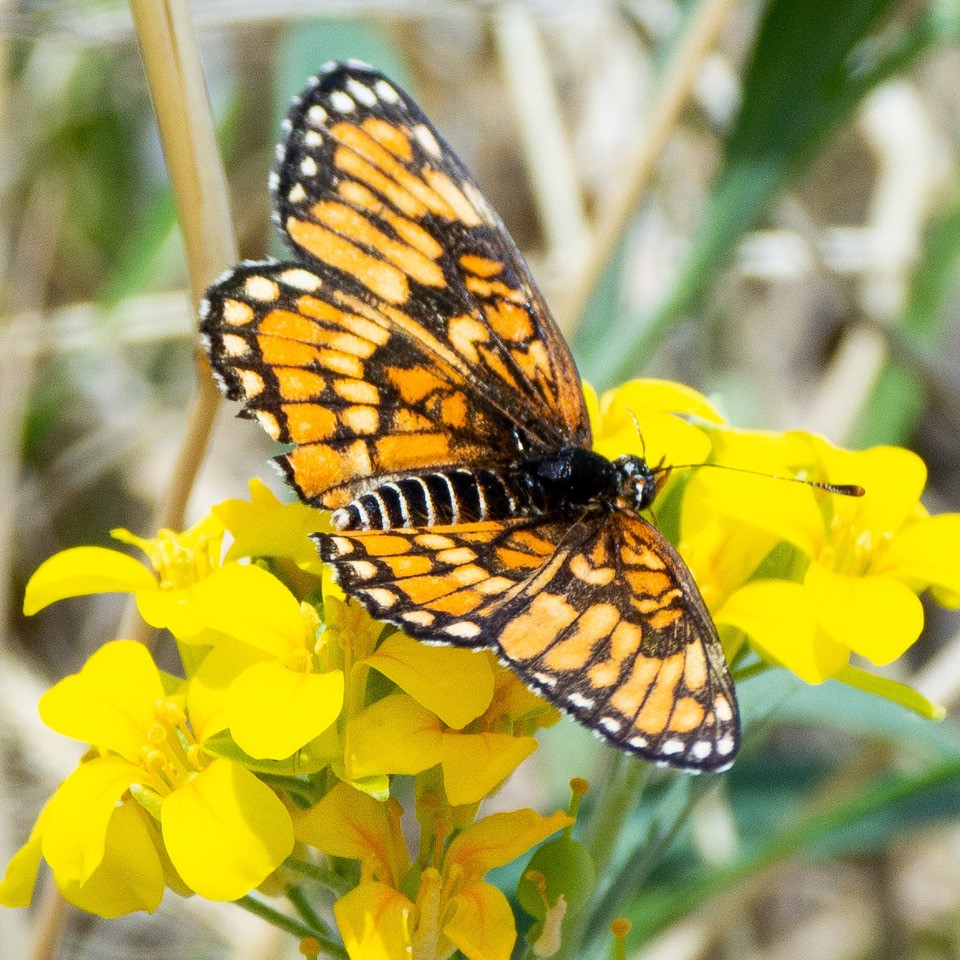

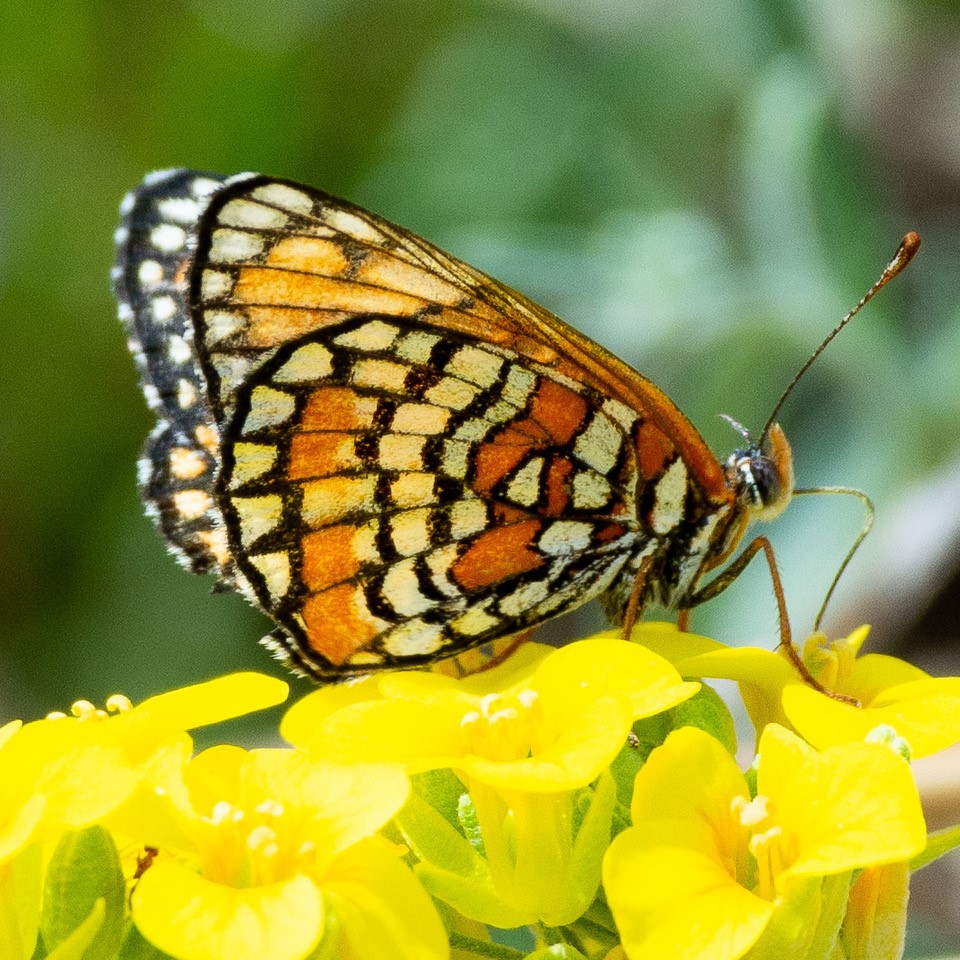
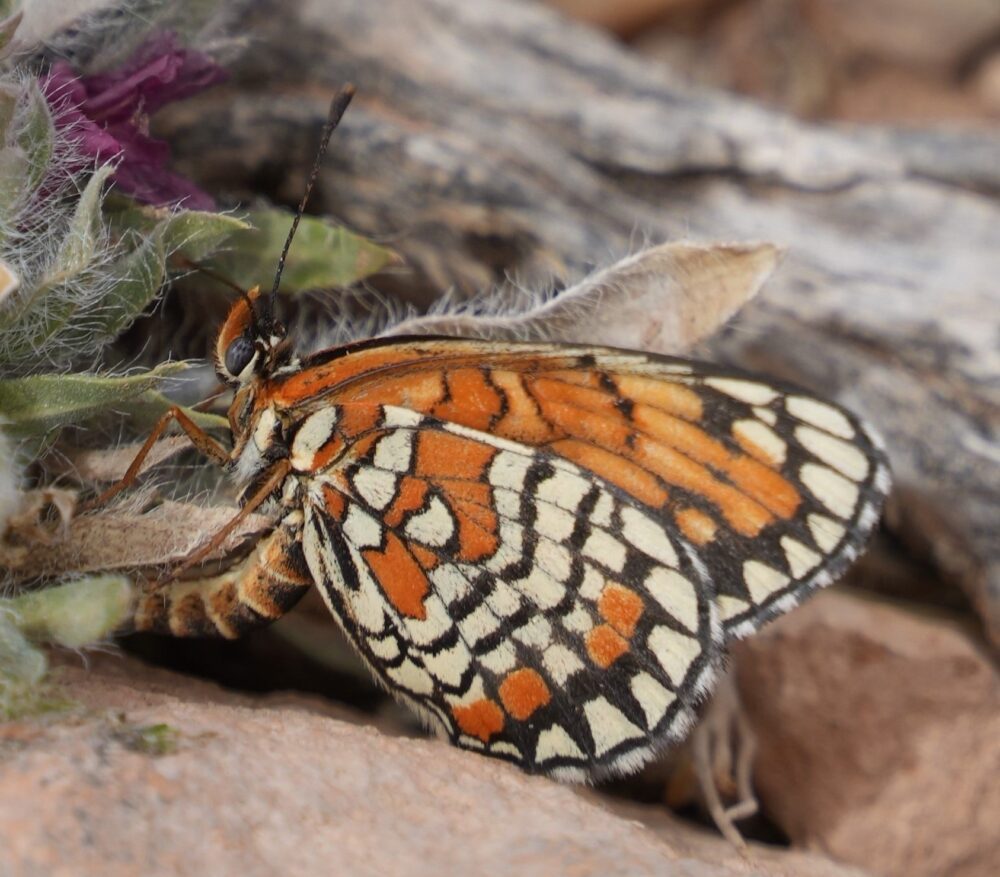

Chlosyne rosita A. Hall 1924 Rosita Patch (updated October 31, 2023)
Description. Rosita Patch looks very much like Crimson Patch, with white-spotted black forewings and a large orange patch on the hindwing above. However, Rosita’s orange patch is two-toned and the hindwing underside is much less decorated with black spots compared to Crimson Patch. Range and habitat. Like it’s similar relative, the Crimson Patch, Rosita is a neotropical insect with a typical range from Central America north to the US border in S. TX. It strays on occasion northward to SE AZ, S NM and central TX. Life history. Larvae feed on plants in the Acanthaceae family. Flight. Rosita flies year-around in its typical range. The most likely time to see it in NM would be during the fall monsoon: Aug. – Oct. Comments. Our only report of this rare stray to the US came from Noah Arthur, who spotted it in Las Cruces (Doña Ana County) on August 13, 2009, and wrote a nice note about it to the Lepidopterists Society News. See Arthur, N. 2009. Chlosyne rosita montana A. Hall, 1924 (Lepidoptera: Nymphalidae: Melitaeini): a new record for New Mexico. Lep. Soc. News 51(3): 93-94. As noted in his article, this individual was a representative of ssp. montana A. Hall 1924.
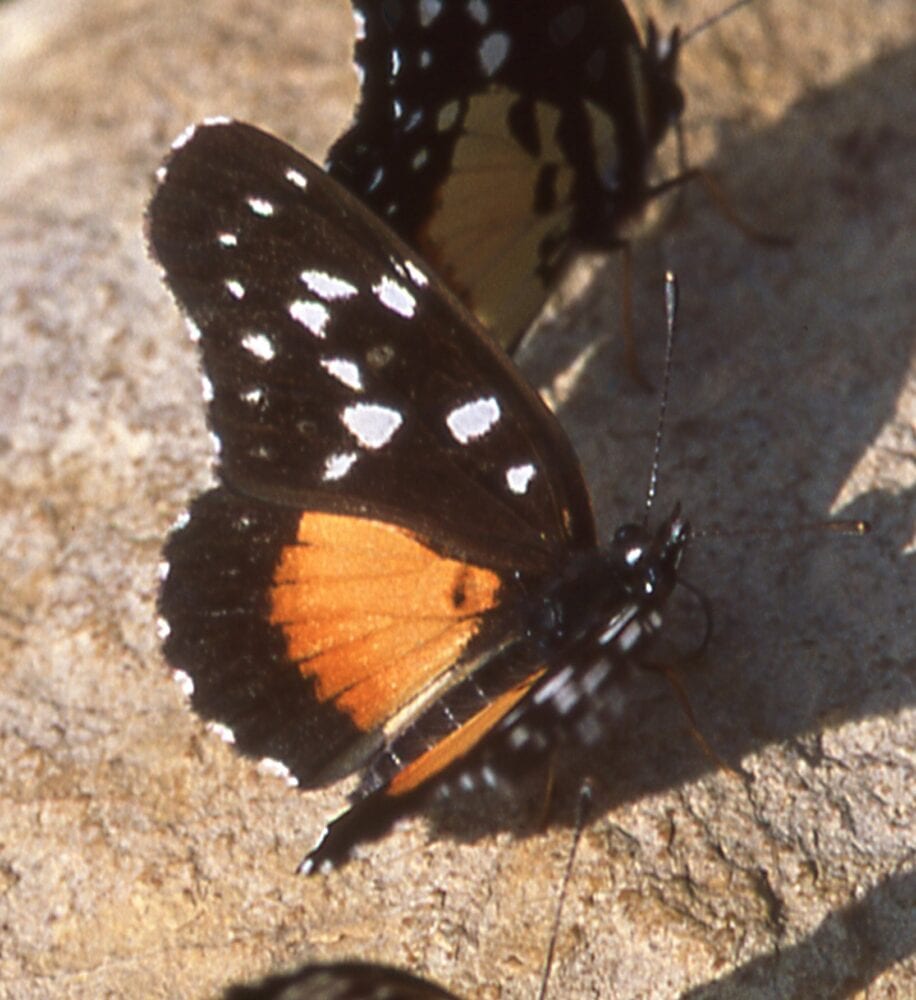
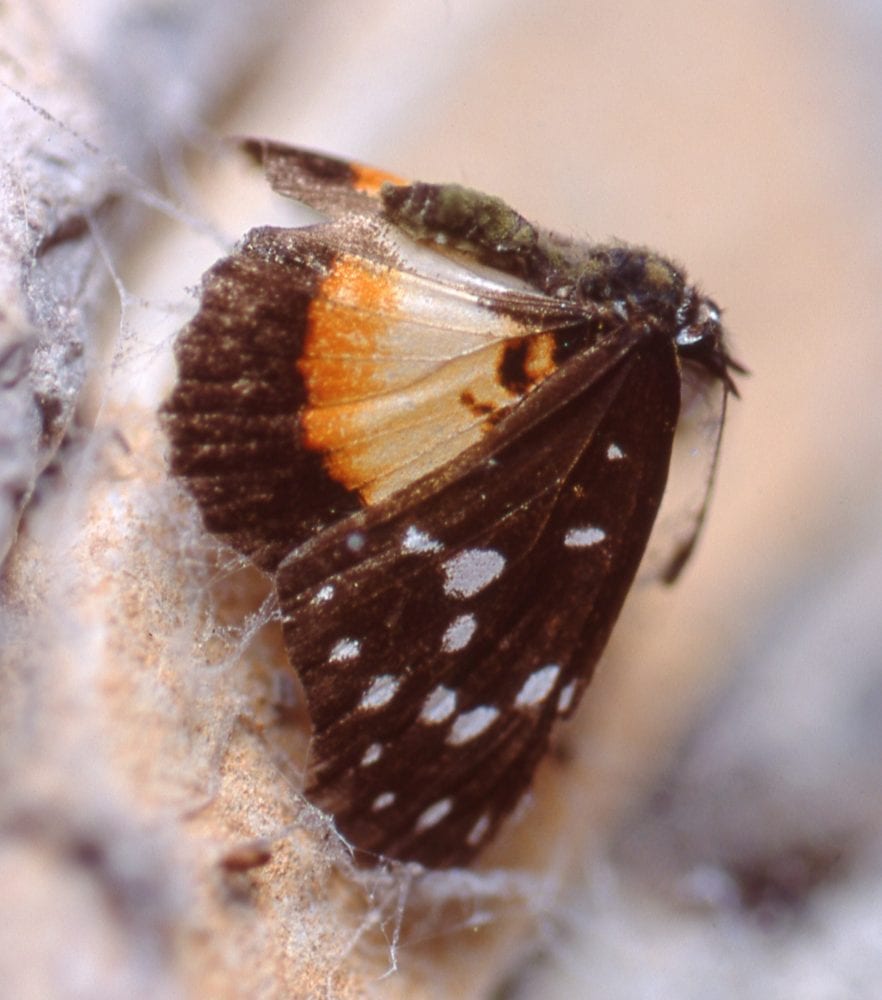

Chlosyne theona (Ménétriés 1855) Theona Checkerspot (updated November 1, 2023)
Description. Theona Checkerspot is quite variable across its wide range, including within New Mexico. Here it has bright, alternating bands on the hindwing underneath; from margin inward they are white, orange, white, orange and white; all are crossed by black veins. Upper sides are banded light and medium orange. Range and Habitat. Theona lives in Central America and Mexico, north into the southwestern US. It inhabits Upper Sonoran Zone grasslands in southern New Mexico (counties: Ca,Cu,DA,Ed,Gr,Hi,Li,Lu,Ot,Si,So,Un), usually 4000 to 6500′ elevation. Life History. Larvae eat Orobanchaceae, primarily paintbrushes like Castilleja integra, Castilleja lanata, Castilleja elata and Castilleja laxa (Austin and Smith 1998); Brachystigma wrightii is a host in southeast Arizona (Bailowitz and Brock 2022). Black larvae, sometimes in groups, can be conspicuous on red bracts of the host. Flight. Theona is at least bivoltine in New Mexico. A spring brood flies in April and May. A rainy season flight, which may be two overlapping broods, occurs June 21 to October 9, peaking in August. Males hilltop; both sexes seek nectar and moist earth. Comments. Which subspecies occupies NM is an open question because named subspecies seem poorly differentiated. It seems likely that southwestern subspecies Chosyne theona thekla (W. H. Edwards 1870) occurs west of the Pecos River. From there eastward, all we see are few probable strays which could be ssp. thekla or perhaps Texas/Mexico species Chlosyne bollii (W. H. Edwards 1878) (see next species below). The similar Chinati Checkerspot occurs in SE NM; it is distinguished from theona by the brighter dorsal surface (lacking the distinct median band) and having somewhat darker marginal markings on the hindwing. Per Zhang et al. Dec. 2023, Chlosyne bollii (W. H. Edwards 1878) is a species distinct from Chlosyne theona (Ménétriés 1855).
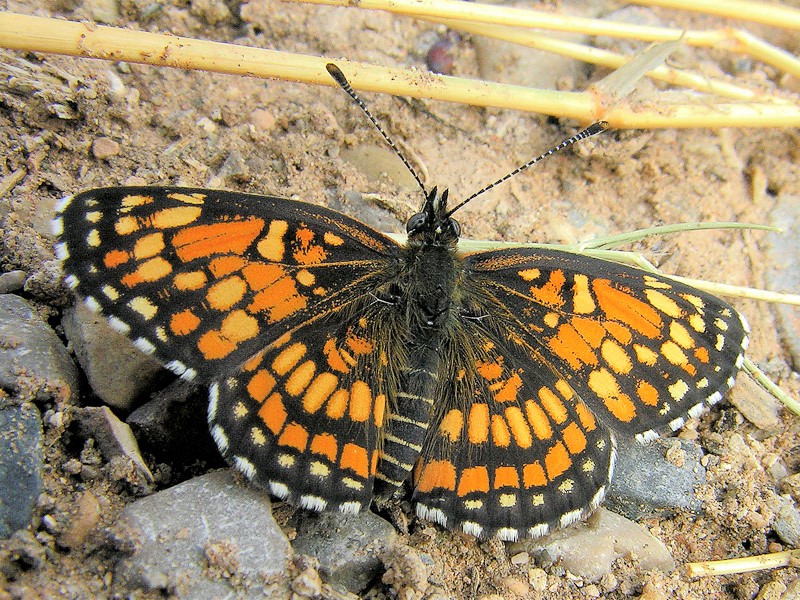
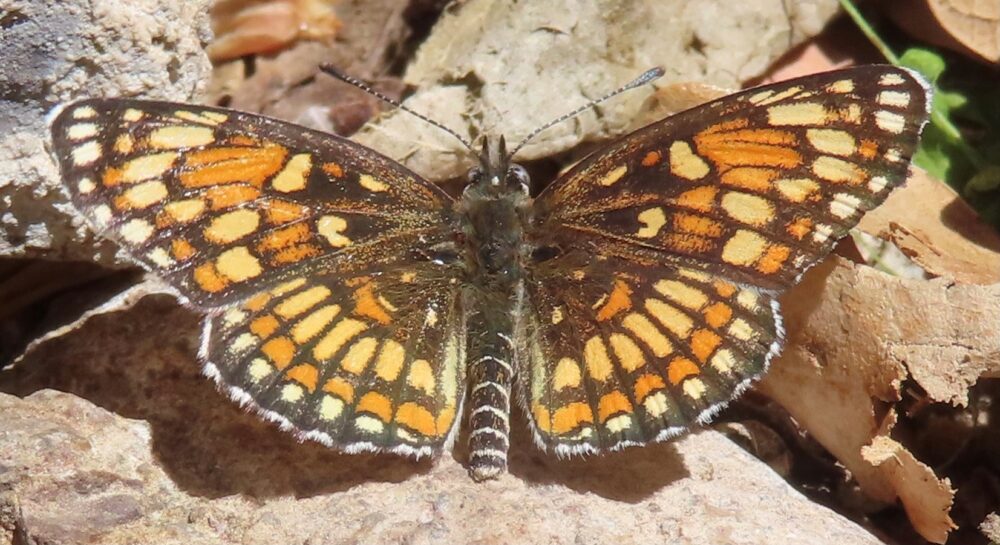
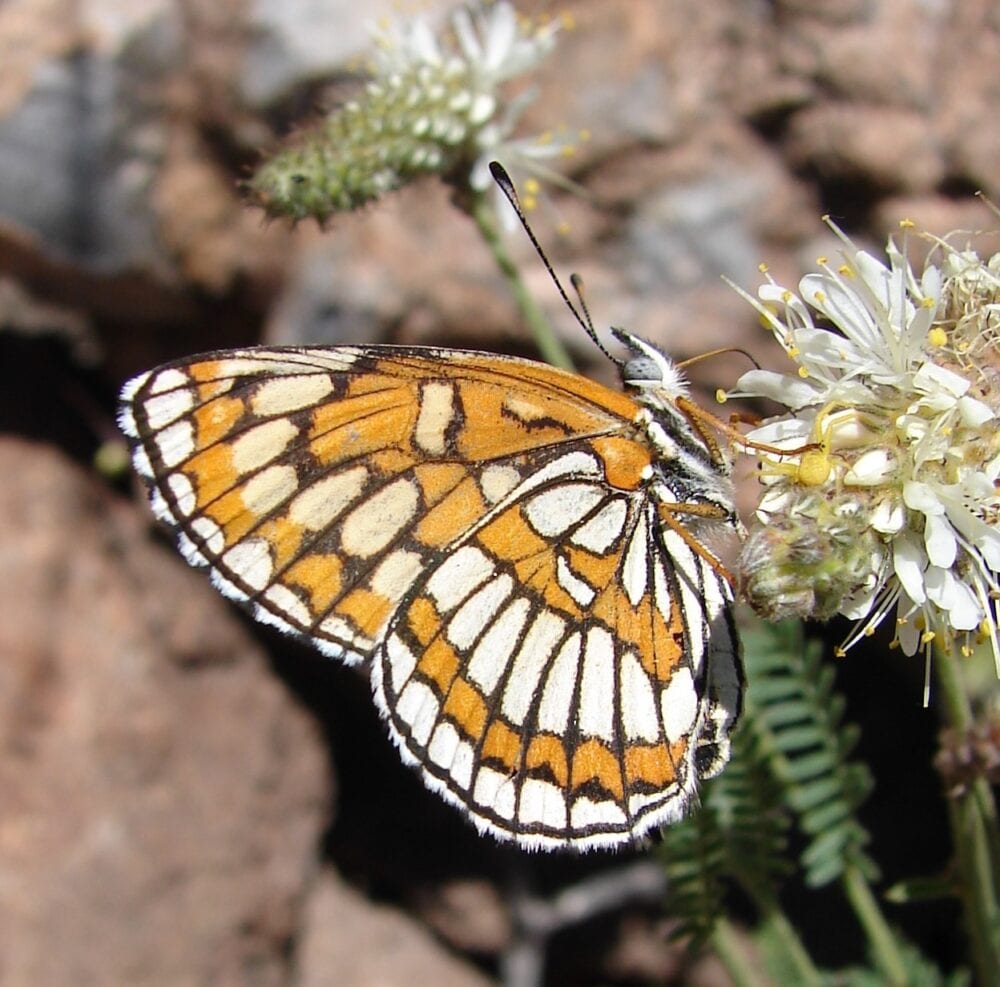
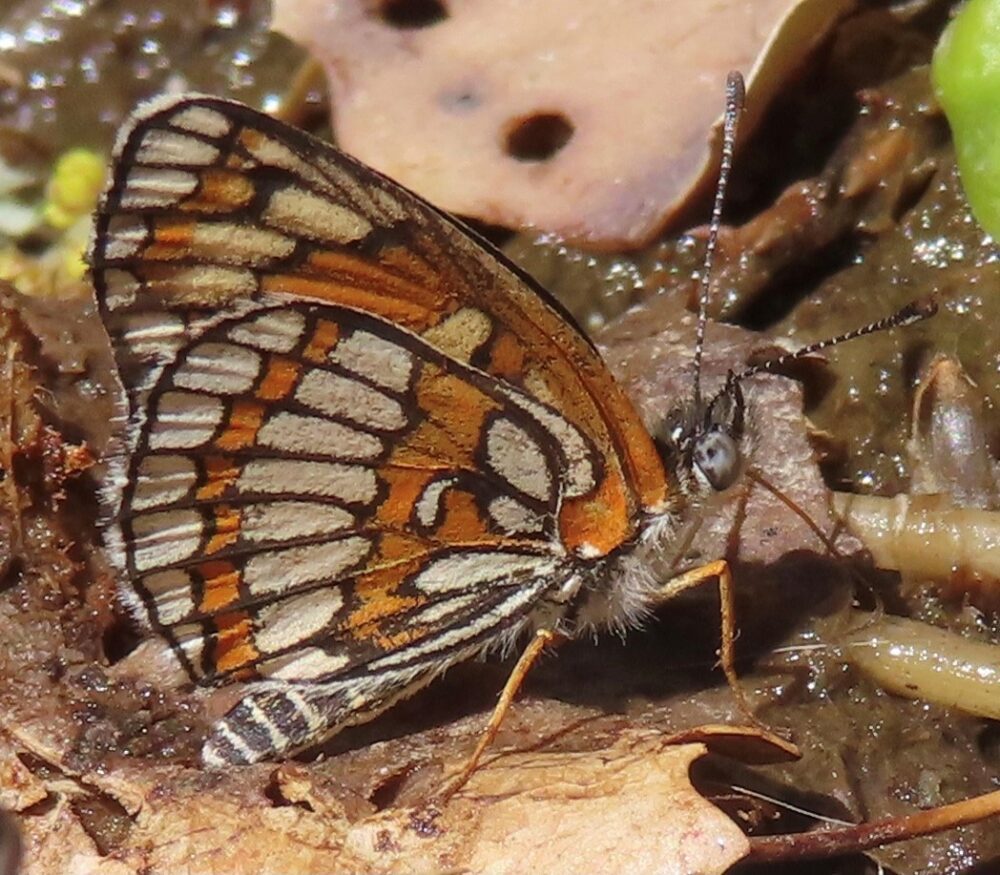
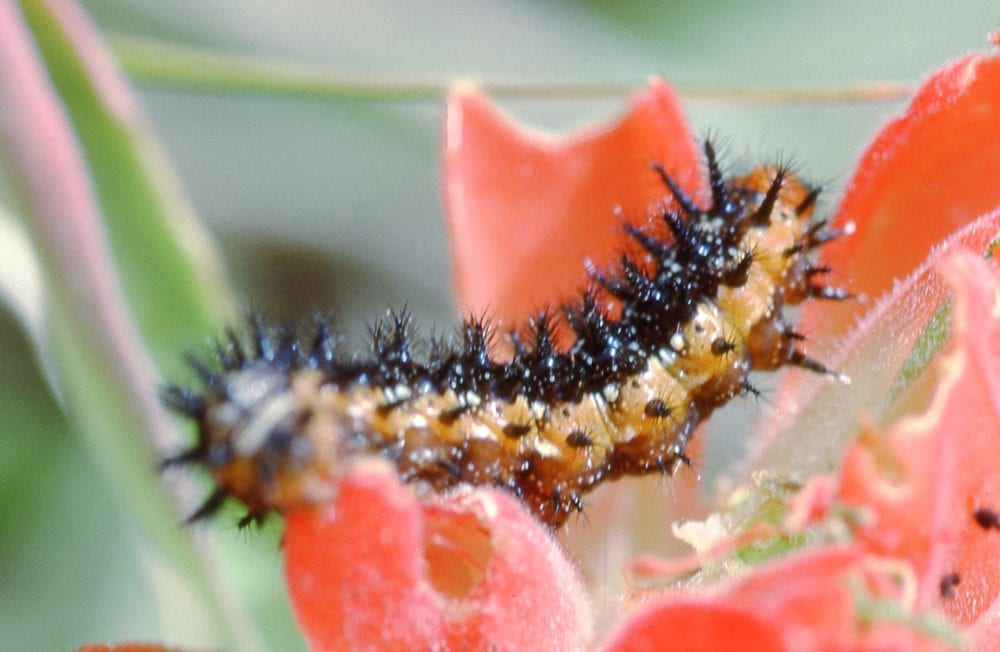
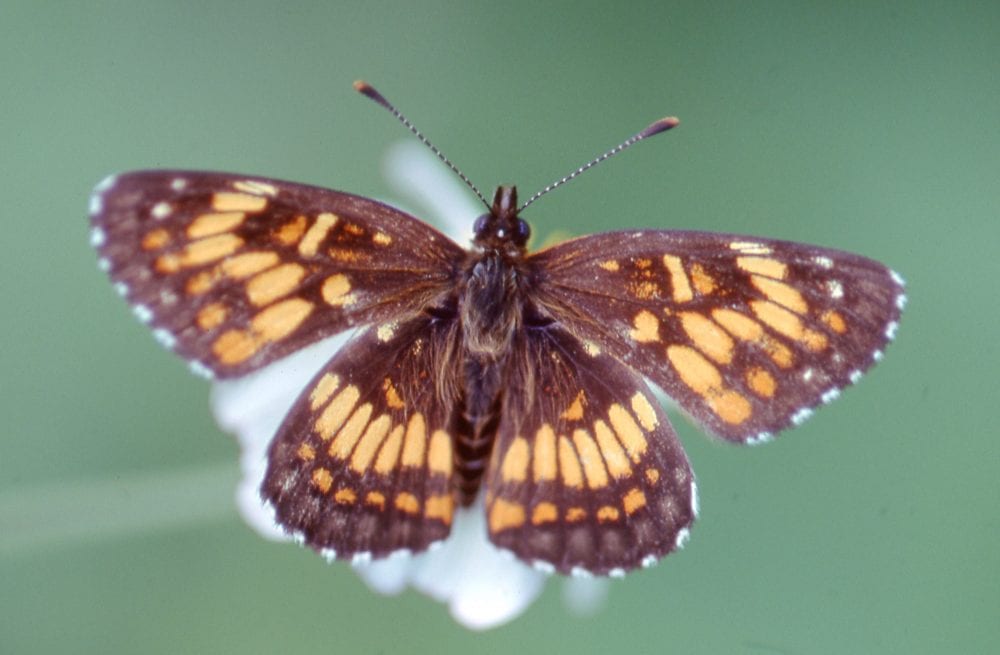

Chlosyne bollii (W. H. Edwards 1878) Boll’s Checkerspot (added June 7, 2024)
Description. Phenotypically, Boll’s Checkerspot is difficult to distinguish from our subspecies of Theona – Thekla, and we can only make general suggestions here. Like Thekla, Boll’s has bright, alternating bands on the hindwing underneath; from the margin inward they are white, orange, white, orange and white; all are crossed by black veins. On Thekla, these bands are usually wider than on Boll’s. Boll’s upperside has the postmedian band of spots on the forewing wider, forming more of a band. Thekla has this band composed of smaller spots, especially on the underside. The submarginal band of orange spots on the hindwing of Boll’s is somewhat arrow-shaped, whereas on Thekla these spots are more rectangular. Caution is advised, due to much individual variation. Range and Habitat. Boll’s Checkerspot is found in central Texas into NE Mexico. Perhaps due to its resemblance to Thekla, its presence in New Mexico is unconfirmed at this time. It would most likely be found in the SE corner of the state (Ed,Le). Life History. Larvae feed on Leucophyllum frutescens in Texas (Scrophulariaceae – Silverleaf), a plant also found in SE New Mexico. Flight. Boll’s Checkerspot is probably bivoltine. Males hilltop; both sexes seek nectar and moist earth. Comments. Boll’s Checkerspot was formerly considered a subspecies of Theona, but DNA analysis suggests it is a distinct species. The similar Chinati Checkerspot occurs in SE NM; it is distinguished from Boll’s by a brighter dorsal surface (lacking the distinct median band) and having somewhat darker marginal marks on the hindwing. Thekla Checkerspot also occurs in SE NM, complicating efforts to distinguish this species. Zhang, et al. (2023) found Thekla as far east as Jeff Davis County, Texas, but they didn’t include any New Mexico specimens in their analysis. The closest known approach to NM by Boll’s is in Brewster County, TX. However, records of “theona” from TX counties adjacent to eastern NM warrant closer examination, as they may well be Boll’s.
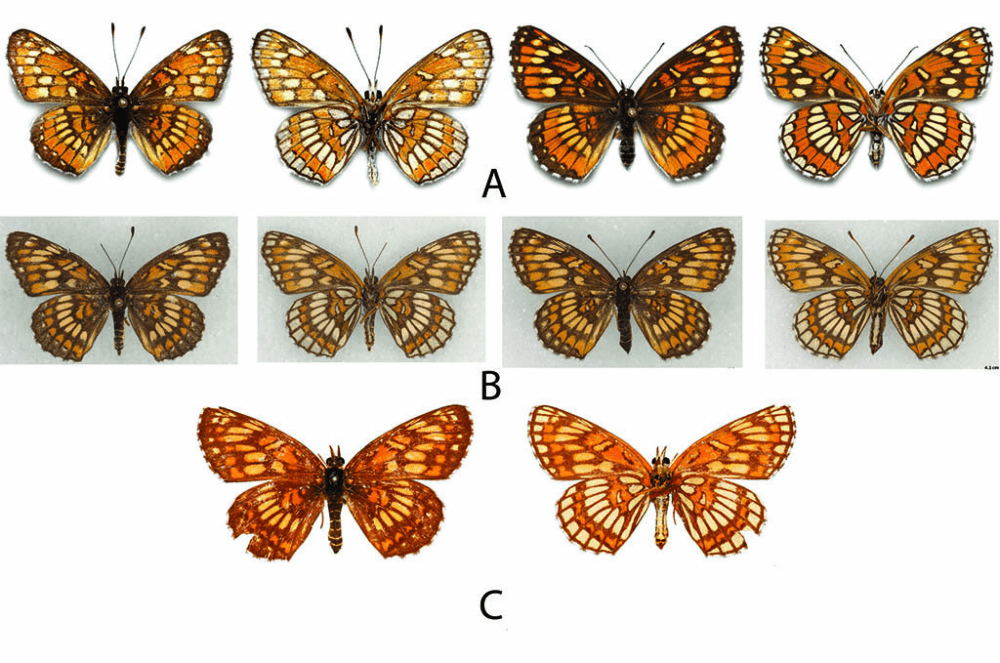
Chlosyne chinatiensis (Tinkham 1944) Trans-Pecos Checkerspot (updated November 2, 2023)
Description. The Trans-Pecos Checkerspot looks generally like sister species Theona, but the upperside is unicolorous, pale, cantaloupe orange with much fewer dark markings. Underneath, the white hindwing has reduced orange, including a narrowed submarginal orange band. Range and Habitat. Chlosyne chinatiensis is a regional endemic limited to Upper Sonoran grasslands of far west Texas and adjacent areas. In New Mexico it is rarely seen along our southeast border with Texas (counties: DA,Ed). Life History. Females of Chlosyne chinatiensis oviposit on Leucophyllum minus (Scott 1986). Flight. A meager handful of observations suggests adults are on the wing between June 6 and August 22. More observations might show two or three broods from spring into early autumn. Adults go to nectar and probably to moist earth. Comments. At the edges of their distributions in Eddy County, Chlosyne theona and Chlosyne chinatiensis both occur, but infrequently. Some have considered chinatiensis to be a subspecies of Chlosyne theona, but Zhang, et al (2020) used genomics to confirm species status for chinatiensis.
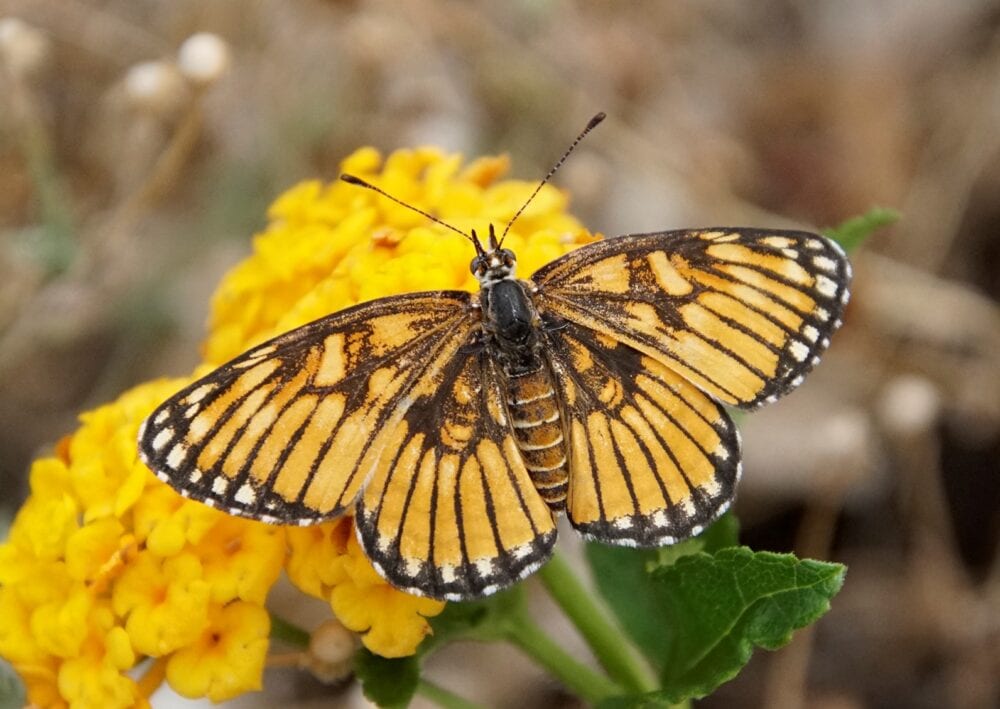
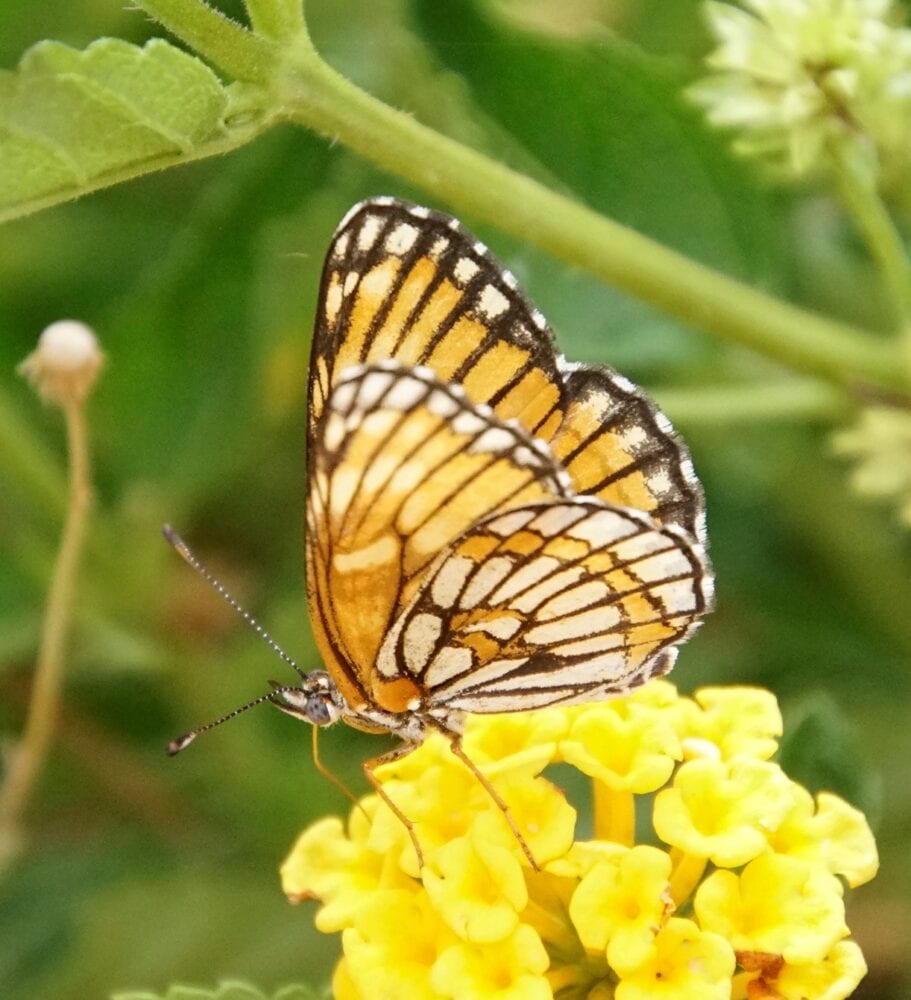


Chlosyne cyneas (Godman & Salvin 1878) Black Checkerspot (added November 2, 2023)
Description. This species begins a series of 3 (or possibly 4) Checkerspot species that are very similar in appearance. Of the 3 known species from NM, Black is the most distinctive. It earns its name by the darker dorsal surface highlighted by rows of submarginal cream spots and marginal rows of orange spots. Beneath, it shows the characteristic pattern of this group of Checkerspots: cream ground color and a distinct submarginal row of black ringed white spots. The veins are marked with black. The abdomen is black with white rings. The palps on the head offer identification clues in this group: Black has palps that are black above and white below. Range and habitat. Black is primarily a Mexican butterfly; in the US its stronghold is SE AZ. Life history. Hosts include paintbrushes (Castilleja: Orobanchaceae), including Castilleja tenuiflora (the known host in AZ) and Brachystigma wrightii. Flight. In SE AZ, the species flies from Feb. – Nov. in several broods. Comments. The one potential sighting from NM was by Steve Cary, Cistern Saddle, Animas Mts., Hidalgo County, 19-vii-1991, sight record. This record needs confirmation. There are historical records from the Chiricahua Mts., less than 20 miles from the NM border, though none have been seen there in recent years (Bailowitz & Brock 2022).
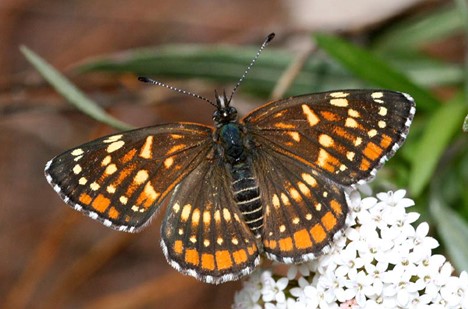
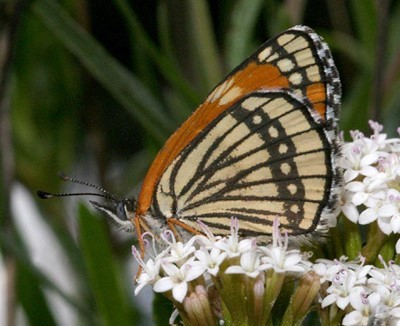


Chlosyne fulvia (W. H. Edwards 1879) Fulvia Checkerspot (updated November 3, 2023)
Description. Fulvia Checkerspot is quite variable above, from pale and orange to dark and black, as shown in the photos. It is creamy white below; compared to Theona, with which it rarely flies, even the ventral hindwing submarginal band is white. All veins are black. Range and Habitat. Chlosyne fulvia lives from Nebraska south to Arizona, Texas and northern Mexico. It prefers Upper Sonoran and Transition Zone grassland and savanna habitats and is routine in most of New Mexico (all counties). Its altitudinal range typically spans 5000 to 7000′, but it will stray to higher hilltops. Rene Laubach’s recent find at 11,100 above Santa Fe may be the altitudinal record for this species. Life History. Orobanchaceae are larval hosts. Eggs are placed in bunches and larvae are gregarious while small. Documented hosts in New Mexico include Indian paintbrush (Castilleja integra), plains paintbrush (C. sessiliflora) and Sierra woolly Indian paintbrush (C. lanata). Cordylanthus wrightii is used in southeast Arizona. The various Castilleja species are root parasites on other plants. Flight. Fulvia has one to three broods per year depending on conditions. Southern New Mexico records fall between March 18 and October 26. In north-central New Mexico, flight is May to September, peaking in July. Males doggedly patrol hilltops despite their seemingly weak flight. Comments. At least within New Mexico, the great phenotypic variability of this species (see photos below) does not lend itself to subdivision into geographic subspecies. Nevertheless, observers in western New Mexico should keep an eye open for the very similar Chlosyne coronado (M. Smith & Brock 1988) and (in our Bootheel) Chlosyne cyneas (Godman & Salvin 1878). Both of these species have been reported from Hi, and both are regular in southeastern Arizona. It is possible that the very similar Chlosyne leanira flavodorsalis (Austin & M. Smith 1998; type locality, 4 mi. W. Bluff, San Juan Co, Ut – ca. 35 mi. from NW corner of NM) may eventually be found in NM. Leanira has orange palps; Fulvia palps are black above and white below.
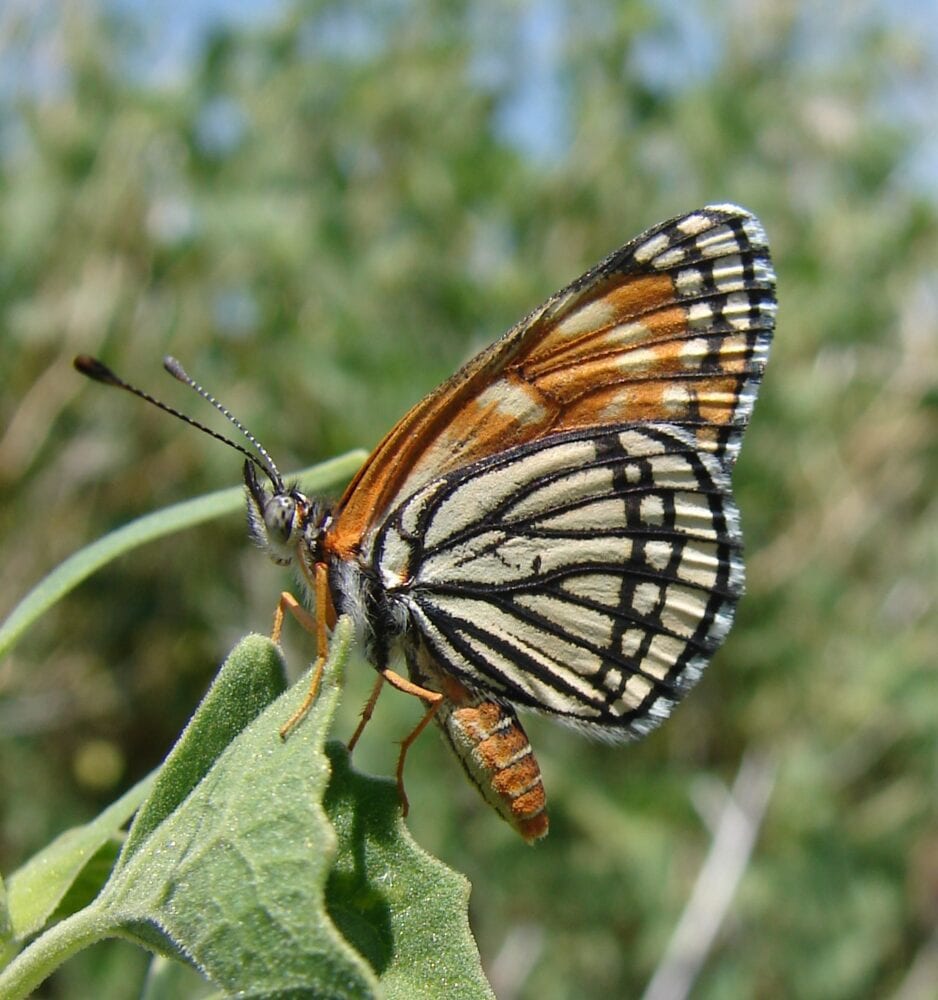
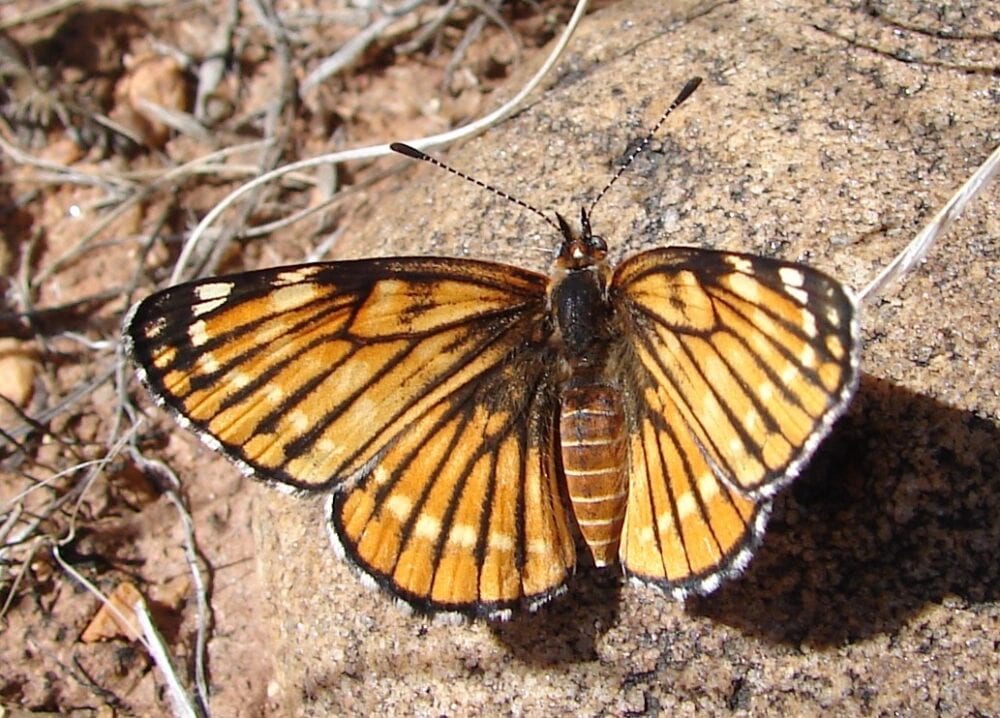
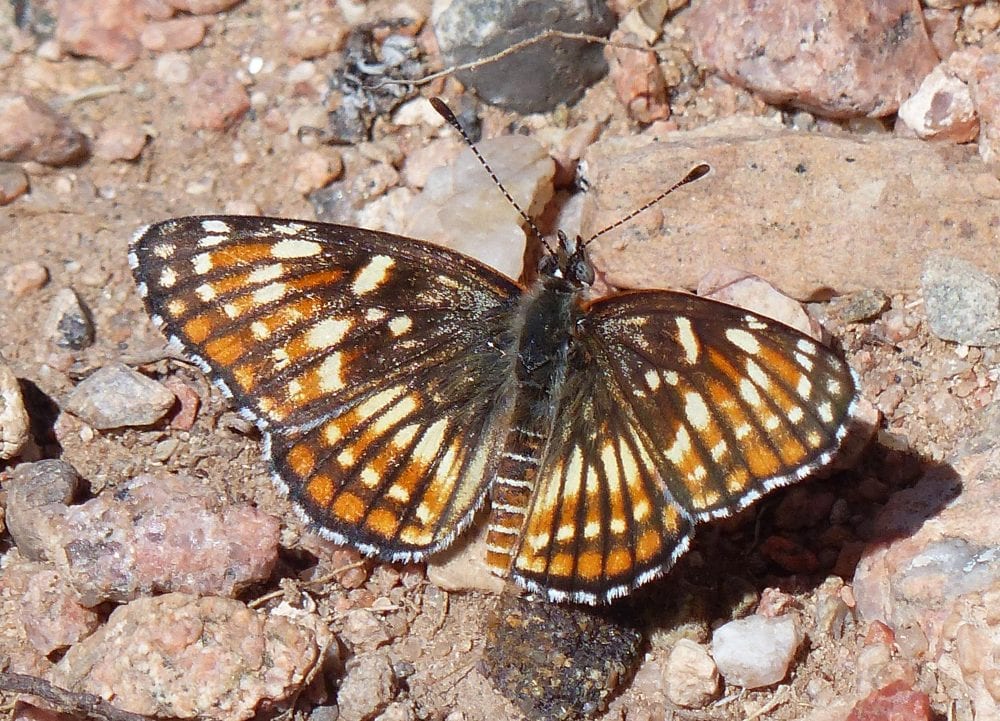
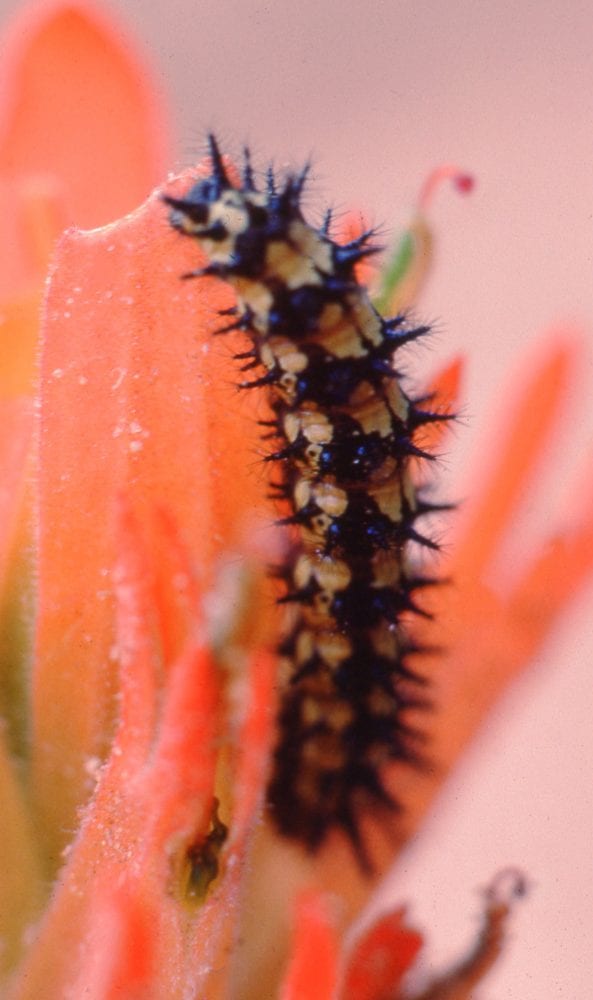
Chlosyne coronado (M. Smith & Brock 1988) Coronado Checkerspot (updated November 4, 2023)
Description. Compared to the very similar Fulvia, Coronado has more dorsal black suffusion. This is most evident on the dorsal forewing where three dark patches surround the pale cell spot, creating a strongly checkered appearance in males and females. Coronado also is about 10% larger (Smith & Brock 1988: 9-10). Coronado and Fulvia have orange scales on the abdomen and black and white palps. Range and Habitat. Coronado occurs in Southwest deserts, generally below 7000′ elevation. This means much of southern AZ, southern UT, and western NM (counties: Ci,Gr,Hi,MK). Life History. Paintbrushes (Orobanchaceae) are the principal larval hosts. Castilleja lanata and Cordylanthus wrightii are documented hosts in Arizona. Flight. Males stake out hilltop territories. Both sexes go to flowers and moist soil. A spring brood flies in response to winter moisture and a summer flight coincides with the monsoon season. Flight dates span April 2 to September 2. Comments. Coronado is established in the NM Bootheel. Observations occur as far north as McKinley County, but Fulvia occurs there, too, so it will take some time and some study to define the range of occurrence for each.
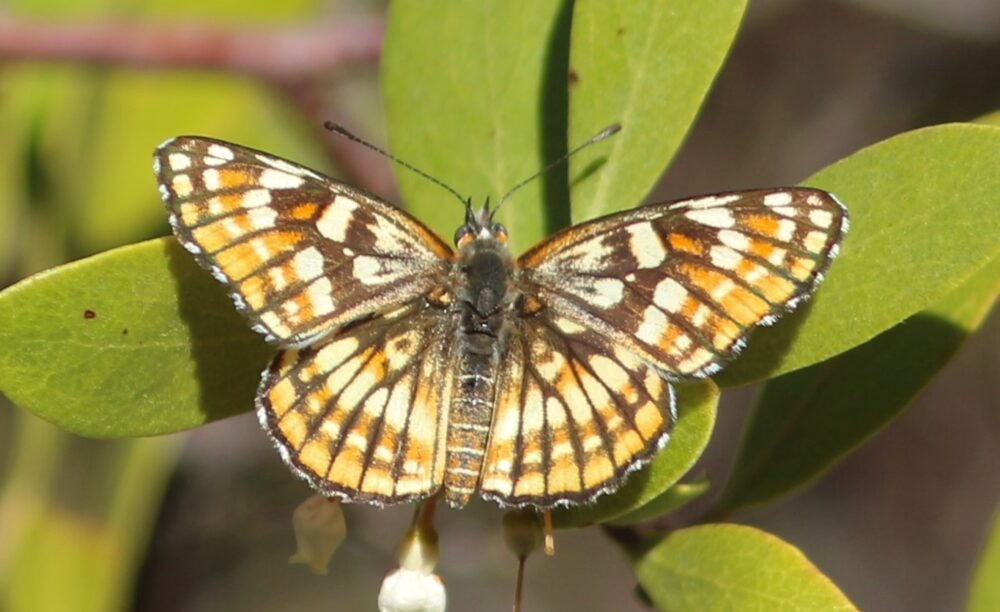

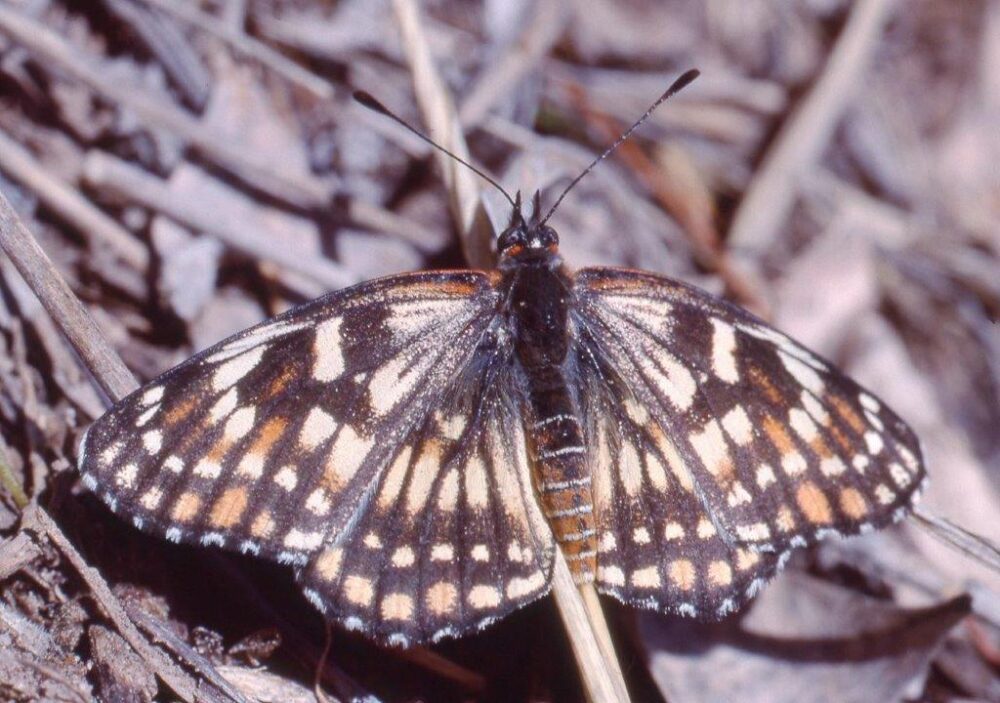

Chlosyne leanira flavodorsalis (Austin & M. Smith 1998) “Eastern” Leanira Checkerspot (added June 20, 2024)
Description. Virtually identical to Fulvia Checkerspot, the “Eastern” Leanira may be distinguished from that species by examining the palps. “Eastern” has orange palps whereas Fulvia has black and white palps. Range and Habitat. The known range of “Eastern” is SE Utah and W Colorado. Smith and Brock (1988) classified specimens of this complex from the Chuska Mountains and SW Colorado as “fulvia undetermined”. Specimens from these areas should be re-examined to see if any are “Eastern” Leanira. Life History. Larvae were reared from Desert Paintbrush, Castilleja chromosa, in Colorado and Utah. That plant occurs widely in northern New Mexico, including along the San Juan River in San Juan County. Flight. “Eastern” Leanira flies in the spring (as far as known) from early April to early June. Comments. The “Eastern” Leanira Checkerspot was described from near Bluff, Utah, along US highway 163. This locality is approximately 40 miles from the NM border. A likely place to look for this species in NM is along the San Juan River where it exits NM and enters Colorado. There is a road leading from US Hwy 160 southeast from the Colorado – New Mexico state line that allows access to the San Juan and some of the surrounding bluffs; perhaps some enterprising NM butterfly enthusiast will take a trip there!
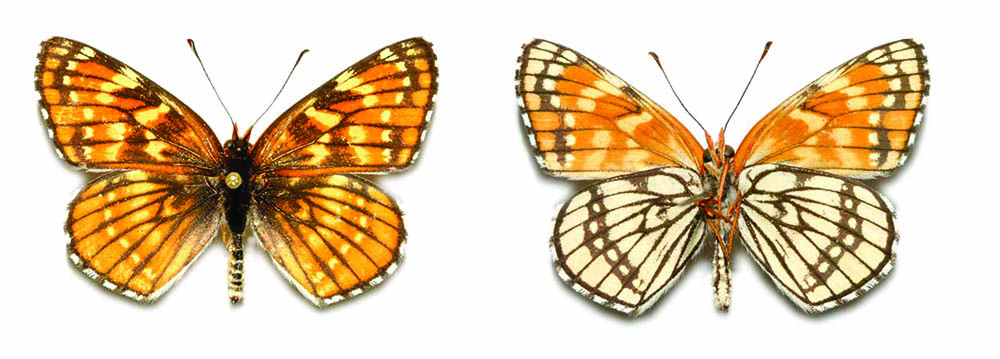



Chlosyne lacinia (Geyer 1837) Bordered Patch (updated November 4, 2023)
Description. Bordered Patch is black above and below, but the band on the hindwing upperside varies from wide and glorious in eastern populations to narrow and white in western areas, rarely tending toward obsolete. Range and Habitat. This is a common Neotropical species from Argentina north to the southwest US, straying to the central US. Although it has been recorded from much of New Mexico, it is most regular at lower altitudes and latitudes (all counties but Gu,LA,Mo,RA,SJ), almost always below 7500’. Life History. Larval hosts are sunflowers (Asteraceae) in several genera. Cockerell (1900) noted larvae on annual sunflower (Helianthus annuus) and Helianthus ciliaris in the Mesilla Valley (DA). Other host genera include Ambrosia, Tithonia, Viguiera, and Xanthium and Ximenesia. Flight. Bordered Patch is multivoltine. A spring flight peaks in April; overlapping broods form another peak from July to September. Extreme dates are April 3 and November 26. Males hilltop; adults of both sexes come to nectar and water. Comments. Western subspecies Chlosyne lacinia crocale (W. H. Edwards 1874) has a narrow, white hindwing band and prevails in Arizona. Eastern subspecies Chlosyne lacinia adjutrix Scudder 1875 has a broad, orange hindwing band and prevails in Texas. The two forms overlap broadly and there is a high frequency of intermediate forms largely statewide. It is accurate to state that C. l. adjutrix prevails in our southeast corner while C. l. crocale predominates west of the Pecos River, but either form can be found almost anywhere in NM. Forms “rufescens” and “nigrescens” were described from Las Cruces by William Henry Edwards, but these terms seem to have little value today.
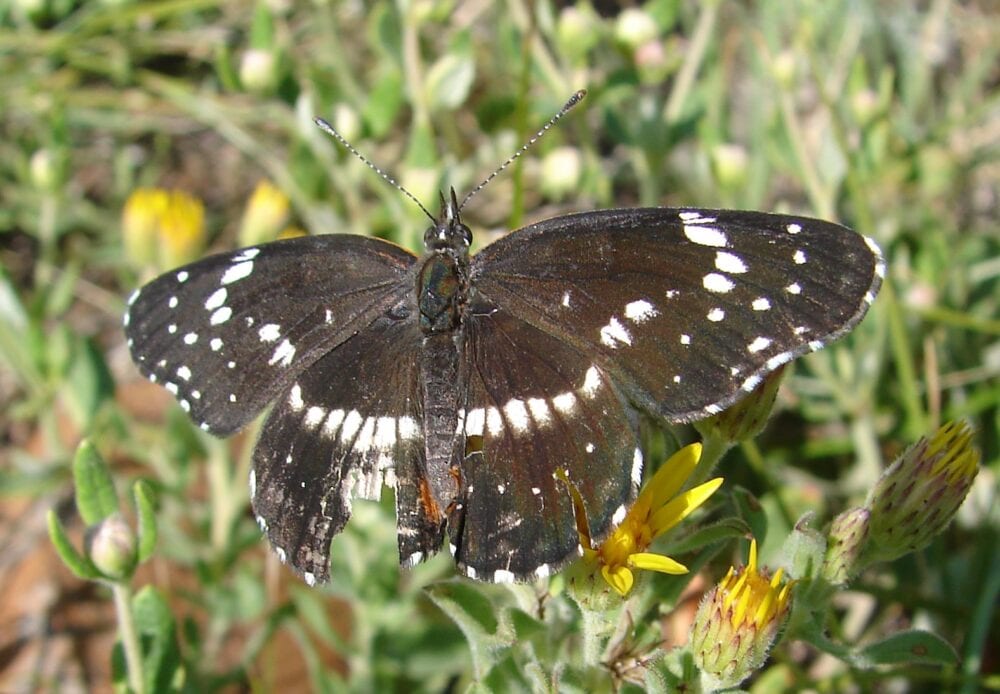
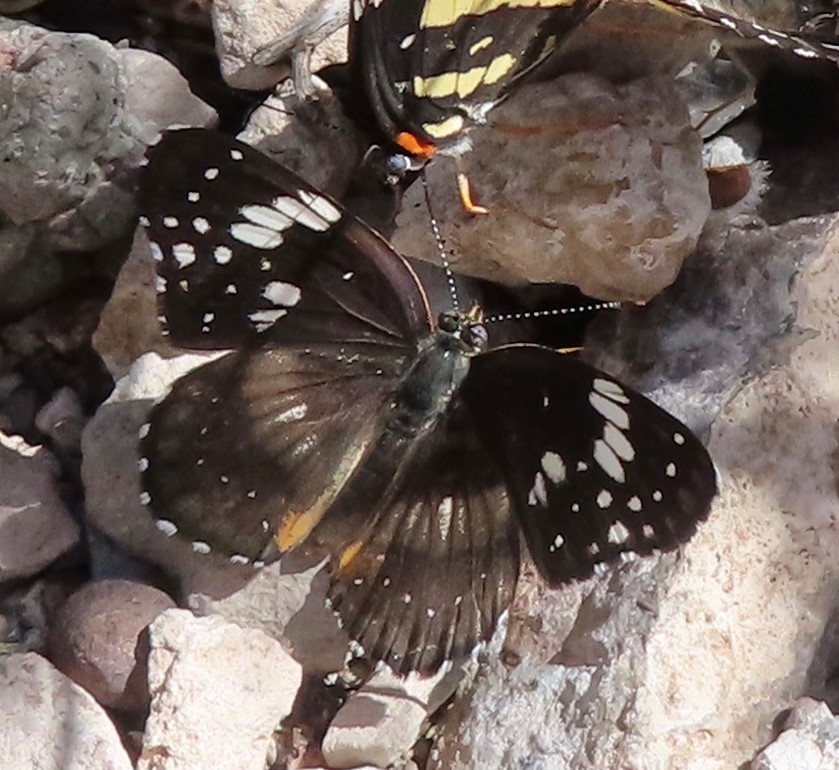
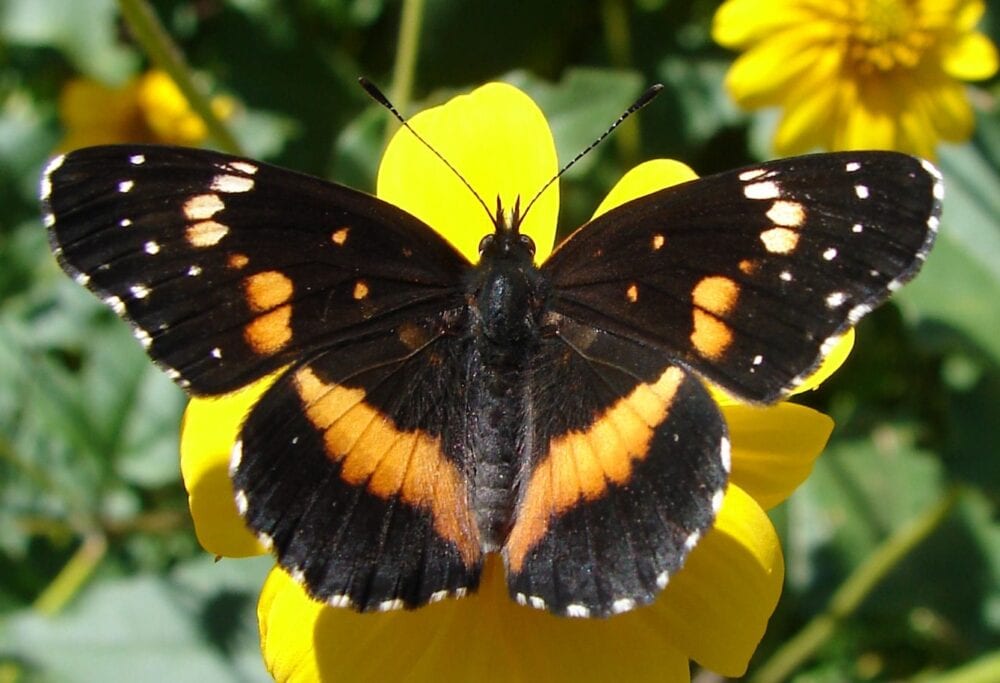
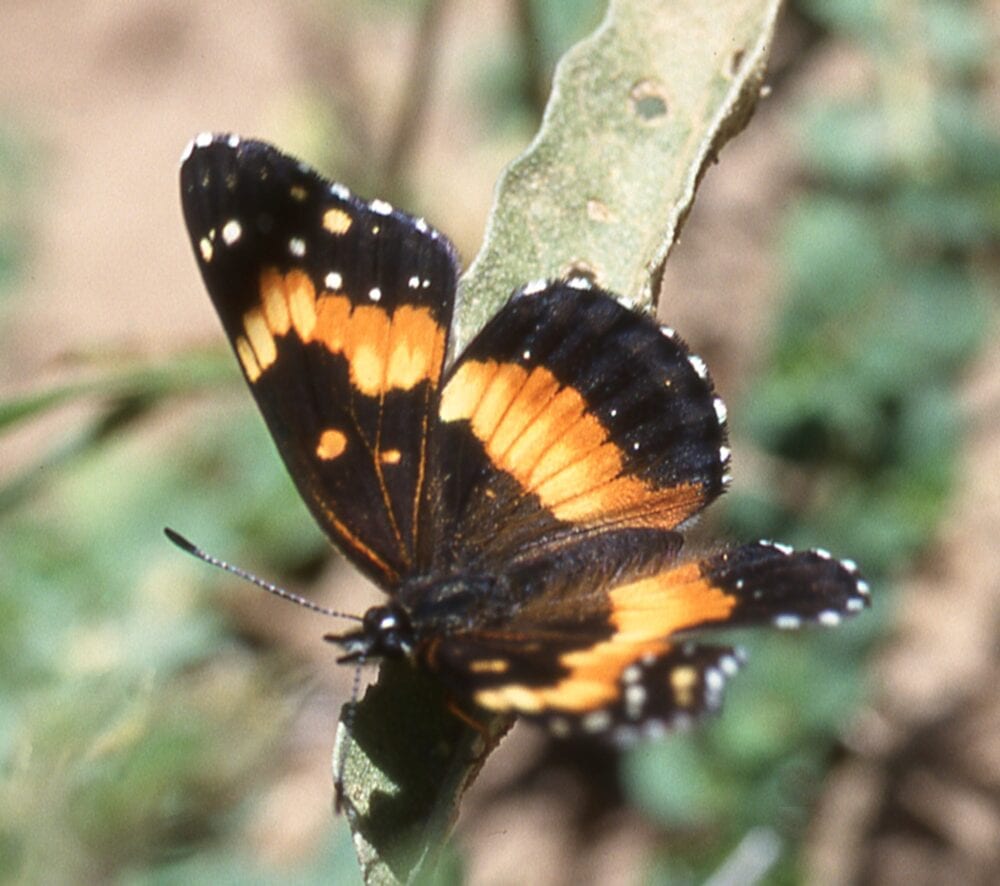
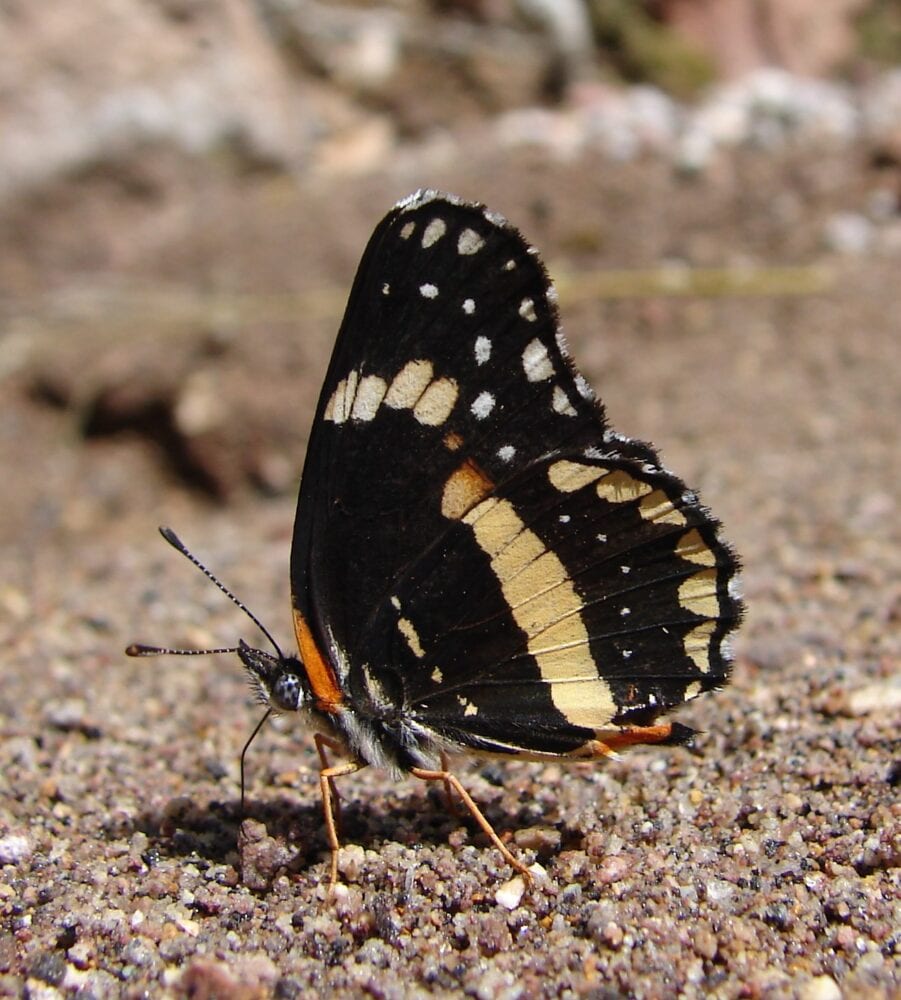

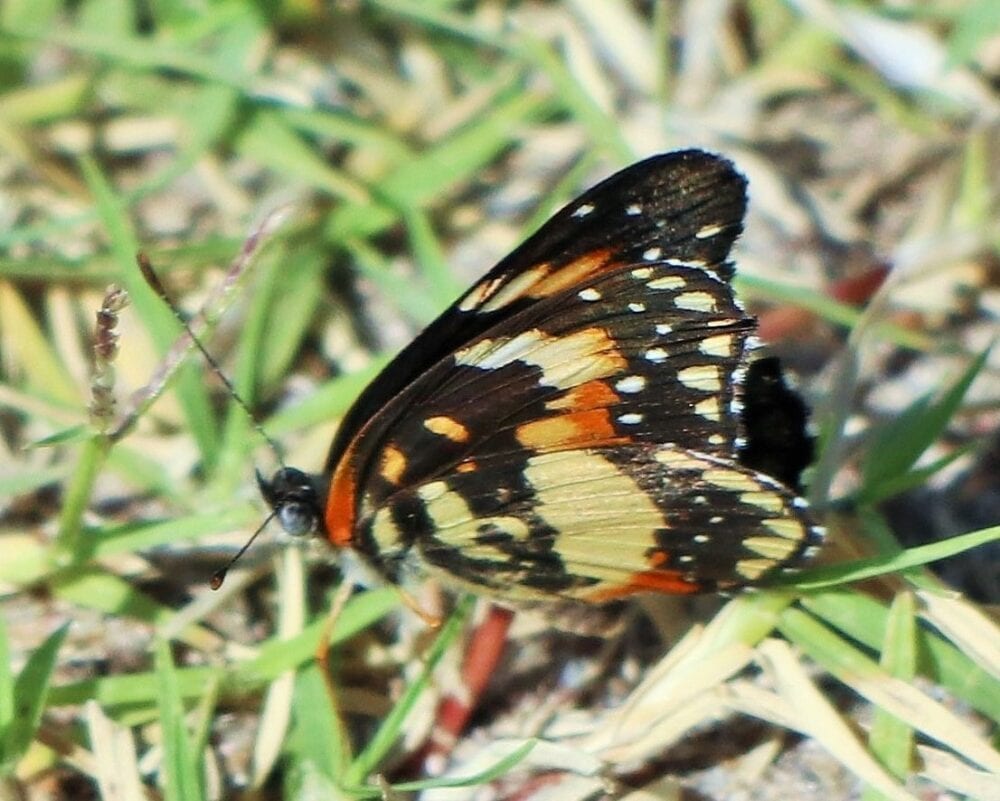
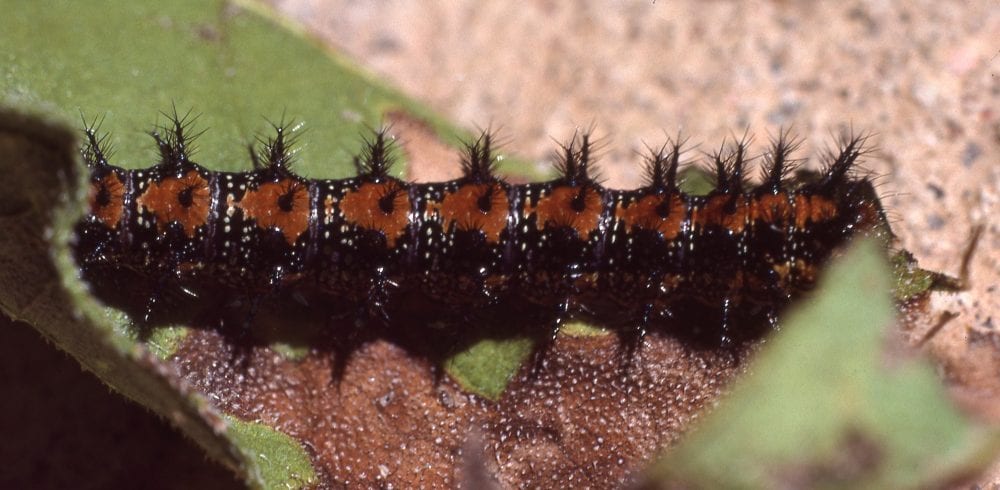

Chlosyne californica W. G. Wright 1905 California Patch (updated November 5, 2023)
Description. California Patch is colorful black and orange punctuated with rows of white dots. It could be mistaken for the eastern version of Bordered Patch (Chlosyne lacinia adjutrix) but for the row of orange-brown spots at dorsal forewing and hindwing margins and the broad orange scaling in the postmedian area of the ventral forewing. Similarity to the variable C. lacinia makes it hard to be confident of C. californica identifications when within the range of the former, as southern New Mexico is. Range and Habitat. This is a routine species of lowland deserts from southern CA and southern NV east to central AZ and south into Baja California. In New Mexico, we know of four occurrences of the California Patch phenotype (counties: Be,Ca,Gr,SF?), all presumably via dispersal from southern AZ. Life History. One known larval host is Geraea canescens, commonly known as desert sunflower. There is some evidence that it may use Stenoloba spp. or Heliomeris spp. in southeast AZ. Flight. Where it breeds, California Patch is double- or triple-brooded depending on precipitation events. Males seek hilltops; adults of both sexes come to nectar and water. Local population explosions and expansions do occur. Supplementary Information. California Patch is included in the NM fauna on a tentative basis because of its similarity to Bordered Patch, which is extremely variable. Back in 1991, Bailowitz and Brock (1991:225) could point to only one California Patch report from southeastern AZ. A butterfly fitting the C. californica phenotype had been seen amidst flocks of C. lacinia, so they took a conservative approach and treated California Patch as “hypothetical” in that region. Three decades later, something had changed. Those same authorities (Bailowitz and Brock 2021: 177) reported that a major influx of butterflies with the California Patch phenotype had spread across southeast AZ in late summer of 2012. That was followed by some local breeding/reproduction in the Tucson area into 2013 and 2014, some involving what would be a new potential larval host for California Patch, Viguiera stenoloba, which grows in southern NM, too. Spooling ahead to late summer 2021, photos posted to iNaturalist and BAMONA suggested a similar eastward expansion of the California Patch phenotype into southeast AZ and beyond. The California Patch phenotype has been photographed four times in New Mexico and those occurrences are not randomly scattered over time. One, apparently our first, was documented in Bernalillo County on Sept. 30, 2012. The other three were recorded on Sept. 14, Sept. 20 and Sept. 23 of 2021, in Grant, Catron and Santa Fe counties respectively. Thus, all known occurrences of the California Patch phenotype in New Mexico coincided with population influx events of that phenotype in southeast Arizona. If the AZ creatures were California Patch, then so were New Mexico’s. They could have been oddball Bordered Patches, but that seems unlikely.
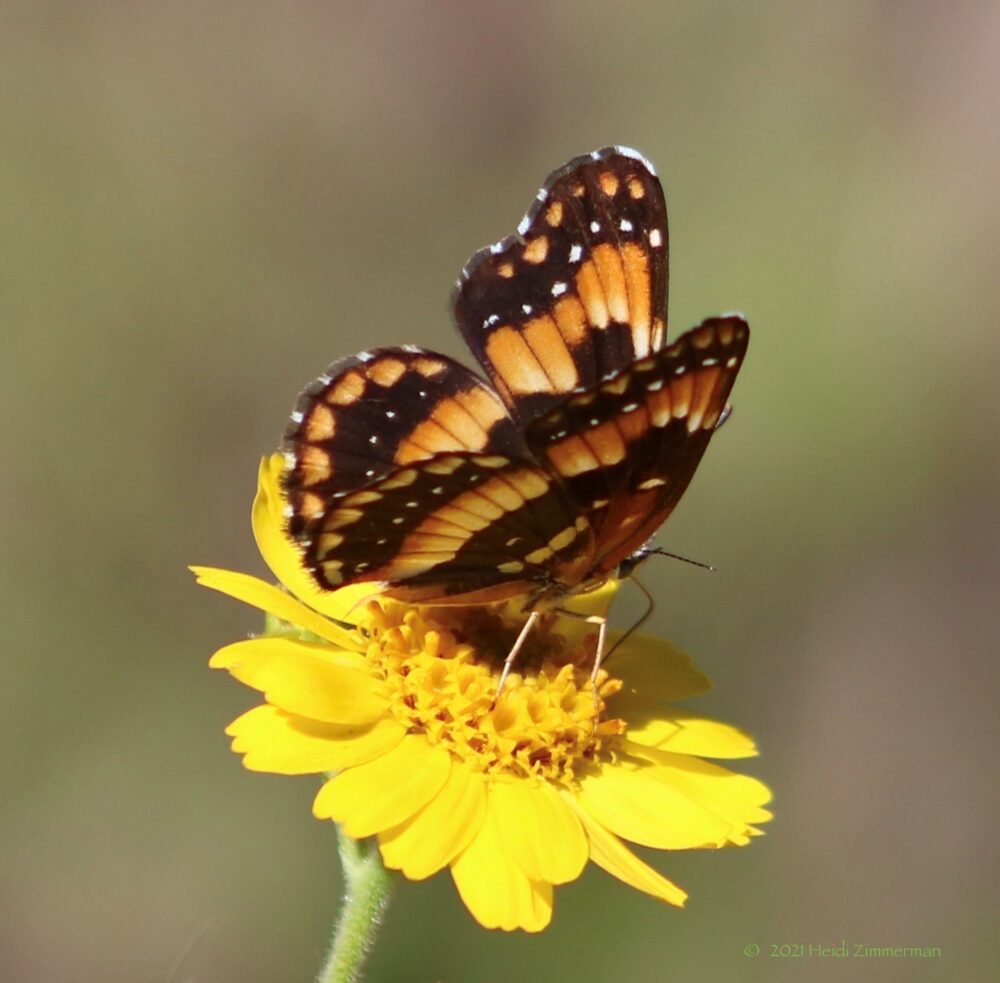
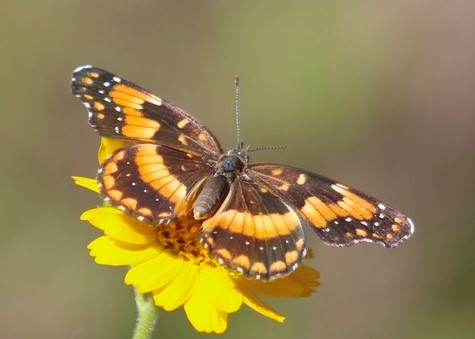
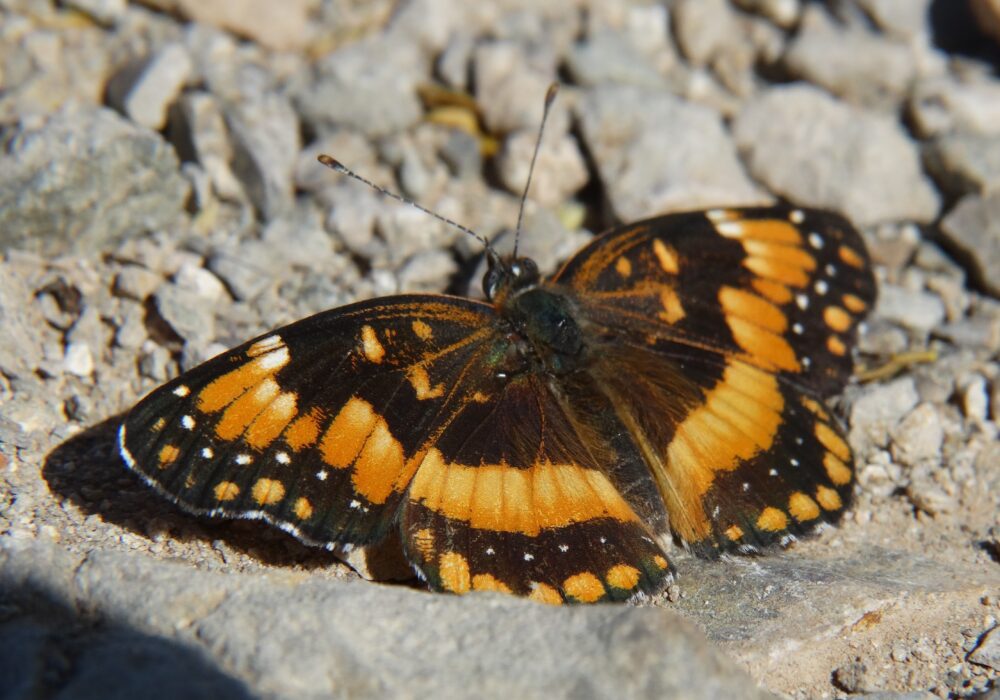


Chlosyne gorgone (Hübner [1810]) Gorgone Checkerspot (updated November 5, 2023)
Description. This butterfly has familiar orange-with-black markings typical of many checkerspots. To confirm you’re looking at Gorgone Checkerspot, check the upperside forewing apex for three tiny white dots. Check the ventral hindwing for white bars exhibiting strong diagonal orientation. Range and Habitat. Mostly a Great Plains denizen, Gorgone occurs from the Front Range to the Great Lakes and from Canada to the Gulf states. In New Mexico it inhabits our northeast plains and north-central mountain meadows (counties: Co,Cu,DB,Gu,Ha,LA,Mo,Qu,RA,Ro,Sv,SM,Ta,Un,Va?), typically 4500 to 8000’ elevation. Life History. Hosts in the West are composites (Asteraceae), such as various Helianthus species, Iva (Cyclachaena) xanthifolia, Ambrosia trifida and Xanthium pennsylvanica var. strumarium. Larvae hibernate. Flight. Montane populations are univoltine, flying from May 14 to July 16, peaking in June. Plains populations are bivoltine, flying from April 30 to September 26, peaking in May to June and again in September. Adults are avid nectar seekers and males may hilltop. Comments. At Oasis State Park (Ro) on 18 September 1999, males dune-topped, larvae munched leaves of Helianthus petiolaris, and a chrysalis clung to a stucco wall six feet off the ground. No subspecies are currently recognized.
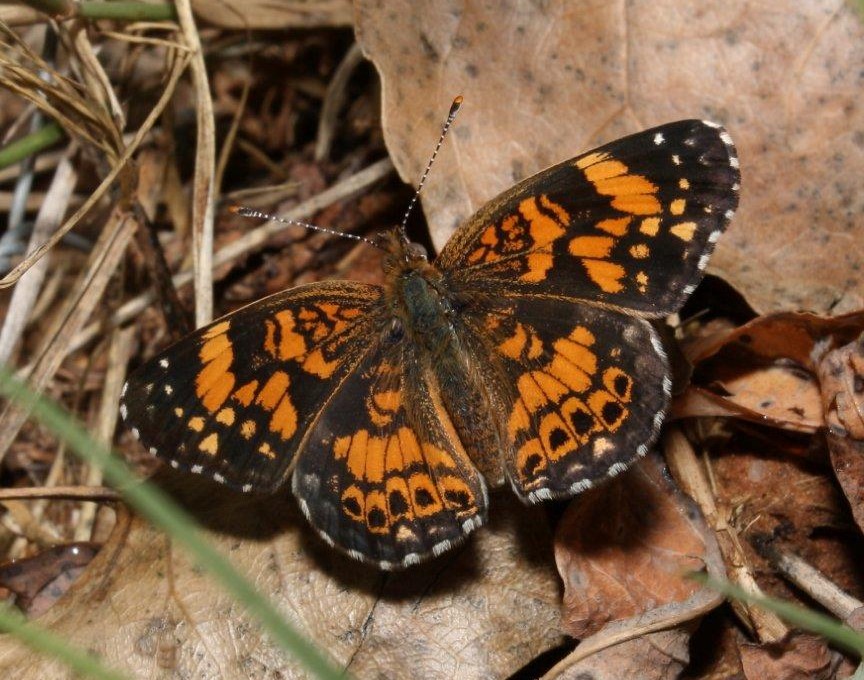

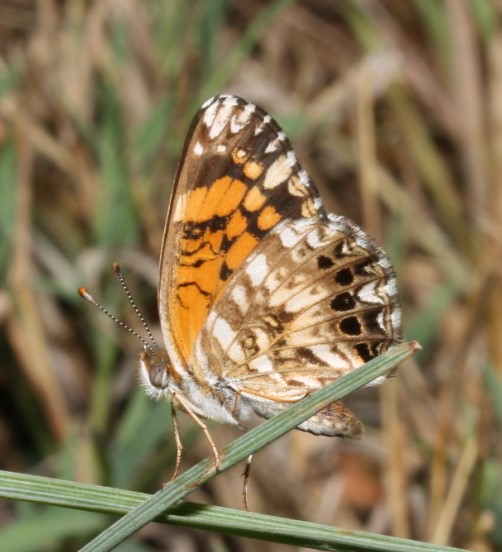
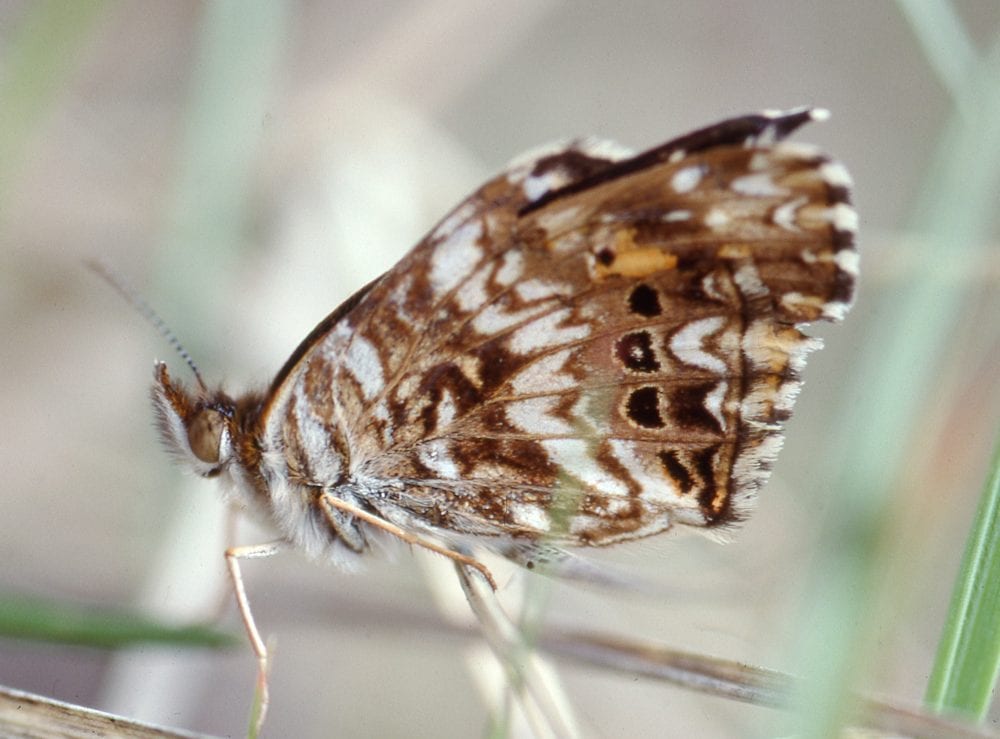

Chlosyne nycteis (E. Doubleday 1847) Silvery Checkerspot (updated November 6, 2023)
Description. Silvery Checkerspot looks like an oversized Phyciodes. It is orange above with checkered wing fringes, black marginal areas and orange postmedian bands. On the hindwing above, submarginal black spots usually have white centers. Underneath, the hindwing has that submarginal band of dark circles centered in white (diagnostic for Silvery). Range and Habitat. Chlosyne nycteis likes moist meadows in the eastern US. It also colonizes montane riparian areas in the southern Rockies, including New Mexico (counties: Be,Ca,Co,Li,LA,Mo,Ot,RA,Sv,SM,SF,Ta,To,Un), typically 7300 to 9100′ elevation. Life History. Larvae eat many composites (Asteraceae). Scott (1992) found larvae on cutleaf coneflower (Rudbeckia laciniata var. ampla) throughout northern New Mexico. Half-grown larvae hibernate. Flight. Univoltine adults fly from May 20 to September 7, mostly June and July. They frequently visit streamside flowers. Comments. Our populations are western subspecies Chlosyne nycteis drusius (W. H. Edwards 1884), which is darker than the typical eastern US version. The Sacramento Mountains population seems not nearly as dark and may be an undescribed subspecies.
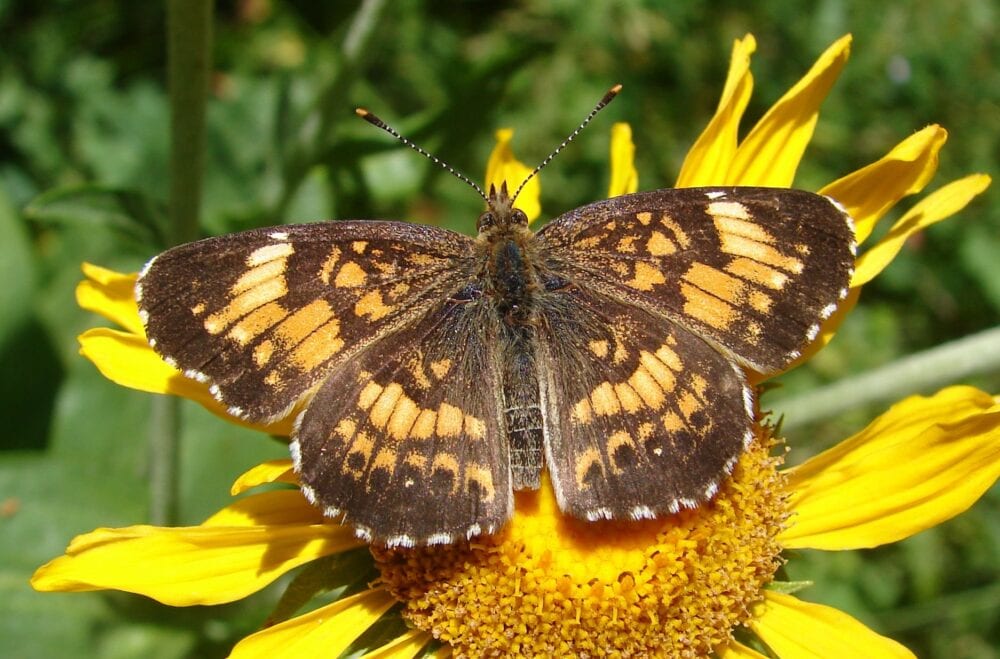
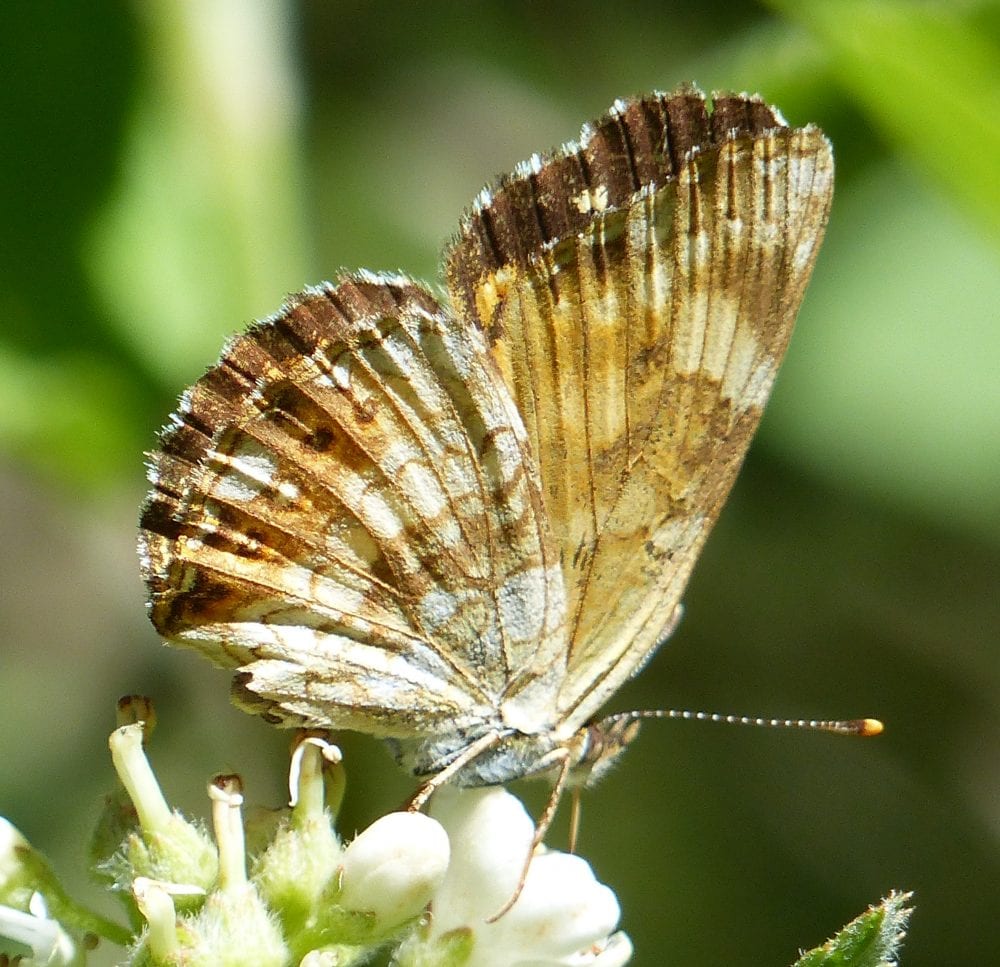
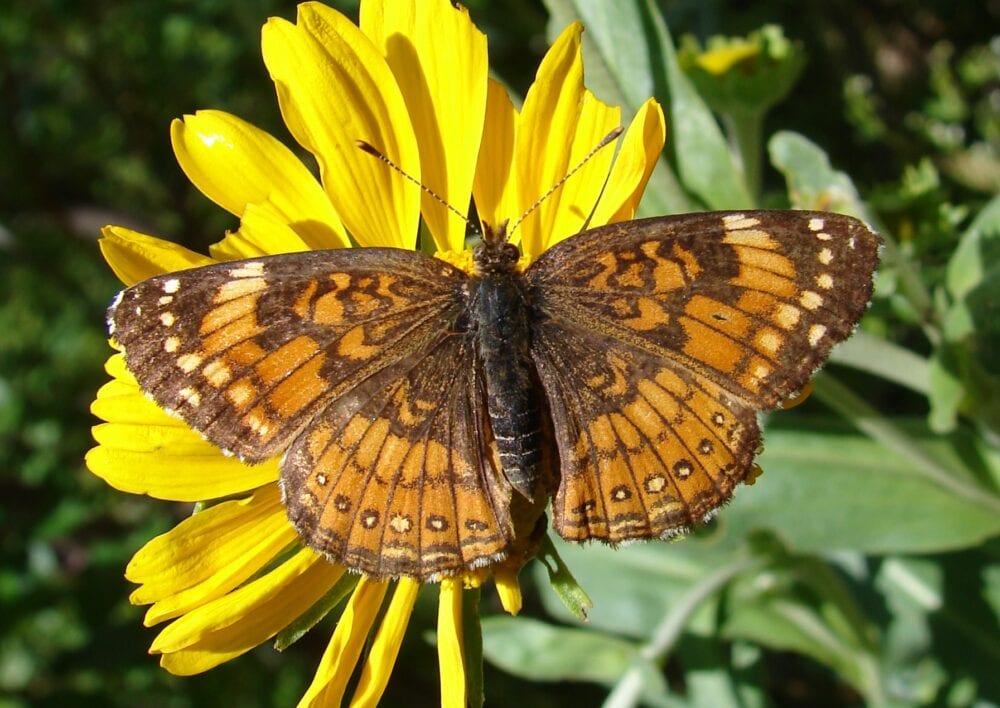
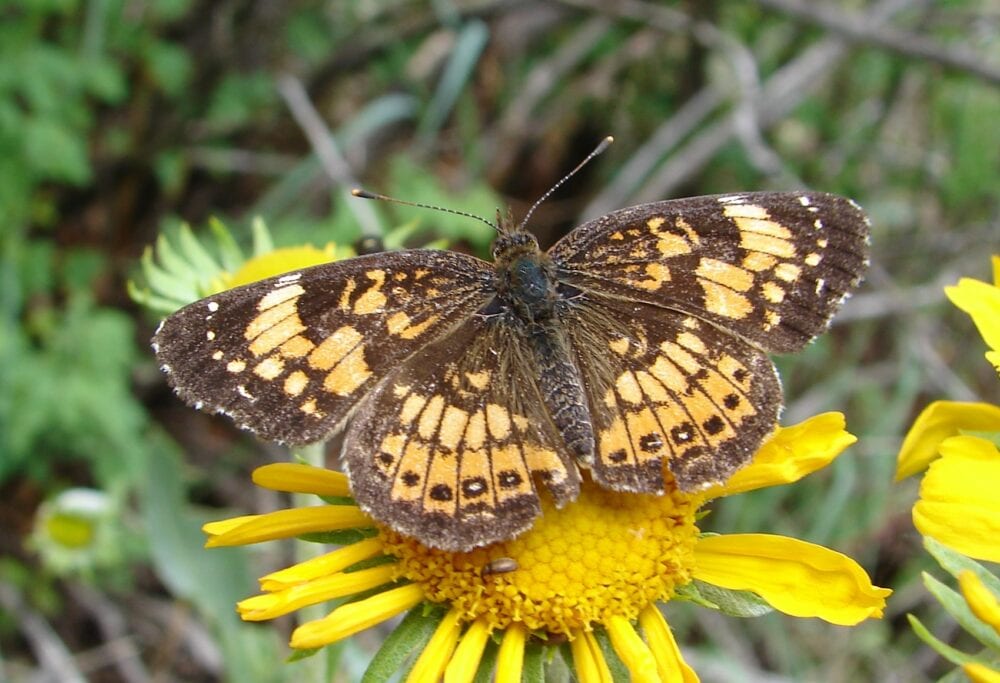

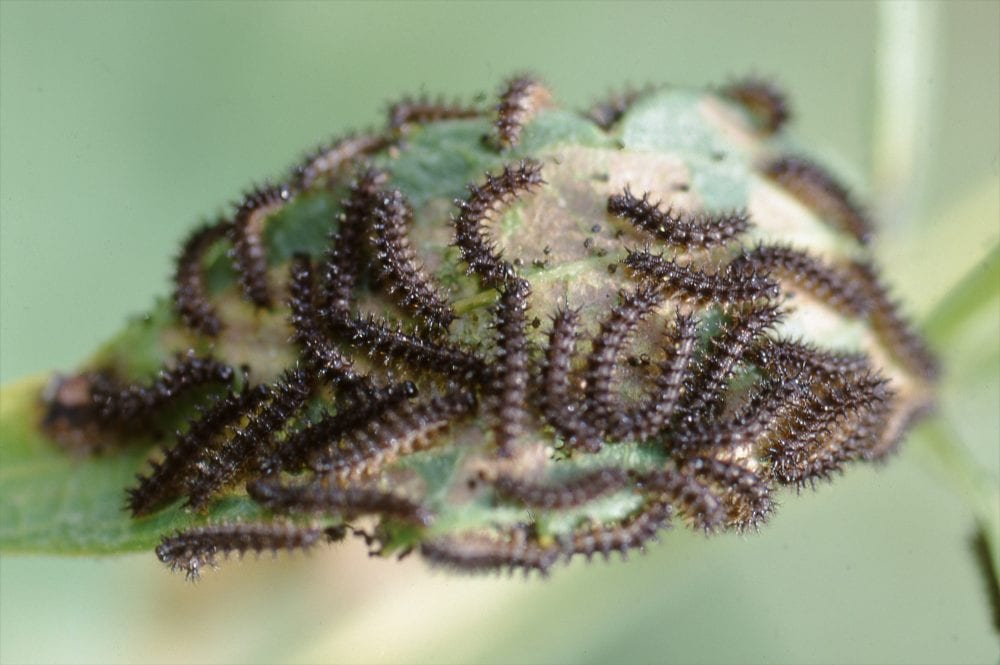

Chlosyne acastus (W. H. Edwards 1874) Sagebrush Checkerspot (updated November 7, 2023)
Description. Sagebrush Checkerspot is orange above within a black grid that is light on males, but bold on females. Underneath, the hindwing has white marginal and postmedian spot bands. The intervening orange band is watermarked with small, white circles. Range and Habitat. This butterfly is native to the Great Basin and Rocky Mountains. It lives in open woodlands and sage savannas in western New Mexico (counties: Be,Ca,Ci,Gr,Li,Lu,MK,RA,Sv,SJ,Si,So,Ta,Va), generally 4500 to 9200′ elevation. Life History. Chlosyne acastus larvae eat various Asteraceae. Ellery Worthen found wild larvae on Macaeranthera bigelovii in Albuquerque. Other hosts include M. canescens, M. asteroides, M. viscosa and Aster species. Flight. Sagebrush Checkerspots complete at least one, sometimes two, generations per year. Northwest New Mexico colonies fly from April 20 to July 10, peaking in May and June, plus one report for September 3. Southwest New Mexico populations fly from January 29 to May 20, peaking in April, with four late records (July 5, 6; Sept 4, 23), which would seem to represent a partial second flight provoked by a strong summer monsoon. Comment 1. Subspecies Chlosyne acastus acastus (W. H. Edwards) occupies our northwest quadrant. Comment 2. The more darkly marked subspecies, Chlosyne acastus sabina (W. G. Wright 1905) prevails in southwest New Mexico. The latter was formerly treated as a subspecies of Chlosyne neumoegeni (Skinner 1905). Comment 3. In 1998, Richard Holland discovered a disjunct colony of Sagebrush Checkerspot on Carrizo Peak (Li). This may very well be a distinct and describeable subspecies. Comment 4. Fisher and Scott (2006) described C. acastus arkanyon from the Arkansas River Valley in southern CO. Specimens from the Rio Grande and Sangre de Cristos in northern NM may well be this subspecies. Comment 5. Two related species may be found in NM someday: the Northern Checkerspot (Chlosyne palla [Boisduval 1852]) and the Rockslide Checkerspot (Chlosyne damoetas [Skinner 1902]). The Northern Checkerspot may be distinguished from Sagebrush by the color of the bands on the underside of the hindwing: they’re white in Sagebrush and creamy yellow in Northern. There is a dubious record of this species from “Jemez Springs” (likely a Woodgate specimen). Look for it in the NW counties of NM (RA,SJ,Ta). Rockslide Checkerspots are best told from the other two in this group by habitat: Rockslide is only found above timberline on (you guessed it) rockslides. If you see Erebia magdalena (the Magdalena Alpine), look for Rockslide Checkerspots nearby.
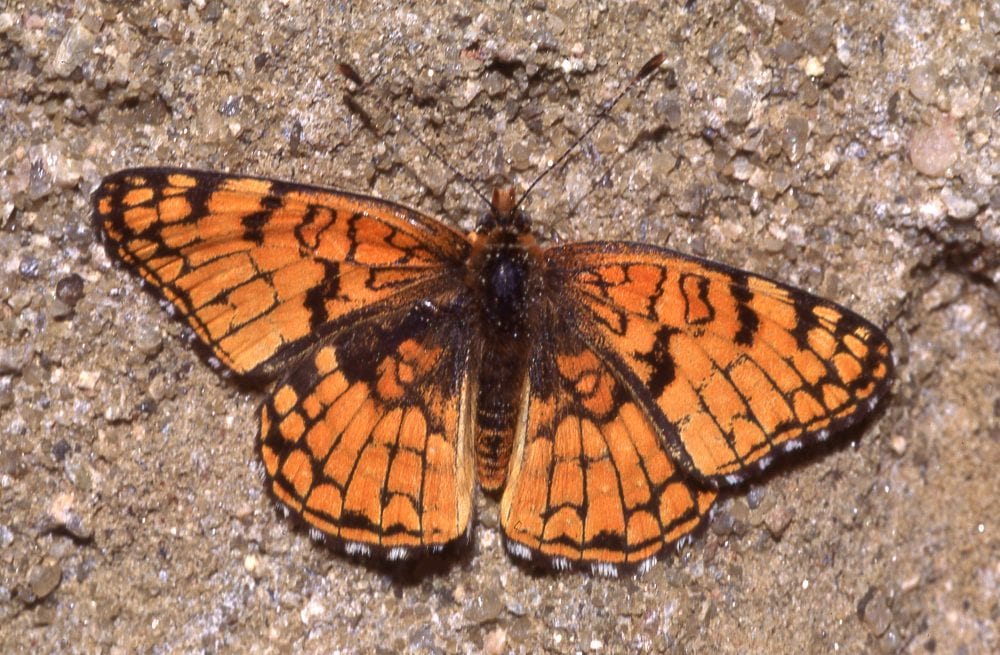
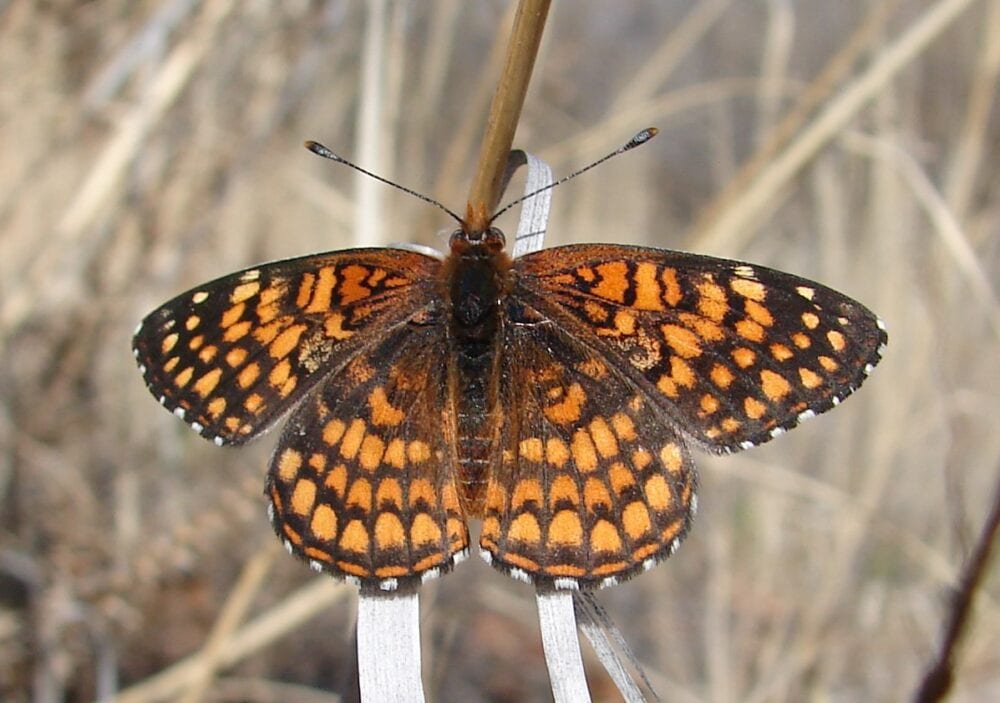
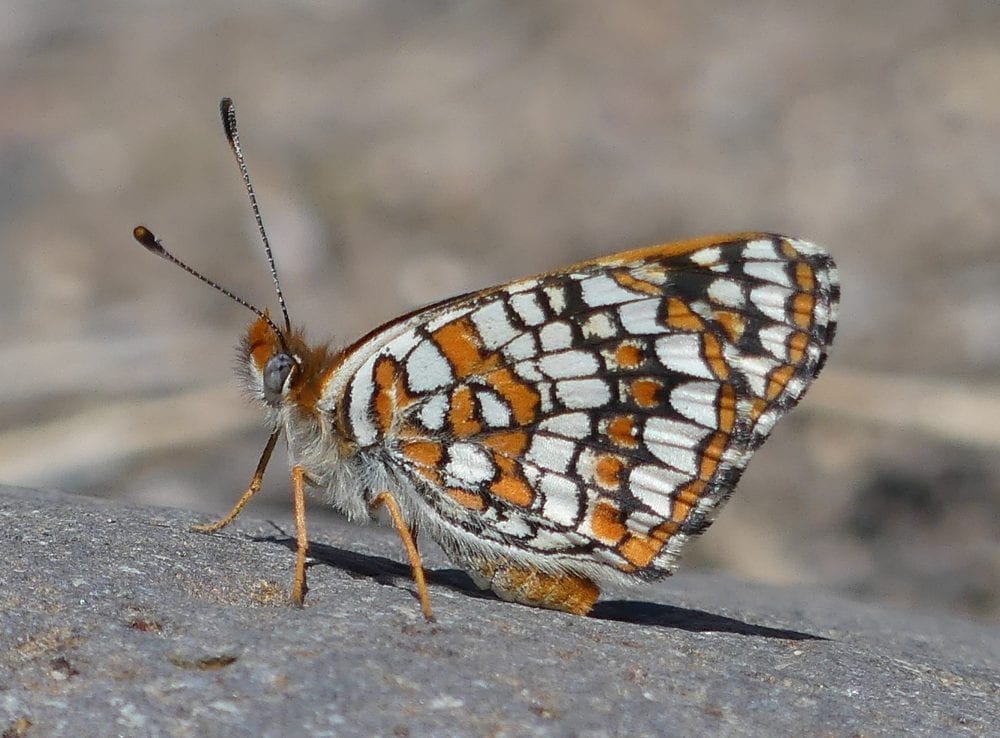
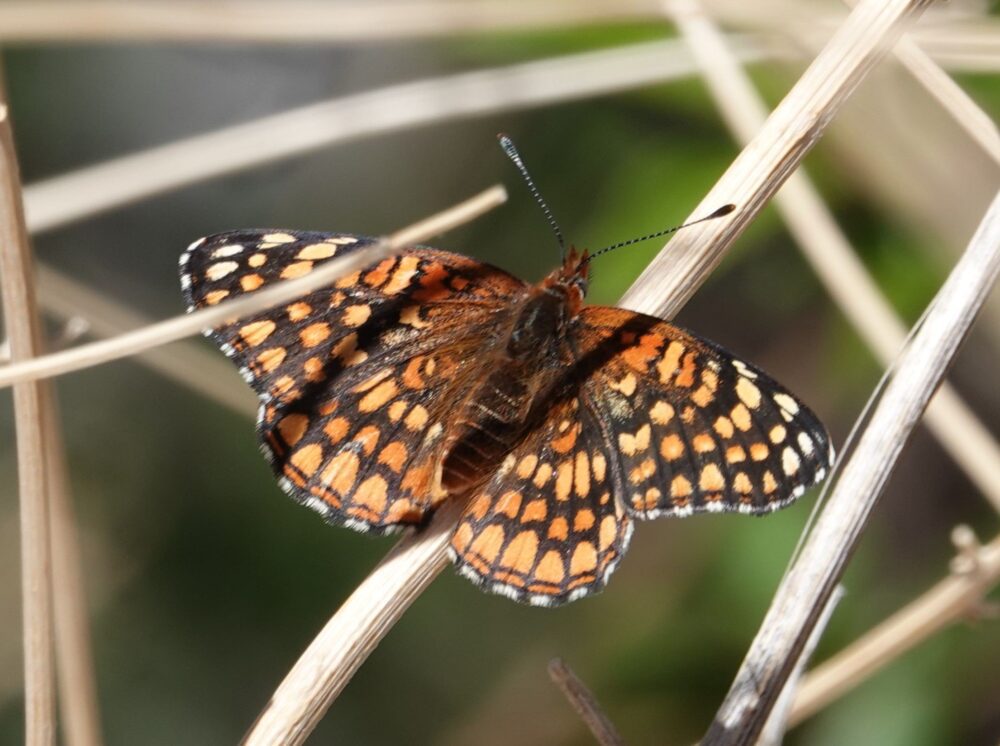
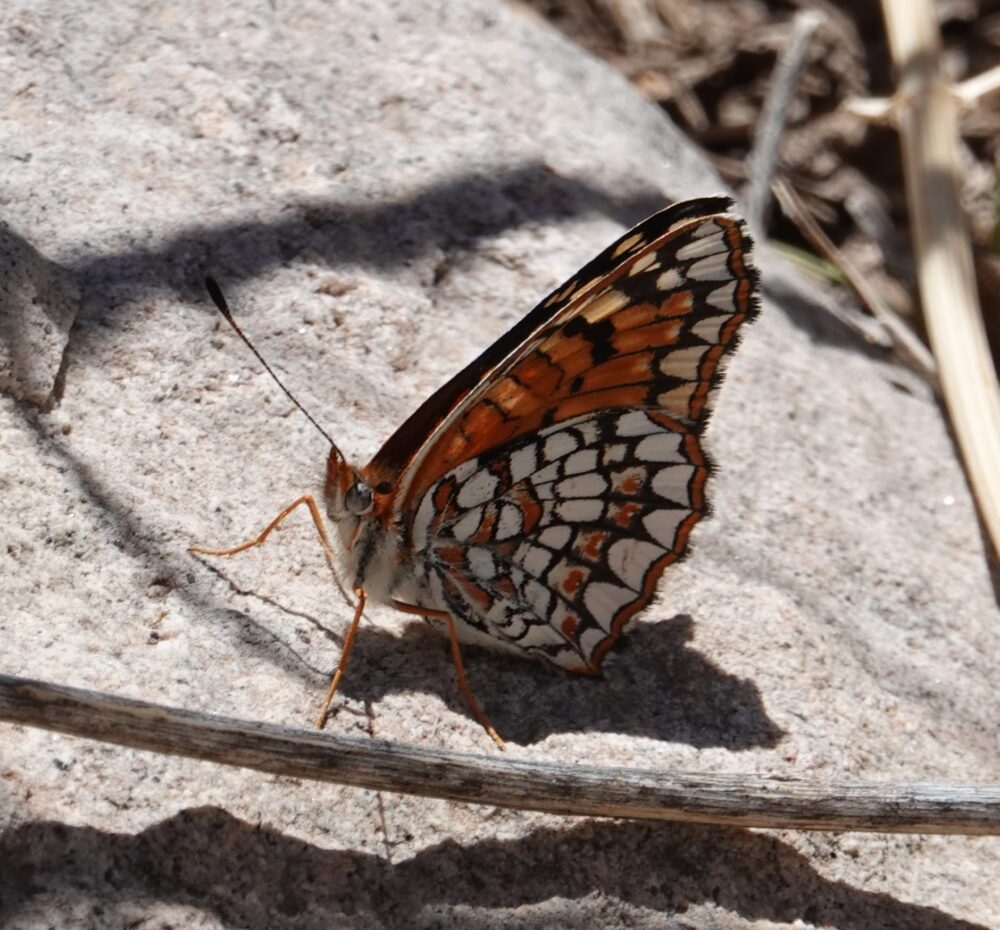

Chlosyne damoetas (Skinner, 1902) Rockslide Checkerspot (added July 24, 2024)
Description. Rockslide Checkerspot resembles Sagebrush and Yellow Checkerspots but may be distinguished from them by habitat and the “washed-out” appearance of both the upper- and undersides. The upperside is dark in comparison to the other two species, likely as a result of evolution to increase heat absorption in the Rockslide’s arctic-alpine environment. The bands on the underside of the hind wing are somewhat intermediate in appearance between the Sagebrush and Yellow Checkerspots. Range and Habitat. Rockslide Checkerspots are found from southern Canada (Alberta and British Columbia) to southern Colorado in the Rockies. As the name indicates, this species lives on talus and rockslides near or above timberline. Life History. Larvae feed on alpine members of the Asteraceae family, including Fleabanes (Erigeron) and Goldenrod (Solidago) species. Flight. There is a single brood; adults fly in July and August. Comments. Recorded from Costilla County, Colorado, just north of NM. Investigations around State Line Peak and other high mountains in northern Taos County should result in observations of this species. If you find the Magdalena Alpine, look around for the Rockslide Checkerspot.
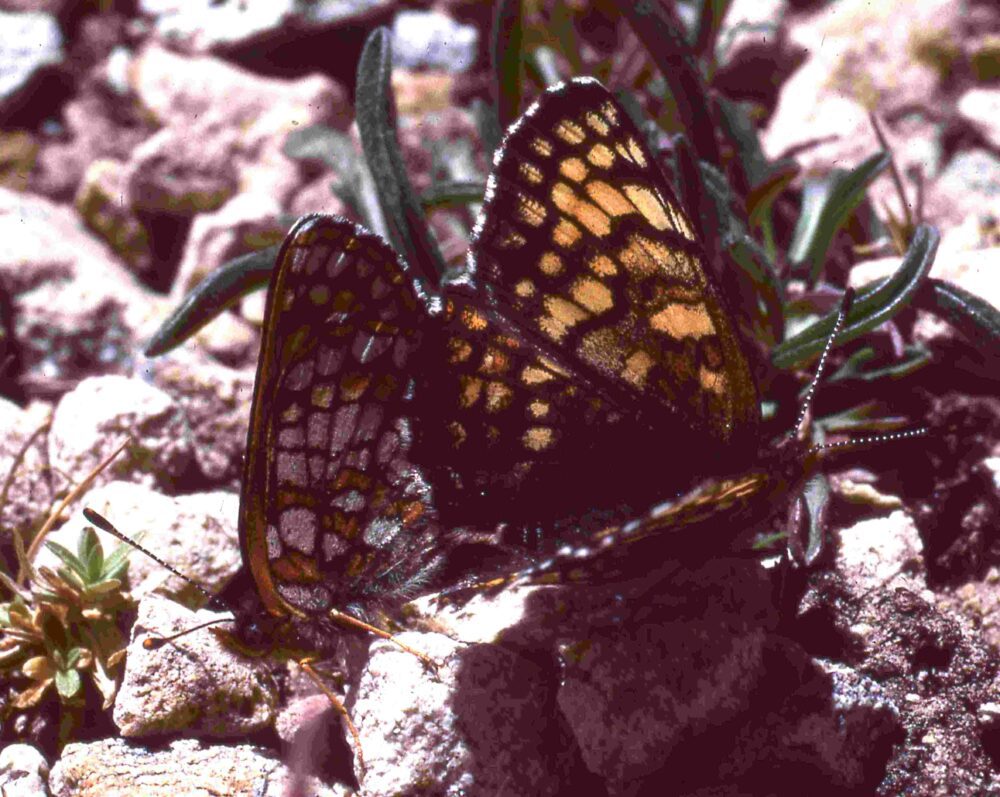
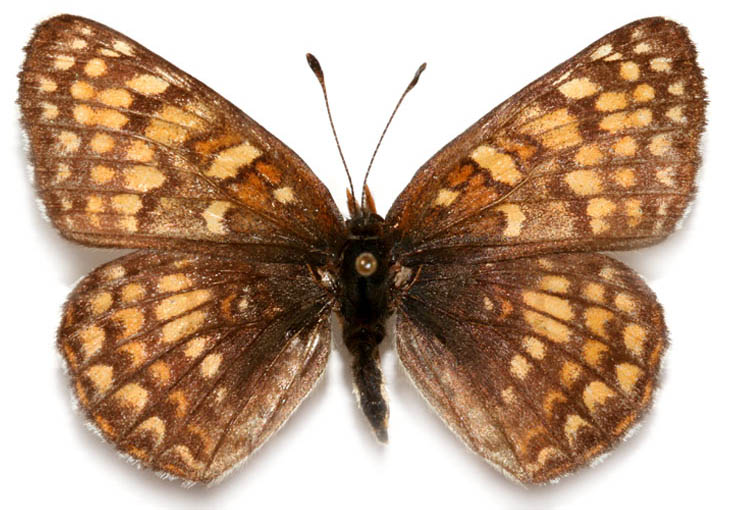
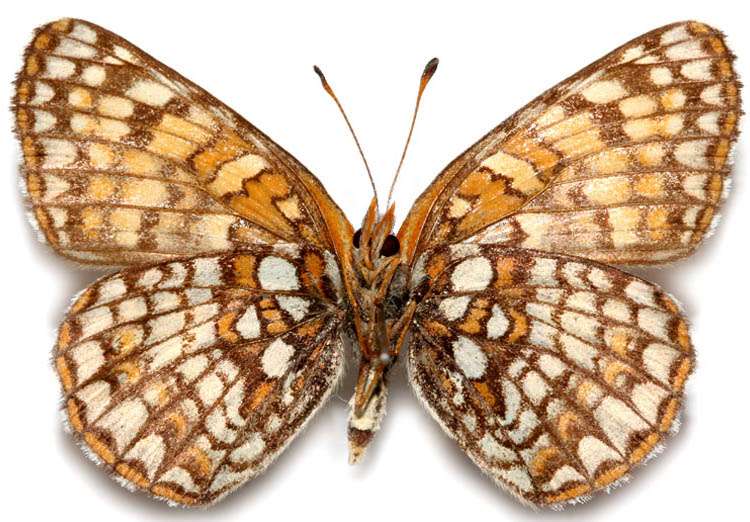
Chlosyne flavula (W. Barnes & McDunnough, 1918) Yellowish Checkerspot (added July 25, 2024)
Description. Yellowish Checkerspot is very similar to Sagebrush Checkerspot, but the underside of the hind wing has creamy or pale yellow bands instead of white. The upperside closely resembles Sagebrush Checkerspot with similar orange background and dark grid marks but tends to be slightly darker. Range and Habitat. Yellowish Checkerspot is found in the central Rockies, from Montana to Colorado and Utah. Not yet found in New Mexico, but its range closely approaches our NW border. The most likely subspecies to be found in New Mexico (typical flavula) should be looked for in sagebrush flats and meadows in the northwest corner (RA,SJ) of the state, often along streams, from 6,000’ – 8,000’. Life History. Larvae feed on various genera in the Asteraceae, including Goldenrod and Rabbitbrush. Flight. There is one brood, with adults flying from May – August. Comments. There are several records from the southwestern counties of Colorado (Montezuma, La Plata, Archuleta), some within 35 miles of the New Mexico border. Yellowish was recently raised to a full species by Zhang et al. (2023); prior to that (and currently, for some authors) it was considered a subspecies of Chlosyne palla (Boisduval, 1852). We might have two subspecies, but the most likely one is the typical one (type locality: Glenwood Springs, Colorado, on the western slope of the Rockies).
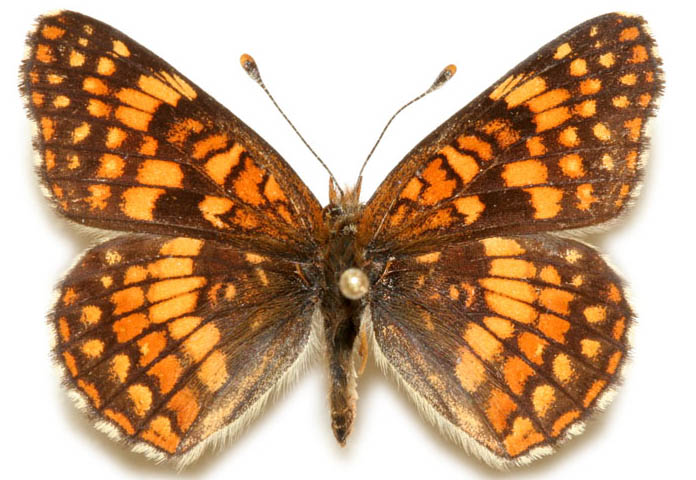
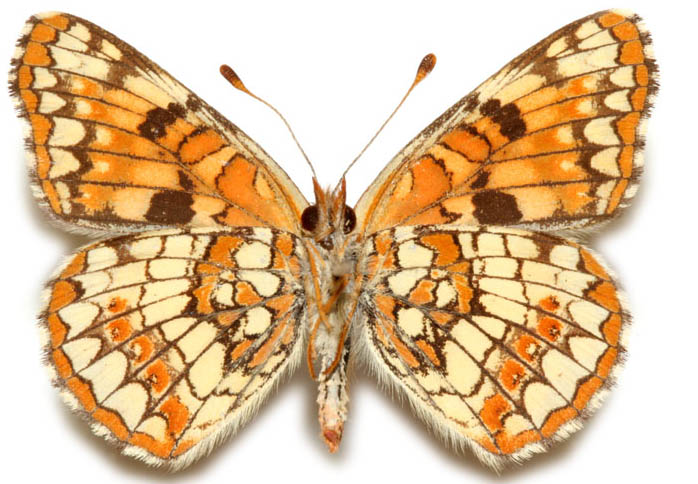
Microtia elvira Grishin 2023 Elfoid Checkerspot (added November 8, 2023)
Description. This tiny species, recently separated from the Elf (Microtia elva H. Bates 1864), is distinguished from that latter species by the color of the legs (yellow or yellow-orange tibia in elvira, black in elva). The transverse orangish bar on the black forewing is narrower and bent on elvira, broader and straight on elva. As is usual in checkerspots, individual variation can complicate identification, but elva is apparently only found in S. TX in the US. Range and habitat. The Elfoid is currently known from SE AZ and western Mexico. There are AZ records from the AZ side of Guadalupe Canyon and, given the northward march of this species (formerly very rare in SE AZ, now can be common in certain localities), it is only a matter of time before it is found in Hidalgo County, NM. Life history. Larvae eat Tetramerium nervosum (Acanthaceae) in SE AZ (Bailowitz & Brock 2021). Flight. Adults fly mainly from July to November in SE AZ, with some records from the spring. Comments. Currently unreported from NM, but observers should check the ‘Bootheel’ region in NM for this species, especially Guadalupe Canyon. Add NM state record from 2024!!



Microtia dymas (W. H. Edwards 1877) Tiny Checkerspot (updated November 8, 2023)
Description. Tiny Checkerspot is one of three very small checkerspots in our fauna; each is orange above with black maculation. On the hindwing underside of Microtia dymas, orange and white bands appear to fit comfortably; the outermost, marginal band is white, usually. The final photo below shows that, in both subspecies, some individuals have an irregular sliver of orange between the VHW band of bulbous white submarginal spots and the margin. By “irregular” we mean it is not of consistent width along its entire length. Glassberg (2017) points out another useful character: on the top side of the abdominal segments, black scales encircle some orange scales. Range and Habitat. Tiny Checkerspots are breeding residents from Mexico north to California, Arizona, New Mexico and Texas. They inhabit Lower Sonoran Zone scrubby canyons and flats. In New Mexico, Tiny inhabits our southern deserts (counties: Ca,DA,Ed,Gr,Hi,Lu,Ot,Si,So,Va), usually below 5500′ elevation, but occasionally over 9700′ in recent years. Life History. Larval hosts are Acanthaceae, includingTetramerium hispidum, Justicia longii and J. californica in southeast Arizona (Bailowitz and Brock 2021). Scott (1986) listed use of Beloperone californica and Siphonoglossa pilosella. Flight. Two annual broods are apparent; adults fly from April 1 to October 13 with peak numbers from April to May and again from July to August. Microtia dymas flutters weakly to nectar at flowers on the bottoms of desert canyons and washes. Comments. The range of nominate Microtia dymas dymas extends from Texas into southeastern New Mexico while the range of subspecies Microtia dymas chara (W. H. Edwards [1884]) extends from Arizona into southwestern New Mexico. The latter form has a more prominent white postmedian patch on the forewing above. Along the Rio Grande both forms seem to occur, along with intermediates. Zhang et al. (2021) provided substantial genomic evidence to synonymize the genus Dymasia Higgins 1959 (which formerly contained dymas) and the genus Texola Higgins 1960 (which contained the following two species) with the genus Microtia H. Bates 1864. BOA adopted that change as of December 2022.
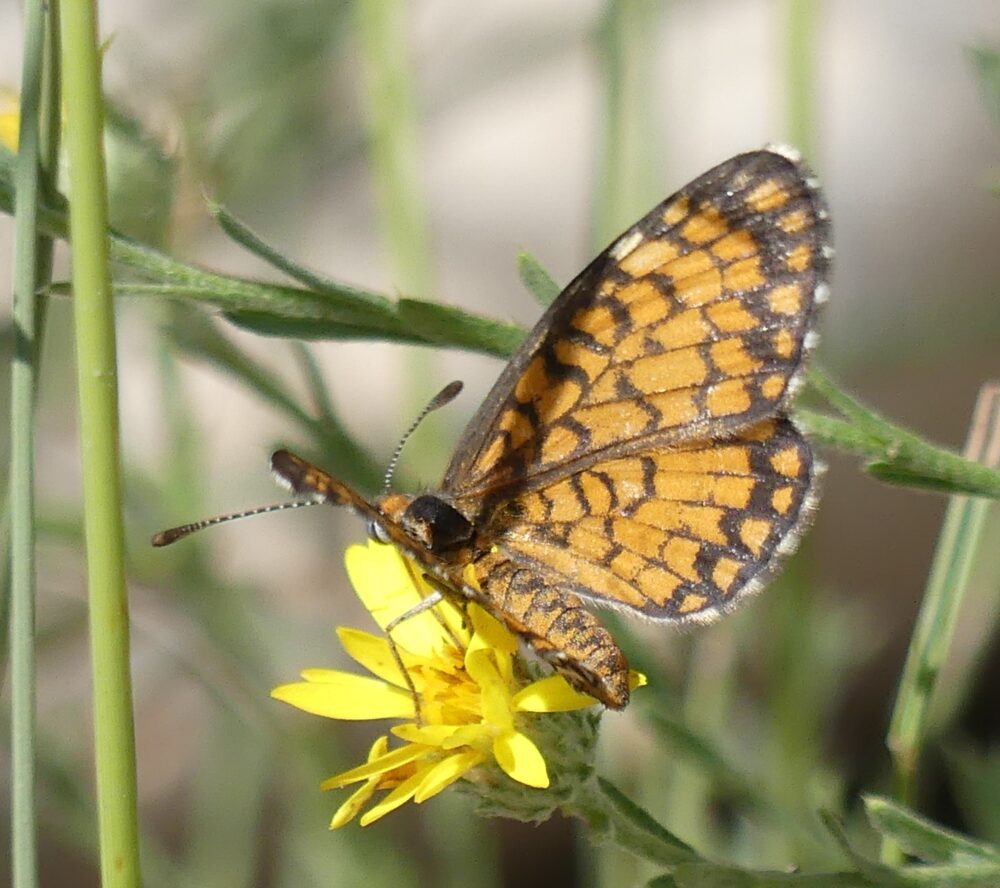
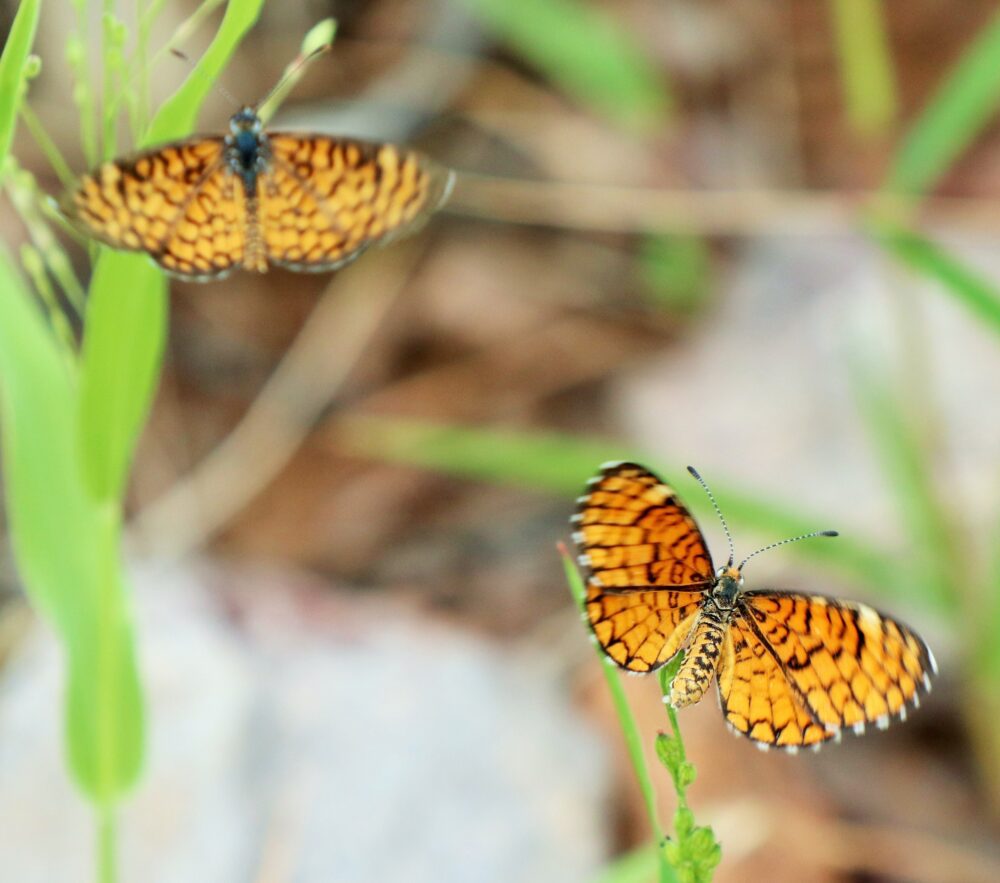
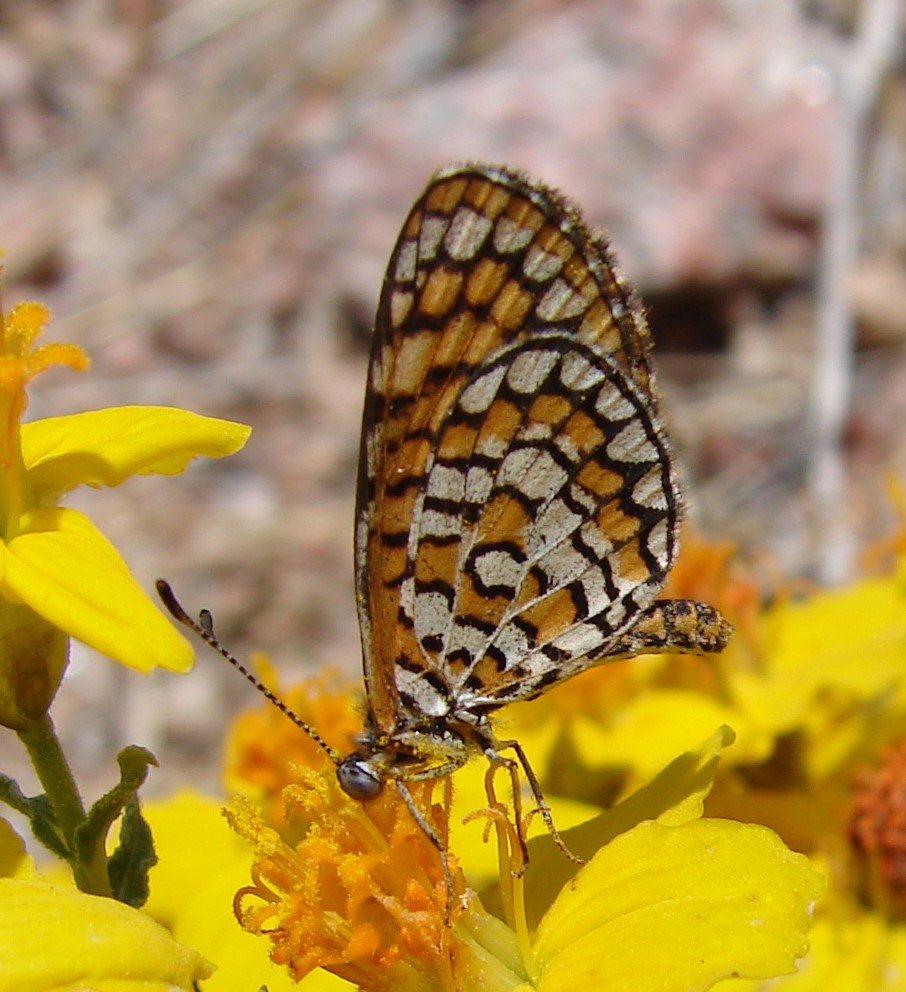
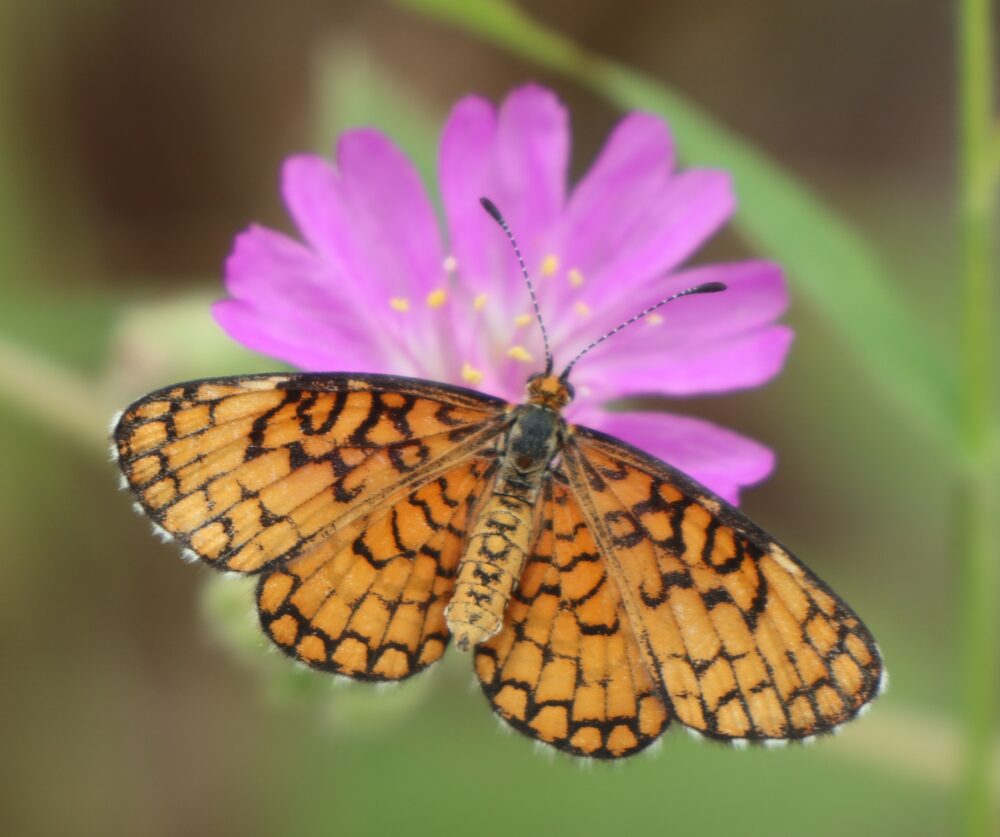
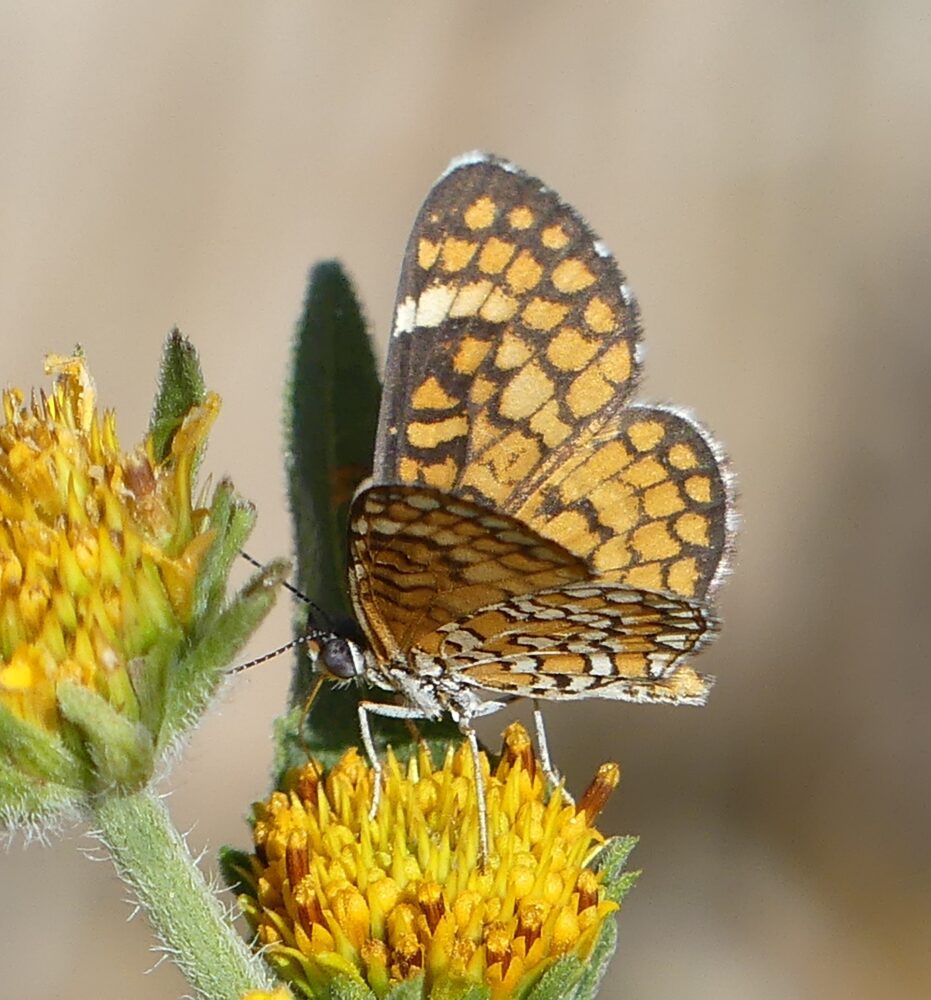
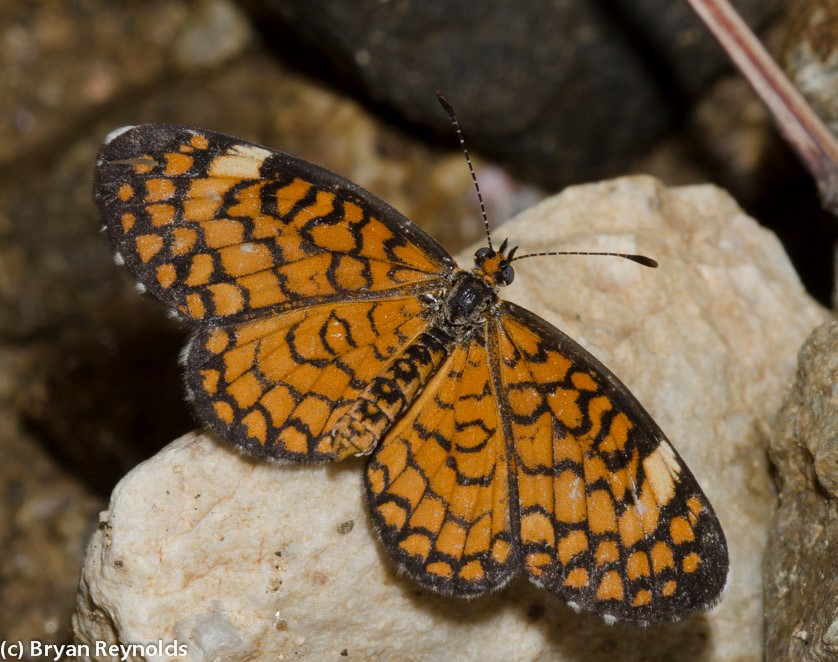
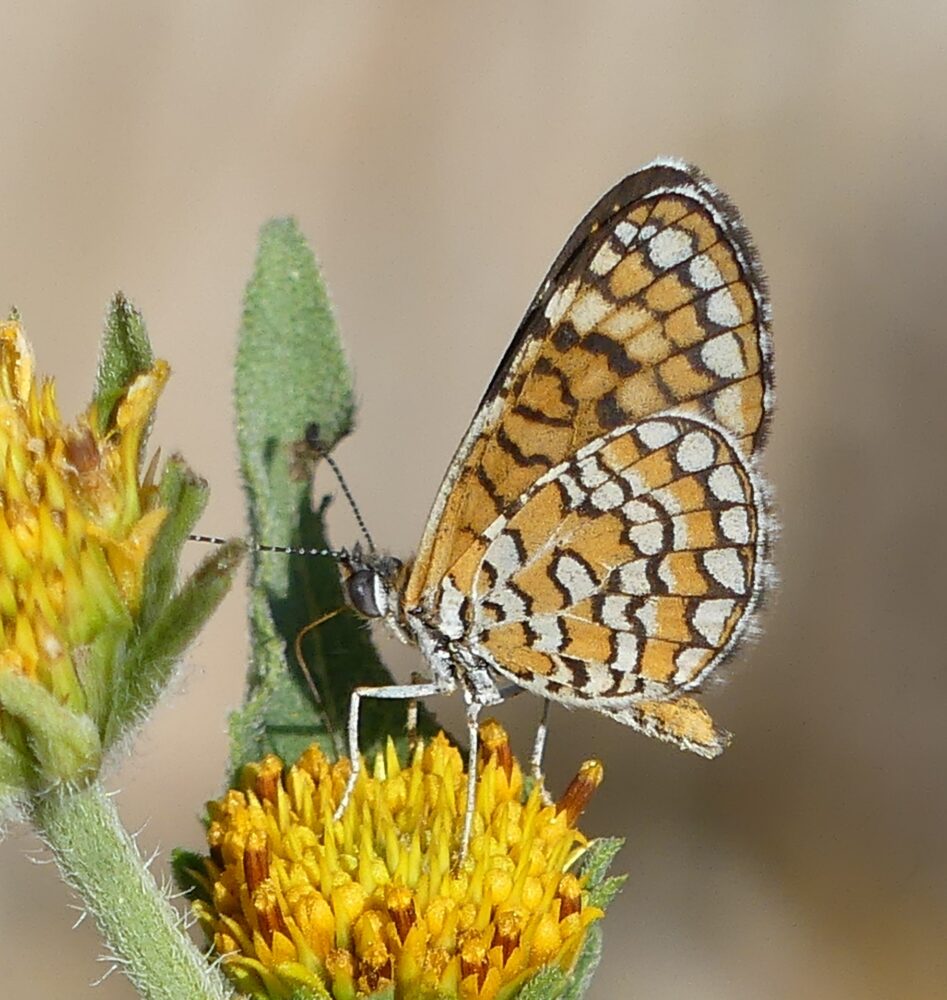

Microtia elada (Hewitson 1868) Elada Checkerspot (updated December 3, 2022)
Description. Elada Checkerspot is even smaller than Tiny Checkerspot. Underneath, the ventral hindwing orange and white banding appears as if it has been squeezed into a too-small space. That’s because it has an extra band: the marginal band is orange rather than white as in Microtia dymas. On topsides of abdominal segments, black scales do not encircle orange scales. Range and Habitat. Elada occupies most of Mexico and extends north into Texas and southeast New Mexico, where it inhabits our warmest life zone, Lower Sonoran. Within that zone it inhabits the lowest elevation canyon bottoms and arroyo bottoms. In New Mexico look for it below 5000′ elevation in the southeast (counties: DA,Ed,Ro). Life History. The Acanthaceae family provides larval hosts for Elada. Host plant candidates include Siphonoglossa pilosella (Scott 1986). Flight. There appear to be two broods per year in southern New Mexico. Adult flight records span April 28 to September 28, with peaks in spring and late summer. Adults inhabit stands of thorny shrubs in desert canyons. They fly weakly, yet deliberately, seeking nectar and mates. Comments. We have the northernmost subspecies, Microtia elada ulrica (W. H. Edwards 1877).
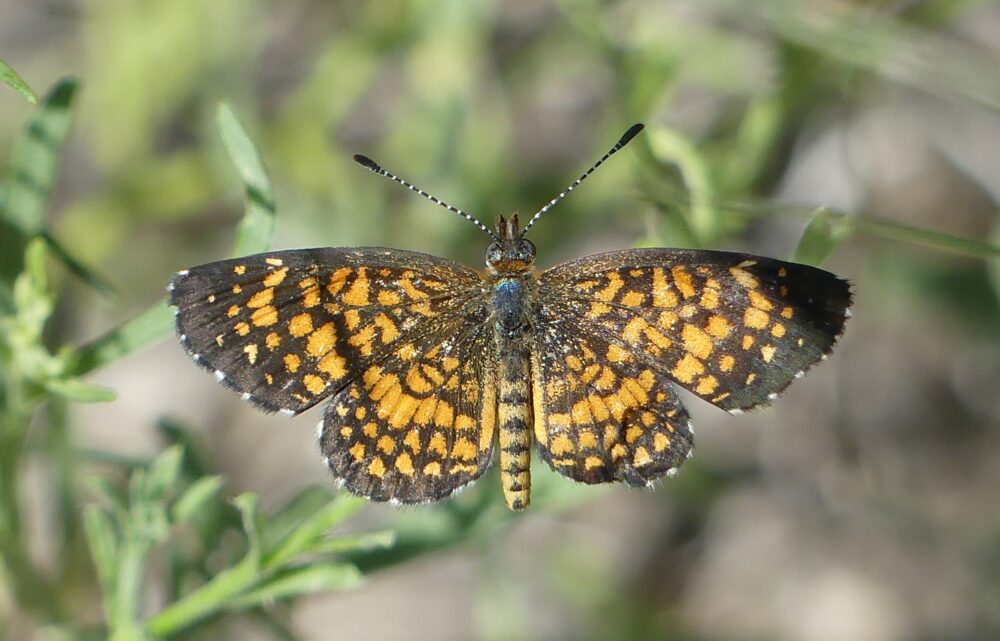
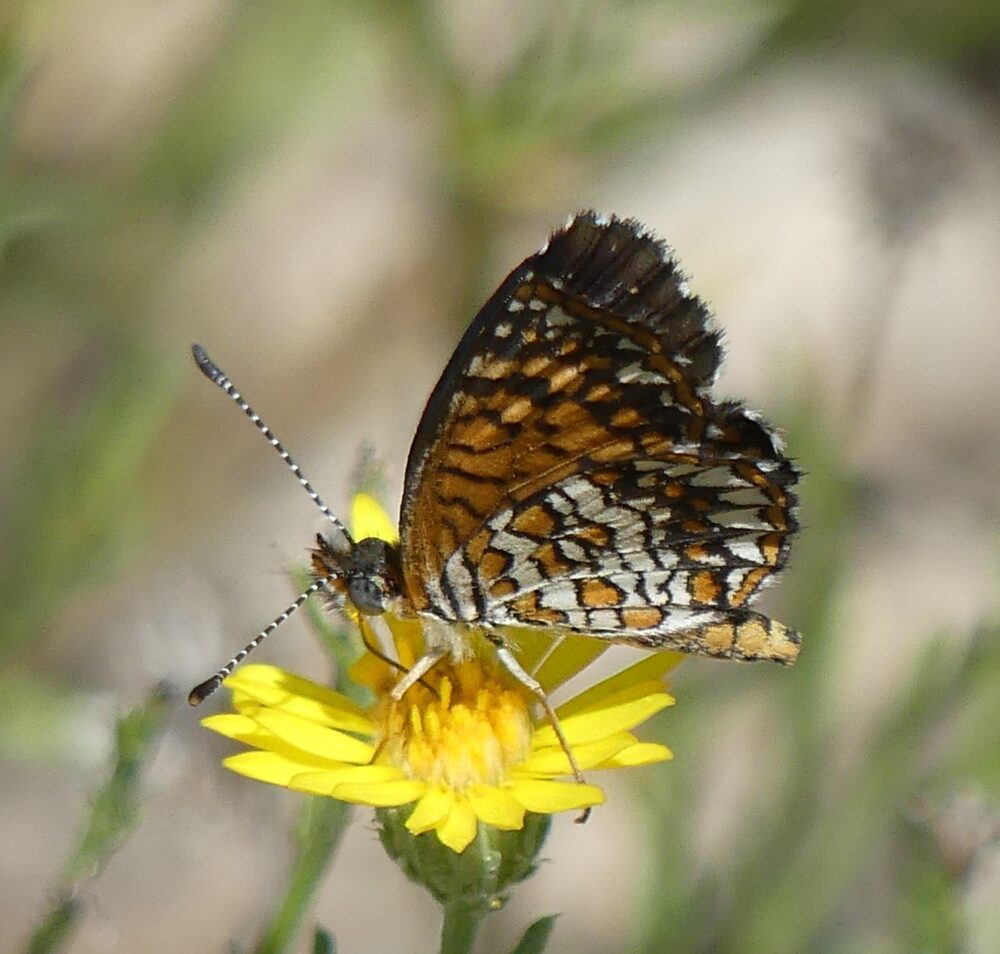
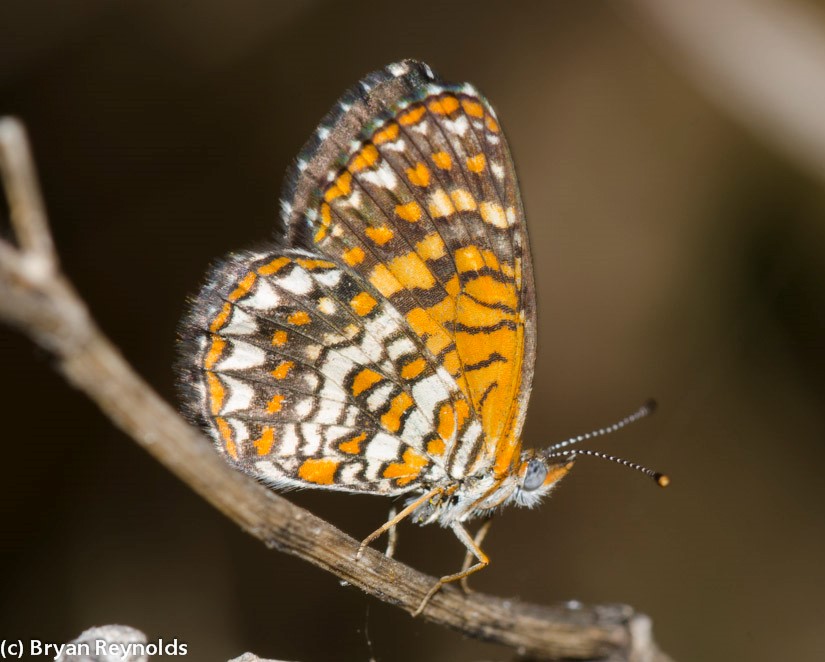
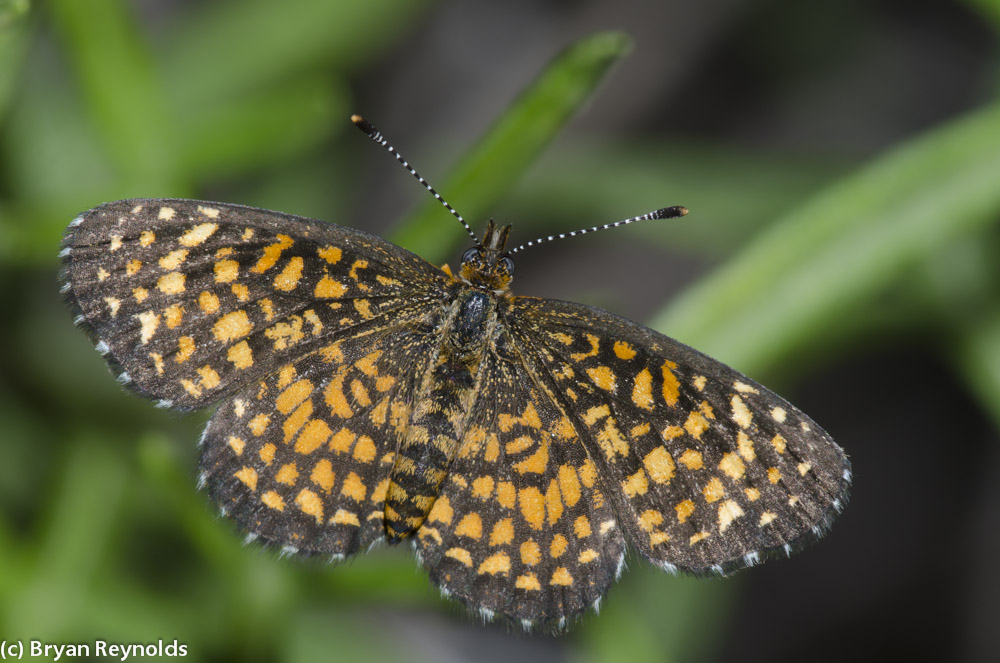

Microtia perse (W. H. Edwards 1882) Perse Checkerspot (updated August 23, 2024)
Description. Perse Checkerspot is a dead ringer for Elada Checkerspot. Underneath, the ventral hindwing orange and white banding appears as if it has been squeezed into a too-small space. The marginal band is orange and of relatively uniform width throughout. Currently, it seems the only way to separate Perse from Elada is by locality: in NM, anything west of the Rio Grande Valley is likely to be Perse, while individuals from the Rio Grande and eastward are likely to be Elada. Range and Habitat. Perse occupies most of Mexico and extends north into Arizona and southwest New Mexico. It inhabits low elevation arroyos and canyons in Lower Sonoran Zone habitats. In New Mexico look for it below 5500′ elevation in our southwest corner (counties: Ca,Gr,Hi,Lu). Life History. Larval hosts are in the Acanthaceae and likely include Anisacanthus thurberi (Bailowitz and Brock 2021). Flight. There are two broods per year. Adult flight records span April 2 to October 11, with peaks in spring and late summer. Adults like stands of thorny shrubs in desert canyons. They fly weakly, yet patiently, seeking nectar and mates. Comments. Texola perse was treated as a subspecies of Texola elada until Pelham (2019) elevated it to full species status based on anticipated (not yet published) molecular DNA studies. Thus split, the very similar Perse and Elada Checkerspots occur across our southern tier of counties and it is not completely clear where one stops and the other begins. Perhaps they overlap?
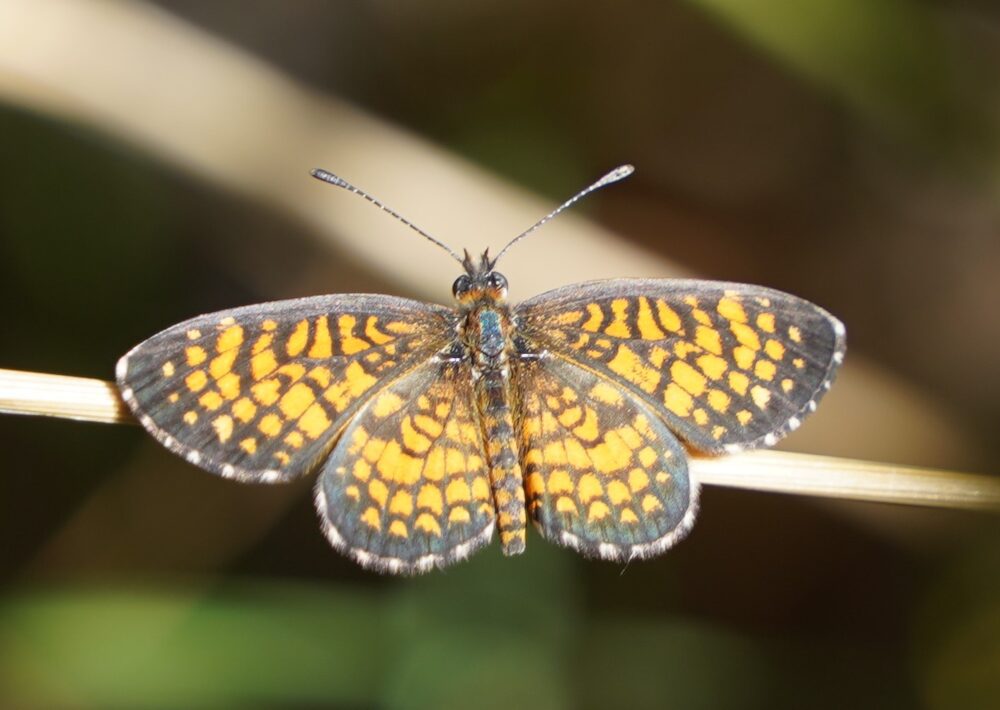

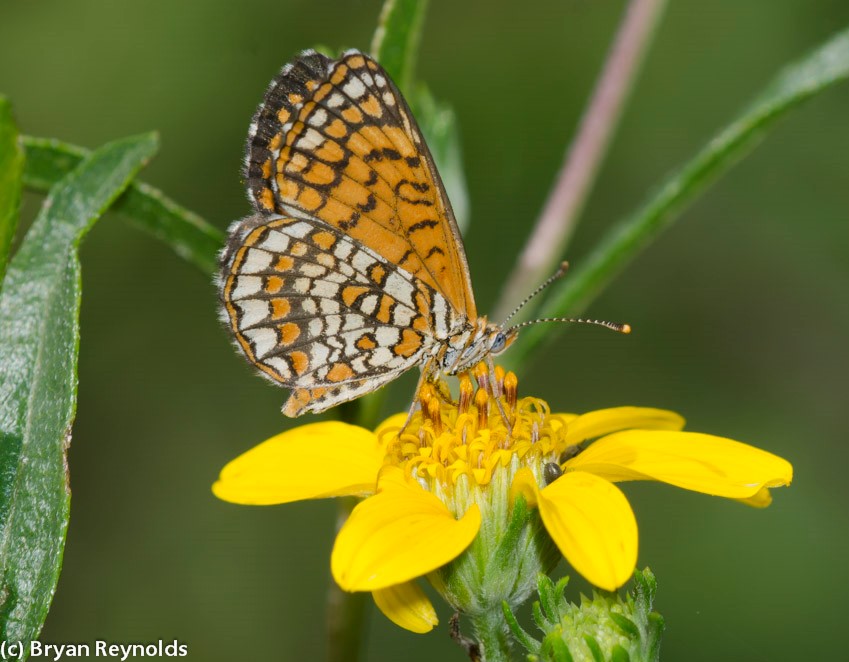
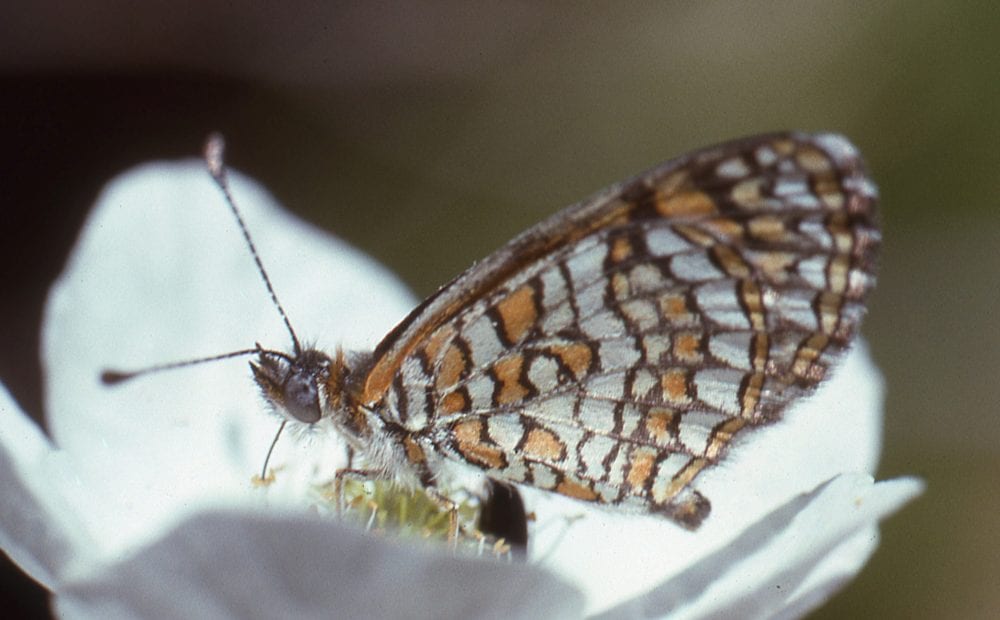

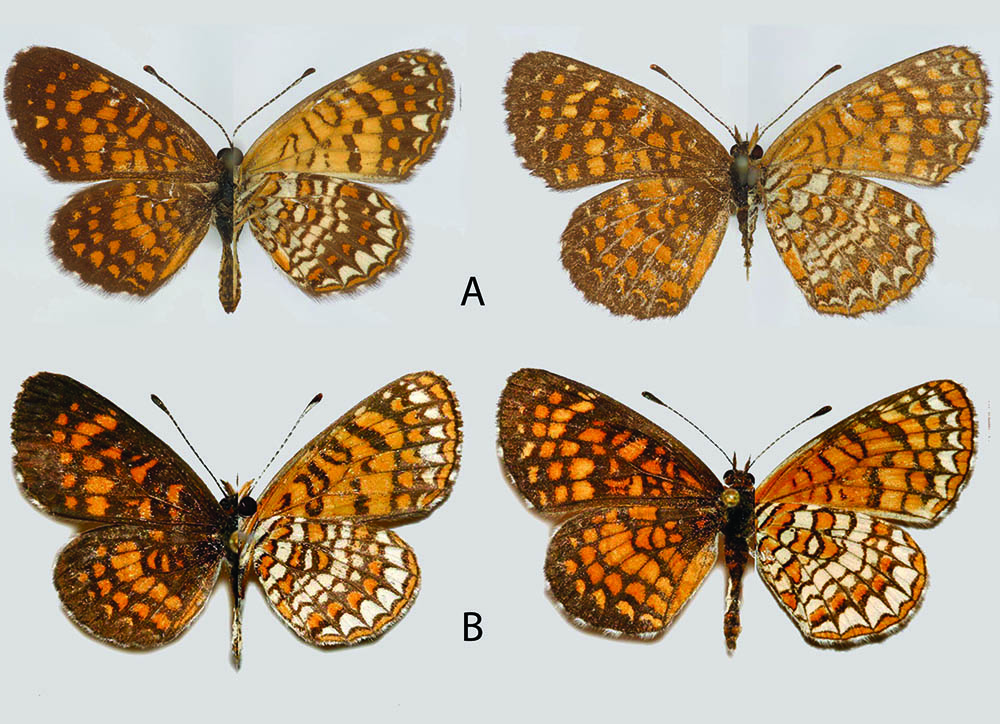
Anthanassa texana (W. H. Edwards 1863) Texan Crescent (updated November 10, 2023)
Description. Texas Crescent, though closely related to the various Phyciodes species, looks more like the Bordered Patch from above. It is relatively small and black with white postmedian bands on the hindwing. Dorsal wing bases are mottled black and dark red. Undersides are camouflaged. The forewing has a characteristic “bite” taken out of the margin. Range and Habitat. Anthanassa texana occurs from Central America to the southern US, stretching coast to coast from California to the Carolinas. In New Mexico it is mostly found along watercourses in the south and below 6000’ elevation, but it does stray farther north with some regularity (counties: Be,Ca,Ch,Co,DB,DA,Ed,Gr,Hi,Li,Lu,Ot,Qu,Ro,Sv,SM,SF,Si,So,To). Life History. Acanthaceae serve as larval hosts for this butterfly. Reported hosts include Dicliptera resupinata (Bailowitz and Brock 2021), Dicliptera. brachiata, Jacobinia carnea and Ruellia carolinensis (Scott 1986). Greg Forbes has suggested it may use Aster spinosus (Asteraceae) in Las Cruces. Flight. Peak adult numbers in April to May and again in September suggest that Texas Crescent is bivoltine here, but strays can wander in anytime. Our records span March 6 to November 29. Adults patrol bottoms of moist desert canyons in search of nectar, moisture and mates. Comments. T. D. A. Cockerell first recorded Anthanassa texana in New Mexico on 20 April 1899 at Dripping Springs, 5600′, in the Organ Mountains (DA). Some authors treat Anthanassa as a subgenus within Phyciodes.
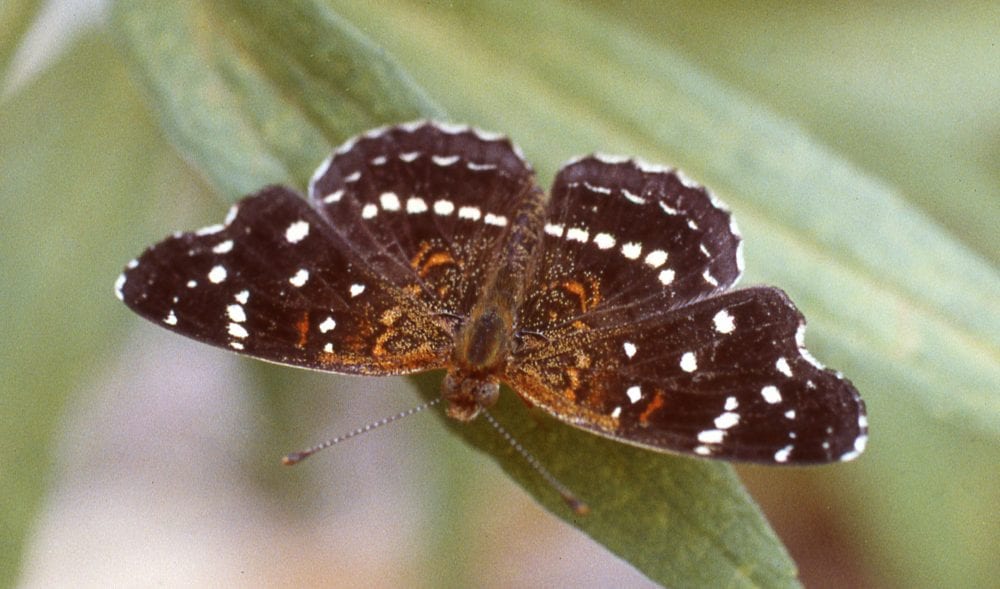
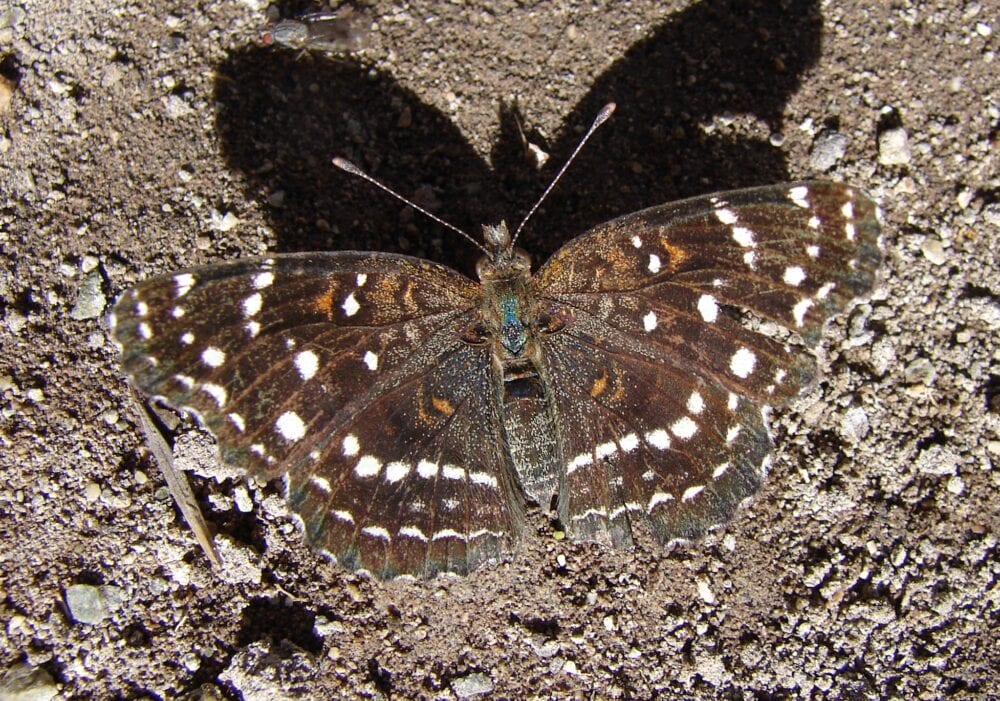
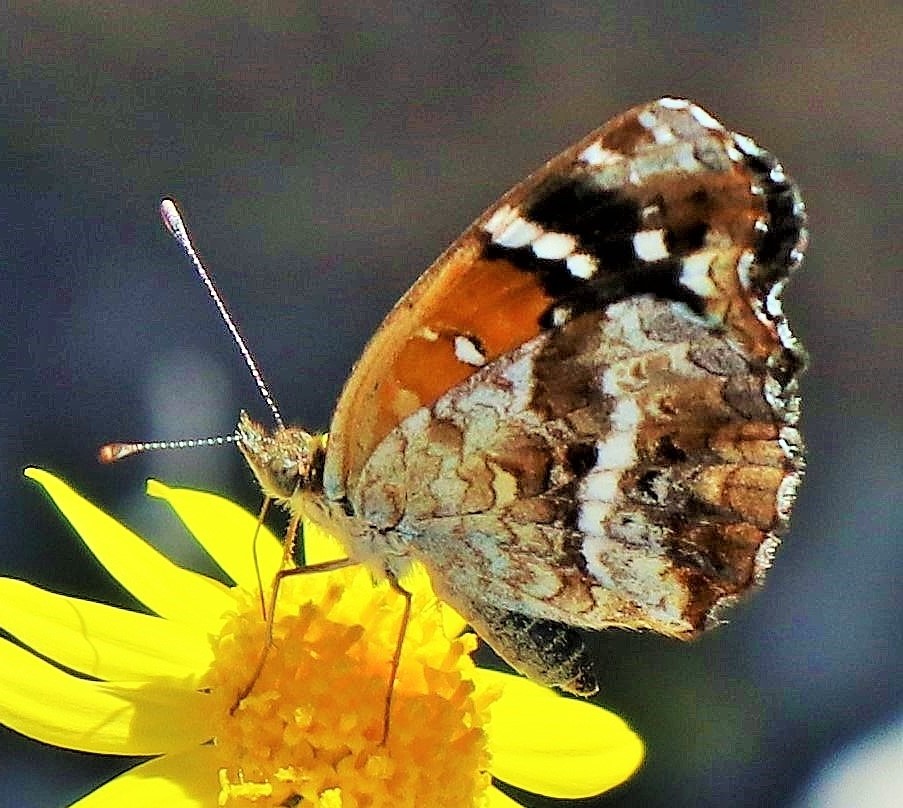

Anthanassa tulcis (H. Bates 1864) Pale-Banded Crescent (updated November 10, 2023)
Description. Pale-Banded resembles its “sister”, the Texas Crescent, but has a number of distinct characters. An obvious one is the upper hindwing, with a narrow median pale yellow band (which is an actual band, not a row of white spots as it is in Texas Crescent in NM). The shape of the forewing is different, lacking the “bite” near the apex which is obvious in Texas Crescent. The forewing beneath is pale yellow near the base, not orange as it is in Texas. Separating Pale-Banded from Black Crescent is more difficult, but Black has the characteristic “bite” out of the forewing (like Texas) and has fewer yellow spots on the forewing. Range and habitat. The normal haunt of this butterfly is the tropics and subtropics, ranging from Argentina to Mexico. It strays north to SE AZ, S NM and TX (west and south). Life history. Larvae feed on plants in the Acanthus family, including Dicliptera (BAMONA, 2023). Flight. AZ records (including one from the AZ side of Guadalupe Canyon) range from Aug. – Nov. In S TX, records range from May – Nov. Comments. A specimen of Pale-Banded Crescent residing in the Snow Entomological Museum at the University of Kansas is labeled “Rincon, N. Mex.” and “July” (Cary and Holland 2002). Attached to it is another label identifying it Anthanassa ptolyca (H. W. Bates), or Black Crescent, but we think this is incorrect. The two are similar, but Black Crescent seems even less likely to have made its way to New Mexico (there are two records of the Black Crescent from extreme S TX). This Snow specimen seems to be a legitimate New Mexico record. In 1883, the Southern Pacific Railroad connected to the Atchison Topeka & Santa Fe Railroad, thus completing a southern transcontinental rail route. Eastern travelers bound for California rode AT&SF rails south to Rincon, in northern Doña Ana County, where they changed trains to roll west toward California. As a railroad hub where naturalists and collectors had time to kill before boarding their connecting trains, Rincon became a minor source of butterfly specimens of that era, though many lack data that are de rigueur today. Snow passed through Rincon twice in the summer of 1884 while travelling to and from Silver City, and again in later years when he collected in southern Arizona. Situated along the Rio Grande in southern New Mexico, Rincon is a likely place to expect summer vagrants moving north. This specimen may be the basis for the New Mexico report by W. J. Holland (1905) of Eresia punctata W. H. Edwards 1870, which has been synonymized with A. tulcis.

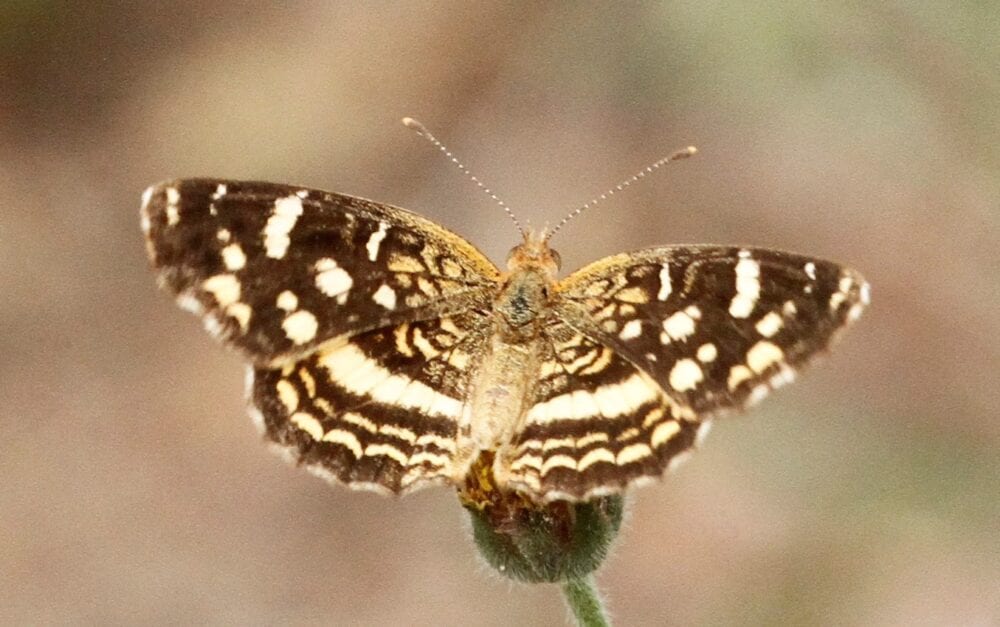

The Crescents (Phyciodes).
Crescents are named for the small, pearly, crescent-shaped spot at the ventral hindwing margin. This genus of about 16 species (in the US) still poses challenges to taxonomists and thus can be a real trial for observers. In New Mexico we think we have nine species, with a couple more species approaching our borders. Several of our resident crescents seem to be reasonably distinct and reasonably identifiable: Mylitta, Painted, Graphic, Jalapeno. The remaining five species (Pearl, Field, Northern, Anasazi and Great Plains) are all closely related, phenotypically similar, and the genetics are still being teased apart. Difficulties in identification arise from the rather recent and ongoing evolution of these species, which is resulting in inter-species hybrids in addition to the usual individual, geographic, sexual and seasonal variations. Realistically, we might informally deem this the Pearl Crescent (Phyciodes tharos) “complex” just as a matter of convenience.
Phyciodes tharos (Drury 1773) Pearl Crescent (updated November 11, 2023)
Description. Pearl Crescent is orange above with black marks arranged in a checkered pattern. Ventral colors are tawny with dark patches on the forewing; dark smudges surround the ventral hindwing pearly spot. Pearl Crescents have black, usually oval antenna tips, while the very similar P. orantain J. Scott 1998 has orange, usually elliptical antenna tips. Northern Crescents (Phyciodes cocyta (Cramer 1777)) can be indistinguishable from Pearls, though Pearl Crescents tend to have more black markings on the upper hindwings. Northern males tend to have orange antennal clubs, as opposed to the black of Pearls. Individual, sexual, and seasonal variation complicates matters even further. Observers may do well to call most members of this complex of species “tharos complex” rather than attempting to assign them to particular species. Range and Habitat. A ubiquitous resident of meadows and disturbed areas in eastern US, Phyciodes tharos is restricted to relatively low elevation and moist habitats in the Southwest. Here, it likes riparian sites (counties: Be,Ca,Ch,Co,DB,DA,Ed,Gr,Gu,Ha,Hi,LA,Lu,Mo,Ot,Qu,RA,Ro,Sv,SF,Si,So,To,Un,Va), traditionally below 6000′ elevation, but recent observations suggest it is colonizing higher sites up to 7000′. Life History. Larvae eat foliage of many composites (Asteraceae). Hosts in the west include Aster exilis, Aster praealtus, Aster texanus, Aster (Virgulus) ericoides and Aster hesperius. Winter is passed by hibernating larvae. Flight. Phyciodes tharos is multivoltine in New Mexico, flying March 8 to November 18, with maximum adult numbers in April, July and September. They fly near the ground and seek out nectar in weedy riparian areas. Comments. Recent research on DNA of “tharos” complex crescents has complicated our picture of which species occur where in NM. It was only a couple decades ago that Phyciodes tharos and Phyciodes cocyta were distinguished as two separate species. And now Zhang, et al. (2022) have used DNA to reassign or elevate populations which were formerly considered subspecies of other species. As we understand it today, NM “tharos” could be either true tharos, P. tharos riocolorado (SJ), P. orantain, P. cocyta selenis, P. cocyta apache, or P. anasazi. As stated by Zhang et al.: “Apparently, the tharos group
species are incipient, and they hybridize with a certain frequency, despite being mostly distinct.” Our maps reflect this uncertainty; using open circles in most cases to indicate our lack of understanding!


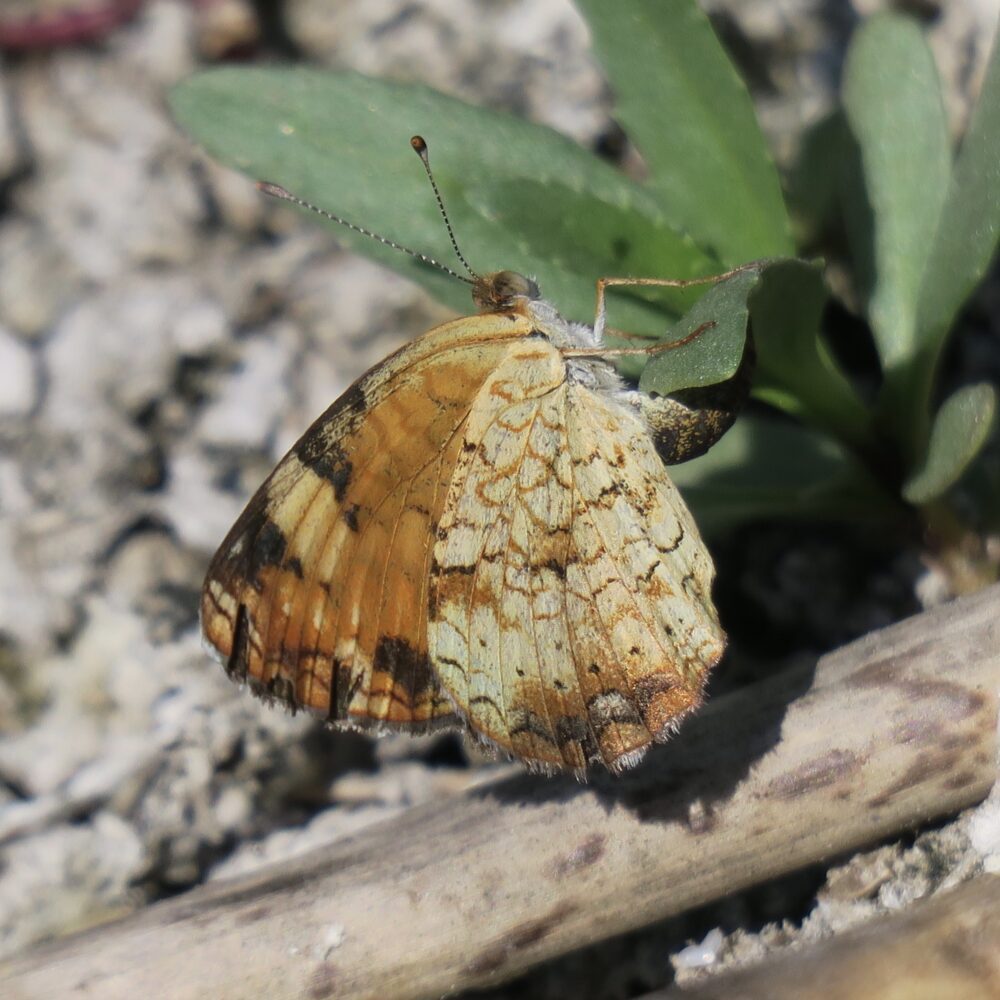
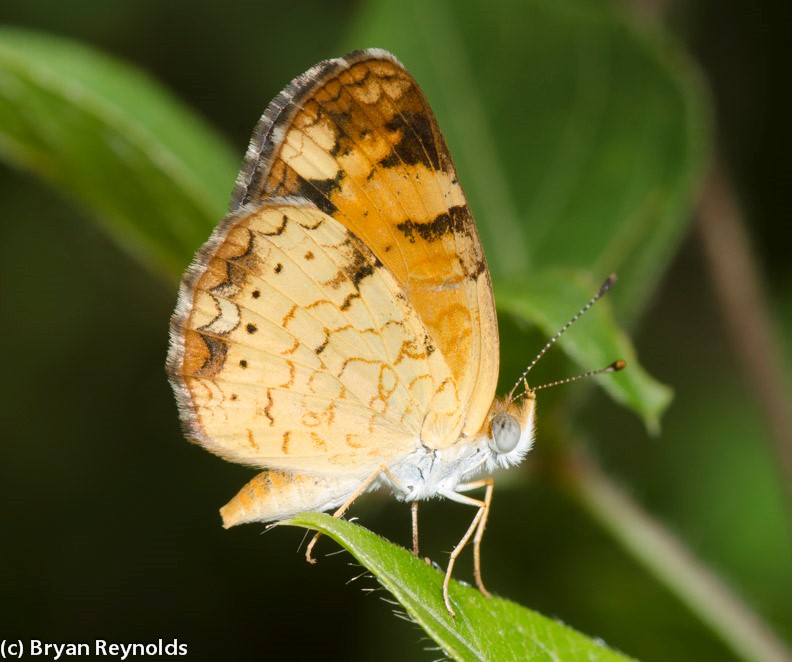

Phyciodes cocyta (Cramer 1777) Northern Crescent (updated November 11, 2023)
Description. Northern Crescent is very similar to Pearl Crescent, but upper surfaces have the median orange patches more intact and less interrupted by dark transverse lines. Females are quite dark. Because Northern Crescents frequently have orange antennae, they can also be difficult to separate from the Great Plains Crescent (P. orantain). Perhaps “tharos complex” will have to do for most observers! Range and Habitat. Northern Crescents occupy higher, colder habitats than Pearl Crescents. They live in Canada and the Great Lakes, in the Appalachians, and in the Rockies south to Arizona and New Mexico (counties: Ca,Co,Li,LA,Mo,Ot,RA,Sv,SJ,SM,SF,To,Ta,Un), usually between 7300 and 9200′ elevation. Life History. Composites (Asteraceae) are larval hosts. Scott (1986) listed Aster laevis, but others are likely, too. Larvae overwinter. Flight. Phyciodes cocyta completes one generation per year with adults about from May 12 to August 26. Adults visit meadow flowers. Voltinism and habitat can sometimes be used to separate Phyciodes cocyta from Phyciodes tharos. Comments. Subspecies Phyciodes cocyta selenis (W. Kirby) was mentioned by Scott (1998) in his revision of Phyciodes as coming from the mountains of Colfax, Rio Arriba, Sandoval, and Union Counties. Populations from the middle and western counties may be that subspecies or something else. The unique population in the Sacramento Mountains (Li,Ot) was recently described as Phyciodes cocyta apache J. Scott & Opler 2017.
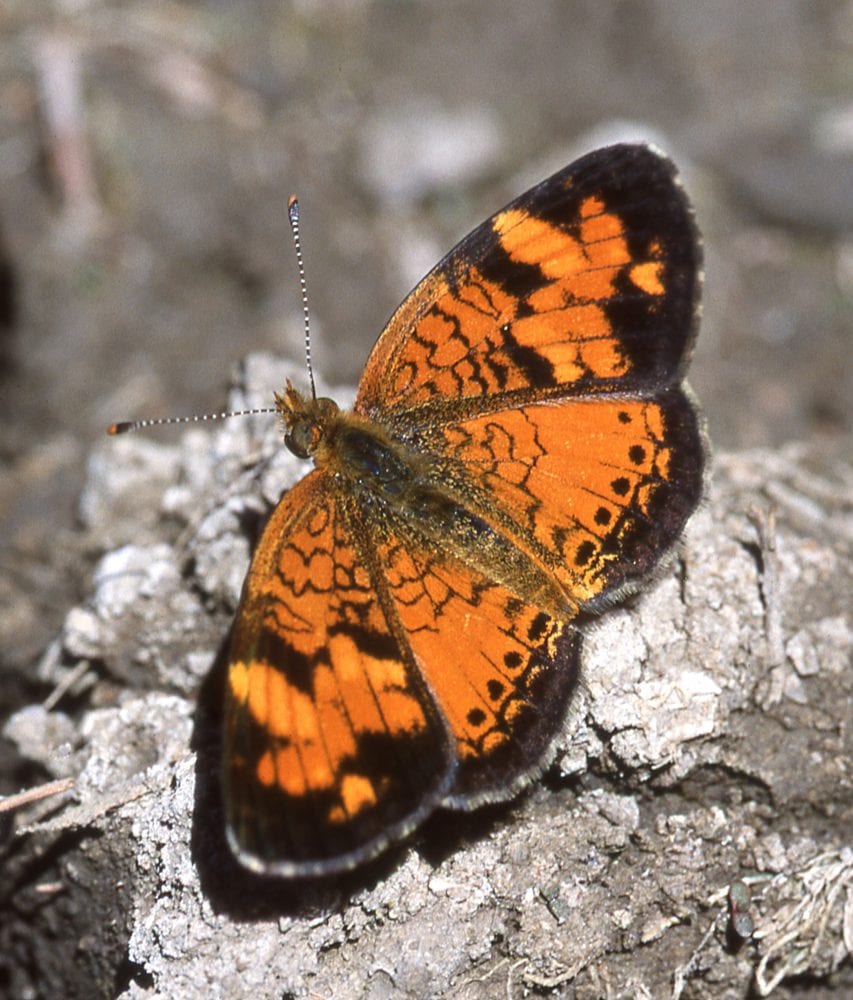
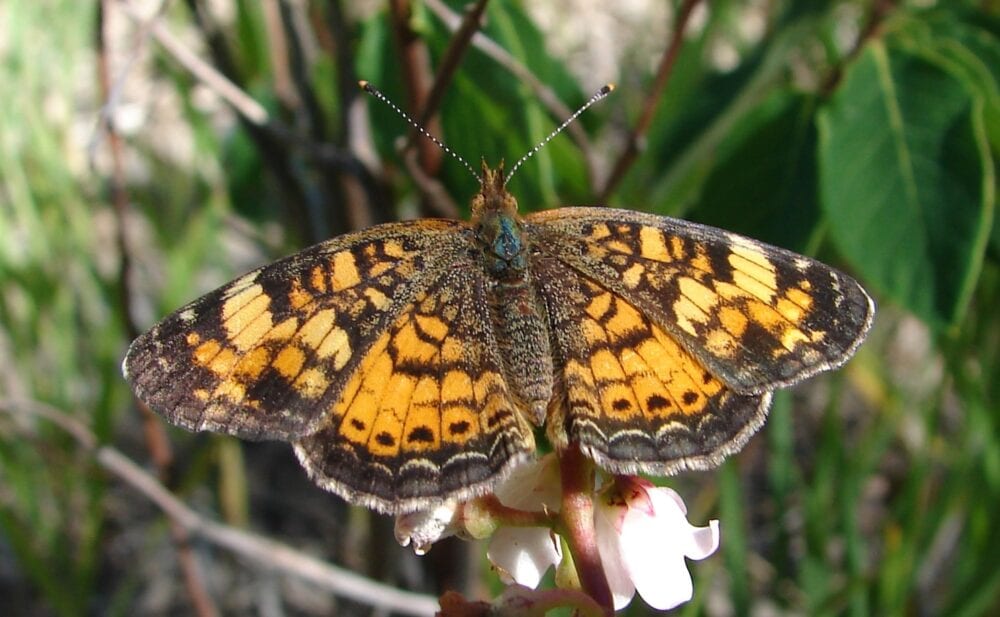
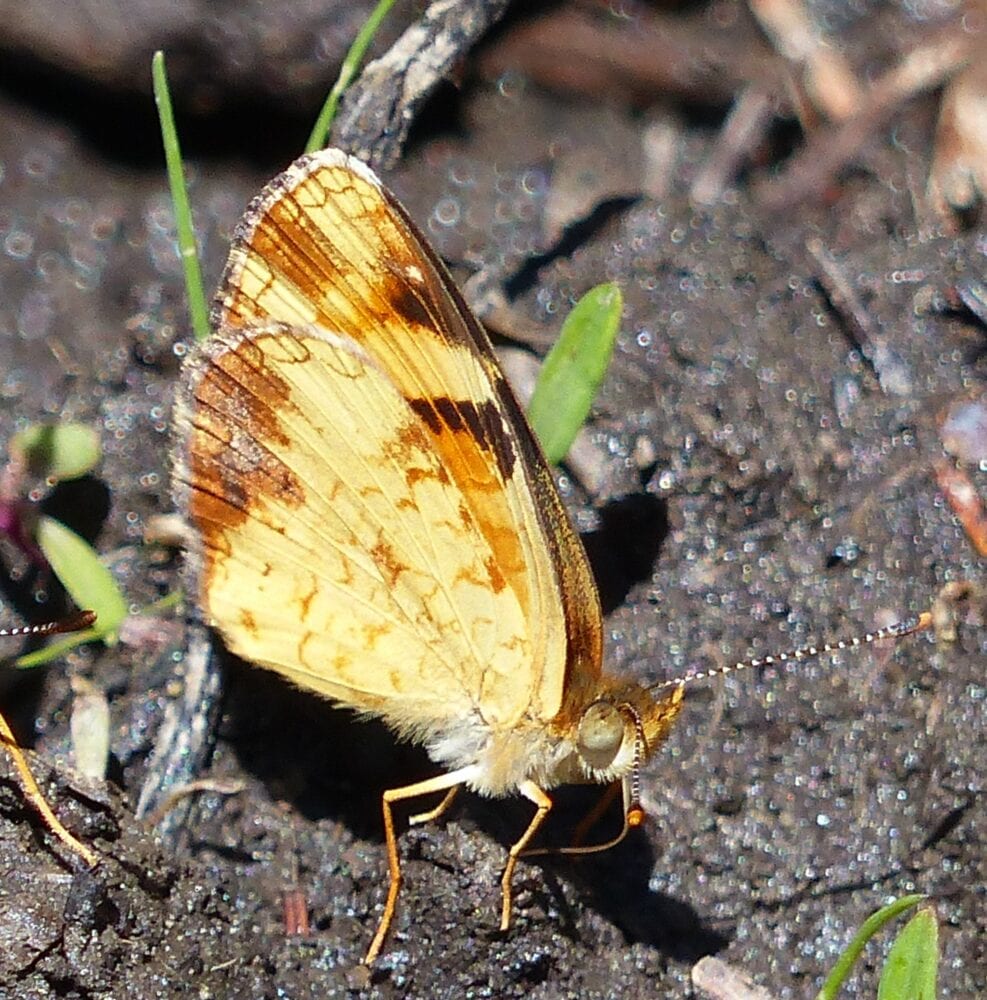
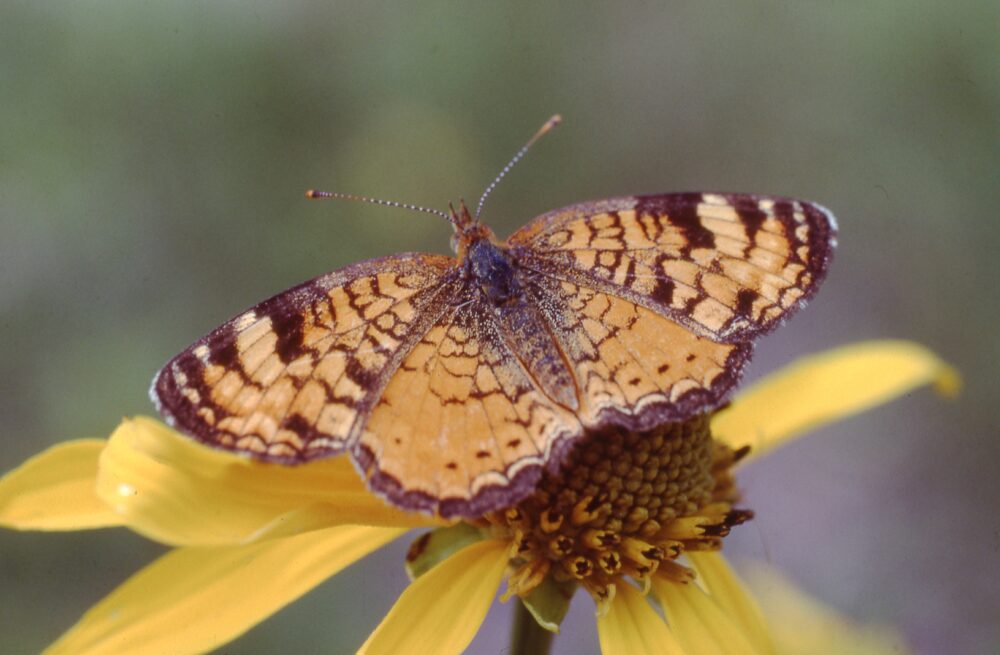


Phyciodes anasazi J. Scott 1994 Anasazi Crescent (added November 14, 2023)
Description. Anasazi Crescents resemble Pearl and Northern Crescents, but with more extensive dark marks above. The dorsal forewing of males has a yellowish postmedian band, making them two-toned orange similar to Field Crescent. On the hindwing below, the brown patch surrounding the crescent spot is washed out. It has orange antennal clubs. Range and Habitat. Phyciodes anasazi ranges from Idaho and Wyoming south to Arizona and New Mexico. In our state it appears to be limited to the Chuska Mountains (counties: SJ) within the Navajo Nation and straddling the Arizona border, where it is found in fields and open areas, 6500 to 9,000′ elevation. Life History. Hosts are Asteraceae, but specifics are unknown. Flight. Anasazi Crescent is univoltine with adults in June and July. Richard Holland’s records for the Chuskas fall between June 22 and July 23. Adults bask and fly about fields and shrubby savannas in search of nectar. Comments. Anasazi was elevated as distinct from Phyciodes batesi (Reakirt 1866) by DNA studies (Zhang, et al., 2022). That research showed Anasazi to be more closely related to Northern Crescent than to Bates’ Crescent, which was what we formerly suspected this was.


Phyciodes orantain J. Scott 1998 Great Plains Crescent (added November 15, 2023)
Description. The distinguishing feature of this butterfly is the orange “club” of the antennae. Otherwise, it most closely resembles the Northern Crescent (which may also have orange antennae) and the Pearl Crescent. Range and habitat. Scott (1998), in his original description of this species, speculated that it probably occurs in NE NM. So far, we know of no confirmed records, but its occurrence in nearby states (“Colorado, extreme western Okla., and probably NE New Mexico” – Scott 1998) argues that it will turn up in our state (Co,RA,Ta,Un). Life history. Scott (1994) described these (as an orange antenna variety of tharos) and listed Aster ascendens (=adscendens) as the probable host in the original description (1998). Flight. Three generations (May – September) in Colorado, which would be what we anticipate in NM. Comments. This was previously listed as a subspecies of tharos, although Scott (1998) in his original description noted that it might be a distinct species. That status was recently confirmed by genomic work (Zhang et al., 2022). As noted, we have no confirmed records for this species but expect it will be found when our NE plains are explored more thoroughly. It is possible that some specimens listed as Pearl or Northern are actually this species. The C. P. Gillette Museum at CSU has specimens collected by Scott from CO within 30 miles of NM; see map below.



Phyciodes pulchella (Boisduval 1852) Field Crescent (updated November 27, 2023)
Description. Field Crescent stands out from most other crescents because its uppersides are highlighted with offset black, orange and yellow bands. Wing fringes are checkered. The hindwing below comes in two versions: tawny and little-marked or alternating tan and white bands. There is usually a pale bar in the cell of the forewing underside. Adults sparkle when freshly emerged. Range and Habitat. This butterfly occurs through western North America from Alaska south to Mexico. In New Mexico it inhabits pine savannas, roadsides and fields, where it is one of our most common and widespread crescents (all counties except Ch,Cu,DB,Gu,Le,Lu,Qu,Ro), typically 6000 to 10,000′ elevation. Life History. Larval hosts are Asteraceae, of which Aster adscendens, Aster ericoides and Aster porteri are found in New Mexico. Larvae hibernate. Flight. Phyciodes pulchella is bivoltine here. Timing of the two generations is generally May to June and again August to September. All New Mexico records fall between April 5 to October 22. Adults bask and fly around fields and mountain meadows in search of nectar, especially fleabane. Comments. This butterfly was previously called Phyciodes campestris (Behr 1863) and/or Phyciodes pratensis (Behr 1863), until the review by Scott (1994). New Mexico populations are placed with subspecies Phyciodes pulchella camillus W. H. Edwards 1871. Scott (2006) described the Sacramento Mts. populations as a separate subspecies (sacramento – type locality 1 mi. E. of Cloudcroft) but later work by Scott and Opler (2017) synonymized it with camillus.
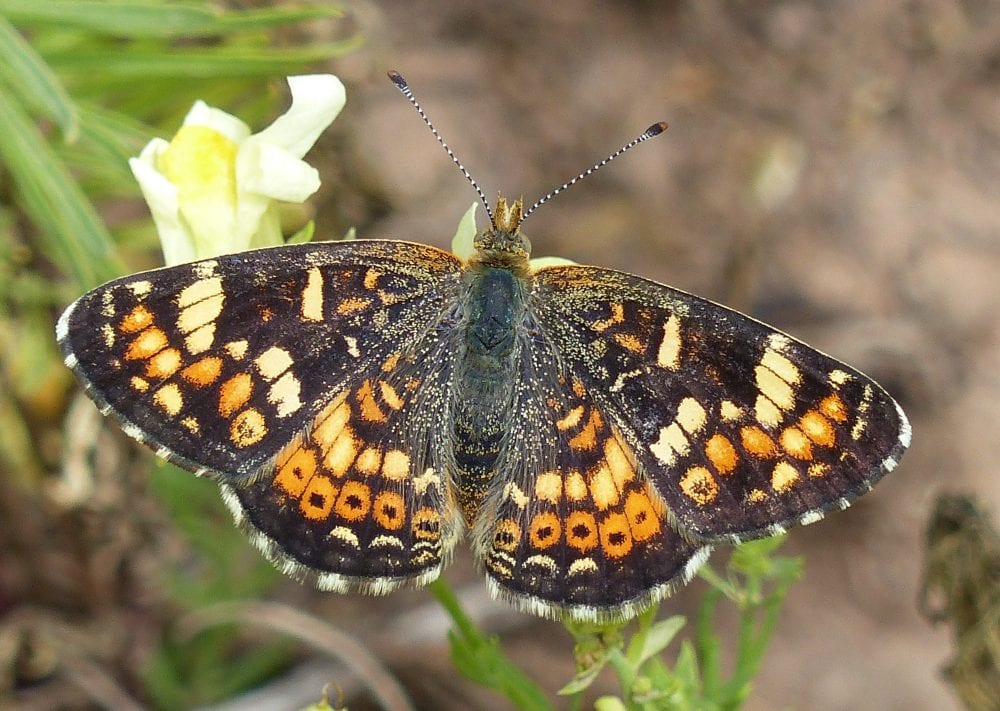
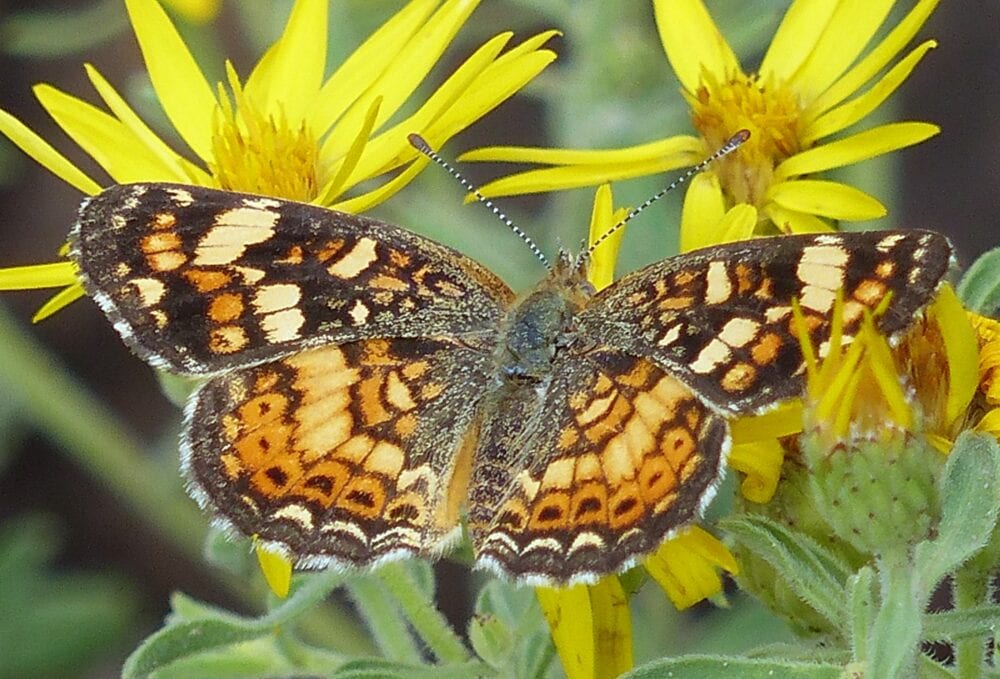
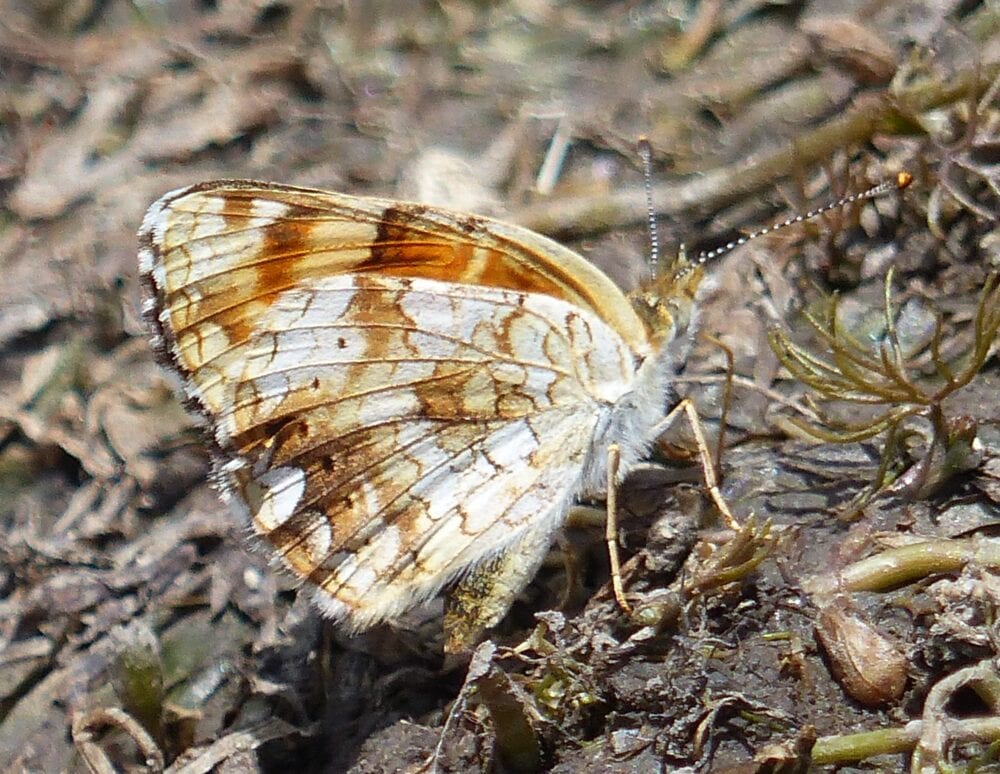
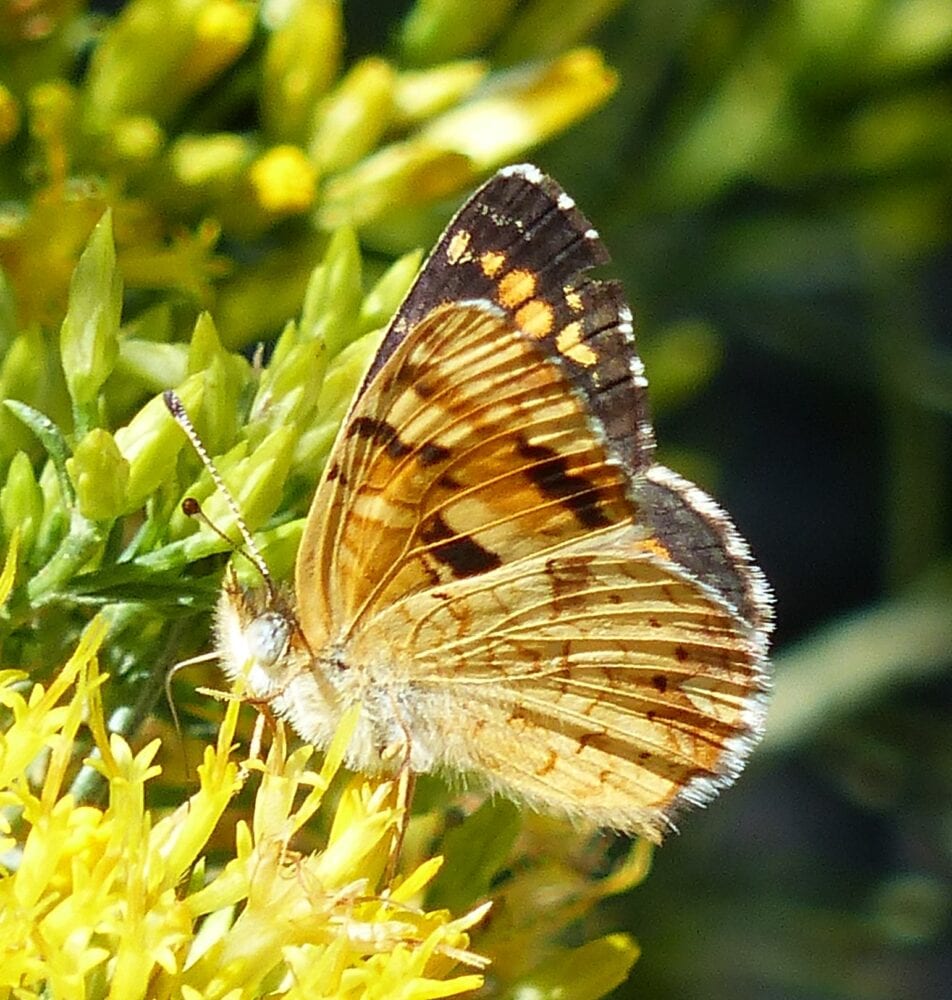

Phyciodes mylitta (W. H. Edwards 1861) Mylitta Crescent (updated December 5, 2023)
Description. Dorsal orange on Mylitta males is yellowish and uniform, whereas females have two colors of orange. Black marks on the dorsal hindwing tend toward obsolescence. Mylitta is brighter, and less darkly marked, than most other Phyciodes. Ventral markings and patterns vary in intensity, as shown in the photos below. Range and Habitat. Mylitta lives in montane western North America from British Columbia through Mexico. It inhabits fields, roadsides and meadows across New Mexico, but not the Llano Estacado (all counties but Ch,Cu,DB,Ed,Le), usually between 5400′ and 9200′ elevation. Life History. Larvae eat a variety of thistles (Asteraceae) including Cirsium arvense, Cirsium proteanum, Cirsium occidentale, Cirsium vulgare, Cirsium breweri, Cirsium hydrophilum and Carduus pycnocephalus (Scott 1986). Flight. Mylitta is bivoltine in the plains and mountains, with peak numbers in May and again in July. The second brood is abbreviated and late at high altitude. Mylitta is trivoltine in southern New Mexico, flying from February 26 to November 7, peaking in April and again July to October. A capture on January 6, 2012, by Elaine Halbedel, gives one pause. Adults patrol stream corridors. Comments. New Mexico populations belong to subspecies Phyciodes mylitta arizonensis Bauer 1975, which was described from Arizona’s White Mountains high country. The very similar Barnes’ Crescent (Phyciodes pallida barnesi Skinner, 1897) comes within 15 miles of our northern border in CO and will eventually be found in our northern tier of counties. It is told from mylitta by size (slightly larger) and the black spot in the middle of the trailing edge of the forewing is larger.
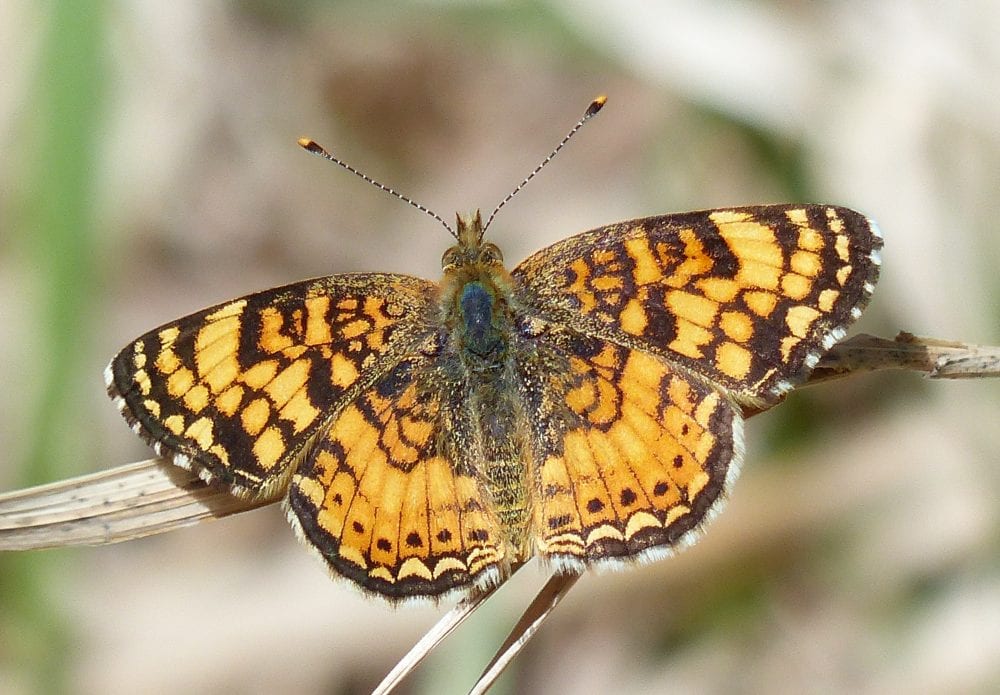
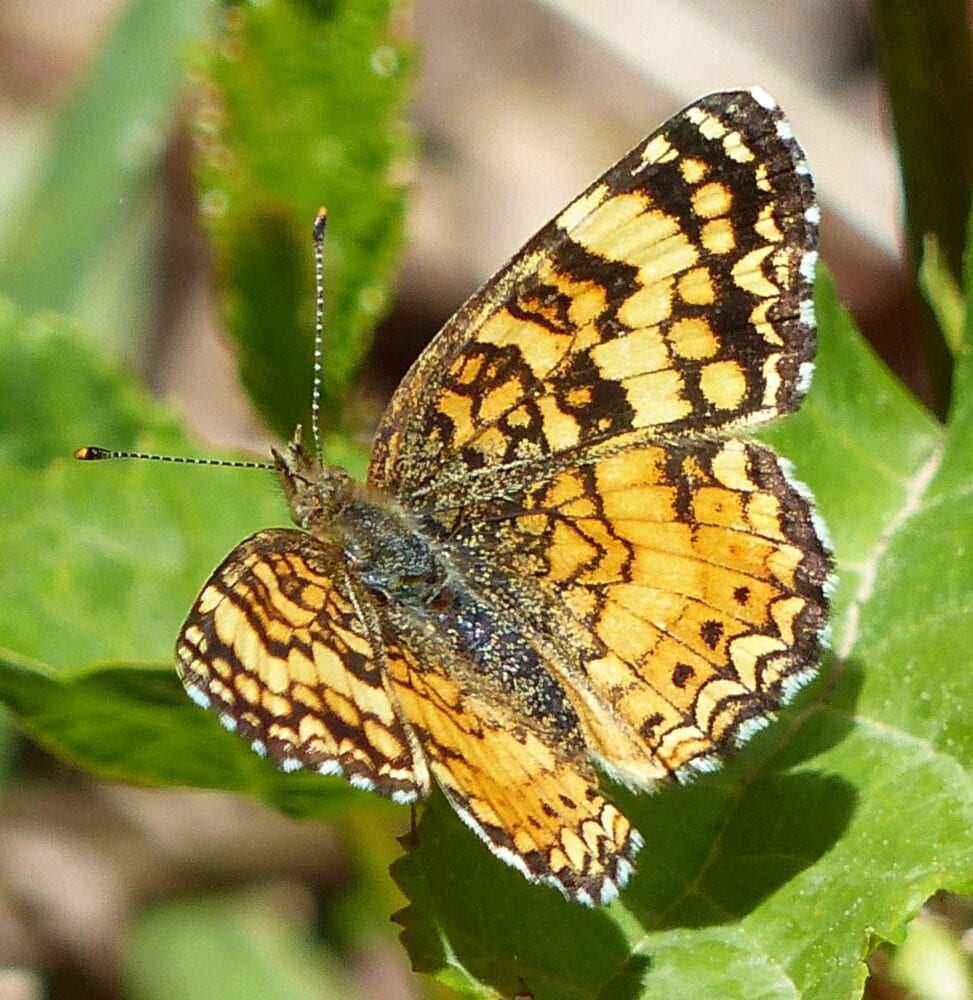
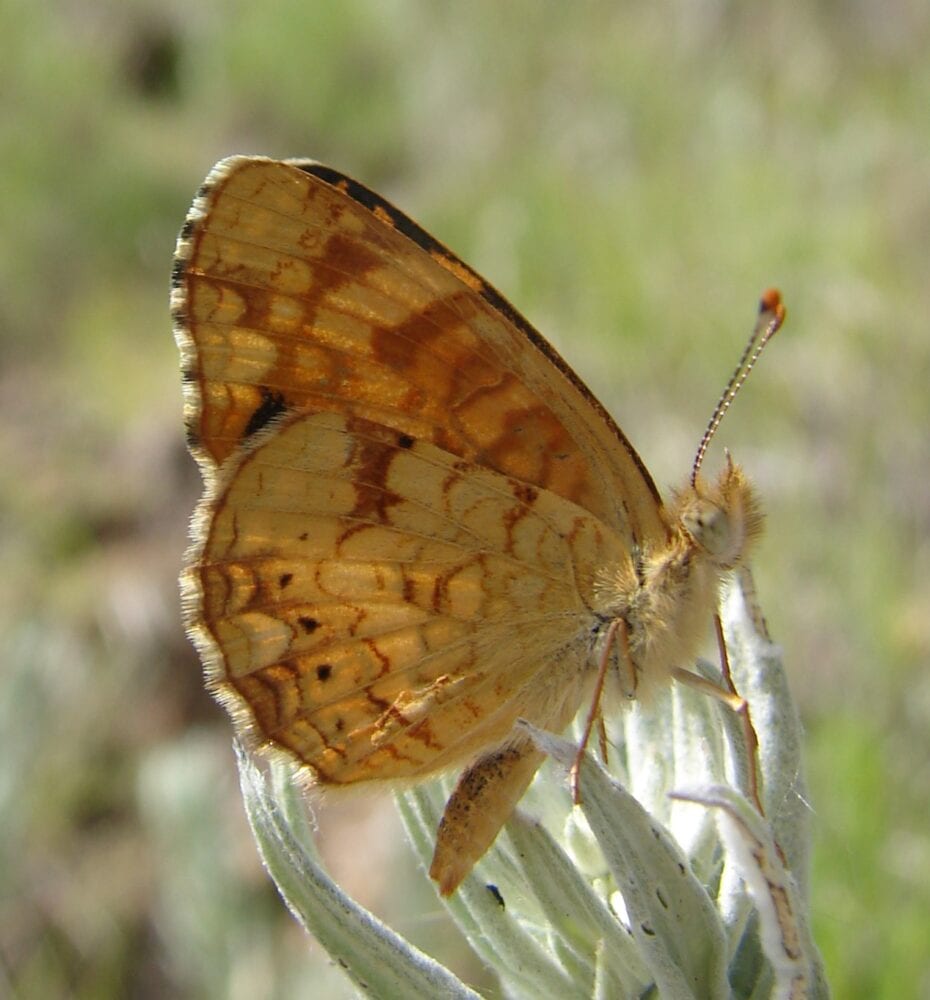


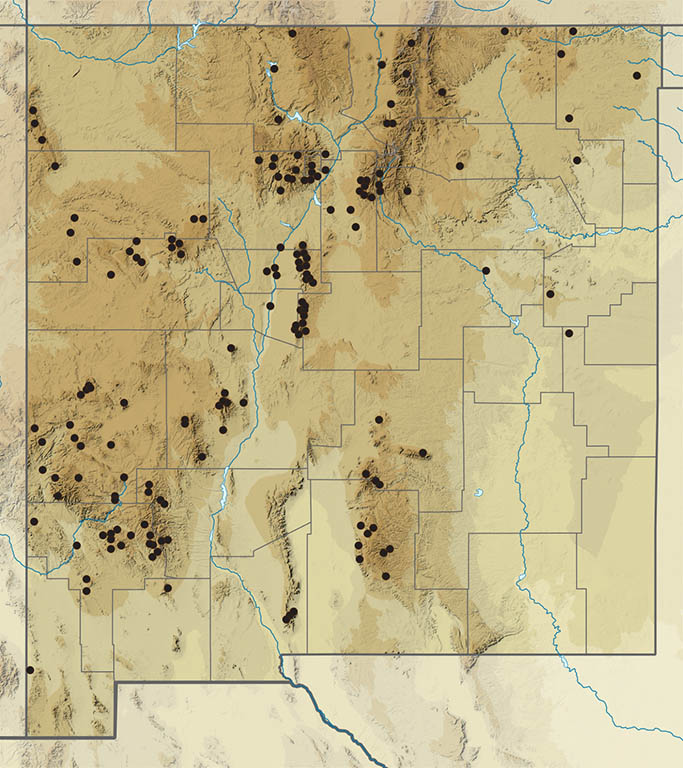
Phyciodes jalapeno J. Scott 1998 Jalapeño Crescent (updated November 30, 2023)
Description. Jalapeño Crescent is gaily colored. Forewing uppersides have contrasting bands of black, cream and orange, resembling Painted Crescent. Separate them by checking undersides, for Painted Crescent has a nearly immaculate hindwing while that of Jalapeño has markings more typical of other crescents. Ventral forewing near the costa has a white bar framed by broad dark bars; the dark bars are narrow in Painted Crescent. Range and Habitat. This butterfly lives from Texas west to southern California and south to Central America. In New Mexico it prefers wet Chihuahuan Desert habitats. It is regular only along the lower Pecos River, usually below 4000′ elevation (counties: Be,Ch,Co,DA,DB,Ed,Gu,SM,Ot,Qu,Ro,Un). Recent northern sightings are either strays or temporary colonies that freeze out in winter. Life History. Larvae eat riparian mat-plant (Phyla lanceolata, Phyla nodiflora; Verbenaceae). Adults may overwinter on our southern border. Flight. Regular sightings between March 27 and December 5 imply continuous breeding during the warm season. Jalapeño adults fly weakly and close to the ground near the host, nectaring at its white flowers. Comments. Zhang et al. (Oct. 7, 2022) used DNA analyses to determine that Phyciodes jalapeno J. Scott 1998 is a species distinct from Florida’s Phyciodes phaon (W. H. Edwards 1864). Eastern New Mexico University has New Mexico’s first specimen of Phyciodes jalapeno, collected near campus (Ro) on 31 July 1965. Rattlesnake Springs, part of Carlsbad Caverns National Park (Ed), is a good place to see Jalapeño. A likely stray was seen at Sugarite Canyon State Park (Co) on July 24, 2021.
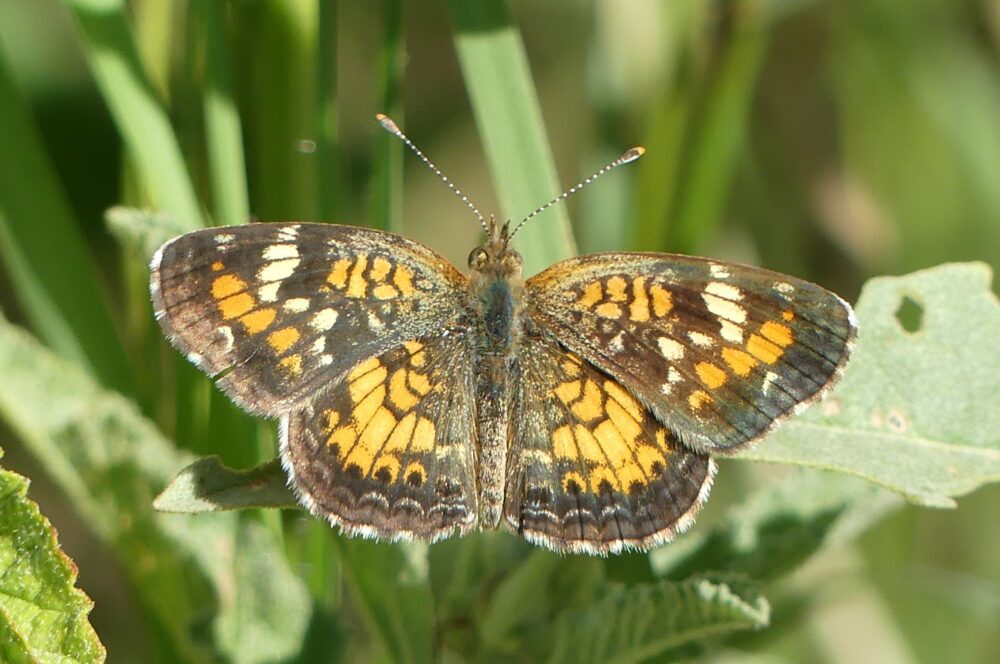
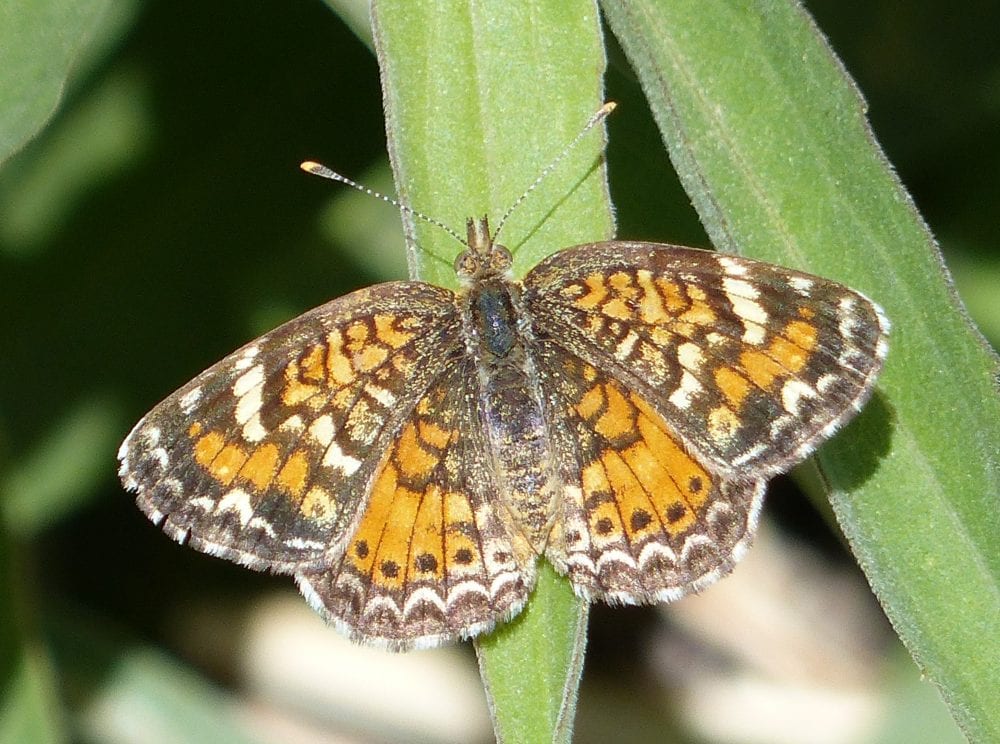
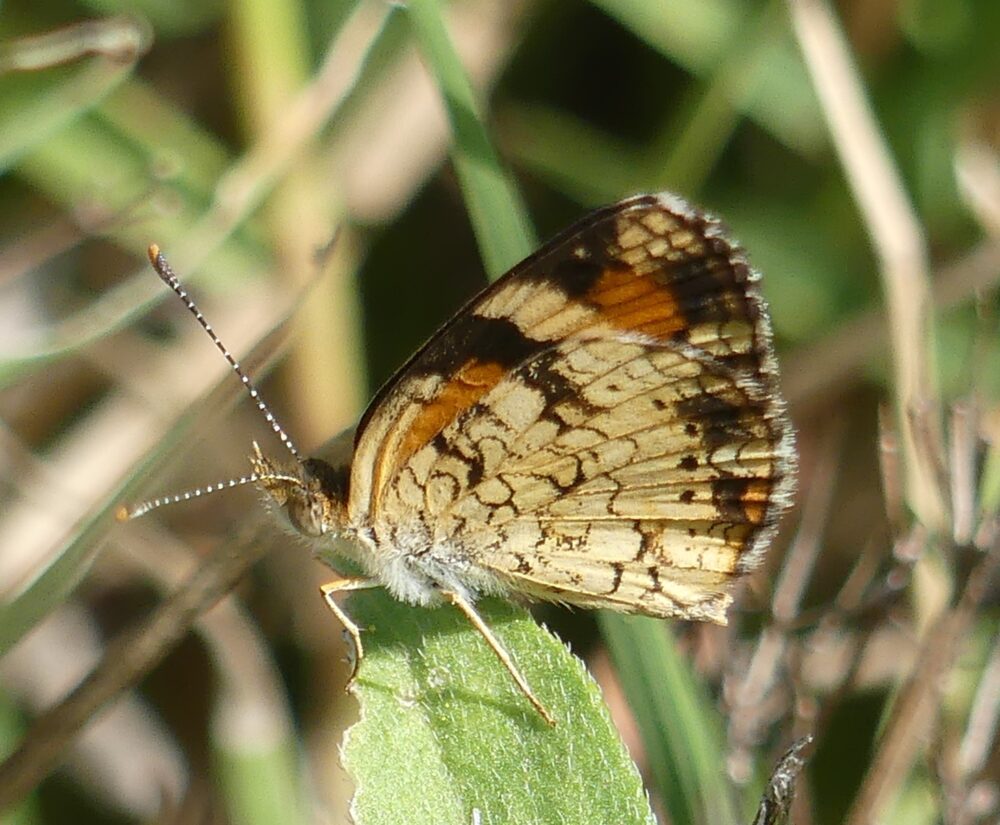
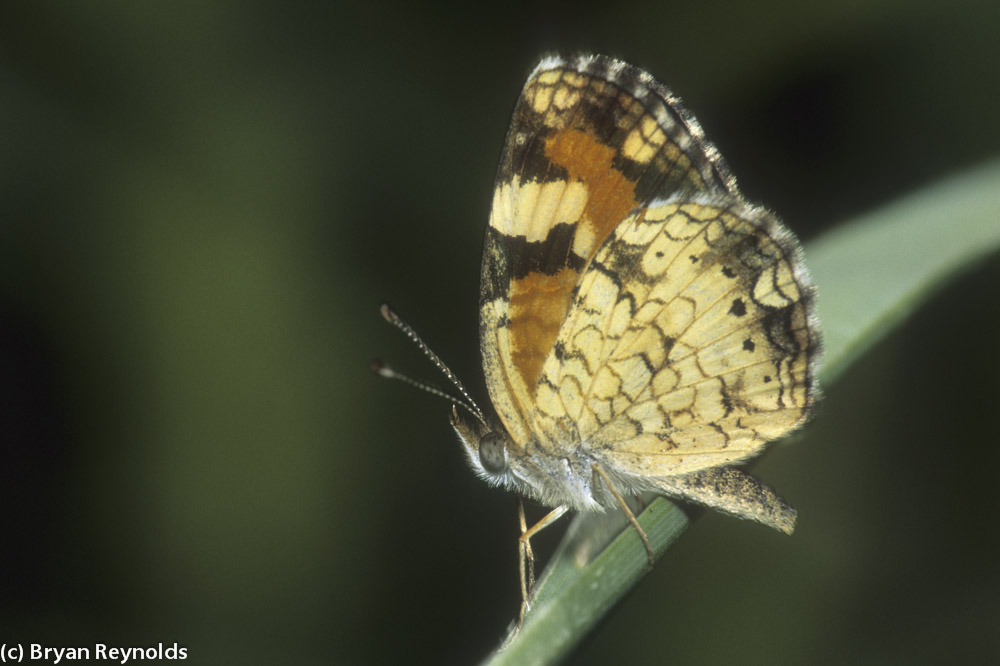
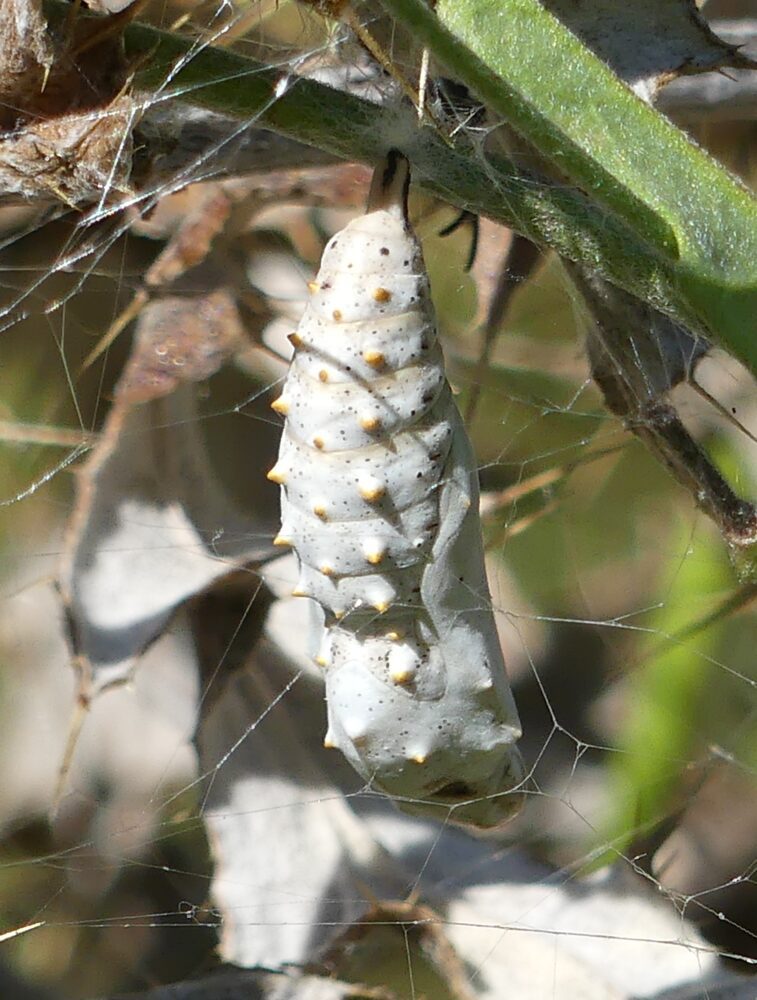

Phyciodes picta (W. H. Edwards 1865) Painted Crescent (updated December 11, 2023)
Description. Perhaps our most distinctive member of this genus, Painted Crescent has a unique creamy white ventral hindwing that is immaculate, except for a few thin black squiggles and shadows near the margin. It has alternating white and dark bands on the forewing above. Range and Habitat. Phyciodes picta occurs from Mexico north to the southern Rockies and the Great Plains. In New Mexico it inhabits disturbed areas, pastures and prairies statewide (all counties) usually below 8500′ elevation. Life History. According to Scott (1986), larvae eat Convolvulus arvensis (Convolvulaceae) in New Mexico and Colorado, although asters (Asteraceae) are the traditional hosts. Half-grown larvae overwinter. Flight. Painted Crescent completes two or more annual generations. Northern New Mexico has spring (May) and late summer (August) flights. Low elevation bottomlands produce overlapping broods from March 31 to October 15. Comments. Most New Mexico populations belong to the nominate subspecies. Individuals from our SW counties (Ca?,DA?Gr,Hi,Lu,So?) seem to be subspecies Phyciodes picta canace W. H. Edwards 1871 (type locality: “vicinity of Tucson”). That subspecies has straw yellow coloring on the VHW, as opposed to the creamy white of typical Painteds. Jemez Springs (Sv) is the type locality for aberration “jemezensis” Brehme 1913, from John Woodgate’s collections.
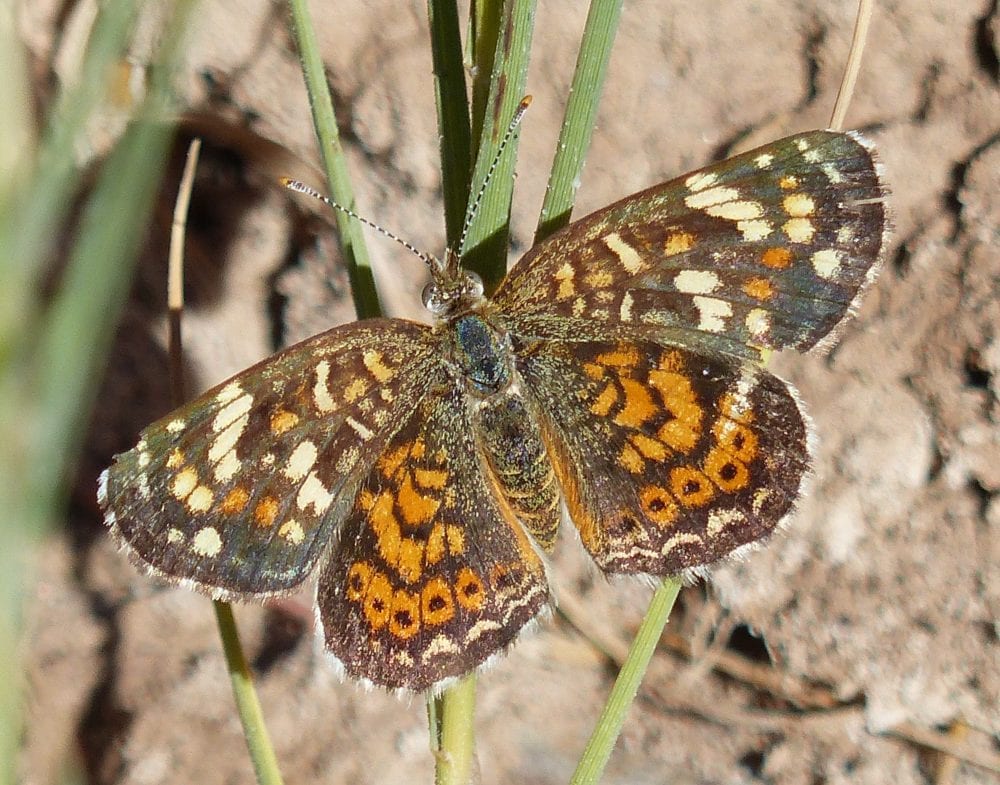


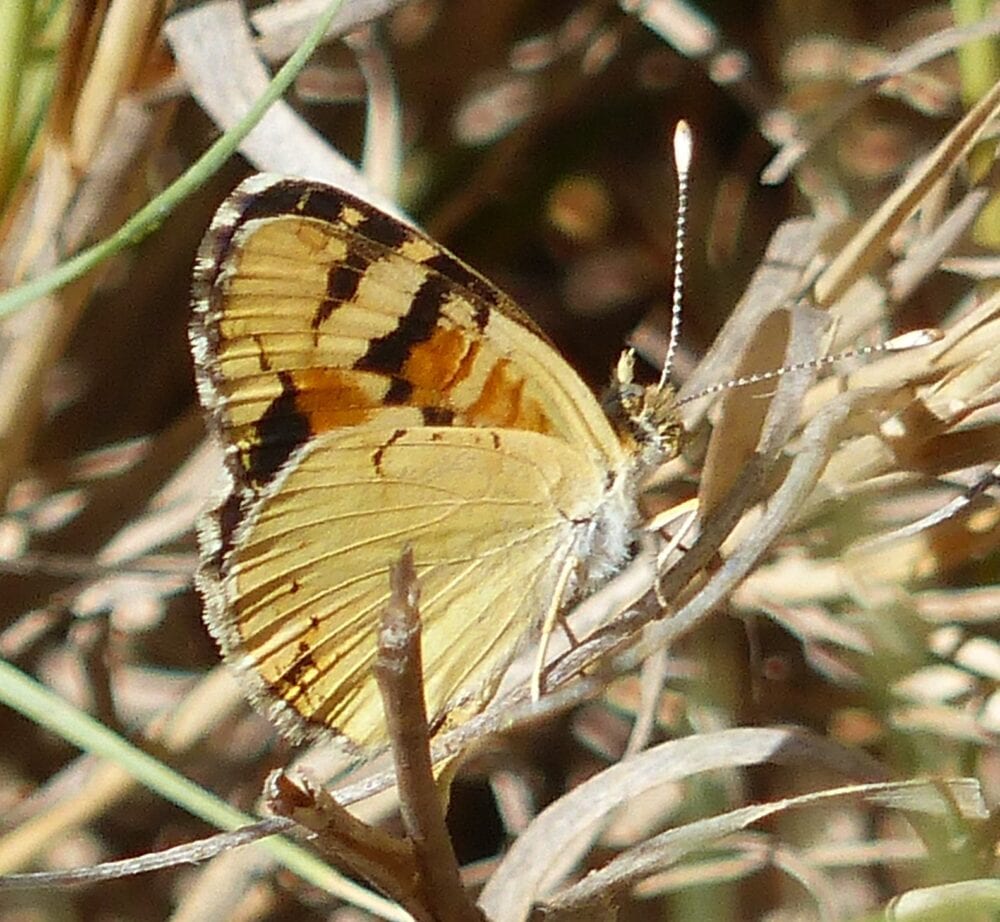
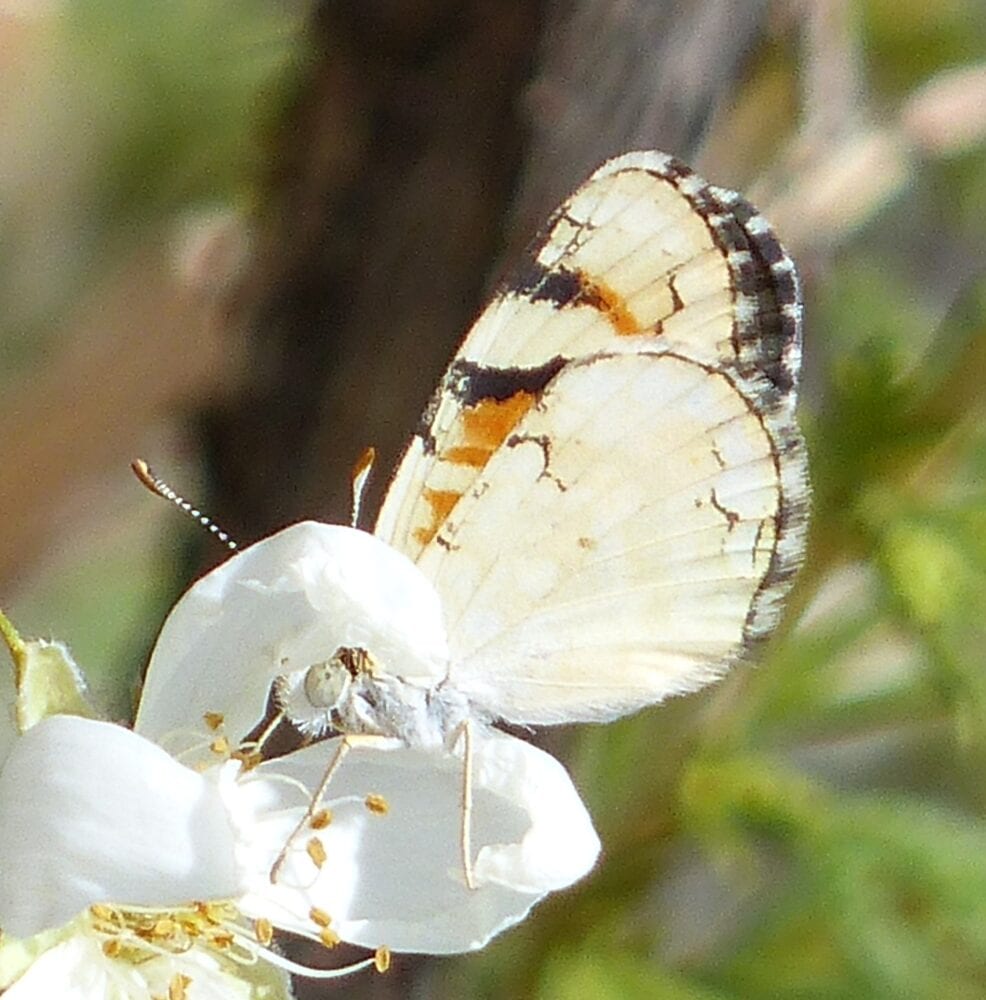

Phyciodes graphica (R. Felder 1869) Graphic Crescent (updated April 23, 2024)
Description. Graphic Crescent is small and orange like its congeners. It is flat orange above with concentric black lines. Beneath, the forewing median and postmedian orange patches are enclosed in black boxes. It has a more “checkered” appearance than its relatives. Range and Habitat. This crescent is native to Central America and Mexico. It breeds as far north as Arizona, New Mexico and Texas, and may wander to the Great Plains. Phyciodes graphica breeds in mesquite-filled canyons below 6000’ elevation in southeast New Mexico, but it strays elsewhere (counties: Ch,Co,DA,Ed,Gr,Gu,Hi,Le,Li,Ot,Qu,Ro,So,To?,Un). Life History. Larvae eat Acanthaceae including Siphonoglossa pilosella (Scott 1986) and Dyschoriste decumbens (Bailowitz and Brock 2021). Flight. Phyciodes graphica must be 2- or 3-brooded here, because adults are seen consistently between March 6 and October 12. Its normal behavior, dodging through thorny shrubs, makes it hard to catch or photograph. Comments. An American Museum of Natural History specimen from Cedar Creek Camp, 5 miles north of Ruidoso (Li) on 30 June 1961, is the oldest New Mexico record. This butterfly also has been known as Phyciodes vesta (W. H. Edwards), the Vesta Crescent.


